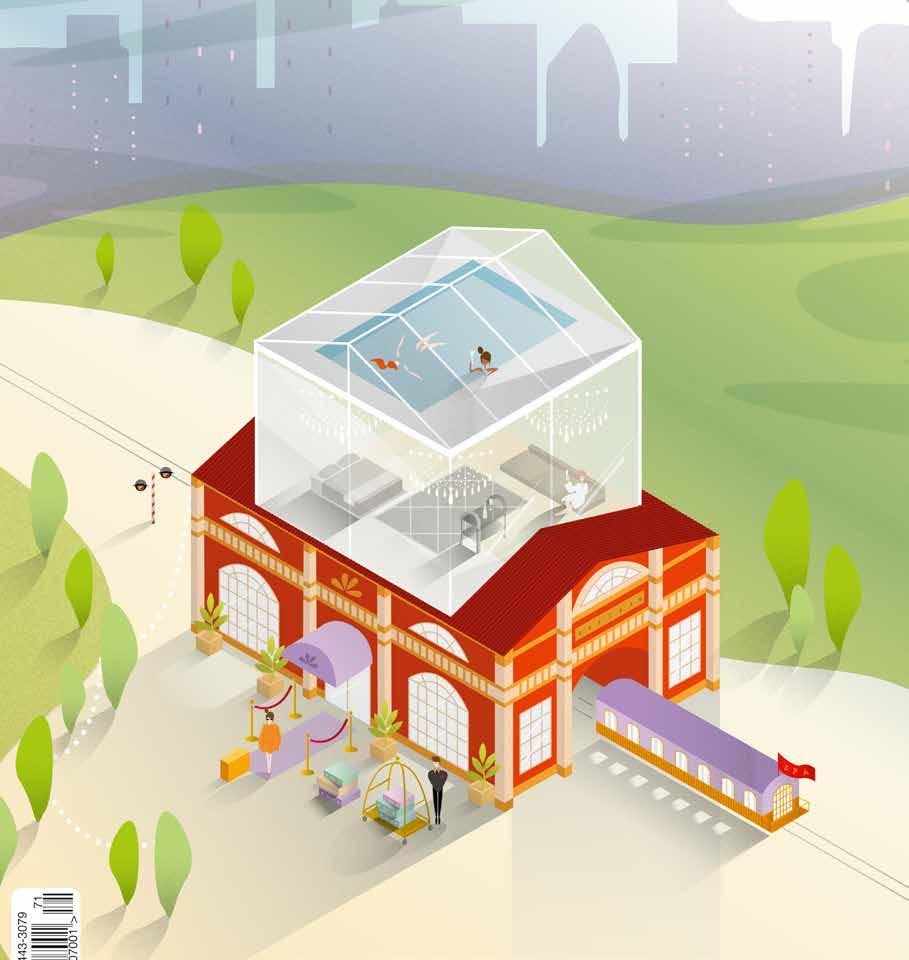
ISSN 1443-3079 9 > 771443 307001 71 ISSUE 72 / SUMMER 2017 / AUS $17.95 Second Chances The world's best converted hotels Hot property The most anticipated hotel openings for 2018 020 076 114 154 Safari Madagascar Spotting lemurs at the island's first luxury lodge The Presidential Train A gastronomic journey through Douro Valley Design hotel trends Blainey North and Kit Kemp talk five-star interiors


LIVE THE MOMENT oneandonlyreethirah.com

Discover majestic accommodation in this landmark city of old and new Arabia where a few steps away is a private coastline to treasure.
With its enviable location on the tip of one of the world’s most spectacular landscapes, Palm Island, uncover Dubai’s most stylish beach resort.

oneandonlyresorts.com/dubai
+971 4 426 1099
THE WORLD FALLS AWAY
WHERE THE REST OF
ONE&ONLY ROYAL MIRAGE, DUBAI
ONE&ONLY THE PALM, DUBAI







47 69 89 125 141 153 189 6 www.luxurytravelmedia.com.au FLIGHT 787-9 LATAM MELBOURNE TO SANTIAGO PORTUGAL CHICAGO PATAGONIA BILBAO LONDON PACIFIC OCEAN ATLANTIC OCEAN
















GATHER
www.luxurytravelmedia.com.au 7 048 Patagonia 054 Malaysia 062 Chicago city guide 090 Fly fishing New Zealand | 095 Golf New Zealand 100 Abercrombie & Kent Philanthropy | 104 Track mountain gorillas 107 Ocean conservation | 114 Safari Madagascar 118 Ski Japan | 122 The Australian Open Ananda in the Himalayas Brain health at Amatara Wellness tips from Kamalaya Koh Samui Emirates One&Only Wolgan Valley spa review 142 London | 146 Bali | 150 Byron Bay 154 Design hotel trends | 158 Fiji | 166 India 170 Northern Territory | 174 Vietnam | 176 New Zealand 191 Chef's guide Bilbao | 194 Barossa Valley 071 2018 speciality cruises 076 The Presidential Train 082 High flyer news and reviews NORTHERN TERRITORY FLIGHT NH879 ALL NIPPON AIRWAYS SYNDEY TO TOKYO BALI FIJI INDIA
MALAYSIA JAPAN NEW ZEALAND MELBOURNE GREAT BARRIER REEF RWANDA & UGANDA MADAGASCAR THAILAND WOLGAN VALLEY BAROSSA VALLEY INDIAN OCEAN PACIFIC OCEAN
DESTINATION JOURNEY EXPERIENCE RENEW
STAY SAVOUR
VIETNAM

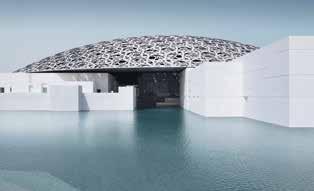


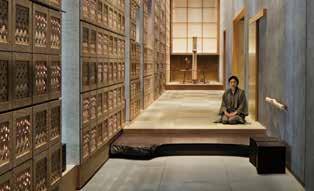
COVER STORY: SECOND CHANCES 026 SUITE LIFE HIGH FLYER NEWS WHAT TO PACK DISPATCHES 179 082 024 012
Gary Allen EXECUTIVE EDITOR/ MANAGING DIRECTOR gary@luxurytravelmedia.com.au
Katie Milton EDITOR kmilton@luxurytravelmedia.com.au

Lucy Jones CONTRIBUTING EDITOR

Grace Smith ASSISTANT EDITOR gsmith@luxurytravelmedia.com.au
Siobhan Plowman STAFF WRITER splowman@luxurytravelmedia.com.au
Kyle Sansbury ART DIRECTOR design@luxurytravelmedia.com.au
Kate Symons SUB EDITOR
Kelly Allen HEALTH & WELLNESS WRITER
Richard Bunting GENERAL MANAGER / MANAGING EDITOR rbunting@luxurytravelmedia.com.au +61 4 24128806
Tom Hachenberg BUSINESS DEVELOPMENT MANAGER thachenberg@luxurytravelmedia.com.au +61 4 19412481
Andrew McEvoy EXECUTIVE DIRECTOR
Published by: Magnesium Media ABN 86 066 598 427 Level 11, 66 Clarence Street, Sydney NSW 2000 Australia

Tel: +61 2 8705 5463
Distribution and Subscription enquiries: AUSTRALIA and NEW ZEALAND
Luxury Travel magazine
T: +61 2 8705 5463

E: subscriptions@luxurytravelmedia.com.au
W: luxurytravelmedia.com.au/subscribe
Directors
Robin and Scott Venturelli
Cover Illustration
Taylor Conacher
E: taylor.conacher@gmail.com W: taylorconacher.com



Julia Baird
In 2018 I would love to take my little boy to Arizona. He was born in America, and still talks with a slight twang and claims he can’t sleep at night because he belongs to a different time zone. I would like to trek through the Grand Canyon with him, be dwarfed by the “mountain temples”, the silent gulfs, enormous moons, and maybe explore the desert, preferably in a Mustang. Follow Julia's family travels in London on page 142.
Mary Holland
The more I travel, the longer my list gets. Topping my travel agenda for 2018 is Bhutan, Chilean Patagonia, Alaska and the Faroe Islands. I’m craving dramatic landscapes and chilly climates (a result of climate change?). Drinking wine and eating pasta in Puglia is also up there, as is a return to Japan – I can never have too much sashimi and sake. Go on safari with Mary in Madagascar on page 114.
Tiago Pais

In 2018, I want to go to Japan and eat as much ramen and sushi as my body can tolerate. While I do that, I want to absorb the Japanese culture, get lost in translation, and catch an overdose of unnecessary technology. Yes, I am a bit of a geek. Travel on The Presidential Train with Tiago on page 076.
Belinda Jackson | Belinda Luksic | Rachel Lees
Craig Tansley | Deborah Dickson-Smith
Jennifer Pinkerton | Linda Pearce | Matt Shea
Belinda Craigie | Katrina Holden | Rob McGovern
TWITTER@LUXURYTRAVELAUINSTAGRAM@LUXURYTRAVELAUFACEBOOK.COM/LUXURYTRAVELMAGAZINEPINTEREST.COM/LUXURYTRAVELAU
www.luxurytravelmedia.com.au 9
FOLLOW US ON: LUXURY TRAVEL CONTRIBUTORS
This issue, we asked three of our contributors to tell us where they want to travel in 2018.
We spent the night at the Aurora Sky Station, with panoramic views over the Swedish Lapland. We drank hot chocolate by the fire and waited for the Aurora Borealis to light up the sky, before running outside to watch the spectacular natural phenomenon.
 Mark Cunich #LTmoments winner
Mark Cunich #LTmoments winner
“ “
Katie Milton Editor

In a world where things are becoming increasingly disposable it is refreshing to take time to recognise instances of restoration. Old buildings are being transformed from their past lives as industrial warehouses, coal cranes and jails, and reborn as five-star hotels and resorts. From the innovative architects behind the transformation of a historic grain storage tower in Cape Town into The Silo, to the murderous affair that consumed the past owners of San Antonio’s Pearl Brewing Company, which now houses the luxurious Hotel Emma, our cover story details some of the most intriguing and innovative tales of conversion around the world. The most successful stories are created when the hotels incorporate both the physical and narrative elements of their histories into the new building, crafting a layered journey of discovery for their guests.
As well as an increasing respect for the history of the places we visit, there is a growing awareness of the impact that tourism is having on their future. On page 100, we explore the philanthropic organisation run by tour operator Abercrombie & Kent, which uses its US$2.5 million budget to fund effective community outreach programs that give back to the regions in which they operate, serving as the antithesis to all-too-common surface-level initiatives and potentially harmful voluntourism programs. Deborah Dickson-Smith updates us on the declining state of the Great Barrier Reef and the growing number of luxury travel brands coming to its aid with ocean conservation initiatives (page 107). And like me, you might begin to notice that in many of our stories, our writers are increasingly touching on each property’s small conservation victories, like the birth of Likuliku Lagoon Resort’s first iguana bred in captivity (see page 158).
I speak to award-winning interior designers Blainey North and Kit Kemp about society’s increasing emphasis on appearances and how this is influencing design in luxury properties around the globe (see page 154). And we also launch our new family section; Gather (page 141) where our writers experience self-contained luxury rentals and child friendly hotels and resorts.
Thanks for continuing to flip through our pages.
Katie Milton
Congratulations

Mark Cunich (Northen Lights)
Well done to the first winner of our seasonal photography competition. Each issue we will be publishing our favourite luxury travel photograph so be sure to post your favourite images to Instagram, and tag @luxurytravelau in your photograph and #LTmoments.
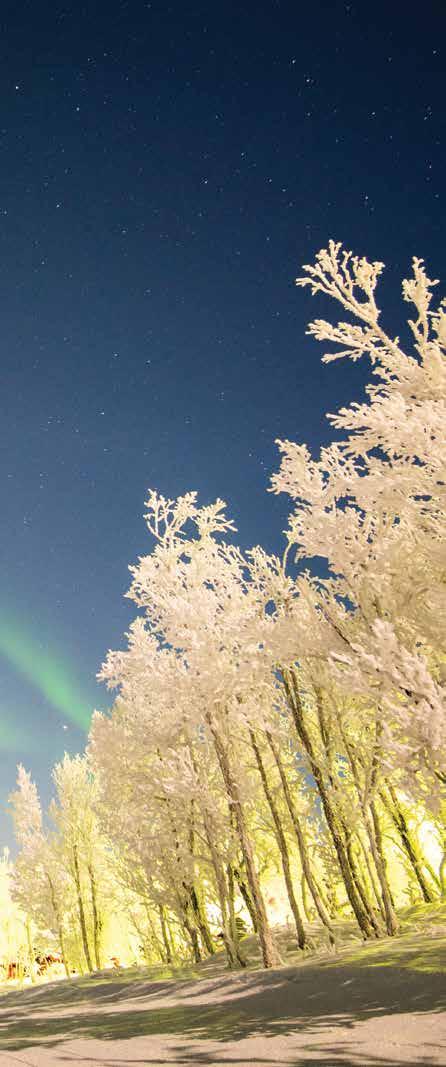
www.luxurytravelmedia.com.au 11
A fetching change
Reimagined then renovated, Larmont Sydney delivers a first-rate stay for every woman and her dog, as Katie Milton discovers.
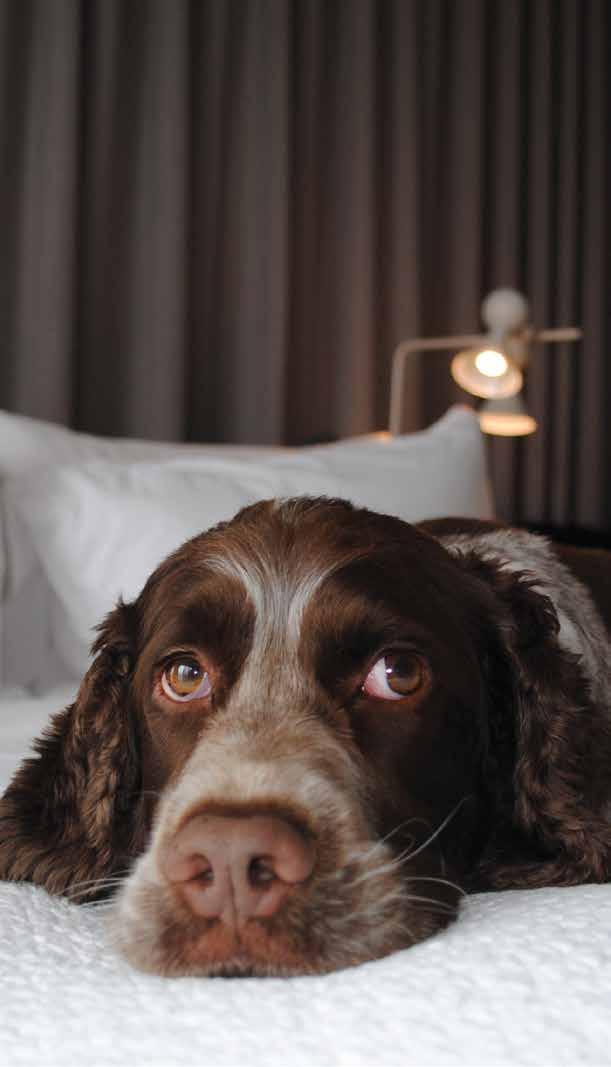
Scrumpy pulls me out of the lift and stops at the window on the 12th floor of Sydney’s newest five-star boutique hotel. Last time I was here, there was a showgirl sitting inside an oversized martini glass where my springer spaniel is now sniffing. For the launch party, the Larmont team had transformed the four suites into iconic Kings Cross Venues – the first inkling of the hotel’s endeavors to connect with its local surroundings. Once a privately owned penthouse, the entire 12th floor has been converted into the Larmont’s top tier suites. The rest of the hotel is housed on the lower levels, in the space previously occupied by The Diamant Hotel.
Scrumpy drags me up the stairs and as I open the door to the Signature Suite, he yanks free and makes for the doggy welcome pack, devouring the treats in his bowl before I even enter the room. He pauses and looks longingly at me with his soulful chocolate eyes. Is that all? Along with his kitsch food bowl is a cushioned dog bed, a water bowl and a bottle of Capi mineral water. Scrumpy whines; he prefers San Pellegrino.
No more treats in sight, he continues his inspection. Bypassing the spacious bathroom with freestanding tub and waterfall shower stocked with Malin + Goetz amenities, he runs out to the balcony and takes in the views of the Harbour Bridge and Opera House to the left, and the sailboats moored in a harbour to the right. The deck is impressively large for an inner-city hotel, but the size can’t keep Scrumpy outside as he peers cautiously over the edge before pawing again at the glass door. Ignoring the dog bed he jumps up onto the cloudsoft king and curls into a small ball – the Scrumpy stamp of approval.
The 103-room Larmont is boutique hospitality group Lancemore’s first city hotel, and one of only four five-star Sydney hotels that is dog friendly; set in what used to be the bustling red light district of Kings Cross. The past three years have seen the gentrification of the
SCRUMPY
once infamously seedy district into a slick urban neighbourhood where strip clubs have been replaced by trendy cafes, specialty bars, high-end restaurants and, now, a five-star hotel. “I saw a big change happening and I wanted to be a part of it in one way or another” said Lancemore CEO Julian Clark in his speech at the hotel’s launch. Clark has spent the past year visiting more than 100 boutique hotels in 20 countries to get a feel for what makes a small hotel great. And what comes through in the Larmont is a strong sense of place, understated service, and the small touches such as two complimentary items in the mini bar and a range of premium wines available at retail price.
The lobby – more public space than five-star check in – is, apart from a few stylish couches, minimal with a styled nook off to the side outfitted with a communal table, art books, magazines and city guides to the surrounding area; the perfect place to sit and plan your day. The front desk is manned by friendly staff, guys in cool pinstriped shirts and women in vibrant chic dresses – uniforms which complement the low key, laid back ser-
vice, for dogs and their humans.
I forgo happy hour in on-site restaurant The Hyde, where guests are served a complimentary glass of Lindenderry Wine from Lancemore’s cellar door along with canapés, and head through the sliding glass doors for a yoga class at the adjacent BodyMindLife studio. The lack of gym facilities in the hotel is alleviated by free yoga and Pilates classes for guests as well as access to Anytime Fitness, a one-minute walk down the road.
flowers stuffed with fresh fromage blanc and smoked mozzarella, and moreish arancini balls – hearty, filling and full of flavour – and head back upstairs.
“Ignoring the dog bed he jumps up onto the cloud-soft king and curls into a small ball – the Scrumpy stamp of approval.
Head Chef Christian Colognesi helms the The Hyde, a bright, open dining space with sleek blue-cushioned booths, circular bar tables and original artworks by Melbourne artist Jane Hall on the walls (pieces from the same series also hang on the walls of my suite). While it’s not on the menu, the bartender happily mixes me a Negroni. The restaurant is quiet for a Saturday night and when the waiter asks where my dog is, I feel guilty at the thought of Scrumpy alone in the room. I didn’t know the restaurant was pet friendly too, so I wolf down the crispy zucchini
“Tech savvy and modern, the hotel encourages guests to order UberEats or Deliveroo for dinner, and there’s an Apple TV for Netflix binges or a Bose Sound system to connect your Spotify playlists to. I settle for a long bath and Lindenderry sparkling, the only thing missing is a fluffy bathrobe to wrap myself in afterwards – I'm told the hotel plans to have all rooms and suites fitted with bathrobes by the end of the year. The next morning, Scrumpy’s welcome chew toy is in little pieces on the floor, so I treat him to a side of smoked bacon along with breakfast in bed. He’s happy, I feel refreshed and I order us an Uber home.
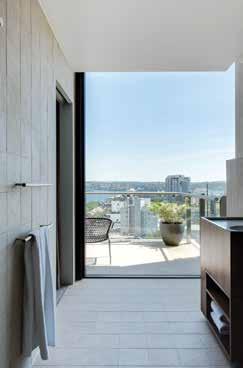
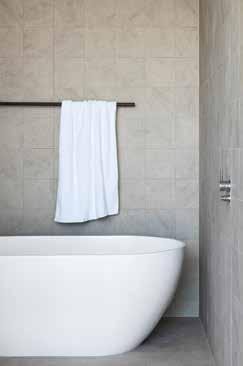
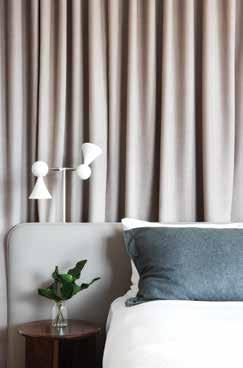
Rates for the Signature Suite start from A$649 per night. lancemore.com.au/larmont

www.luxurytravelmedia.com.au 13 Stay
LUXURY TRAVEL DISPATCHES THE LARMONT | SYDNEY
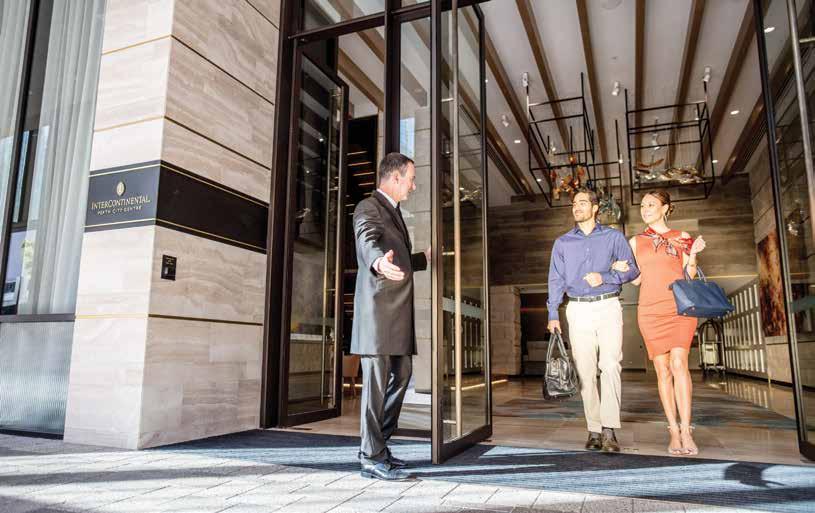
WRAP YOURSELF IN LUXURY AT THE NEW INTERCONTINENTAL PERTH CITY CENTRE. Located within the vibrant King Street precinct, experience personalised service, unique restaurants and the exclusive Club InterContinental. Corner Hay and King Streets. Visit intercontinental.com/perth Live the InterContinental ® life.
True stripes
the
of Kuala

Jalan Kamunting looks like any other ramshackle series of Kuala Lumpur city blocks. Poky streets, laneways stacked with motorcycles, couriers and office workers drinking coffee. It’s a place of ancient shopfronts, hawker stalls and restaurants.
And then there’s Hotel Stripes. This tiny corner of the Chow Kit sub-district might feel like an odd location for YTL’s latest luxury hotel, but the Malaysian hospitality group does nothing by accident. Stripes is designed to blend with the surrounding neighbourhood, to engage (not alienate), and fortify an existing community rather than muscle it out.
It sounds like PR spin until you hear insights from some of the local business owners. Many of them, like Jack Lee from iconic restaurant Yut Kee and notable tailor Loke Kwong Yuen, appear in a slick introductory documentary the hotel has produced about the local area.
Built atop a line of heritage shophouses, the hotel rises 21 storeys above the neighbourhood, its facade of shutters, open brickwork and street-side frontage giving it an approachable feel. Inside, though, it’s a striking space: designer lighting, parquetry floors and brass highlights. Everything is brand new, right down to a team of staff younger than your average innkeepers – all the better to keep the property feeling dynamic and contemporary.
The 184 rooms are decked out in a fabulous mix of rich creams and greys, frosted glass, and soft golden trim. Brilliant black and white photos of retro Jalan Kamunting drive home the hotel’s connection to the area. My room, a 45-square metre Executive Studio, is long and spacious. The standout feature is the ginormous, illuminated vanity mirror, which
reflects the hotel’s appetite for scale. There’s a sizeable desk if you must work, but I imagine most are more likely to make a beeline for the even bigger bathtub, exclusive to the Executive Studios (and the top of the line 62-square metre Stripes Suite).
Guest services manager Reza Shahgholi is typical of the staff at Stripes: young, professional and excited about this property. “It’s been amazing watching guests come in and really engage with what we’re trying to do here.”
He is most proud of the rooftop infinity pool and its accompanying Man Tao bar. It turns out to be a jaw-dropper, the skyscrapers of central Kuala Lumpur shimmering in the afternoon light and framed by the green hills of KL Forest Eco Park. The Campari definitely tastes better up here.
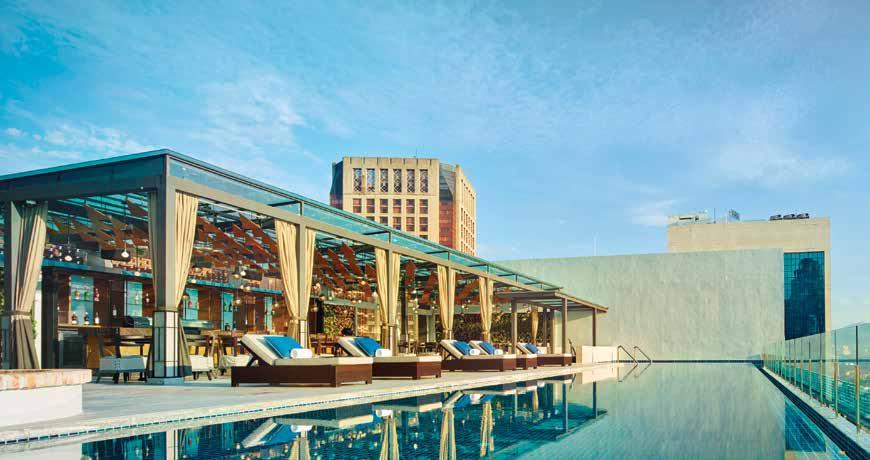
Stripes’ food offering is just as enjoyable. The handsome, black-tiled Snug is the go-to for breakfast and casual meals throughout the day, but Brasserie 25 on the ground floor is the star. An almost perfect facsimile of a French bistro, right down to the red-brick arcades that frame its open kitchen, chef Irwin Chan taps all the Gallic classics – bouillabaisse, steak frites, duck confit and terrine all make an appearance.
Still, you’d be a sucker to just stay in. Stripes exists as an entree to its neighbourhood, and getting out and meeting the locals is essential. Danial Naim returned from studying in Melbourne to open his own coffee shop, League of Captains. Just a block away from Stripes, it’s an excellent (and rare) place to get an espresso that foots it with what we’re used to in Australia. Naim is in no doubt about the positive effects the hotel is having on the neighbourhood. “It’s been really good. The captive market in the area has grown,” he says. “It's more an upgrade than gentrification, which some people don't always think of as a good thing. We've seen a noticeable increase in foot traffic for sure.”
See more images from this story at luxurytravelmedia.com.au
Stay
Rates start from MYR380 (about A$133) per night including taxes. stripeskl.com
LUXURY TRAVEL DISPATCHES
HOTEL STRIPES | KUALA LUMPUR www.luxurytravelmedia.com.au 15
Behind
flash façade
Lumpur’s Hotel Stripes, is a new business looking to connect with its local community, finds Matt Shea
Perth's five-star boom continues
InterContinental Perth City Centre has just been unveiled, the sixth Australian property from the brand. Set on Hay Street in the central King Street Precinct, the hotel is walking distance from His Majesty’s Theatre, designer retailers, cafes, city parks and the Swan River ferry at Elizabeth Quay.
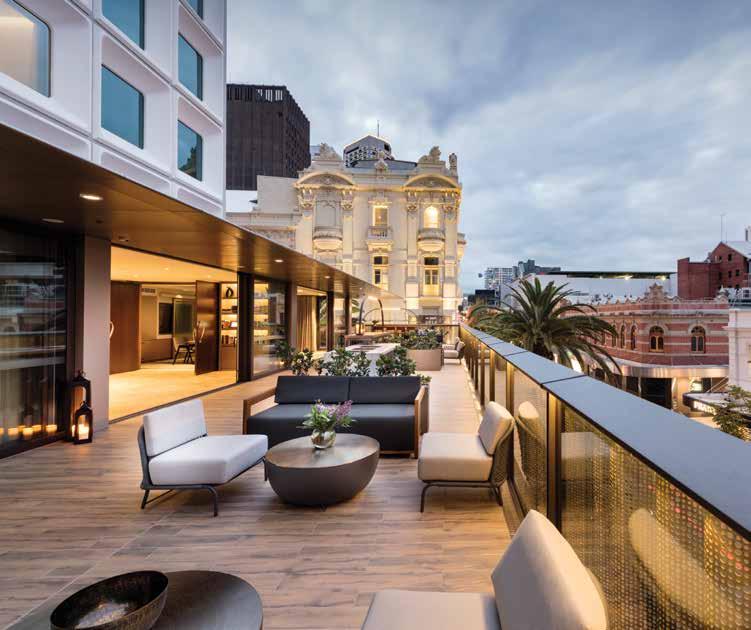
Guests have the option to stay in classic rooms, studios, or a penthouse suite, which all feature taupe, olive and bronze hues alongside city views. The hotel interiors have been outfitted with more than 300 specially commissioned sculptures, paintings, ceramics and glass works by 13 West Australian artists.
On-site dining offerings include Graffiti, a food-truck concept eatery that serves up coffee, Portuguese custard tarts and other gourmet food-to-go
from behind a graffiti-covered roller door designed by a local artist; outdoor tapas bar Heno & Rey; and Ascua, a ground floor restaurant that showcases the preparation of aged beef and other meats. On the first floor, The Loft Lounge serves fresh breakfast pastries as well as high tea in the afternoons, and a menu featuring InterContinental Worldly Classic cocktails.
Club InterContinental guests can access the exclusive facilities on the top floor, which include à la carte breakfast, all day refreshments, a high tea service in the afternoon, and canapés and drinks from sunset.
The hotel’s concierge team specialises in giving guests an insider’s guide to the city, offering personal recommendations and securing hard-to-get tickets to exclusive events.
Rates start from A$343 per night for a Classic King room. ihg.com
16 www.luxurytravelmedia.com.au LUXURY TRAVEL DISPATCHES LATEST AUSTRALIAN NEWS
Tents and truffles
A luxury glamping retreat has recently opened on a 12-acre property, home to Australia’s first truffle orchard, two acres of hazel trees and native wildlife, set on the banks of the Derwent River. Guests can stay in one of the five African-style safari tents, each fitted with a king bed, lounge area, private riverfront balcony and bathroom housed inside a converted water tank, with
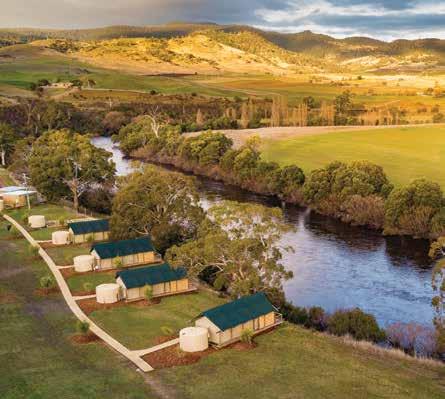
a hand-carved freestanding wooden bath and separate rain shower. A raised wooden walkway connects the tents to communal pods, including a lounge and dining room with a large outdoor deck area, and the reception and bar pod with a wood burning outdoor fireplace. Truffle Lodge will operate from October to April with rates starting from A$525 per night. trufflelodge.com
Bubble with a view
Perched on the edge of the Capertree Valley near Lithgow, Bubble Tent is Australia’s first transparent tented accommodation. The wooden-floored tent is made up of a clear-walled bedroom and opaque bathroom with composting toilet and camping-style wet area. It is inflated by an eco-turbine that allows air inside the bubble to be continuously refilled and
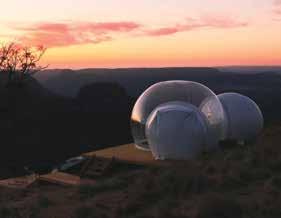
refreshed. To ensure guest privacy, the tent is pitched in an undisclosed location with co-ordinates sent once a booking has been made. The bubble comes complete with a telescope, and an iPad loaded with bird watching apps, music and stargazing app Luminous. Rates start from A$250 per night and A$310 per night on weekends. bubbletentaustralia.com
Uluru climb to close
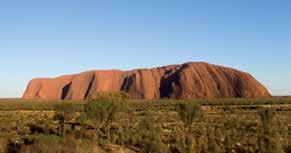
Honouring the wishes of the traditional owners and the Uluru-Kata Tjuta National Park Management Plan 2010-2020, the Uluru climb will close on October 26, 2019. Figures suggest that less than 20 per cent of visitors still want to climb the sacred site. October 26 holds special significance for the region’s indigenous Anangu people; it was on that day in 1988 that Uluru and Kata Tjuta were formally returned to them after many years. The Anangu will host more activities on the ground to tell visitors about their ancient culture.
Sheraton renovation in the works
Sheraton on the Park, Sydney has announced an extensive A$40 million renovation of its 558 guestrooms and suites, and a renovation of the Sheraton Club Lounge. Set for completion in the first half of 2018, the renovation will be helmed by interior designer Joseph Pang who will transform guest rooms with modern residential furnishings and the Sheraton Club Lounge with floor-to-ceiling windows showcasing views of Sydney Harbour, Hyde Park and St Mary’s Cathedral. sheratonontheparksydney.com
www.luxurytravelmedia.com.au 17
MAYUMI IWASAKI
The Louvre Abu Dhabi finally opens to the public
After more than a decade of planning, the long-anticipated Louvre museum in Abu Dhabi has opened its doors on Saadiyat Island. Designed by award-winning French architect Jean Nouvel, the building – which has the name of the iconic Paris institution on loan for 30 years – forms a museum city, set under a vast 180-metre silver dome comprised of almost 8,000 geometric metal stars. The museum and its exhibits are designed to appear as if floating, connected by walkways and completely surrounded by the waters of the Persian Gulf.
The museum will have almost 700 exhibits on display; about half of which will consist of loans from French museums including the Louvre, Musée d’Orsay and Centre Pompidou. Permanent artefacts on display will have a focus on universal civilisations and cultures, with galleries divided according to common ideas rather than origin.
The Louvre is one of three museums that will reside on Abu Dhabi’s ambitious Saadiyat Island, alongside the Guggenheim Abu Dhabi and Zayed National Museum. All three will be designed by Pritzker Prize-winning architects. The development is intended to become the city’s new cultural and business hub and is just a short drive from the St. Regis Saadiyat Hotel and Park Hyatt Abu Dhabi Hotel and Villas. louvreabudhabi.ae
Dubai unveils plans for the world’s first underwater resort
The World islands in Dubai will soon be home to a floating replica of Venice accessible only by boat, seaplane or helicopter. The Floating Venice will technically be classified as a boat, and have rooms and facilities for 3,000 guests spread both above and below the surface.
Nine restaurants, 234 rooms and a collection of traditional artisanal shops will float above the water, with imported Venetian gondolas transporting guests through a winding network of canals.
The lobby, spa, three restaurants and another 180 guest cabins will be under the water, offering 360-degree views
Airports go luxe
The new ‘boutique’ Terminal 4 has opened at Singapore’s Changi International Airport. Though only half the size of Terminal 3, the new terminal features 81 new food and retail outlets, as well as art and sculptures by both local and international designers. Unique design elements include an internal boulevard of 160 trees to separate boarding areas at departure gates, a 70-metre LED screen to keep travellers entertained as they pass through passport security, and the Heritage
of the surrounding marine life. To ensure a flourishing eco-system, almost 40,000 square metres of coral will be grown in an on-site coral nursery and planted around the resort. Twelve floating beaches will surround the resort, as well as 24 pools, some of which will have transparent bases to allow views directly into the ocean below.
The resort will also host Venetian cultural and arts events such as Carnivale di Venezia, Binnale di Venezia and Festa del Rendentore.
Construction of The Floating Venice will begin in 2018, with completion scheduled for 2020. thefloatingvenice.com
Zone, where stores sit behind traditional Singaporean shophouse façades. Roaming robot housekeepers will keep everything looking its best.
Closer to home, Sydney International’s T1 has recently undergone an extensive transformation. A new luxury shopping strip features stores from international brands Kate Spade New York, Hugo BOSS, Emporio Armani, Tiffany & Co., Hermes, Gucci, Rolex, Coach, and Oroton, plus local names like Alice McCall and Samantha Wills.


18 www.luxurytravelmedia.com.au LUXURY TRAVEL DISPATCHES LATEST INTERNATIONAL NEWS
Suite life is sweeter at new Raffles
When the iconic Raffles Singapore reopens its doors in late 2018 it will unveil three new suite categories, bringing the total number of suites from 103 to 115. The one- and twobedroom Residence Suites will be named after famous local cinemas of the 1900s; the
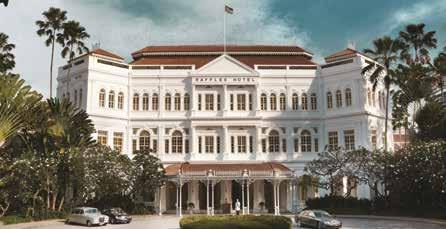
two Promenade Suites have been converted from boardrooms and will look over Beach Road; and Studio Suites have been added to the main building. The hotel has been closed for a complete renovation since February 2017. raffles.com/Singapore
Second Sofitel for Sydney
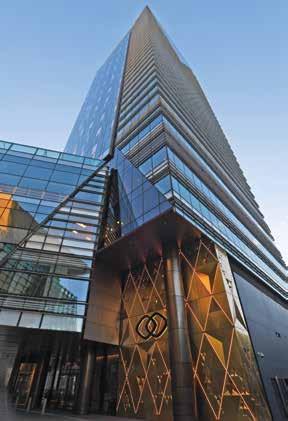
Age of the airship returns
The world’s largest aircraft, a 91-metre helium-filled airship, could soon be used for luxury journeys. British travel company Henry Cookson Adventures has plans to use the Airlander 10 (which is still in its test stages) for international expeditions. The airship potentially has a number of advantages over standard jets. The cabin can be designed with floor-to-ceiling windows and fresh air pumped in; the airship is cheap to run and generates very little pollution; and there’s no need for an airstrip when landing.

henrycooksonadventures.com
Aman arrives in NYC
Scheduled to open in 2020, Aman’s newest property will take up residence in the iconic 20th century Crown Building on Manhattan Island. The second city hotel from this exclusive resort brand will comprise 83 guest rooms and suites, and house 19 private Aman Residences on the upper floors overlooking Central Park. Notable features include a fivestorey, park view penthouse occupying the top of the building, a threestorey spa with a 25-metre indoor pool, a 10th-floor wrap around Garden Terrace, and a Cigar Bar. aman.com/newyork
A shimmering addition to the Darling Harbour skyline, the Sofitel Sydney Darling Harbour marks Sydney’s first new-build five-star hotel in 18 years. Comprising 590 guestrooms and 35 suites with floor to ceiling windows framing spectacular views over the harbour, the hotel also offers guests a lobby bar, a signature dining restaurant serving nouvelle French cuisine, a champagne bar with views over the city and a fourth-floor pool bar. The Club Millesime Lounge is available exclusively to Club Sofitel members with panoramic city views spanning from the Anzac Bridge across the CBD and the harbour. With décor inspired by both Sydney Harbour and the waterside city of Marseille in France, maritime motifs recur throughout the hotel and the carpet is designed to emulate Sydney sandstone. As part of the transformed Darling Harbour tourism precinct, the building has a six-star green rating and the striking glass exterior will be lit up at night. sofitelsydneydarlingharbour.com.au

www.luxurytravelmedia.com.au 19
The new guard
Get ready to check in somewhere new. The Luxury Travel team has shortlisted their most anticipated hotel openings around the world in 2018.
W Brisbane
Brisbane, Australia | Opening March 2018
The 312-room high rise will be the W brand’s first opening in Australia, as well as the first five-star hotel to open in the Brisbane CBD for 20 years. The contemporary complex will sit along the Brisbane River foreshore and will offer three bars and restaurants, a gym, spa and event facilities. starwoodhotels.com

Itz’ana Resort & Residences
Placencia, Belize | Completion 2018
Named after the Mayan god of day and night, this Caribbean beach resort in the sleepy coastal town of Placencia combines contemporary interior design, lush jungles and pristine white sands. At the heart of the resort is the Ernest Hemingway-inspired Great House, home to The Rum Room, where guests can find one of the largest rum collections in Belize. While some suites will open in December 2017, an additional 32 resort suites –including two luxurious penthouses – are due to be completed in 2018. itzanabelize.com.
Hotel St. George
Helsinki, Finland | Opening early 2018
Constructed in the 1840s, this iconic building at Yrjönkatu 13 has been home to the Finnish Literature Society, the Helsinki Finnish Club and the printing house for the first Finnish newspaper. Now a luxury hotel, the building will have 148 luxurious rooms and suites – including sky attic studios with views over the rooftops of Helsinki – and a street-facing gallery. In its opening months, the gallery will feature a large-scale dragon sculpture of bamboo and white silk by renowned Chinese artist Ai Weiwei. stgeorgehelsinki.com.
Shinta Mani Wild Private Nature Sanctuary
Cardamom National Park, Cambodia | Opening mid-2018
Nestled between the oldest national parks in Cambodia – Bokor, Cardamom and Kiriom – this project from renowned resort designer and owner Bill Bensley is also one of his most ambitious conservation initiatives. Perched over one and a half kilometres of river rapids and waterfalls, each custom-designed luxury safari tent will provide the best views of the surrounding jungle and wildlife. The Shinta Mani Foundation will also aid in protecting the 400-acre valley from poaching, mining and logging; working in partnership with organisations including the Wildlife Alliance, Flora & Fauna International and the Cambodian government. shintamani.com/wild

Viceroy Istanbul
Princes’ Islands, Turkey | Opening 2018
A centuries-old Ottoman mansion at the edge of the Sea of Marmara, Princes’ Islands was once known as an escape for exiled Byzantine-era emperors and empresses. Now to be an opulent resort, guests can arrive by private yacht or horse and carriage (the island is car-less), and look across the sea from one of 77 lavish guest rooms to the iconic spires of Istanbul. viceroyhotelsandresorts.com/en/istanbul
Ocean House
Haida Gwaii, British Columbia, Canada | Opening May 2018
This remote 12-room floating lodge lies off the west coast of Haida Gwaii – an archipelago off the coast of British Columbia, often referred to as the ‘Galapagos of the North’. Cultural ambassadors from the local Haida tribes will host immersive experiences and showcase the rugged natural environment, home to whales, eagles and black bears. haidahouse.com
20 www.luxurytravelmedia.com.au
2018 NEW OPENINGS
LUXURY TRAVEL DISPATCHES
W BRISBANE
SHINTA MANI WILD PRIVATE NATURE SANCTUARY
The Tasman
Hobart, Australia | Opening late 2018
Marriott International’s first Tasmanian venture and a future Luxury Collection Hotel, The Tasman will occupy an assortment of repurposed heritage buildings in Hobart’s Parliament Square. The 128-room hotel will feature carefully restored architecture and Georgian and art deco design influences, along with a whisky bar to honour the island state’s booming whisky industry. marriott.com.au
Nobu Barcelona
Barcelona, Spain | Opening late 2018
Hollywood star Robert De Niro, film producer Meir Teper and chef Nobu Matsuhisa’s global luxury lifestyle brand Nobu Hospitality is adding a new property in Barcelona with a multi-million euro refurbishment of the Gran Hotel Torre Catalunya. A signature Nobu restaurant, with 360-degree rooftop views of the city, will sit atop 250 luxurious rooms and suites, designed by architect David Rockwell. nobuhotels.com
Anantara Tozeur Resort
Tozeur, Tunisia | Opening mid 2018

Anantara is opening a new resort in the Saharan oasis city of Tozeur. Each of the 93 lavish guest rooms, villas and pool villas will be decorated in an exotic, Middle Eastern style, and sit alongside several swimming pools, a souk and Tunisian village. anantara.com
LUX* North Male Atoll
Olhahali, Maldives | Opening 2018
The latest property from the LUX* brand, just a short transfer from Male, has replaced the traditional thatched villa with an ultra modern, residence-style penthouse. Each of the 67 overwater or beachfront residences has a minimum living area of 350 square metres, and a 120-square metre private terrace. luxresorts.com
www.luxurytravelmedia.com.au 21
LUX* NORTH MALE ATOLL
Raffles Europejski
Warsaw, Poland | Opening early 2018
First established as a hotel in 1857, this magnificent building in the Polish capital used to be famous for its exuberant New Year’s Eve balls, artist studios and patisserie, which was often busy with writers and poets. Now under the legendary Raffles brand, the hotel has been completely refurbished and restored, and its 106 rooms and suites will be the largest in the city. The Raffles Suite measures an impressive 293 square metres. raffles.com

One&Only Gorilla’s Nest
Rwanda, Africa | Opening 2018
One&Only’s new luxury African resort is to be placed under their new Nature Resorts umbrella, alongside the recently opened Nyungwe House and Australia’s Wolgan Valley. Set in the remote foothills of the Virunga Mountains, the resort will offer daytime treks to observe the wild mountain gorillas living in the region. Less than 1,000 are estimated to still be living in the wild, and one third of these are thought to be in Rwanda. oneandonlyresorts.com/one-and-only-gorillas-nest-rwanda
Chapter & Verse Wuzhen
Wuzhen, Zhejiang, China | Opening 2018
New hotel brand Chapter & Verse is opening its first property in Wuzhen, a 6,000 year old ancient village in Southern China. The art-focused boutique hotel, designed by New York based architects New Practice LLC, overlooks the water and offers 30 guest rooms and two villas; one of which is to be used as an atelier. chapterandverse.co/en
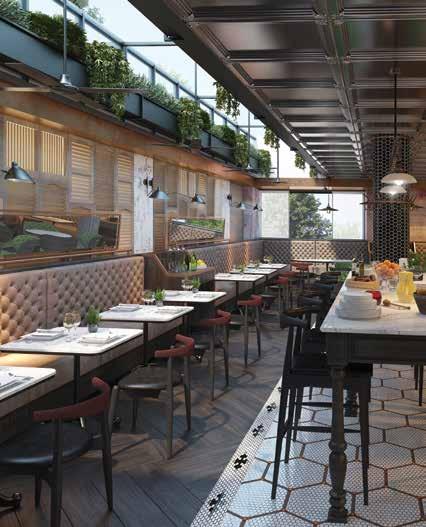
Vintry & Mercer
London,
United Kingdom | Opening 2018
This independent 92-room hotel in London’s historic trading centre is inspired by two of the city’s ancient trading guilds: Vintry (wine) and Mercer (fine silks and fabrics). From the team behind The Ampersand Hotel in South Kensington, the contemporary hotel offers five room categories and a rooftop terrace with views over the city and Southbank. The property is expected to join Small Luxury Hotels of the World upon completion.
vintryandmercer.com
22 www.luxurytravelmedia.com.au LUXURY TRAVEL DISPATCHES 2018 NEW OPENINGS
RAFFLES EUROPESJSKI
VINTRY & MERCER
Opus XVI
Bergen, Norway | Opening April 2018
This historic building in the heart of Bergen was originally a bank, built in 1876. Now owned and run by descendants of Edvard Greig, a famous Norwegian composer, the hotel will offer 65 individually decorated rooms and suites. The main star, however, is the ground floor and facade: a large, open grand room with Ionic columns in polished marble. opusxvi.no
Mandarin Oriental Qianmen
Beijing, China | Opening 2018
Designed to give guests an authentic Beijing experience, this Mandarin Oriental outpost is dispersed throughout the lanes and alleyways of the ancient Qianmen East Hutong Quarter, which dates back to the 13th century. Close to Tiananmen Square, the hotel’s landscaped courtyard suites will blend in amongst the traditional privately owned residences, retail outlets, restaurants and bars. mandarinoriental.com
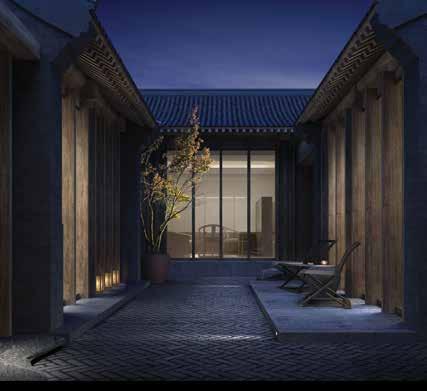
Six Senses Fiji
Malolo Island, Fiji | Opening March 2018
Set within the Vunabaka development, the new Six Senses Fiji will be one of nine Six Senses properties opening in 2018. The 26 bure, 60 residential villa resort will be 100 percent solar powered and the first micro grid in the world to use Tesla batteries. vunabaka.com/six-senses
 MANDARIN ORIENTAL QIANMEN
MANDARIN ORIENTAL QIANMEN
DISPATCHES WHAT TO PACK FOR YOUR SUMMER ESCAPE
Cycladic summer
Hotel Perivolas, housed within the 300 year old cliff top caves of Oia, Santorini, embodies Cycladic style with its sculpted whitewashed walls, low-slung sofas and bright cushions in shades of fuchsia and lilac.
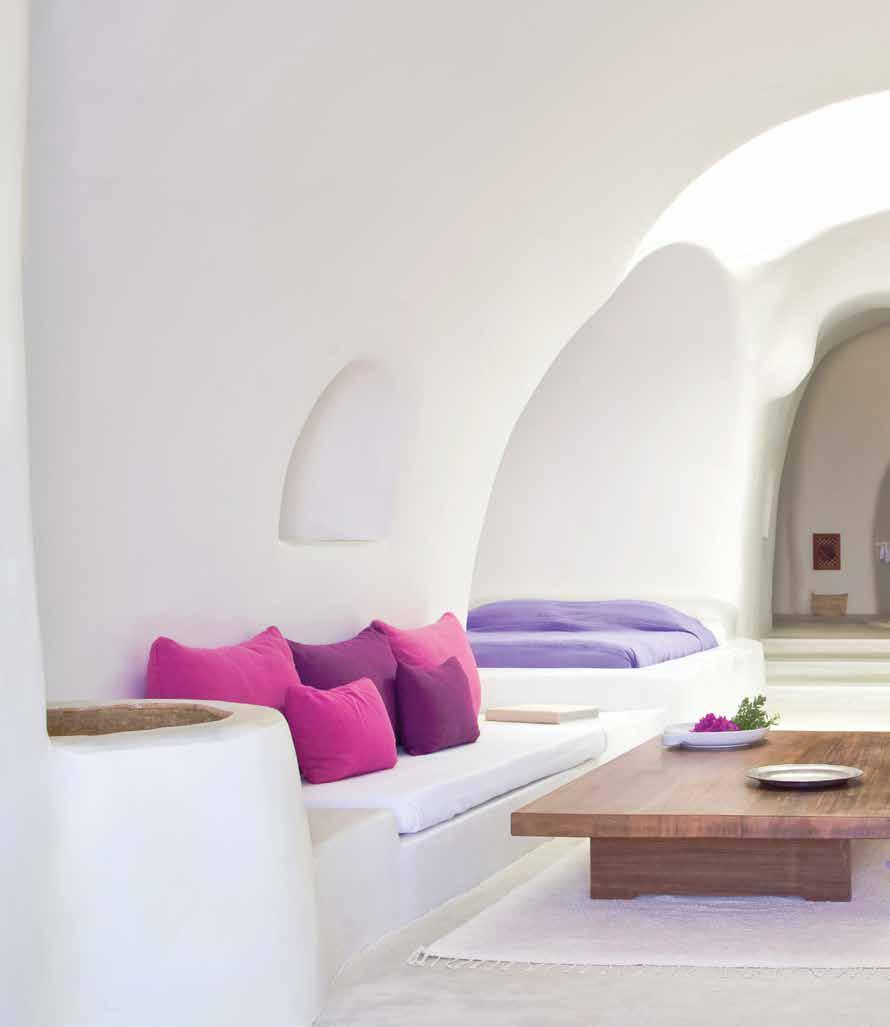
Coach Carry On Dopp Kit in Crossgrain leather – Indigo

A$350
Coach Accordion Wallet in Crossgrain leather – Oxblood

Dolce & Gabbana
Light Blue Eau
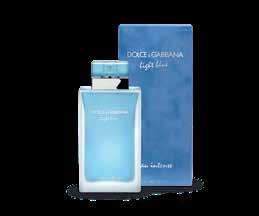
Intense fragrance
A$139
dolcegabbana.com
Lomo Instant Automat camera & lenses in Bora Bora US$179/A$228

shop.lomography.com
A$425
coachaustralia.com
Smythson Mara Sunglasses Case in Storm Blue
A$315
smythson.com

24 www.luxurytravelmedia.com.au
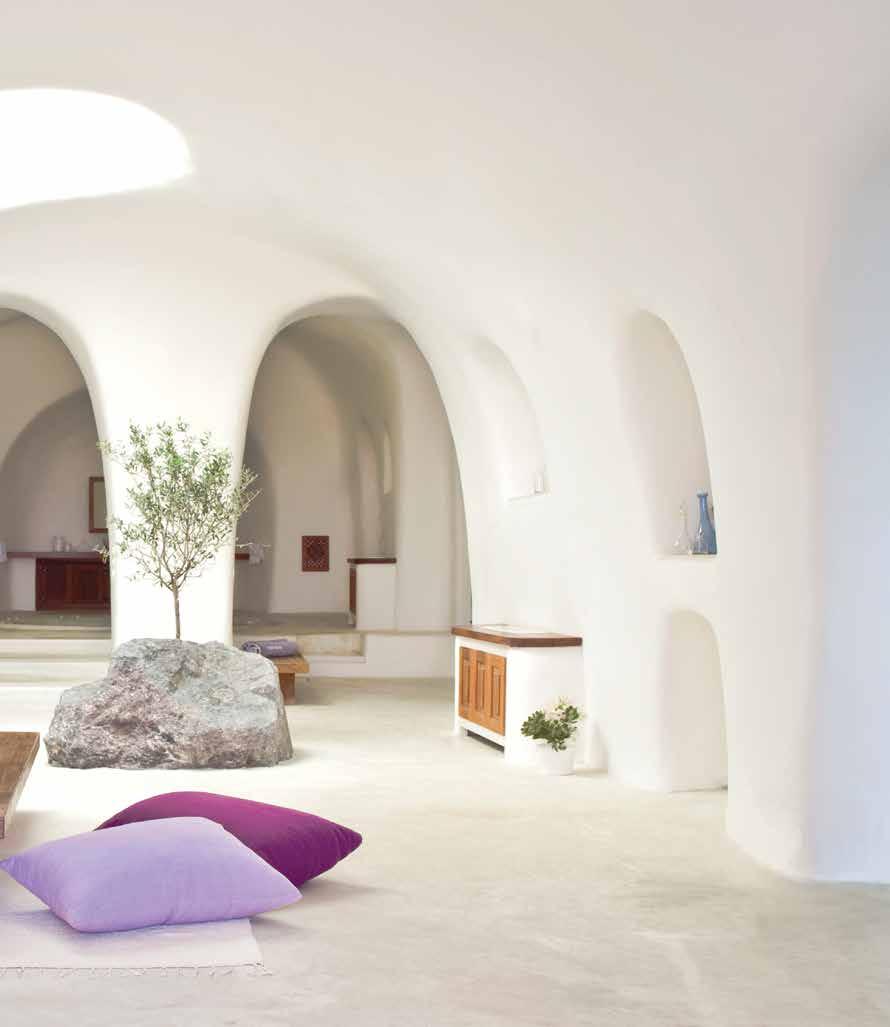




www.luxurytravelmedia.com.au 25 Le Specs Echo sunglasses in Bright Gold – Pink Tint A$89.95 lespecs.com Kora Noni Glow Body Balm A$44.95 koraorganics.com Paradised Riri Side Striped Caftan in Mesh White A$409 saksfifthavenue.com Tod’s Sella bag in Brown From US$2,165 /A$2,756 tods.com
chances Second
Repurposed buildings create intrigue and awe, and leading architects continue to stretch the boundaries in extraordinary ways. Luxury Travel takes a look at some of the world’s most impressive hotel restoration projects.

Cover Story

THE SILO, CAPE TOWN
Past life
Alila Yangshuo
GUILIN, CHINA
To further immerse themselves in the resort’s history, guests can take part in sugarspinning class, using antique vessels to create sweets that can be taken home as a souvenir.
Constructed as a sugar mill in the 1920s, the original owner was an avid art lover with a pioneering sugar-making technique who fell in love with the breathtaking natural beauty of the area. The mill completed a brief stint as a weaponry factory before returning to sugar production until 2002, when work was ceased to preserve the local environment. It was then acquired by a developer with plans to tear it down, but the historical structure was saved by the current directors who purchased the property with the intention of preserving the architecture and heritage of the site.
Reborn
Designed to act as a living gallery, Alila Yangshuo retains an industrial aesthetic and strong links to its history as a working sugar mill. Interiors are decorated with a series of 200 paintings that illustrate

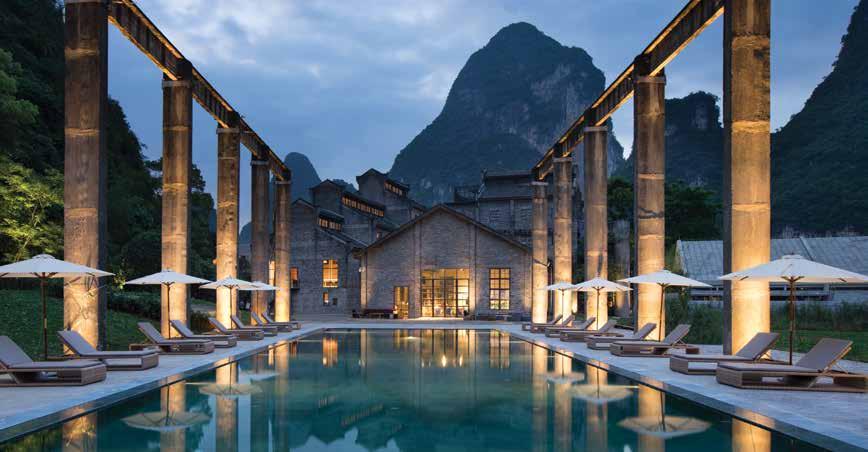
the story behind the hotel, while old sugarmaking tools adorn the walls of the on-site restaurant, The Sugar House. Many elements of the building’s original structure have also been maintained, such as the sugar cane loading dock, which has been transformed into an expansive pool with views over the Li River and the sugar press which remains fully intact in the 1969 Bar. Inspired by the beauty of the original sugar blocks produced in the 1920s, the architect also custom-made the 60,000 hollow bricks of the hotel’s exterior walls using the local sandstone discovered during construction of the underground Spa Alila. The hollow bricks give the building a sense of lightness and, when illuminated from the inside, the building emanates a warm glow.
Rates start from ¥1,190 (about A$233) per night for the Sugar House Retreat. alilahotels.com/yangshuo
28 www.luxurytravelmedia.com.au 20th
Circa Century
Conservatorium
 AMSTERDAM, NETHERLANDS
AMSTERDAM, NETHERLANDS
Past life
Originally constructed by iconic Dutch architect Daniel Knuttel at the end of the 19th century, the building served as the Dutch National Post Savings Bank for almost 100 years. When the bank relocated, the building stood empty for five years before minor remodelling in 1983 converted the space into acoustic classrooms and concert halls, creating the new Sweelinck Conservatorium of Music. More than 20 years later the conservatorium also relocated and the building was transformed into a hotel, which opened in 2011.
“Next to Taiko restaurant, up to the third floor, are the so called ‘secret love stairs’ located where the employees of the Rijkspostspaarbank (bank) used to sneak away and kiss, hence its name.”
Roy Tomassen , General Manager
Reborn
Fittingly located in the heart of Amsterdam’s museum district, the Conservatorium hotel was transformed into its present state by renowned Italian architect Piero Lissoni. The neo-Gothic brick structure has been seamlessly modernised with the addition of industrial steel and glass, the most striking example being the glass-encased atrium that was formerly an open-air courtyard. The guestrooms reflect their previous incarnations as both 19th-century offices and acoustic classrooms, with lofty ceilings, oversized stained glass windows and ex-
posed beams. Almost half of the 129 rooms are split-level duplexes and each has a unique design, with sleek Italian furnishings contrasting elegantly with the historical architecture. The hallway leading from Tunes Bar was once a working space for typists, the clacking of typewriters now replaced by the echoing steps of stiletto-heeled guests headed for dinner at Taiko restaurant. Inside Taiko, exposed brick walls are a statement design feature, an original element preserved from the time when the room was used as an archive for bank paperwork. In the 1980s, it was converted into a drumming classroom for the Conservatorium’s percussion students, a fact which was eerily uncovered after the hotel had named the restaurant Taiko, a Japanese word meaning drum.
Rates start from €575 (about A$869) per night for a Duplex Guest Room. conservatoriumhotel.com

FBI Travel special offer: Stay four nights and pay for three. Includes US$100 (about A$130) spa services credit and upgrade on arrival if available. Offer available until 27 March, 2018. To redeem, contact luxury@fbitravel.com.au
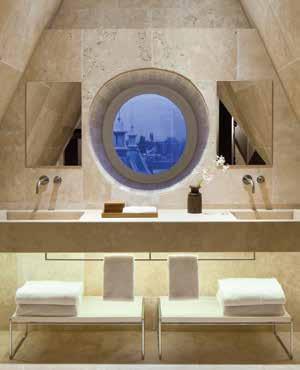
www.luxurytravelmedia.com.au 29 19th
Circa Century
The Warehouse Hotel
Past life
Set on the banks of the Singapore River, The Warehouse Hotel has an eclectic and somewhat scandalous past. The building started life in 1895 during British colonial rule and was initially used as a storage house for spices because of its strategic location along the trade route connecting Asia and the Straits of Malacca. By 1910 the region had gone downhill and the warehouses lining the river became a hub for unlawful activity, housing brothels, illicit distilleries, criminal organisations and opium dens. An underground whisky distillery operated on the premises for a number of years before it returned to legitimate warehousing up until the 1980s. Somewhat unexpectedly, the building was transformed into a disco in 1986 and remained a well-known party hotspot for a decade.
“We’ve heard from taxi drivers who went to tea dances here. Chris (Lee, from Asylum, who did the interiors) knew this space when it was a disco. We met an auntie living up the street who told us she worked here when it was a warehouse. This building is part of our collective memory.”
Wee Teng Wen, Managing Partner, The Lo & Behold Group
original exposed brick walls, soaring ceilings and a signature triple-pitched roof. Singaporean design agency Asylum has introduced a number of new features that reference the building’s history, including custom lights in the lobby inspired by the pulleys used in old warehouses, and a retro-style elevator clad with metal grilles. The front desk houses a selection of items available for purchase that the original warehouse workers would have owned, such as vintage lighters, ashtrays and flasks. In the rooms, locally sourced contemporary products like bedspreads designed by Matter Prints and mugs commissioned by local ceramic studio Mud Rock, complement the historical architecture.
Rates start from A$272 per night for a Warehouse Sanctuary. thewarehousehotel.com
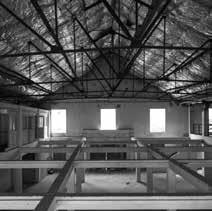
Reborn
Harking back to its pre-disco origins, The Warehouse Hotel, which opened in January 2017, has a decidedly industrial feel, showcasing
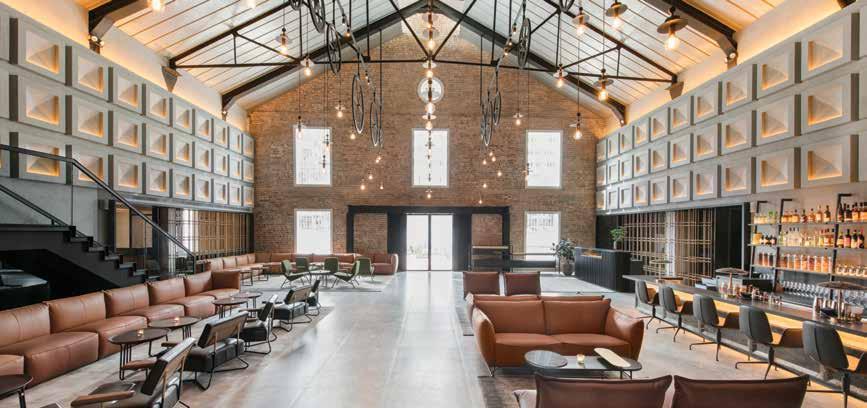
30 www.luxurytravelmedia.com.au
SINGAPORE
19th Circa Century
Executive Edge special offer: Exclusive VIP welcome gift. To redeem, contact leisure@executiveedge.com.au
Hotel Emma SAN
ANTONIO, USA
Past life
A San Antonio landmark, Pearl Brewery produced more than 110,000 US barrels of beer annually during its heyday. While the building is a historically significant Second Empire-style brewery constructed in 1894, its murderous “Three Emmas” backstory is perhaps more remarkable than its architecture. In 1910, Emma Koehler, the wife of Pearl Brewery manager Otto Koehler, was injured in an accident and a live-in nurse, also named Emma, was employed to assist with her care. Otto and the nurse soon began an affair, which eventually expanded to include the nurse’s friend who, rather coincidentally, was also named Emma. Juggling the three Emmas in his life, Otto housed both his mistresses in a cottage not far from the brewery. In 1914, the ‘third’ Emma shot Otto dead with a .32 revolver during a heated argument. Otto’s wife took over as manager and, under her resourceful leadership, the business increased production and managed to survive Prohibition by producing low-alcohol ‘near beer’, ice cream and soft drinks.


Part of Hotel Emma's magic lies in its historical and original elements from the 1800s brewhouse, which can be seen throughout the property. An interesting tidbit is that the the bar top and the vertical rails in our bar Sternewirth are made from a large pecan log unearthed during excavation of the site."
 Beth Smith , director of sales and marketing
Beth Smith , director of sales and marketing
mous mistresses), Hotel Emma combines old-world comfort with original industrial features, preserving and showcasing an impressive number of artefacts from the building’s past life. Some of the most impressive relics can be found in the Elephant Cellar Ballroom which contains the ends of eight elephantine tanks and a chandelier made from bottle fillers. The high-ceilinged lobby also carries a number of vestiges from its former incarnation as an Engine Room, including a large ammonia compressor machine, an array of pipes and the metal XXX symbol used to denote the high quality of Pearl beer. While many of the guestrooms are more recently constructed, those housed in the original Brewhouse tower are distinctive for their striking original brick and plaster walls, which give the rooms a distressed aesthetic carefully counterbalanced by hand-crafted furnishings and a glazed black bed.
Reborn
Named after the brewery’s most successful manager (and two fa -
Rates start from US$350 (about A$458) per night for a Classic Brewhouse Queen. thehotelemma.com
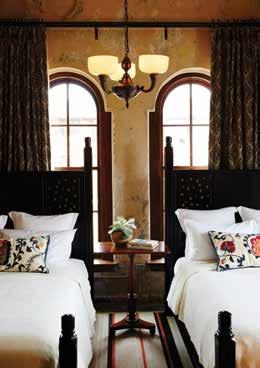
www.luxurytravelmedia.com.au 31
NICOLE FRANZEN 19th Circa Century
19th Circa Century
Inn at Cuckolds Lighthouse
CUCKOLDS ISLAND, USA
Past life
In 1892, US$25,000 was spent on the construction of a fog signal station and a keeper’s house at Boothbay Harbor, Maine, to protect vessels from the treacherous rock ledges surrounding The Cuckolds. A light tower was added to the station in 1907. Two Coast Guard families occupied the Boathouse and Keeper’s Quarters until the mid-1970s when the light was automated and the station decommissioned, leaving the light tower and fog signal to stand watch alone. A few years later, the accommodations were dismantled.

“Every stick of lumber, every nail, even the cement truck to pour the foundation; everything had to be brought by barge to our island in the middle of the Atlantic Ocean! Now, our guests are transported in style to the Inn at Cuckolds Lighthouse in a vessel by a US Coast Guard licensed captain, and their adventure begins.”
Janet Reingolf , Co-Founder & Vice President, Cuckolds Rescue
In 2004, the lighthouse was put up for acquisition. It was no longer needed by the US Coast Guard and threatened with demolition. In 2006, the deed to the lighthouse was attained by a group of local citizens, the Cuckolds Fog Signal and Light Station Council, and volunteers led the restoration project that would follow.
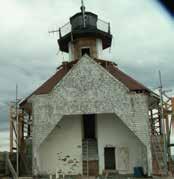
Reborn
Financed by fundraising, a 10-year restoration project of the original
lighthouse saw the exterior restored and the interiors repurposed as two elegant suites outfitted with custom woodwork cabinetry, marble bathrooms and panoramic ocean views. The Keeper’s Quarters, reconstructed to be historically accurate on the outside, is now a small apartment that houses the hotel innkeepers. These innkeepers are the private concierges for visiting guests and prepare breakfasts with produce from Maine coast farms, an English afternoon tea with sherry or port in the parlour, and optional three-course dinners on the shore. The island can be hired for private use and the innkeepers will serve as launch captains for guests on a sunrise or sunset cruise around the island.
Rates start from US$600 (about A$784) per night for a suite based on double occupancy. Rates for the entire island start from US$3,500 (about A$4,572) for a two-night stay based on double occupancy. The tariff includes exclusive use of the island facilities, on-call launch service, large vessel moorings and custom concierge services. innatcuckoldslighthouse.com
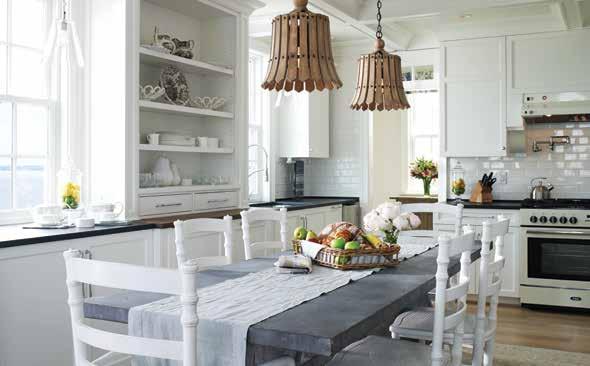
32 www.luxurytravelmedia.com.au
1898 the Post
GHENT, BELGIUM
Past life
Once the major Post Office in the charming canal city of Ghent, the façade of this neo-Gothic building was made from natural stone and embellished with more than 100 escutcheons (crests), statues and a magnificent clock perched 54 metres high at the top of the main tower. Set between the Quai aux Herbes (Graslei) and the Grain Market (Korenmarkt), the building became a local fixture over the years with tracks from the city’s first horse-drawn tramways running along the streets outside. The last service counter was closed in 2001 and the bottom levels of the building have since been converted into a shopping centre, supermarket and breakfast eatery.
“We kept in this building all original elements such as the staircase, the windows, the wooden doors, the blue stone used for plinths and windowsills. If we had to renovate parts of these elements, it has been done in the most authentic way.”
Géraldine Dohogne , Zannier Hotels interior designer.
standard room categories have been aptly named The Stamp, The Postcard, The Envelope and The Letter, reflecting their varying sizes. Framed sketches by architect Louis Cloquet hang on the hallway walls, and in the rooms the original sloped ceilings have been combined with 20th century furniture and cabinets filled with period knickknacks, vintage leather-bound books, and original letters and postcards. Perched in the top southeast octagonal tower and spread across two floors connected by an old winding staircase is The Tower Room – the highest point of the building offering 360-degree views over the rooftops of this historic city. In the old-style bar, The Cobbler, cocktails are served with ice cubes impressively branded with the bar’s logo.
Reborn
In 2017, Zannier Hotels reopened the two upper floors of the Post Office as a 38-room hotel. Harking back to the building’s history, the

Best available rate starts from A$264 per night for The Stamp. zannierhotels.com/1898thepost
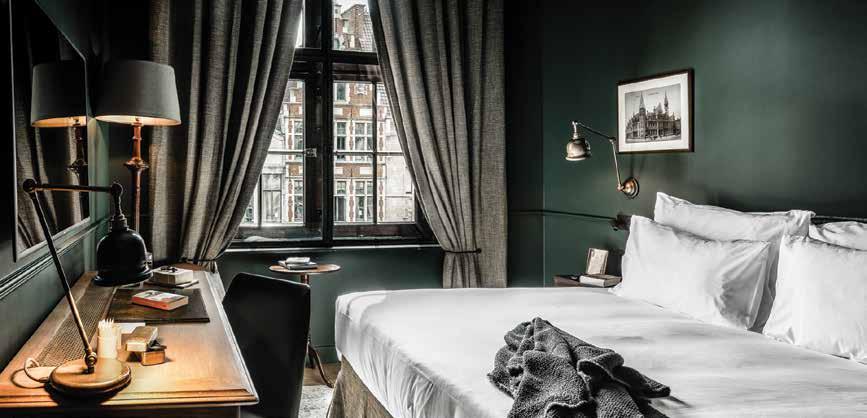
www.luxurytravelmedia.com.au 33
20th Circa Century
The Silo
CAPE TOWN, SOUTH AFRICA
Past life
At the time of its completion in 1924, the old grain silo was the tallest structure in Southern Africa and functioned as a vital export facility and storehouse for grain from farmers all throughout South Africa. The silo was comprised of two main buildings: the elevator tower, where grain was received from the track shed and transported to the top of the building to be weighed, cleaned and bagged; and the 42 cylindrical storage silos. The last shipment of grain was sent to Europe on board the MV Anangel Wisdom in 1995 and operations ceased in 2001.

Reborn
After sitting derelict for six years, conversations began between Londonbased architect Thomas Heatherwick, founder of Heatherwick Studio, and CEO of the V&A Waterfront, David Green, about the future of the historic site. A four and a half year project ensued and saw the team slice through the original 42 cylindrical storage silos to create a hollow atrium made up of tubular cavities. The carved tubes were then capped with a panel of
laminated glass to bring daylight into the atrium and have become the exhibition spaces for the Zeitz MOCAA (Museum of Contemporary Art Africa), which occupies the lower levels of the building. Unsuitable for an exhibition space, the tower portion of the silo complex was fitted with pillowed windows made from 56 hand-cut panels of glass, glazed in such a way that at night they act as glowing beacons for ships in the harbour. Inside these windows, built around the existing elevator shaft and the original steel columns that run every four metres throughout the hotel, are 28 guest rooms, constructed across six floors. In the lobby, a showpiece chandelier by Haldane Martin hangs above original grain hoppers, and an original machine head rises through the floor of The Willaston Bar. The original train tracks remain beneath the restored track sheds, which sit alongside pneumatic machinery at the entrance to the building.
Rates start from A$1,652 per night for a Luxury Room.
theroyalportfolio.com/the-silo

34 www.luxurytravelmedia.com.au
20th Circa Century
The Willaston Bar is named after the first ship to export grain from the original silo complex back in 1924.
Four Seasons Istanbul at Sultanahmet
ISTANBUL, TURKEY
Past life
In the early 20th century Turkey’s first purpose-built prison was constructed in the heart of Istanbul, on top of city ruins thought to date back as far as the fourth century. Originally named Sultanahmet Murder Jail, its inmates facetiously referred to the prison as ‘The Hilton’. Dormitories housed between six and 12 inmates, each categorised by the crimes they had committed. During its busiest period it housed up to 2,000 prisoners. Among murderers and thieves, a string of intelligentsia passed through its walls, with the fifth section of the jail reserved for novelists such as Yasar Kemal and acclaimed Turkish poet Nazim Hikmet. When the prison was emptied in 1969, it remained vacant for the following 10 years, save for the occasional squatter or looter, until it was reopened during a time of martial law in the 1970s to house political prisoners. Its life as a detention centre ended in 1982 and for brief stints over the next few years some rooms were used as a storage house for Ministry of Justice archives.
“The courtyard of the hotel was used as an open air cinema for the locals right after the jail was closed in the mid 1980s.”
Nihat Yücel , Hotel Manager
Enternasyonal Tourism Investments Inc. saw the commencement of a restoration of the exterior of the jail. Aiming to keep as many original elements as possible, the project was led by architect Yalcun Ozuekren and interior designer Sinan Kafadar who, with a team of contemporary Turkish craftsmen, transformed the interiors into 54 luxurious rooms and 12 spacious suites. The high ceilings of the jail cells remain, as do original features like stone, brickwork, tiles, ironwork and some of the same metal window grilles that once signified incarceration. The hotel interiors draw on painting techniques from nearby Dolmabahce Palace and Beylerbeyi Palace, and rooms have been outfitted with contemporary art and artefacts and European period furniture. Concierges stand in the place of prison guards, the rooms skirt a central courtyard that was once the exercise yard for inmates, and prisoners’ graffiti can still be seen on the walls. During the construction phase, on-site excavations led by the hotel uncovered historic artefacts, remnants of frescoes and what they believe to be a fourth century Byzantine Palace beneath the grounds.
Reborn
In 1994, a joint venture between Four Seasons Hotels and Resorts and

Rates start from €250 (about A$378) per night for a Superior Room. fourseasons.com/istanbul/

www.luxurytravelmedia.com.au 35
20th Circa Century
THE KRANE
COPENHAGEN, DENMARK
Past life
Once a cog in the thriving 20th century industrial port on the northern harbour of Nordhavn, the crane was built sometime between 1977 and 1982 and stands 15 metres high. It was used in the transportation of heavy coal loads from ships to the dock. As the need for harbour capacity began to decrease in the following decades, so too did the industrial activities and the crane was decommissioned in 2007. In 2009, a Master Plan was launched by the City of Copenhagen to build a cluster of sustainable villages to aid the housing crisis throughout the capital, Denmark. Industrial harbours like the one at Nordhaven have since been sold and redeveloped into thriving urban districts.
“I visited the crane about three years ago. When the plans for developing it started it looked like it had just been abandoned. There was half a beer next to the chair where the crane operator used to sit and a CD – Vivaldi’s The Four Seasons – in the CD player. Like somebody just left and never came back.”
Owner, Klaus Kastbjerg
Reborn
A two-year renovation period helmed by developer Klaus Kastbjerg and architect Mads Møller saw the coal crane re-opened in 2017 as THE KRANE, an innovative, single-room hotel concept housed inside the original multi-storey structure. With UNIONKUL stamped on its exterior and


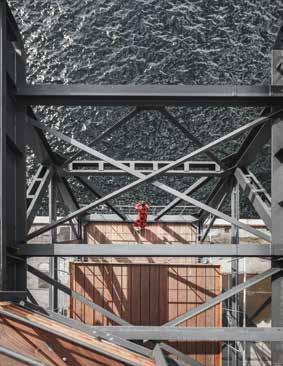

a black interior design concept referencing its coal history and aiming to instil calm, the experience is designed to be remote, minimalist luxury. Guests are collected from the airport by a concierge and driven to the harbour where they are taken through the four levels: a reception area on the ground floor, a glass meeting area on the first, the spa and terrace on the second, then the KRANEROOM. Once the crane’s engine room, the KRANEROOM has been transformed into a sleek suite with a lounge and balcony and 360-degree views over the water. Coloured in varying shades of black, the interiors maintain an industrial feel with custom designed furniture made from leather, wood, stone and steel. Cupboards have been integrated into wall panels, and the bathroom is fitted out with two separate bathtubs set against a glass wall overlooking the harbour. The spa, which extends out from the crane’s base structure, has been converted from an old shipping container and is entirely clad in polished stone.
Rates start from €2,500 (about A$3,784) per night based on double occupancy. thekrane.dk
36 www.luxurytravelmedia.com.au
20th Circa Century
Monastero Santa Rosa Hotel & Spa
AMALFI COAST, ITALY
Past life
When the ruins of the church of Santa Maria di Grado were gifted to Sister Rosa Pandolfi, a descendent of noble Italian family Pontone di Scala, she used her fortune to fund the reconstruction of the monastery. Dedicated to St Rose of Lima, the convent was completed in 1681. Throughout the 17th century, the sisters who lived inside the walls became renowned for their sfogliatelle, a shell-shaped cream-filled pastry (eventually dubbed sfogliatelle Santa Rosa), and for their apothecary skills, using herbs from their monastery garden to create remedies for the community. Due to a drop in entrance numbers, the convent was handed over to the municipality in the mid 1800s and the remaining nuns were allowed to reside on the property until 1912 when Mr Marcucci, a Roman hotelier, purchased it. In 1924, after the addition of modern conveniences, he reopened the convent as a hotel, which was run by the Caterina family for the following three generations until their death, and it was again left unoccupied.
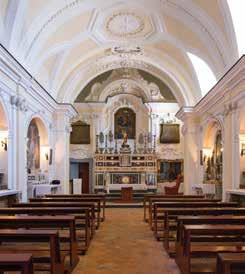
“At the bottom of the stairs leading to the terrace at Monastero Santa Rosa, there is a short corridor with three small stalls, each with a seat and a small window above. Apparently, during the times of the monastery in the 17th and 18th centuries, these were the draining spots for a just dead person (a nun, of course) before mummification and burial. I myself wondered if that could be true, but I have since seen these same ‘thrones’ in duomo basements.”
Bianca Sharma , Owner
in the Gulf of Salerno. Not long after, she purchased the convent and, working alongside a team of architects, began conversion of the ruins into a boutique luxury resort and spa, which opened in 2012. Maintaining the structural integrity of the clifftop building, the nuns’ rooms were converted into 20 rooms and suites, each named after a herb used by the sisters in their apothecary days. The walls of the suites are covered with historical images captured before the renovations and the highvaulted ceilings of the original monastery are showcased in the rustic spa. Locals still come for mass in the 17th century church that remains on the property, and guests can visit the original confessional in the hotel’s main corridor and confess their sins on pieces of paper that can be slipped into a wooden box (in place of a nun). One sweet memory that remains is that of the sfogliatelle Santa Rosa pastries, which are still prepared by the chefs and served to guests at breakfast on the al fresco terrace overlooking the Mediterranean.

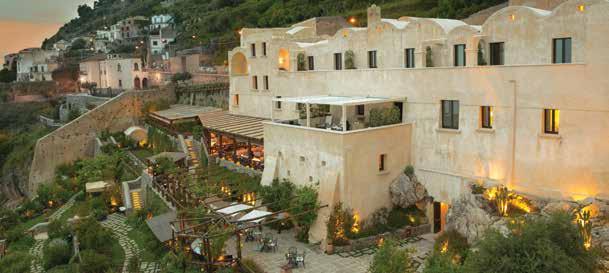
Reborn
Bianca Sharma first saw the ruined monastery when she was boating
Rates start from €400 (about A$605) plus VAT per night for a Sea View Superior Room. monasterosantarosa.com
www.luxurytravelmedia.com.au 37
17th
Circa Century
Miss Clara STOCKHOLM, SWEDEN
Past life
This Art Nouveau hotel was first built in 1910 as a private school for girls. Known as Ataneum, the inner-city Stockholm school quickly became one of the most recognised girls’ schools in the country. This was largely due to its unconventional teaching methods, such as compulsory gymnastics classes, which took place in the prayer hall. Today, this is the Etage Suite, and still features the original large arched windows. The building then served as an office for a number of years before it was remodelled into the current hotel, named after the school’s first and favourite headmistress, Clara Strömberg.

“Clarity, palpable comfort and intuitive function were our philosophies with this project. We wanted to instil a subtle feeling of déjà vu, a bit like if it had always looked like this – but above all very genuine, comfortable and smoothly functioning.”
- Gert Wingård , Architect
formed under the watchful eye of award-winning architect Gert Wingårdh. Hallmarks of the original architecture such as the dark wood panelling and high ceilings have been kept intact, alongside the original 1910 spiral staircase. Interiors are contemporary and practical with materials such as Swedish limestone, oak and leather used to create functional custom-made furnishings including bench seats and in-room storage units. Marble baths and herringbone parquet floors add a sense of elegance and femininity, paying homage to the building’s origins.

Reborn
Acquired by Swedish hotel group Nobis, the building was trans -
Rates start from A$310 per night including breakfast. missclarahotel.com
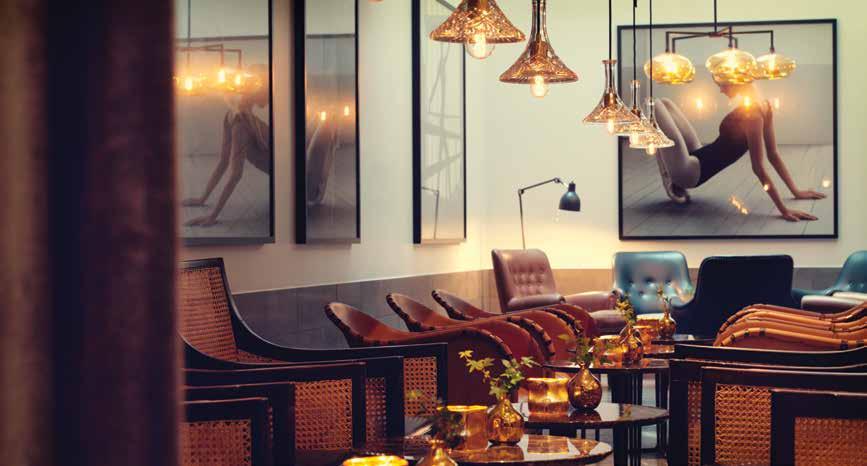
38 www.luxurytravelmedia.com.au
Circa
20th
Century
Past life
Spitbank Fort
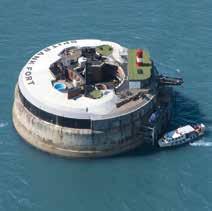 PORTSMOUTH, ENGLAND
PORTSMOUTH, ENGLAND
Reborn
When Napoleon III became the Emperor of France in 1852, fears of a French invasion spread across Britain. This resulted in the construction of four bastions in the Solent strait, off the coast of Portsmouth, to defend the Royal Navy fleet at anchor in Portsmouth harbour. The French threat never materialised and Spitbank, along with the other forts along the south coast, became known as Palmerston’s Follies. Despite offering some military advantage during the Second World War, Spitbank became redundant in 1952 but it was said that a supernatural presence remained long after the soldiers abandoned its corridors. The day before it was due to be knocked down, Spitbank was sold to AmaZing Venues who successfully converted it into a five-star retreat.
Even today the Blacksmith Forge is still in use as the Fort's Barbecue.
Spitbank opened as a luxury hotel in June 2012, fitted with an open-air heated pool, gym, library and wine cellar. Interior spaces have been converted into cavernous suites, equipped with modern bathrooms and opulent, old-world furnishings. The exposed brick walls and metal beams remain, along with large metal hooks from which the soldiers’ hammocks once swung. An old gun port doubles as a window, allowing views of the surrounding water. For those seeking views from a higher standpoint, the Crow’s Nest function room can become a bedroom suite on request, with floor-to-ceiling windows and a private balcony.
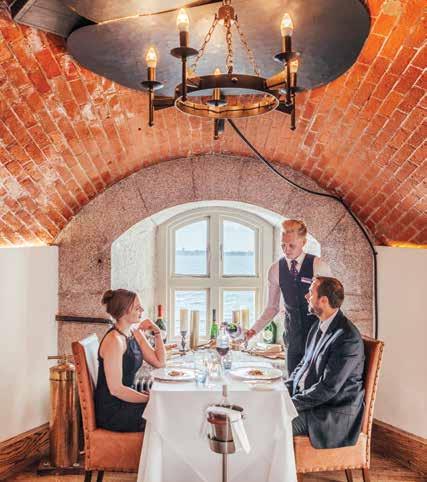
Rates start from £600 (about A$1,027) per night for the Commodore Suite. solentforts.com/spitbank-fort/
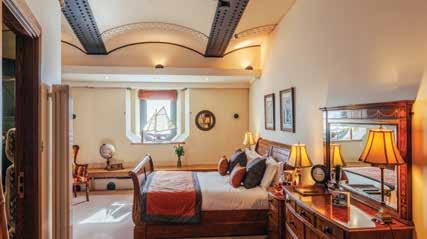

www.luxurytravelmedia.com.au 39
19th Circa Century
The Singular Patagonia
PUERTO BORIES, CHILE
Past life
At the end of the 19th century, a group of European-born pioneers descended on the rugged southern coast of Chile and built a large sheep processing plant. This was the first presence of sheep production (meat, wool and leather) in Chile, and the industry took off, exporting much of the processed goods to Europe. Between 1932 and 1942, more than 2.2 million animals were processed; the existence and growth of the port city of Puerto Natales was largely due to the success of this factory.

Reborn
“People from around the area come and visit us and they tell us what their parents and grandparents used to do while they were working in the [meat processing plant]. Once a visitor told me where the old safe used to be, and it was the size of a small bedroom located in what is today our conference room. We try to keep these stories alive by passing them on from one staff member to another, from one guest to another.”
Ximena Dipp , Hotel Manager
now a member of The Leading Hotels of the World collection. What was once the cold storage space is now 57 guest rooms and suites, and the restaurant, bar and communal areas are housed in the old tannery. Efforts were made to restore the building to its original form – it has a rustic warehouse feel, with exposed brick walls and preserved century-old industrial machinery. Guests traverse elevated walkways on the way to dinner, passing old, intact machine rooms and tannery equipment. Despite the old touches, the hotel has a strikingly modern feel, with elegant furnishings, contemporary glass walls and pendant lighting.
In 1996, the plant was declared a National Historical Monument and two years later the great grandsons of the original settlers acquired the then-derelict factory. Various Chilean architects and designers took on the project, and in 2011 it was unveiled as The Singular Patagonia,
Rates start from US$425 (about A$555) per night for a Singular Room in low season, including breakfast. thesingular.com/en/hotel/patagonia

40 www.luxurytravelmedia.com.au
19th Circa Century
Belmond Palacio
Nazarenas CUSCO, PERU
Past life
This restored 16th century colonial mansion and convent-turned-hotel sits on the edge of Nazarenas Square, a picturesque cobbled plaza in the ancient Peruvian city of Cusco. The building’s foundations trace back to pre-Inca times – trademark Inca fine-cut stones can still be found within the walls –but much of its history belongs to its time as a conquistador’s palace. Spanish warrior Mancio Serra de Leguizamón erected a mansion he called the House of the Serpents, named after the snakes on his shield, and had elaborate serpents carved into the building’s facade. A century later, the mansion was bought by priests who used the building to educate the children of the local nobles. But an earthquake soon after left the building in serious disrepair and the project was abandoned. The mansion was then given to the local nuns of Jesus Nazareno, who repaired the building and, in 1745, added a church and entrance hall. In the following centuries the convent was used as a school and a home for impoverished women, before it was left deserted for a number of years. In 1998, the property was obtained by Peru Hotels, and plans were put in place to transform it into a luxury hotel.

“One of the most amazing highlights of this ancient property are the murals which form a part of Cusco’s heritage, and are located throughout the hotel. Most of these colourful murals date from the 18th century and tell stories representing the natural world, everyday life and some also have a religious theme. It took a huge effort in restoring these, but we now have these magnificent treasures to take care of.”
Arturo Schwarz , General Manager
Reborn
Now a Belmond hotel, the Palacio Nazarenas seamlessly blends contemporary touches with preserved architecture. Many of the colonial murals and paintings throughout the property were painstakingly revived by Cuscoborn art restoration specialist William Gamarra. Cloistered courtyards, ancient octagonal fountains (with Incan water systems) and a 19th century chapel have also been restored. More than 20 gold-framed paintings the nuns collected over the years can be found hanging on the chapel walls, and the old hinged doors of the conquistador’s mansion still grace the entrance. The city’s first outdoor swimming pool forms part of the new additions, alongside a spa and yoga terrace, and 52 suites. The Nazarenas Suite, which originally belonged to the Mother Superior, features a vaulted ceiling with carved, hand-painted roses and a balcony overlooking the square.
Rates start from US$495 (about A$645) per night for a Studio Suite. belmond.com/hotels/south-america/peru/cusco/belmond-palacio-nazarenas/
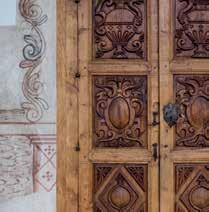
www.luxurytravelmedia.com.au 41
16th Circa Century
Dunton Hot Springs
COLORADO, USA
Past life
This 19th century mining camp-turnedghost town began its life as a tiny, sparsely populated settlement in remote Colorado. Set high in the Rocky Mountains, this logstructure mining camp (which had a population of less than 50) sat beside the West Dolores River, where carts of iron ore were trailed across a rickety bridge by a single mule. The camp was so isolated that outgoing and incoming supplies had to be freighted for very long distances; even when the Rio Grande Southern railroad was built, the nearest rail connection was 14 kilometres away. Production peaked around 1905 and the town reached a population of almost 300 people. By 1910, however, most residents had departed and by 1918 it was completely deserted. Eventually long-time residents Joe and Dominica Roscio returned and transformed the settlement into a cattle ranch. In the 1970s and 80s, it was used as a ranch for tourists, but by the 1990s it had closed down and was once again up for sale. It was then that German investor Christoph Henkel purchased the camp with the intention of turning it into a luxury destination.
“When the renovation of the town of Dunton from a ghost mining town into a luxury resort began in 1994, the owners found a case of Dickel whisky under the floorboards of the saloon. The whisky had been stashed there during Prohibition, so it had been there for a while! That original case is long gone, but it’s the reason we still use Dickel as our house whisky today, and keep a bottle with glasses in the library for all guests to enjoy.”
Edoardo Rossi , Executive Vice President.
Reborn
After a seven-year design and renovation process, Dunton Hot Springs was born. Twelve log cabins ranging from one to five bedrooms and one luxury canvas tent cluster around the original wooden structures of the town centre and main street. The 19th century saloon is the star of the retreat – outlaw Butch Cassidy’s signature is famously etched into the top of the bar. It’s here that the retreat chefs prepare a new menu each day which, to honour tradition, is served at set times around a long, antique table. Despite the mining-camp feel, the cabins are luxurious; fitted out with sumptuous oldworld furnishings and all the modern amenities including WiFi, hairdryers and bathrobes. When not relaxing at the retreat, guests can keep busy exploring the 1,600 acres of surrounding wilderness. Natural hot springs, mountain bike and horse-riding trails and nature walks are abundant, while one of the most spectacular fly-fishing spots in Colorado lies 10 minutes downstream.

Rates start from US$630 (about A$820) per night for the Echo Cabin. duntonhotsprings.com
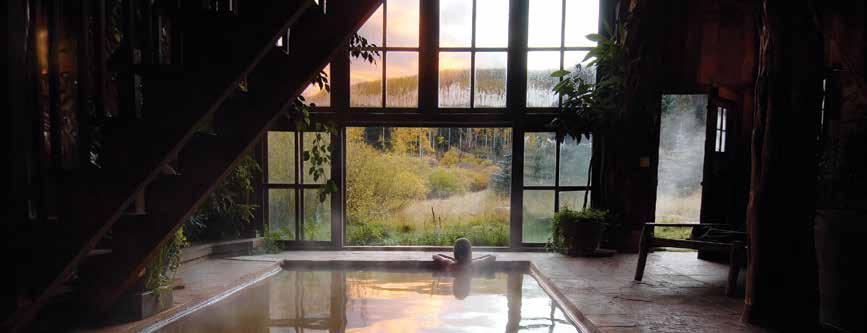
42 www.luxurytravelmedia.com.au
19th Circa Century
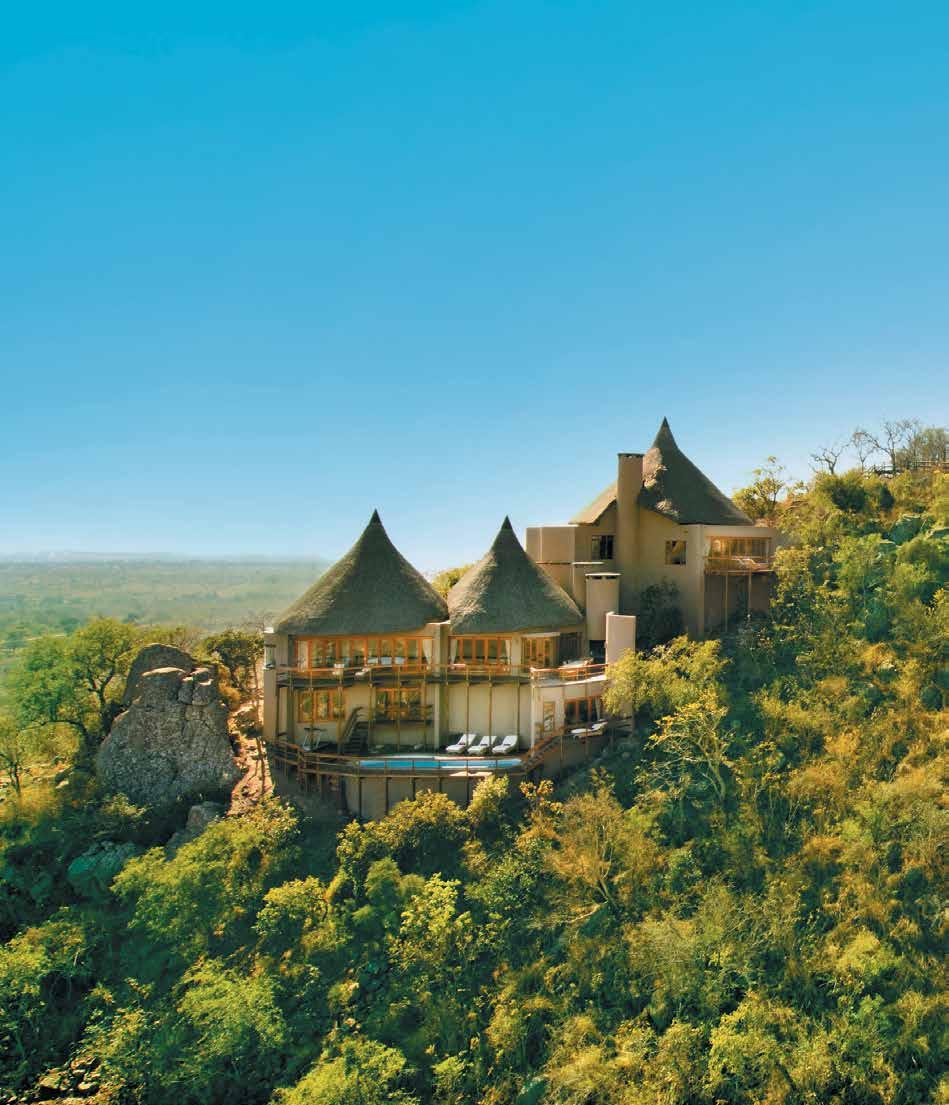
44 www.luxurytravelmedia.com.au The 14th annual Gold List awards will be announced in May 2018. The Gold List awards celebrate the best in luxury travel in Australia and around the globe as voted by our readers. Don't miss your chance to vote. www.luxurytravelmedia.com.au/gold-list VOTING For Gold List enquiries, please contact Tom Hachenberg at thachenberg@luxurytravelmedia.com.au
OPEN



www.luxurytravelmedia.com.au 45
Andreas Kohn keeps the world moving
“We are excited to see ILTM Asia Pacific’s portfolio expand in tandem with Capella Hotel Group’s growth within the region. ILTM Asia Pacific in Singapore will be an absolute winner, and we are thrilled to have this event taking place at our home base.”
Andreas Kohn, Vice President, Sales & Marketing, Capella Hotel Group

#keeptheworldmoving
www.iltm.com

www.luxurytravelmedia.com.au 47 048 Patagonia 054 Malaysia 062 Chicago DESTINATION
The end of the earth
Not usually the outdoorsy type, Lucy Jones finds her inner adventurer in inspiring Patagonia.
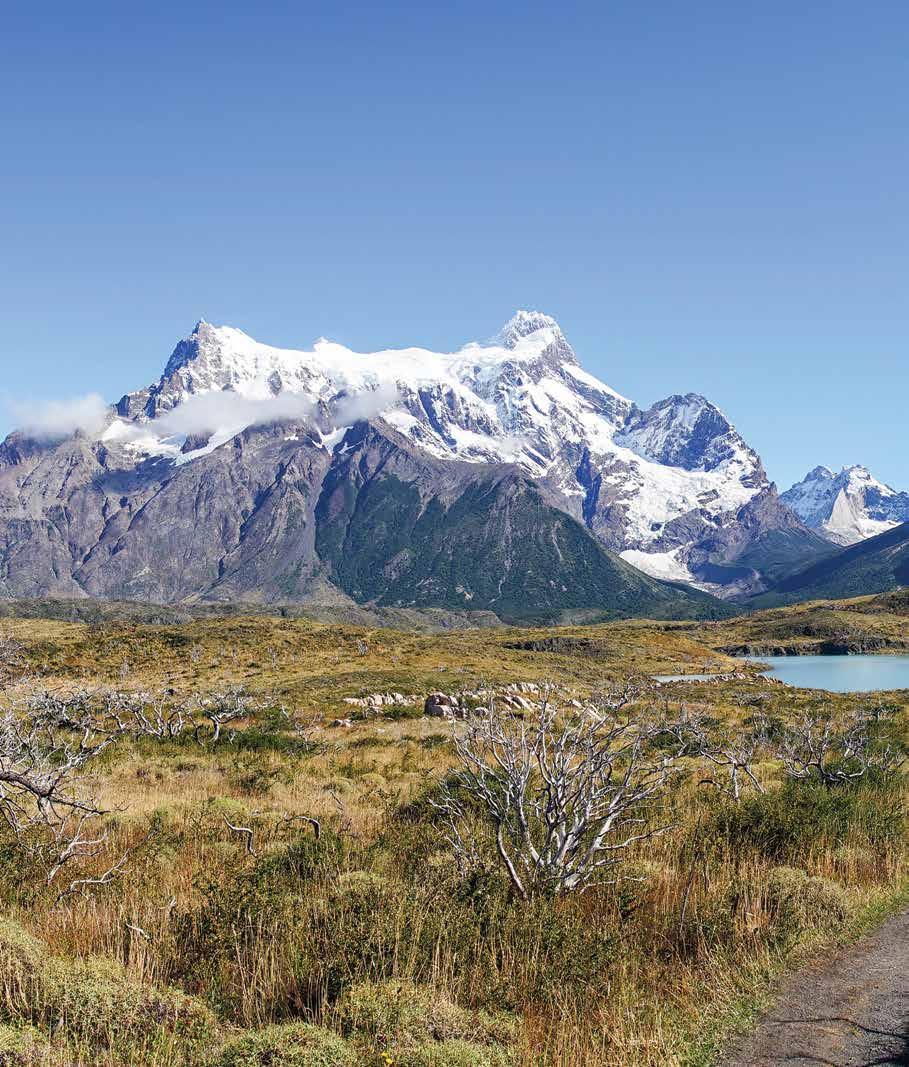
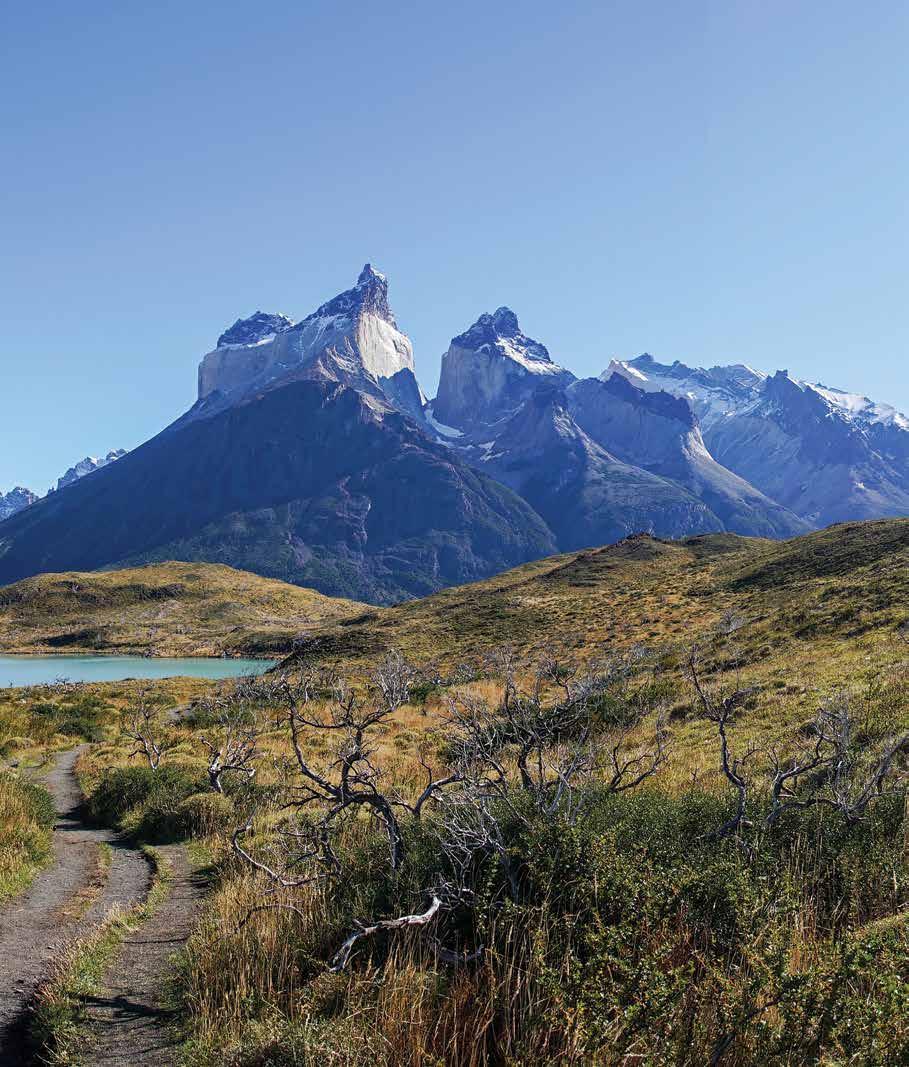
www.luxurytravelmedia.com.au 49 MARK CUNICH
DESTINATION


It takes a long time to get to the end of the world. The flight from Santiago to Punta Arenas, the southernmost major city in the world, takes around three and a half hours. Then it’s a four and a half hour drive north, hugging the border between Chile and Argentina, before reaching the Torres del Paine National Park. But as soon as we cross into the park, it’s all forgotten.
The Torres del Paine National Park is an exercise in oversaturated colours. The water here looks like a series of Pantone swatches, too bright and brilliant to exist in the real world. When the sun hits it, it seems to glow from within. The jagged peaks of the Torres del Paine massif tower over the scene, reflecting the light back in a rainbow of dusty pinks and silky greys.
There’s a stark, windswept quality to the park, compounded by the fact that much of the ground is covered with the scorched skeletons of trees. In December 2011, an Israeli tourist burning toilet paper (strictly prohibited in the park) started a devastating forest fire. In just over a week, the blaze destroyed almost 40,000 acres, around seven per cent of the park’s total area.
The park is renowned as one of the world’s great hiking and trekking destinations, attracting up to 300,000 visitors each year looking to tackle trails like the famed W and Circuit. So I’m nervous. I don’t really like hiking. My idea of being ‘outdoorsy’ is drinking rosé on the balcony. I fear I will be hopelessly out of my depth; that groups of rangy North Faceclad trekkers will laugh at me and my hastily borrowed hiking boots.
But here’s the thing – your time at the luxurious explora Patagonia lodge can be as gruelling or as graceful as you like. Each night from 7pm, the team of guides comes around to every group to discuss the tours on offer the next day. The weather dictates many of the options, but the guides are realistic about what to expect and choose routes that will be the most protected. If you’re travelling in a group, they will do their best to customise something so you can get the most out of your day. Intrepid adventurers can be out all day, exploring the park on foot or from the saddle. Some of the expert treks on offer cover 25 kilometres and ascend almost 1,000 metres.
At the same time, there are always low key options; comfortable hikes that will only take a couple of hours or gentle horserides perfect for beginners. And there’s no judgment if you opt for an easy walk in the morning, return to the lodge for a swim in the heated pool or soak in the hot tub, then head to the dining room for a three-course lunch with wine. You can spend the afternoon curled up by the fire with another glass of malbec or a pisco sour, leaving plenty of time for a nap before dinner (three courses, naturally).
The lodge itself is our cocoon from the harsh environment outside. It resembles a ship, both inside and out, and gives the feeling that we are safely docked here at the end of the earth. My huge bed (surely larger than a king) faces towards the window and looks out over the small Salto Chico waterfall. Rooms on the other side of the lodge have views over the Torres del Paine massif and Lake Pehoé.
explora is all-inclusive (and even if it wasn’t, there’s nowhere else to go), so all guests descend on the dining room for dinner. Excited voices chatter in English, Spanish and Portuguese, sharing stories from the day and plans for tomorrow. The food is exceptional; freshly baked bread, grilled fish, tender steaks, interesting salads and hearty stews, all washed down with local wines. Chileans are known for their sweet tooth and I eat a mille feuille so good I still think of it fondly.
The weather forecast for our first day isn’t good, but it turns out to be much worse. The wind is vicious and the icy sleet comes at you with such force that it feels like it’s been fired from a cannon. So our choice of a boat tour to the Grey Glacier was a fortuitous one. The boat is operated by a nearby property, Hotel Lago Grey, and comes at an additional cost (about A$150). It cuts through the choppy grey water, cruising around small icebergs that shine a bright blue-white, before reaching the imposing face of the Grey Glacier. The glacier marks the start of the Patagonian Ice Field, the third largest mass of ice on the planet behind Antarctica and Greenland, an endless swathe of white covering more than 20,000 square kilometres.
Day two dawns a little brighter, though the wind still blows with tooth-chattering inten-
50 www.luxurytravelmedia.com.au
PATAGONIA
“
The jagged peaks of the Torres del Paine massif tower over the scene, reflecting the light back in a rainbow of dusty pinks and silky greys.
“
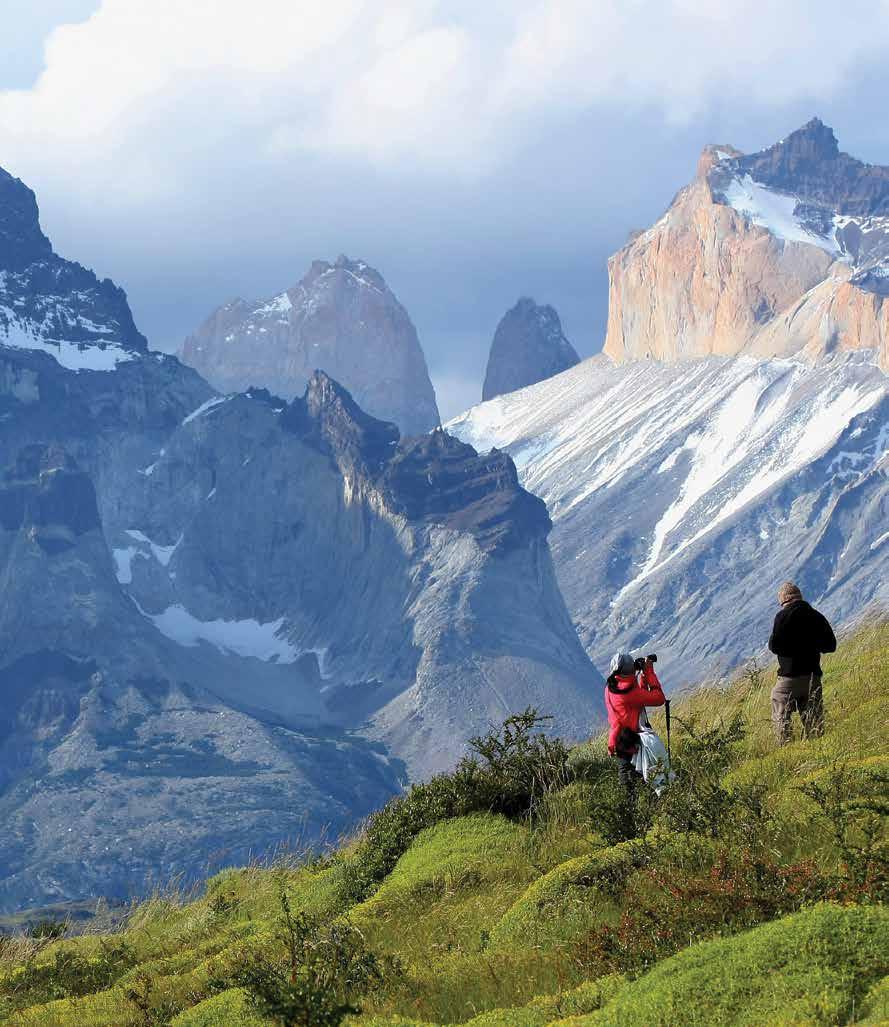
TORRES DEL PAINE
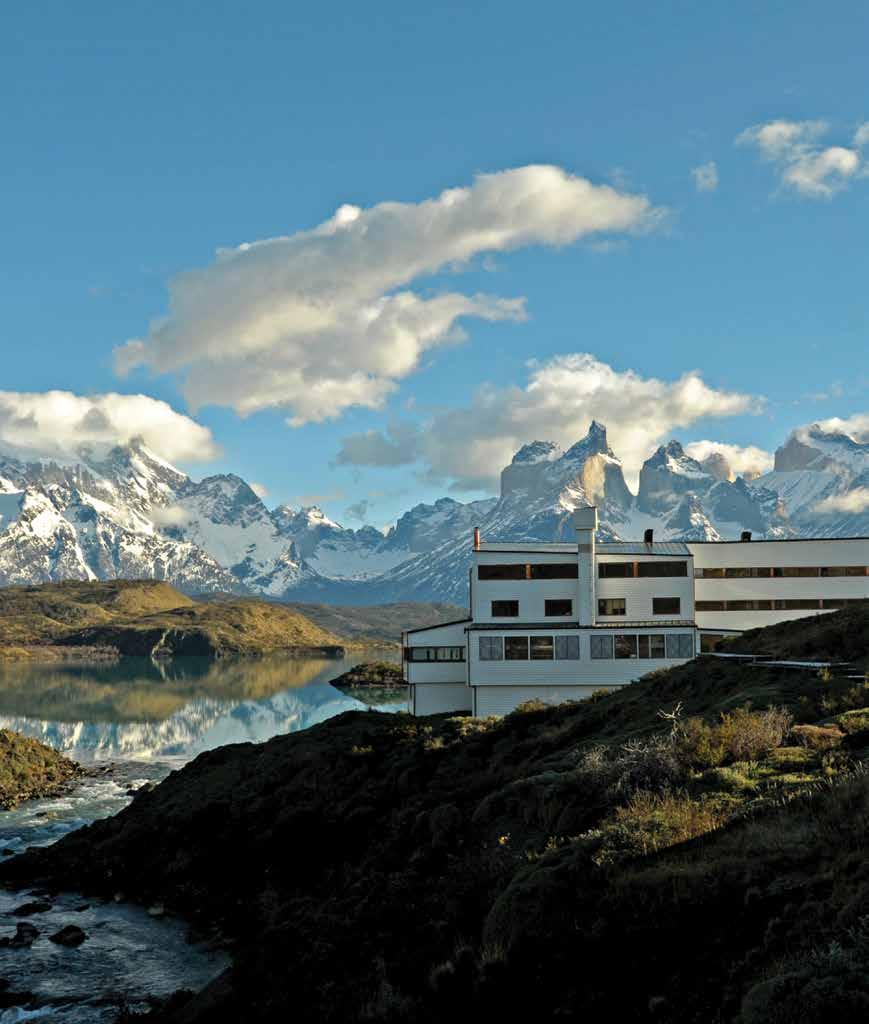
EXPLORA PATAGONIA
sity. Half of our group has chosen a hike along the Pingo River, through lush green forest and waterfalls brought to life by recent rains. I choose something less muddy, opting for a gentle walk along the shores of Sarmiento Lake. The edge of the lake is lined with rocky, coral-like formations that look unremarkable but are, in fact, one of the oldest life forms on earth. Thrombolites are essentially living fossils and the closest example of what life would have looked like billions of years ago at the dawn of time.
In the afternoon, we make our way down to the stables a few kilometres from the main lodge. The idea of a gaucho, or South American cowboy, is generally associated with Argentina, but it’s an important part of the culture here in Chilean Patagonia as well. Gauchos are expert horsemen and men of few (if any) words, decked out in a jaunty beret and leather chaps. The horses are well cared for and placid, though still with enough kick to make the ride interesting. We wind through the pampas (low grass fields), up small rocky hills and across shallow rivers. Experienced riders can test their limits,
galloping across the open fields at the heels of a gaucho with barely a pause to catch your breath.
On my final morning, we wake to a perfect day. The peaks of the Torres del Paine glow fiercely in the bright morning sunlight and there’s barely a breath of wind. Even the guides seem stunned by the show. We are leaving at midday, but there’s just enough time for the Nordenskjöld hike, an easy six-kilometre loop that starts not far from the lodge. We walk along a wide path, rocks crunching under our feet, towards the everincreasing roar of the Salto Grande waterfall. The ice blue water pours over the 65-metre drop, throwing sparkling rainbows of spray into the air. The trail continues towards the base of the mountains, passing gentle hills and more of those preternaturally blue lakes. Nordenskjöld itself is a wonder – brilliantly turquoise and shining from the sun.
On the return journey, we spot a group of a dozen or so guanaco (similar to a llama) on a nearby ridge. It seems they spot us too and wander down to within just a few metres of the trail. They follow along beside us for some time,
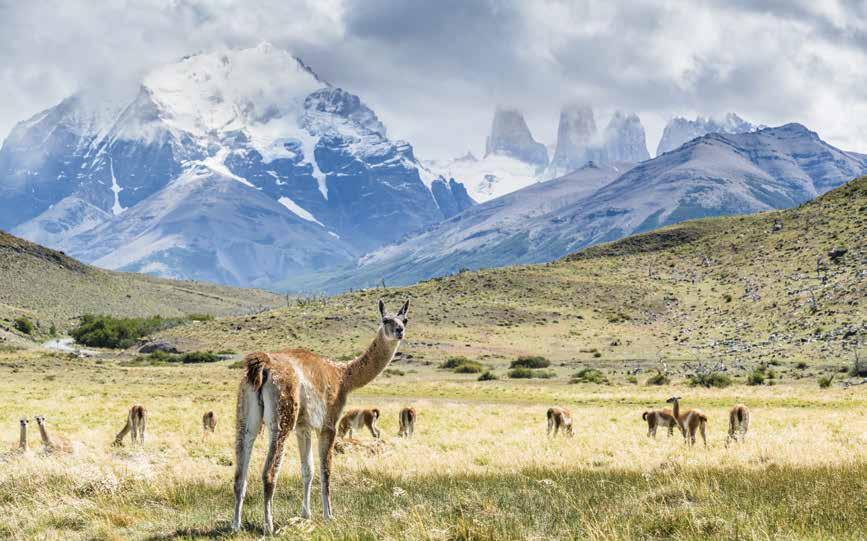
all spindly legs, doe eyes and fluffy tails, munching happily on grass shoots. I take it as a sign, a kindly farewell from the park that has accepted even the most inexperienced adventurer.
The writer travelled as a guest of Adventure World Travel and LATAM Airlines.
See more images from this story at luxurytravelmedia.com.au
Stay

Adventure World offers a four-night stay at explora Patagonia, the only lodge at the centre of Torres del Paine National Park. A range of daily explorations available to suit every ability are led by specialist naturalist guides. Prices start from A$4,495 per person for an all-inclusive stay. See adventureworld. com.au or call 1300 295 049.
LATAM Airlines flies direct from Sydney and Melbourne to Santiago, Chile, and from Santiago to Punta Arenas. latam.com
www.luxurytravelmedia.com.au 53
GUANACO IN TORRES DEL PAINE SERGEY DIDENKO/SHUTTERSTOCK.COM
Coast to coast
Kuala Lumpur, Penang and Melaka stand firm as Malaysia’s tourism stars. But on his journey east to west, Matt Shea found plenty to love off the beaten track.
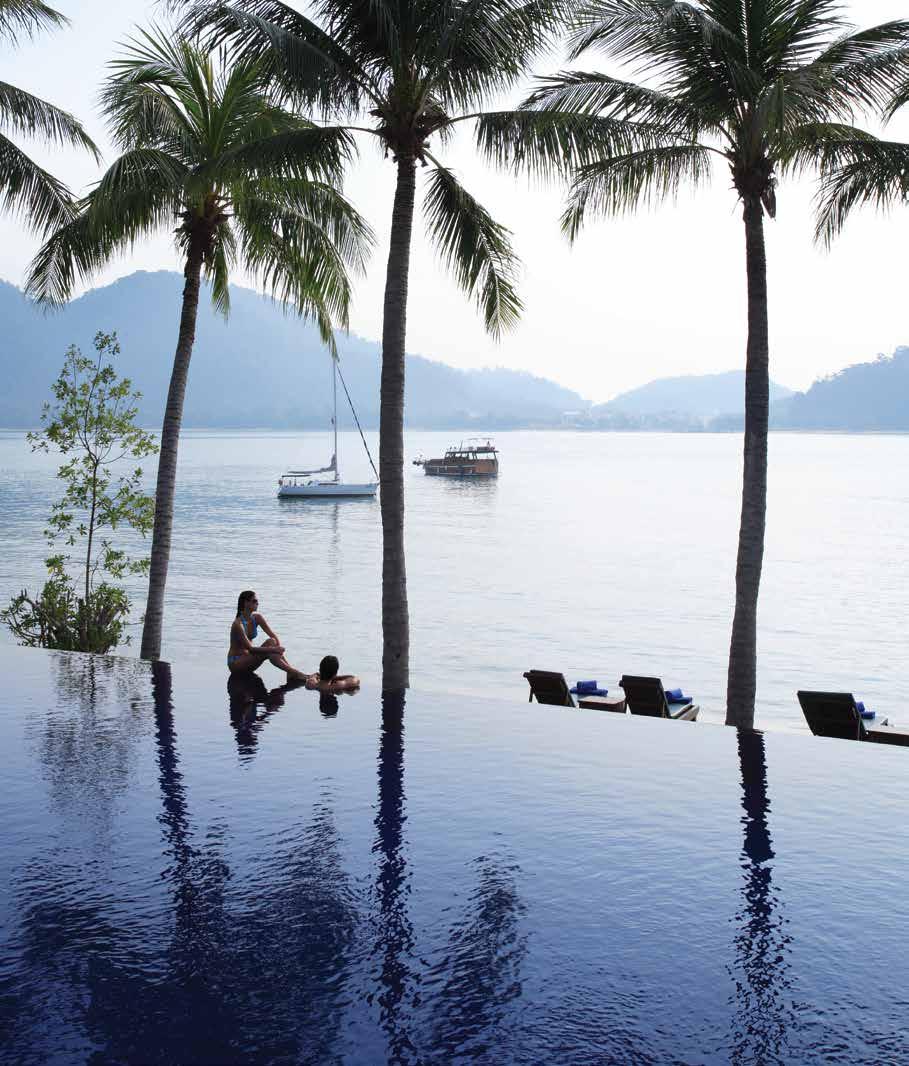
MALAYSIA
PANGKOR LAUT RESORT
TANJONG JARA RESORT
KUALA LUMPUR
PANGKOR LAUT RESORT 54 www.luxurytravelmedia.com.au
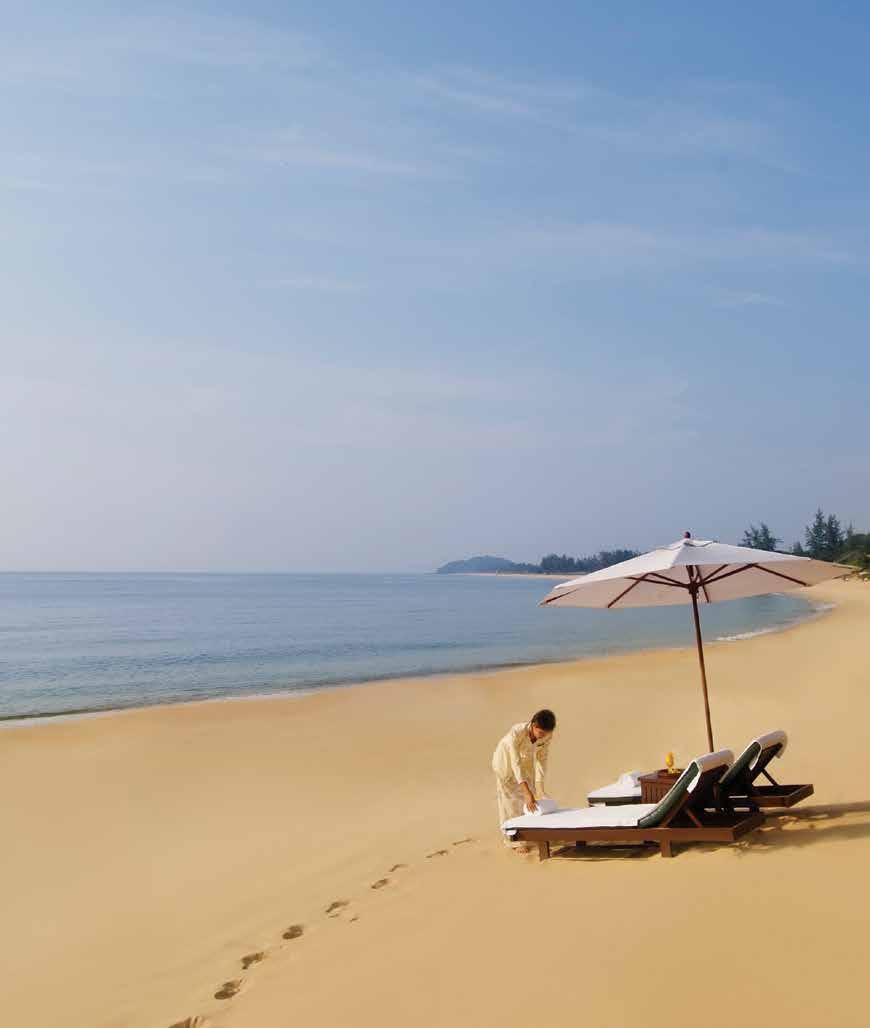
TANJONG JARA RESORT www.luxurytravelmedia.com.au 55
I’m sitting at the foot of my bed, dressed for an exclusive five-course dinner. Where I’ll be dining, I’m not sure. I’ve simply been advised to be ready for collection just after sundown.

It feels like a date. My shirt is ironed, my shoes are polished and, for some reason, I felt the need to put on cologne. Sure enough, at 7pm on the dot there’s a knock at the villa door. It’s not my date. It’s Mukunda, one of Tanjong Jara Resort’s waitstaff, who, through his almost spookily perceptive service, has become a fast friend over the past few days.
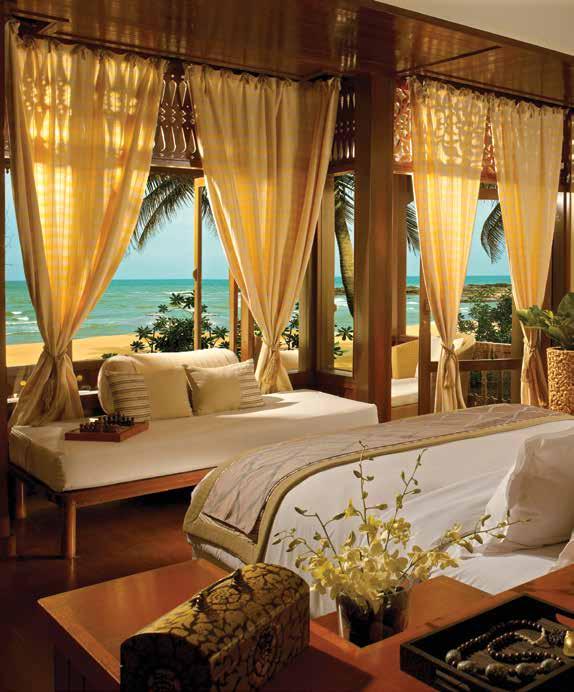
“Ready for your dinner on the rocks, Mister Matt?” he asks. I am, Mukunda. Although, where are these rocks I’ve heard so much about?
My Bumbung Seaview villa’s leafy seclusion at the very far end of the resort’s coastal estate means I’ve been turning left every time I step out my door. But tonight Mukunda smiles and points to the right. By torchlight we curl our way through the bush and onto the beach. That’s when the penny drops.
Tanjong Jara Resort sits in the Malaysian region of Terrengganu, just north of fishing town Kuala Dungun. The immaculate, crescent-shaped beach it looks out upon is bookended by a long low promontory of rocks jutting into the South China Sea. Over the past few days I’ve watched local weddings down by the seaside, bridesmaids waving and singing hello as they clamber onto an old picnic table on the rocks for photos.
Now, though, it’s a scene transformed. A brazier burns like a beacon on the rocks. In the twilight, the ancient picnic table now glows with white linen, candles and flowers. A couple of chefs stand off to the side, waving at me: “Surprise!”
My host for dinner is general manager Terence Waller. He explains what he thinks is particular about the region and, by extension, the resort. “In this part of the country, people lead with their hearts,” he says. “It’s five-star service without the white gloves.”
I’ve noticed this. Tanjong Jara sprawls with 100 rooms and hundreds of staff, but everywhere I go, everyone seems to know who I am, what I’ve been up to and, most importantly, what I need. Waller explains the parlour trick:
an extensive collection of constantly updated WhatsApp chatrooms. This explains Mukunda on a beach, seemingly producing drinks out of thin air, or Chef Ann, the resort’s resident cook, who knows what you ate for lunch so she can prepare you something completely different for dinner at Di Atas Sungei, the resort’s beguiling signature restaurant.
There’s something else going on here, though. If Malaysia is ‘truly Asia’, as the wellworn tagline goes, then coastal communities like Dungun are distinctly Malayan. The resort captures this in Chef Ann’s fabulous tour of the morning market, where she haggles with smiling locals over the price of produce (before
hauling you back to the resort to teach you how to cook it); or in the Lang Tengah Turtle Watch project, which works with local stakeholders to protect endangered turtle species from poachers; or in the Kampong Sucimurni lifestyle experience, which takes over the seafront gardens each Saturday afternoon, uniting staff with guests in a display of local dance, cuisine and customs.
“This region and resort are unmistakably Malay,” Waller tells me at the lifestyle experience. “Every one of our coastal resorts is different, but each oozes Malay culture.”
Waller’s not wrong. On my last morning at Tanjong Jara I watch the sun rise over the sea be-
56 www.luxurytravelmedia.com.au
MALAYSIA DESTINATION
fore setting off on the 600 kilometre cross-peninsula journey to sister property, Pangkor Laut.
Pangkor Laut Resort is Tanjong Jara’s island equivalent, if angled slightly more towards couples. The 300-acre property feels like a sprawling undiscovered country, thanks in part to its secluded location, hidden from the mainland behind the much bigger Pangkor Island.


Stepping off the speedboat and spying the luxury villas that climb the hills, it’s almost intimidating. You quickly learn, though, that same scale is the resort’s strength, its array of villas, activities, rambling spa facilities and seven different restaurants allowing you to carefully fine-tune your stay.

TERATAI POOL|TANJONG JARA RESORT
ANJUNG ROOM|TANJONG JARA RESORT
TURTLE HATCHLING|TANJONG JARA RESORT
Take those restaurants. You could book the family into Uncle Lim’s, the resort’s much-loved casual Hockchew Chinese-style restaurant; have a shirt pressed and fine dine at Fisherman’s Cove, enjoying its sustainably caught seafood menu; or get intimate in a cosy booth at The Straits, which curates its Southeast Asian cuisine according to your personal preferences. All have front row views of the water, and all know who you are long before you arrive.
It’s the same at Pangkor Laut’s spa, which aims high even for YTL Hotels’ celebrated Spa Village brand. There, I’m greeted by name before the therapists carefully tailor a two and a half hour Campur-Campur Thai-Malay treatment, including the spa’s signature Bath House Ritual.
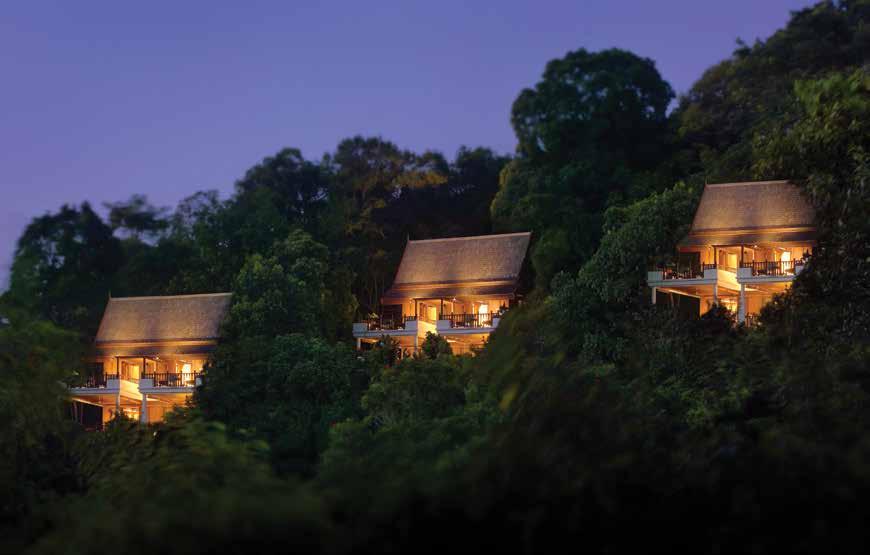
It would be easy to just wander about the island, drifting from one luxury experience to the next. But Pangkor Laut, like Tanjong Jara, is plugged into its local community. Early one morning, Chef Maniarasu Vellamichan takes me to experience it. We cross to Pangkor Island and set about exploring Pekan Pangkor,
its major town. On a public holiday, it’s a brilliant blast of community: fishing boats pull into the dock with full nets, cab drivers hawk for fares, families dine at poky hole-in-the-wall restaurants. We visit the resort’s noodle and fish suppliers, inspecting freshly caught barracuda, prawns, tuna and squid (some of which I get to cook later during a kitchen experience).
On my final night at Pangkor Laut, I sit with guest liaison manager Stephen Smith, enjoying the resort’s signature Emerald Bay dining experience. The sun sets over the sea in a brilliant,
Stay
HILL VILLAS|PANGKOR LAUT RESORT
lazy twilight, cicadas whistling farewell to the day as we enjoy five courses of exceptional food.

Conversation eventually turns to what makes these coastal regions of Malaysia so unique. “They have this very homely, laid-back feel,” Smith says. “There’s something very special about that feeling, and it’s perhaps a little bit of that we try to capture at this resort.”
See more images from this story at luxurytravelmedia.com.au
Rates (including breakfast) start from MYR630 (about A$195) per night at Tanjong Jara Resort and MYR860 (about A$265) per night at Pangkor Laut Resort, plus service charges and taxes. A new Malaysian foreign tourist tax is charged at a flat rate of MYR10 (about A$3) a night, collected upon check out. ytlhotels.com
Getting around
YTL Hotels offer transfers between its resorts and major airports via Starex.

58 www.luxurytravelmedia.com.au
We may have been around for 146 years, but we’re far from old.
The Mansion Hotel & Spa at Werribee Park might be surrounded by an 1870’s Italianate mansion and 10 acres of formal English gardens, but it is still very much young at heart.

Just a short 30 minute drive from Melbourne’s CBD, it’s home to 91 contemporary and luxurious guestrooms, the critically acclaimed Joseph’s Restaurant - specialising in fresh, seasonal dishes - and the divine Day Spa. While you’re there you can tour the mansion, roam the grounds as if they are your own, or meet the neighbours at Werribee Park Open Range Zoo.
But if all that sounds exhausting, feel free to curl up and take a nanna nap.
To book call (03) 9731 4000 or email info@mansionhotel.com.au
K Road Werribee Park Vic 3030 Australia
www.lancemore.com.au/mansion-hotel-and-spa



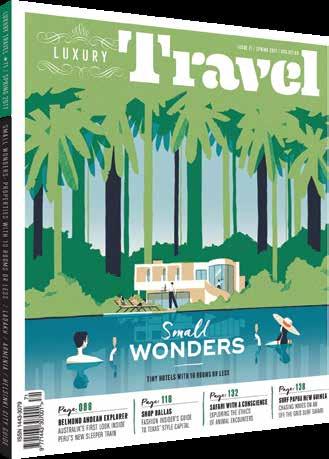

60 www.luxurytravelmedia.com.au Visit: luxurytravelmedia.com.au/subscribe Email: subscriptions@luxurytravelmedia.com.au Receive a 16% discount across 4 issues (1 year), with FREE delivery to your door. SUBSCRIBE TODAY! A$59.99 12 month subscription
FOR YOUR CHANCE TO WIN Bird & Knoll products

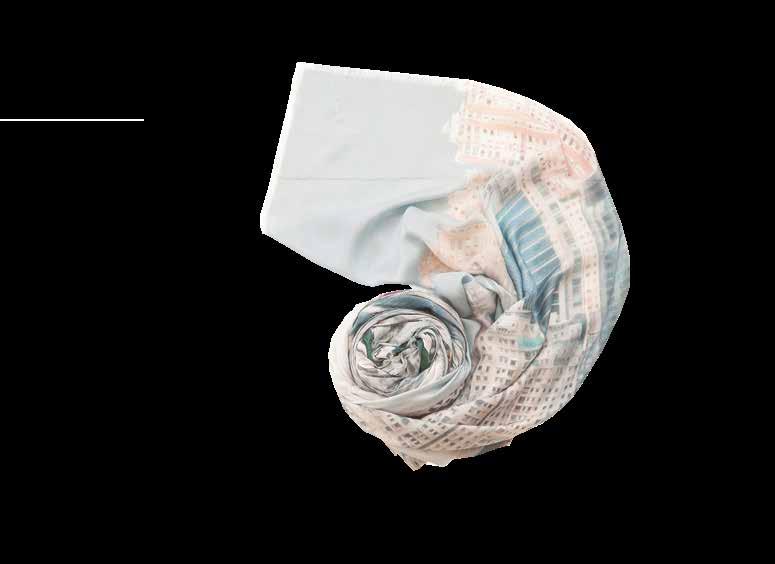
Season after season, Bird & Knoll captures the hedonism and escapism of travel through their beautifully wearable and thoroughly versatile pieces. Each collection exhibits a kaleidoscope of colour and local flavour, which plays to a universal desire for adventure

www.luxurytravelmedia.com.au 61
T&C: Limited stock available. The four best responses by new or renewing subscribers as judged by our panel will win a single Bird & Knoll product. Winners will be randomly allocated one of the four products listed and will receive a voucher which they can redeem for the product. Competition open to Australian residents only. For international pricing, call +61 2 8705 5463 or email subscriptions@magnesiummedia.com.au. Full terms and conditions available at www.luxurytravelmedia.com.au/subscription-terms-conditions.
WIN
One of four products valued up to A$305
CHICAGO






Luxury Travel City Guide Series 72 SEE & EXPLORE • Art Institute of Chicago • Alinea Restaurant • Magnificent Mile • Local Tips: Charles Joly SHOP FOOD & DRINK STAY
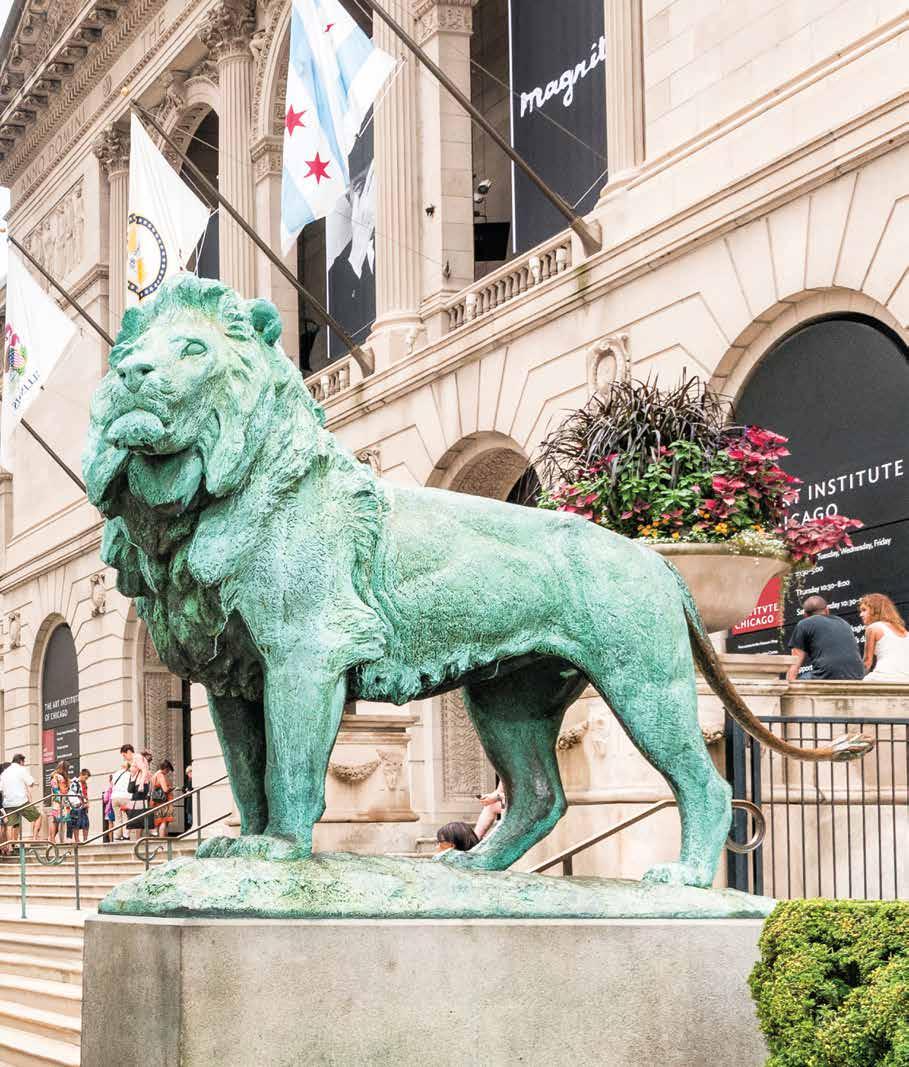
ELESI / SHUTTERSTOCK.COM
Chicago
Perched on the rather massive Lake Michigan, Chicago is famous for its association with Prohibition-era gangsters, deep dish pizza and the blues. But 21st century Chicago offers something for everyone – including lovers of the high life. Five-star hotels and critically lauded dining options abound, and the city’s cultural scene refuses to play second fiddle to any other. And with a slew of events coming up in 2018 – including Art Design Chicago 2018 and the US debut of the Laver Cup tennis competition – now is the time to plan a visit.
CITY SIGHTS





Chicago has more than enough galleries, theatres and public art to satisfy even the most ravenous culture vultures, but above all, the Art Institute of Chicago is an essential stop on any visit to the city. It is the permanent home of some very striking and notable pieces such as Georges Seurat’s A Sunday Afternoon on the Island of La Grande Jatte and two iconic pieces of Americana: Grant Wood’s American Gothic and Edward Hopper’s Nighthawks. For deeper insight into these, and the rest of the extensive collection, try Noble Private Art Tours (noblearttours.com).
In nearby Millennium Park, a public sculpture by Indian-born British artist Sir Anish Kapoor stands proud. Cloud Gate is locally known as ‘The Bean’ and it will stay in place until the year 3006. Also in the park is Frank Gehry’s curly Jay Pritzker Pavilion, an open-air performance space that is the home of the Grant Park Symphony Orchestra, and hosts numerous festivals and artists throughout the year.
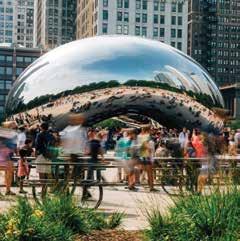
The Chicago River is a central part of life in the city. Its banks are lined with architectural gems and the waters teem with taxis, boat
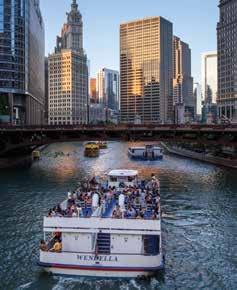

tours and the occasional rowing team. If you want to eschew the crowds, Bespoke Experiences (bespokeprivatetours.com/chicago) can help. You can create a custom itinerary and every group is accompanied by an ‘experience architect’ who acts as both a guide and a private chauffeur.
When the sun sets, take to the skies with a private heli-tour of the city. Chicago Helicopter Experience (chicagohelicopterexperience.com) offers everything from a 15-minute photo tour to the Heli-Yacht package, which includes a private yacht trip to the heliport and a private skyline tour. They also have charters that can take you further afield. Visit the founding vineyard of the region, Alto Vineyards in Alto Pass; a great place to sample regional grapes such as niagara and chambourcin. Or play a few holes at the Chicago Golf Course, considered the best in the state. Less than 50 kilometres from downtown, it is the oldest 18-hole course in North America. It is also one of the most exclusive clubs in the country, so keen golfers may need to harness their connections to get on the green.
64 www.luxurytravelmedia.com.au
SEE
& EXPLORE
1 2 3 6 5 7 8 9 10 4
Rob McGovern explores Chicago and discovers a city embracing the high life, while still celebrating its gritty roots.
1. Lincoln Park Zoo
2. Magnificent Mile
3. Willis Tower
4. The Chicago Theatre
5. Navy Pier
6. Chicago River
7. Millennium Park
8. Art Institute of Chicago
9. Soldier Field Stadium
10. The Field Museum
CLOUD GATE
CH / CHOOSE CHICAGO
EAT & DRINK
Chicago has a dining scene to rival any city in the world. With almost three dozen Michelin stars, it offers everything from the famed deep dish pizza to arguably (and the case has been made by many) the best restaurant in the country, Alinea (alinearestaurant.com). Headed by Grant Achatz, the world-renowned culinary phenomenon was first awarded three Michelin stars in 2010 and has retained them each year since, even after a mid-2016 reinvention and reopening. As for the food, it is not an exaggeration to say that Alinea carves its own culinary path and others follow. Sheets of dehydrated scallop; deep-fried ice fish with a fermented kumquat sauce; and blueberry leaves with seasonal mushrooms and foie-gras sauce have been served, but with a tasting menu that is ever changing, it is impossible to predict what will appear next.
Chicago’s other three-star restaurant is Grace (grace-restaurant.com). The Michelin guide has saluted the culinary wizardry of chef Curtis Duffy and his contemporary seasonal tasting menus, which are intricate and elaborate. Book well in advance for both.
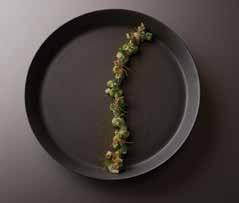

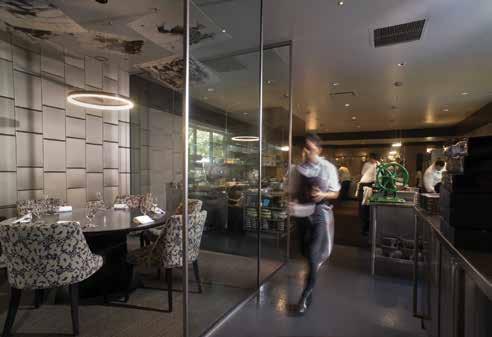
At the other end of the dining scale, deep dish pizza is one of those must-do Chicago experiences. Lou Malnati’s (loumalnatis.com) and Pizzeria Uno (unos.com) both claim to have invented the indulgent dish and you can’t go wrong at either. Be sure to grab an equally famous Chicago hot dog, which according to locals should be ‘dragged through the garden’ (served with the lot) for a true Chicago experience.
Chicago is the spiritual home of the blues so there are a lot of blues clubs to choose from, but not all are created equal. To avoid being surrounded by tourists, try the locally recommended Chicago B.L.U.E.S. Bar (chicagobluesbar.com) on North Halsted. Just a few hundred feet from affiliated club Kingston Mines, B.L.U.E.S. isn’t as well-known by tourists, which means you are more likely to be seated next to someone who lives closer to Michigan Avenue than Melbourne.
Summer
Summers are hot and muggy, with temperatures as high as 40°C in July and August. The city can also get seriously crowded during these months.
Winter
There's a good reason the locals call the city Chiberia. Winters are bitter, with temperatures rarely rising above 0°C from December to February and can drop as low as -20°C, though wind chill can make it feel even colder. Up to 100 centimetres of snow falls each year.
Sweet spot
Visit Chicago in spring (April-May) or autumn (September-October).
NEED TO KNOW
Getting around
Almost 400 kilometres of bike trails wind through Chicago and the city is mostly flat, so a bicycle is a great way to get around. Sign up for the Divvy bike share program and you can grab one from any of the racks around town. A day pass is just US$9.95 (about A$13).
Packing list




Chicago's nickname is The Windy City, so stock up on moisturiser and lip balm. And even though it’s more than 1,000 kilometres from the coast, don't forget your swimsuit. There are 27 sandy beaches along the shore of the vast Lake Michigan.
Fine print
Australia is a participant in the United States ’ Visa Waiver Program, however travellers still need to obtain authorisation through the Electronic System for Travel Authorization (ESTA) before arrival. The ESTA fee is US$14 (about A$18) through the official website esta.cbp.dhs.gov/esta. Beware of third party sites that will charge additional fees.
www.luxurytravelmedia.com.au 65
WEATHER TO GO?
ALINEA
ALINEA
ALINEA
The Chicago climate is extreme and the city can be ruled by the weather.
Temperatures are relatively mild, crowds are smaller and the city hosts a full calendar of festivals and events.
THE ALINEA GROUP
SHOP




All of the big name fashion houses can be found on Chicago’s Magnificent Mile (Michigan Avenue to the locals) and East Oak Street, while venturing out to the suburbs will reveal all manner of shopping options.
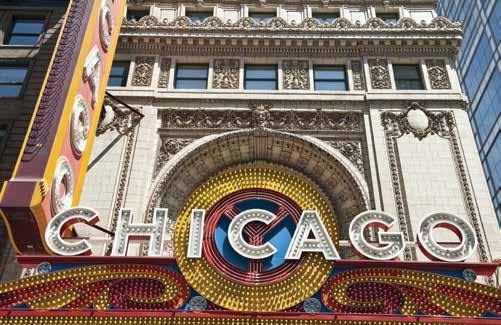

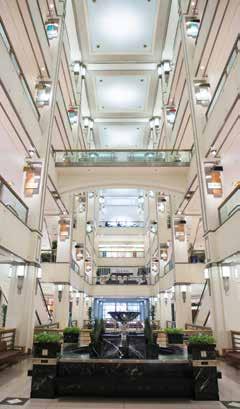
High-end women’s fashion boutique, ikram (ikram.com) has a selection of unique and sophisticated clothing, shoes, jewellery, and bags from American, European and Japanese designers. There is also a collection of vintage clothing and accessories that has been curated by owner Ikram Goldman herself. Personal shopping is available in store and specialty services can be arranged after a consultation.
You will need to be buzzed in to the exclusive boutique Blake on West Chicago Ave, but once inside you’ll find pieces by the likes of Dries Van Noten and luxury Italian label Marni. Ethically minded shoppers will like Jamie Hayes’ label Production Mode. The vegetableleather collection is conservative without being boring and can be found in several outlets in the city including at Hayes’ showroom, the Department of Curiosities (departmentofcuriosities.com).
Located in the historic Tree Studio building on State Street, P.O.S.H (poshchicago.com) aims to give people something new yet old at the same time. The small store is full of antique housewares from around the world with everything from tea sets to jewellery boxes. For something less folksy, Space 519 (space519. com) has women’s apparel and accessories, men’s accessories, apothecary products, books, gifts and homewares. Expect everything from lip balm to vintage mid-century chairs.
Aviary
Aviary is my old stomping ground and a truly unique experience. Perhaps not an everyday belly-up spot, but we need venues that push boundaries and question the way we have always done things. The cocktails are innovative and experiential, and the service is top notch. No detail is overlooked. Afterwards, head downstairs to The Office, a warm and inviting speakeasy where classic techniques meet a flavour arsenal. If you’re not in the mood for a cocktail, one of the most impressive vintage spirit selections and well-curated beer programs awaits. theaviary.com


66 www.luxurytravelmedia.com.au
LOCAL TIPS
Charles Joly , Global Bartending Champion
©ADAM ALEXANDER PHOTOGRAPHY / CHOOSE CHICAGO
/ SHUTTERSTOCK.COM
CHRISTIAN SEEL
FEYGINFOTO
RHIMAGE / SHUTTERSTOCK.COM
Lost Lake
Chicago is a city of neighbourhoods and I recommend exploring beyond downtown. Approachable and understated, Lost Lake is a fantastic neighbourhood tiki spot in booming Logan Square. There’s an incredible rum selection, honest cocktails and stellar service. lostlaketiki.com
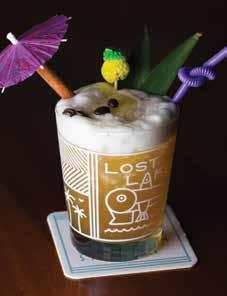
STAY
Littered with five-star hotels, Chicago has an extravagant property for everyone, but for classic, old-world luxury, look no further than The Peninsula ( chicago.peninsula. com ). Bringing colonial Asian-style hospitality to America’s Midwest, The Peninsula underwent a US$38 million (about A$48.3 million) renovation in 2016 and reopened to plenty of fanfare. Located on the city’s Magnificent Mile, the 330-room property is arguably the most luxurious hotel in the city. Thanks to the renovation, it’s possibly the city’s most tech-forward hotel too with multi-lingual tablets that control everything from the TV to the curtains. If you really want to splash out, the three-bedroom Peninsula Suite is a snip at just over US$10,000 (about A$12,700) a night.
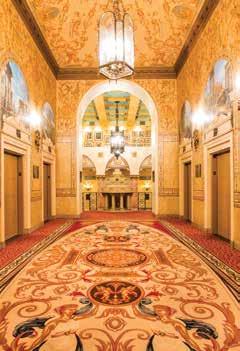
For something a little more historic, the InterContinental ( icchicagohotel.com ), also on the Magnificent Mile, is hard to beat. The hotel’s south tower was originally constructed in 1929 to be the home of the Medinah Athletic Club, which explains why the property has what is likely the best pool in the entire city. Located on the 14th floor, the pool, known to some as the Weissmuller Pool in honour of the Tarzan actor who trained there, is decked out in Spanish tiles and has stadium-style seating that harks back to the days when swimming was a more popular spectator sport than it is today.
For a more boutique option, Soho House (sohohousechicago.com), like all properties in the Soho Portfolio, is an exclusive hotel and members club that caters for creatives, and often welcomes famous clientele. Housed in a former industrial warehouse in Chicago’s West Loop, the renovated interiors elegantly fuse old and new, and facilities include a heated rooftop pool, a plush 30-seat cinema, and a music room which hosts monthly members-only events.
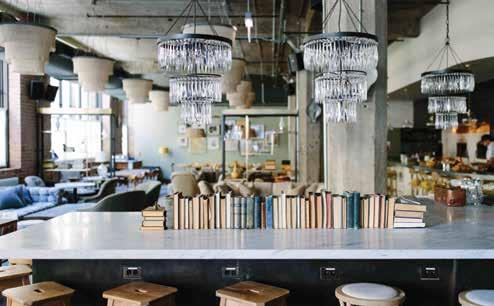
The Drifter




Tucked away with a bar-in-a-bar entrance, The Drifter is a true gem. Bartender owned and operated, this bar delivers the speakeasy vibe without the cheese. Expertly executed cocktails, a welcoming vibe and live shows from burlesque to ukulele greet you in this intimate space. thedrifterchicago.com
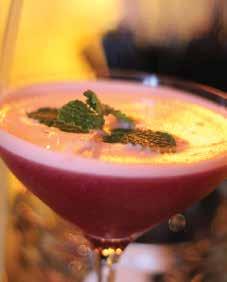
www.luxurytravelmedia.com.au 67
SOHO HOUSE CHICAGO
INTERCONTINENTAL CHICAGO
SHELBY ALLISO
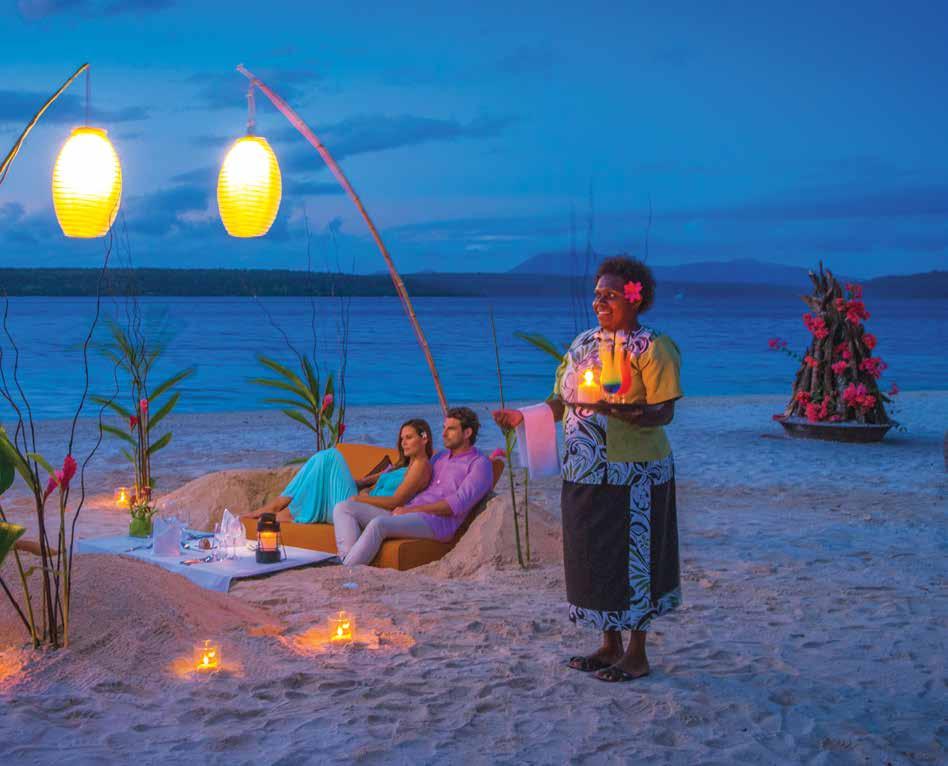



+678 35600 | thehavannah.com | reservations@thehavannah.com Breathtaking Beachfront Location | The Ultimate Romantic Escape Luxury Villas | Exclusively for Couples | Exceptional Service | Exquisite Cuisine

www.luxurytravelmedia.com.au 69 071 Cruise | 2018 speciality cruises 076 Rail | The Presidential Train 082 High flyer | News and reviews JOURNEY
Embark on a voyage like no other
Visit some of the most remote islands in the world, the Marquesas and Tuamotus, on board the passenger freighter, Aranui 5.
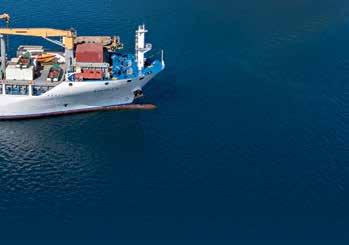
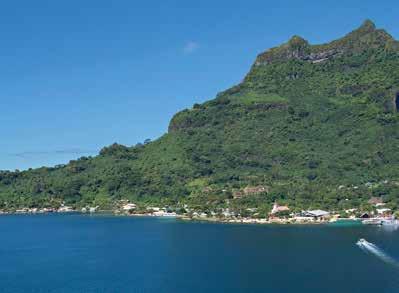

Nine islands across three Tahitian archipelagos


Highlights:
14 day cruise with all meals including onshore picnics and local feasts Small group cruise (max 254 passengers)
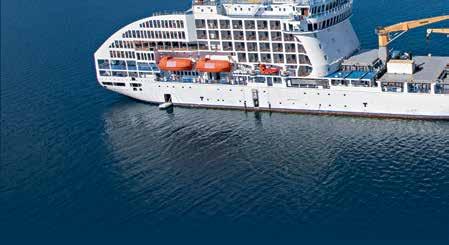

Take a peek into the lives of local villages as we deliver essential goods during the 3,800 km journey from Papeete
Take part in traditional celebrations, ceremonies and dance performances
Enjoy guided excursions to historic and cultural sites, ancient tikis, hiking, handicraft workshops and churches
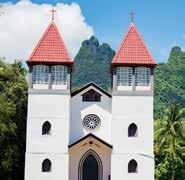
Relax and enjoy our 4-star vessel, complete with bar and pool
aranuicruises.com.au
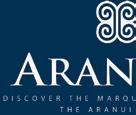
E info@aranuicruises.com.au
P (+61) 3 9449 3778

Cruising comes complete with plenty of bells and whistles, but some journeys also offer passengers a niche experience. Siobhan Plowman rounds up the best themed cruises for 2018.

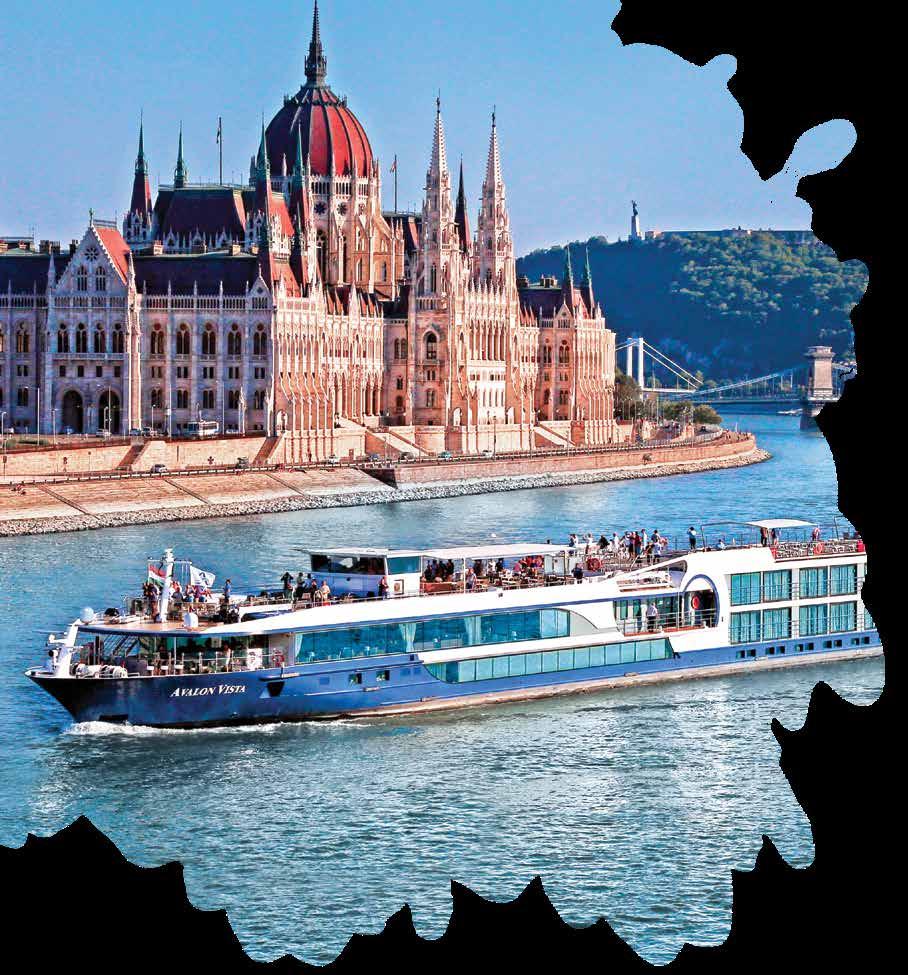
www.luxurytravelmedia.com.au 71
CRUISE | 2018 SPECIALTY CRUISES JOURNEY
As you like it
Food
Ponant | Gastronomy, Vineyards & Grands Crus

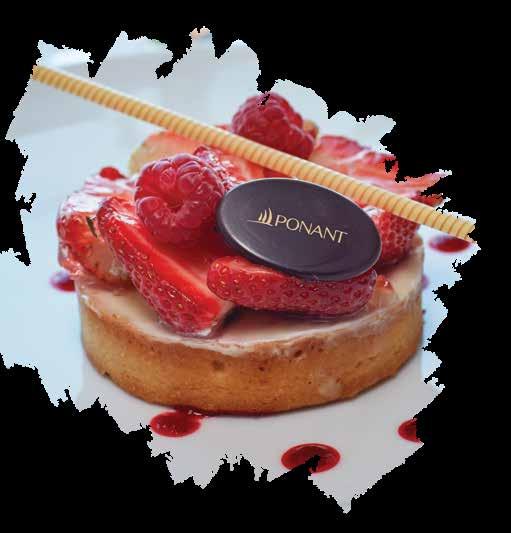
Lisbon to Lorient
This nine-day gastronomic cruise departs Lisbon and slowly makes its way across northern Europe, dropping in to some of the most historic European food and wine destinations along the way. Parisian chefs Pascal Féraud of Michelin-starred Le Jules Verne and Stéphane Duchiron of Ore, both from Paris, will be joining passengers on board the intimate 132-cabin Le Soleal, partnering dinner courses with the finest Médoc grands crus. First stopping at Leixoes, 10 kilometres from UNESCO World Heritage site Porto (see page 076), the mega yacht will then visit Bilbao (see page 191), not far from the La Rioja wine region. It is then on to the wine capital of Bordeaux, where guests will visit the Cité du Vin museum and Château Latour, one of the oldest wineries in the Médoc. The final call is Ile d’Aix before concluding in Lorient. Every cabin on board is luxurious, with most offering a private balcony. Wine tasting workshops and conferences will be held on board throughout the journey.
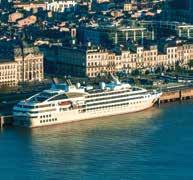
Gastronomy, Vineyards & Grands Crus departs Lisbon, Portugal on April 11, 2018. Rates start from €4,880 (about A$7,395) per person and include all meals, most beverages, activities and transfers. ponant.com
pagodas, monasteries and temples.
The 28 luxurious cabins feature teakwood floors and Burmese-inspired furnishings, a private balcony and personal butler service. The 40-square metre Strand Suite offers a king bed, floor-to-ceiling windows, sitting area and separate dressing area.
The Photography Cruise departs Bagan on March 26 and September 17, 2018. Rates start from US$1,875 (about A$2,446) per person and include most meals, basic beverages, excursions and activities. thestrandcruise.com

72 www.luxurytravelmedia.com.au
are taken on guided tours through historical highlights such as the 11th-century Benedictine Abbey in Melk and the medieval town of Regensburg. The ship, Avalon Panorama , offers various suite options; the Panorama Suite boasts wall to wall windows, Egyptian cotton linens, sitting area and a full-size bathroom.
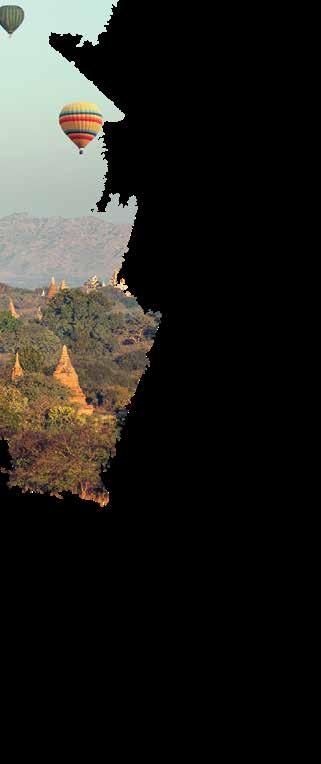
The European Golf River Cruise departs Munich on July 10, 2018. Rates for a Panorama Suite start from A$8,995 per person, twin share, and include all meals, most beverages and golf. golfrivercruise.com
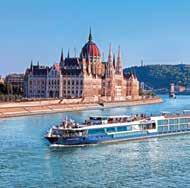

sized bed, marble bathroom with full-size tub and separate shower, large living room, powder room and private verandah. Round-the-clock room service accompanies eight onboard dining options, including seafood and grill, Italian, Japanese teppanyaki and a fine dining French restaurant by Relais and Châteaux. The cruise visits European hotspots including Dubrovnik, Sicily, Portofino and Valetta, before concluding in Monte Carlo.
The 2018 Ballet Cruise departs Venice on August 18; the 2019 Ballet Cruise, from Singapore to Hong Kong, departs on the March 21. Rates start from A$10,900 per person and include all meals and beverages, butler service and gratuities. silversea.com
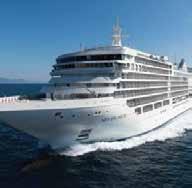
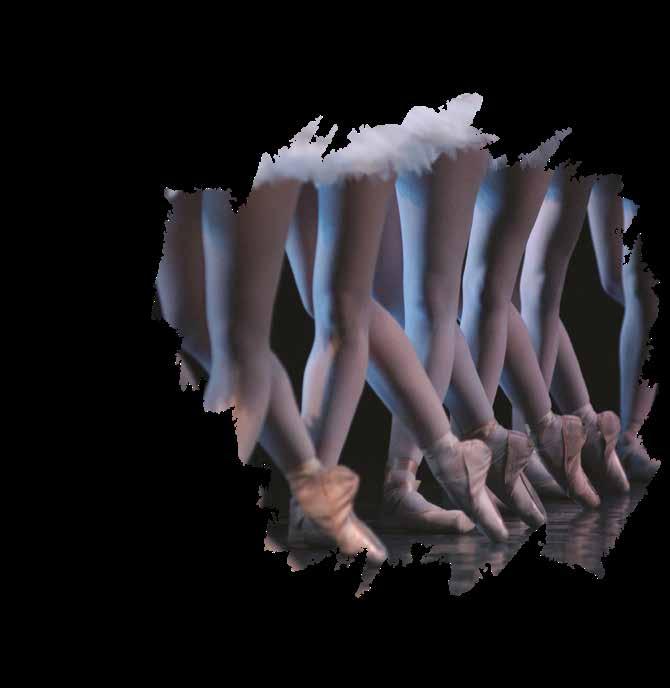
www.luxurytravelmedia.com.au 73
Basel to Amsterdam
Active travel company Butterfield & Robinson has teamed up with river cruise line Uniworld for an eight-day cycling exploration through the Rhine River region. The tour begins in Germany’s Black Forest, where guests pedal through the Wiese River valley, stopping en route to sample local delicacies. Dinner, paired with local wines, is served back onboard the 77-cabin SS Antoinette, which will cruise overnight to the Alsatian wine region. Over the following days, guests cycle by Strasbourg’s Gothic cathedrals, timbered houses and serene canals; past Heidelberg’s baroque Old Town and crumbling hilltop castle; along the plains of the Neckar River; and through the busy streets of Cologne. Much of the cycling is gentle, with various longer and shorter options. On average, guests can expect to cycle 40 to 60 kilometres per day. In the evenings,
guests can soothe aching hamstrings in the ship's small swimming pool or with a massage in the Serenity River Spa. The 36-square metre Riverview Royal Suite features an open-air balcony, a handcrafted Savoir of England bed and a marble bathroom with separate tub and rain shower, equipped with L’Occitane en Provence and Hermès products.
Rhine River Cruise Biking has three departures in May, June and September, 2018. Rates start from US$6,995 (about A$9,140) per person and include seven nights aboard SS Antoinette, most meals and select beverages, a dedicated Butterfield & Robinson guide, and all transfers. Rates also include use of a customised hybrid or racing bike, handlebar mounted tablet with preloaded GPS routes and safety gear. butterfield.com

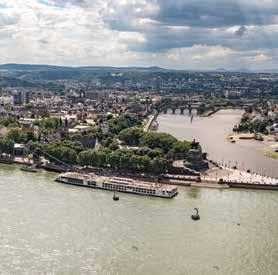

74 www.luxurytravelmedia.com.au
Cruise along the Rideau Canal

Keen cruisers can captain their own houseboat down the Rideau Canal when Le Boat launches a fleet of 16 cruisers in 2018. Built in the early 19th century, the canal runs for more than 200 kilometres through the province of Ontario, from the Canadian capital of Ottawa south to Kingston. It is the oldest continually operating canal in North America and a UNESCO World Heritage Site. Le Boat itineraries run from three to 14 nights and the boats sleep from two to 12 people. Cruise into small towns, alongside stunning natural scenery and through vast lakes, with the option to stop whenever you like for hiking, fishing or canoeing. No experience is required and all boats come fully equipped and ready to drive. leboat.com.au
Refresh for two Hapag-Lloyd ships
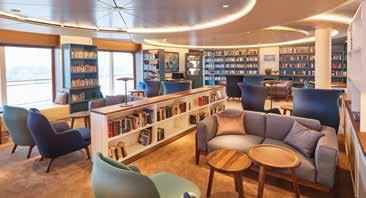
Hapag-Lloyd’s MS Europa and MS Europa 2 have been refurbished during recent drydocks at the Blohm+Voss shipyard in Hamburg. On board the five-star-plus Europa 2, the four saunas in the spa have been renovated and restyled, and an electric fireplace has been added to the lounge corner. Herrenzimmer bar has been redesigned and renamed Collins, and still houses the largest collection of gin at sea. The Belvedere lounge (above) has been reimagined as a coffee bar with an integrated library. There’s also a small museum and new artwork has been added throughout the ship. Europa’s spa has been redesigned and a number of suites upgraded with new bathrooms. hl-cruises.com
Fourth ship for Cunard

Cunard has announced it will be launching a new ship in 2022, its first in 12 years. Accommodating up to 3,000 passengers, the as-yetunnamed vessel will be the largest in Cunard’s fleet and will share the line’s iconic livery and red funnels. The ship will join Cunard’s Queen Mary 2, Queen Victoria and Queen Elizabeth cunardline.com.au
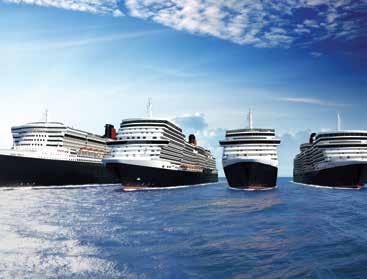
www.luxurytravelmedia.com.au 75 CRUISE TRAVEL NEWS FROM AROUND THE WORLD
RAIL | THEPRESIDENTIALTRAIN JOURNEY
Beauty and the feast
A journey through Portugal’s Douro Valley aboard The Presidential Train proves a treat for the eyes as well as the stomach, writes
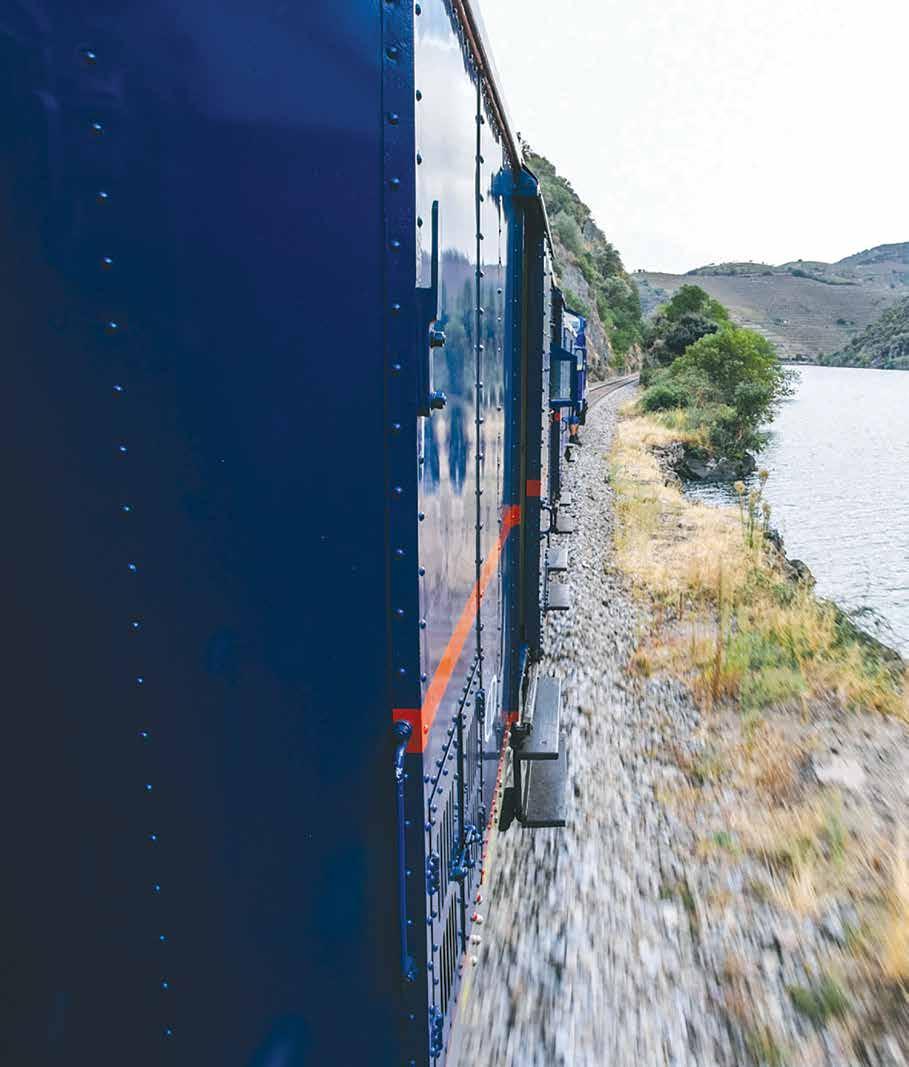 Tiago Pais
Tiago Pais
There is an old scale resting on a corner of beautiful São Bento station, in Portugal’s northern capital, Porto. For half a euro, it delivers a ticket on which your weight is printed along with your apparent fortune, Chinese cookie-style. I hadn’t tried it in years, but as I had some time to kill before boarding The Presidential Train, I decided to give it a go.
The croissants I had for breakfast didn’t help my result, but the quote made me chuckle: “Don’t be disheartened. The beauty of life is in the struggle.” The fortune-telling scale almost got it right given every platform featured a “delayed train” sign. Fortunately, I was riding The Presidential, which was right on time.
It would be hard to miss her: a gorgeous set of blue carriages originally built in 1890 to serve the court of Portugal’s King D Louis I, she was renamed The Presidential after the coup d’etat that installed a republican regime in the country in 1910. Since then, she has served all Portuguese heads of state and some illustrious guests of honour, such as Queen Elizabeth II and Pope Paul VI, before retiring in 1970.
Restored a few years ago, she was being exhibited on the tracks of the National Railroad Museum when Gonçalo Castel-Branco saw her for the first time. He immediately fell in love with the train’s looks and personality. Castel-Branco, an experienced events producer, wanted to do something to bring her back to the tracks, but didn’t know what. When he told his daughter what he had just seen, she replied: “Daddy, why don’t you do a moving restaurant?” And so he did.
To this day, he still gives her credit for the idea, despite having created much more than just a moving restaurant. It’s also a history lesson. For instance, I learnt the press cabins – where I was sitting – were the farthest cabins

76 www.luxurytravelmedia.com.au
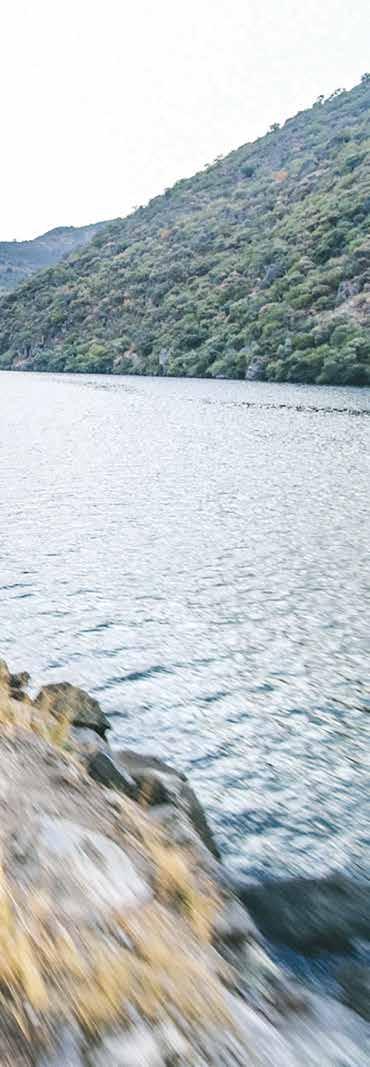

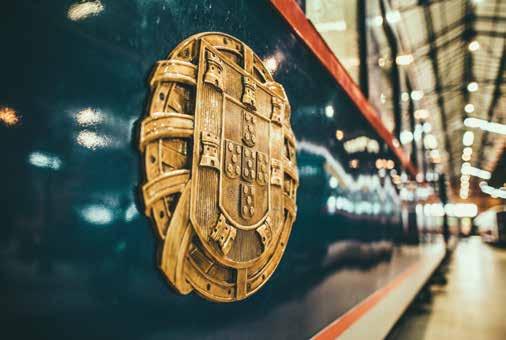
TIAGO PAIS TIAGO PAIS
from the president’s, to avoid involuntary hearsay. It’s also an astonishing ride, running from Porto to Quinta do Vesúvio, a magnificent wine estate in the Douro Valley, not far from the Spanish border, in about nine hours. The train travels almost 200 kilometers each way, a considerable chunk of it along the banks of the Douro River, which are filled with vineyards.
After three quick snacks and a glass of wine served in the cabin – the first of many, I must admit – I was invited to take my seat in the restaurant car. A waiter brought another glass of wine and the set menu Yugoslavian-born chef Ljubomir Stanisic had prepared. Seven dishes awaited, a trip within the trip, as each one was influenced by a different country from Bosnia to Portugal, with stops in France, Italy and Brazil.
Castel-Branco has invited some of Portugal’s most celebrated chefs to cook onboard The Presidential. Ljubomir is one of them. As a teenager he fled his hometown of Sarajevo during the Balkan War and crossed all of Europe before arriving in Lisbon, where he started working in restaurants. He hasn’t stopped. Not only does he have two very successful restaurants, but he has also written several books and hosted television shows, the most recent being the Portuguese version of Gordon Ramsay’s Kitchen Nightmares.
His menu is balanced, like any good rollercoaster should be. It started off strong with some excellent Balkan bread and flavourful condiments, such as ajvar (roasted red pepper sauce) and mileram (a type of sour cream). Next, came a smooth Italian burrata with ricotta foam, crispy bread, beet powder and a fake tomato stuffed with sardine. The train made its turn towards the banks of the Douro right before the first main course, a delicate carabineiro (scarlet) shrimp with chestnuts and fennel cream. It didn’t stop there – tomato and sardine, always a winning combination in Portugal, came right before a French classic, pigeon breast stuffed with foie gras.
By the time desserts were served, I didn’t know whether to focus on the beauty outside or the feast in front of me. Outside the train, I could see the vineyards reflected on the water, like they were painted by French impressionist Claude Monet. Inside, they wanted me to eat more, drink more. And so I ate. And drank.
Three hours, three snacks, seven dishes and quite a few glasses of white, red and fortified wine after departing Porto, we arrived at Quinta do Vesúvio, a charming estate with its own private train station that belongs to the Symington family, one of Douro’s leading wine producers.


Castel-Branco gave all passengers a quick lesson on the estate’s production methods. “If the Romans arrived here today they would recognise most of the practices and the tools,” he said. That is, everything is done as it was in the old days, even if that means less profits. After picking the grapes during harvest season, large groups of men and women gather in the lagar (a granite trough) to tread them, march-

78 www.luxurytravelmedia.com.au
BAR CAR
RESTAURANT CAR
DESSERT IS SERVED
ing forward and backwards with their arms interlocked for a couple of hours. After touring the estate, we were offered an “oxymoron port,” as our host called it – a two month old vintage port, a product of this year’s harvest.
The train came back to pick us up as the sun was setting. The bar car was now the place to be, as a pianist was playing and tea (or wine, for those who didn’t have to write about the experience) was being served. “In a few minutes we will serve some more snacks,” a waitress warned me. My empty mouth said “sure”, my full stomach asked “really?” And so the feast went on, with superb bread from Gleba, an artisanal bakery in Lisbon, to eat with cheese, local sausages and canned fish. More sweets and desserts followed.
Soon after, I went back to my cabin and fell asleep. An hour later we arrived in Porto. The journey had finished. As grateful as I was for everything I had learnt, seen and

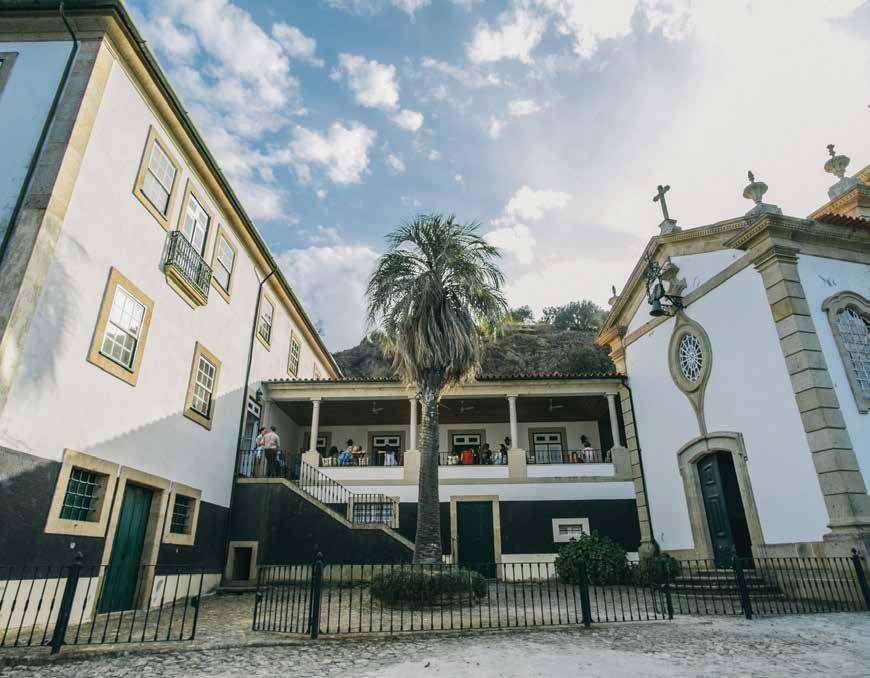
consumed (not necessarily in that order), I couldn’t help but think about the three-hour trip back to Lisbon that awaited me. But as I glanced at the old scale on the corner of the station, I thought to myself: “Don’t be disheartened. The beauty of life is in the struggle.”
See more images from this story at luxurytravelmedia.com.au
Journey
Rates for the one-day journey start from €500 (about A$757) per person. The Spring Edition is scheduled to run on weekends through April and May, 2018. thepresidentialtrain.com
www.luxurytravelmedia.com.au 79
IMAGES THIS SPREAD TIAGO PAIS
QUINTA DE VESÚVIO
Themed journeys through Canada
Rocky Mountaineer is launching two new themed packages for 2018 that combine a journey on the iconic train with either adventure or culinary exploration around British Columbia and Alberta. The 10-night Journey through the Clouds Outdoor Adventures package includes activities such as canoeing on Lake Louise, a zodiac tour of Howe Sound, guided hiking in Jasper and a panoramic helicopter flightseeing tour. Prices start at A$5,346 per person. Mean-

while, foodies can indulge in the nine-night First Passage to the West Culinary Exploration tour, which includes culinary walking tours of foodie hotspot Granville Island and Calgary, plus multi-course meals paired with wines at the region’s best restaurants. Prices start at A$4,905.
New GoldLeaf carriages, where guests enjoy the Mountaineer’s most exclusive service, will also be introduced on-board the train in 2018. rockymountaineer.com
Off Russia’s beaten tracks
Golden Eagle Luxury Trains will take passengers through remote regions of Siberia and the Caucasus with two new journeys in 2018. The BAM Explorer departs Vladivostok and runs north of the Trans-Siberian line, across some of the most inhospitable terrain in the world, past former gulags (prison camps) and into forgotten gold-mining communities. Departing Moscow, the Caucasian VI will be hauled by 21 different Soviet-era locomotives, and travel through the foothills of the Caucasus Mountains and along the Black Sea coast. Fares start from US$15,895 (about A$20,578) per person for the 14-day BAM Explorer and from US$12,695 (about A$16, 435) per person for the 12-day Caucasian VI.

goldeneagleluxurytrains.com
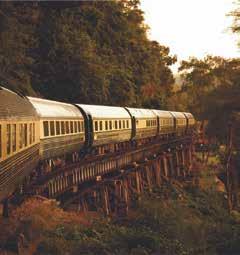

Celebrity chefs aboard the express
Travel through Southeast Asia with Thailand’s first celebrity chef Ian Kittichai or Australia’s own Luke Mangan on one of three special journeys aboard the luxury sleeper train, Eastern & Oriental Express. Passengers will tour local food markets with the chef, discuss their passion for food, pick up some tips for the kitchen and dine on specially designed menus. Kittichai will host two three-night journeys from Bangkok to Singapore (22-25 November 2017 and 18-20 November 2018) and Luke will host one three-night journey from Singapore to Bangkok (1-3 March 2018). Fares start from US$2,488 per person (about A$3,220). belmond.com/eastern-and-oriental-express
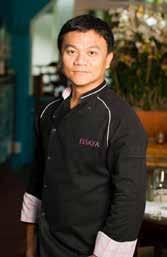
80 www.luxurytravelmedia.com.au RAIL TRAVEL NEWS FROM AROUND THE WORLD
LAURA PL/SHUTTERSTOCK.COM
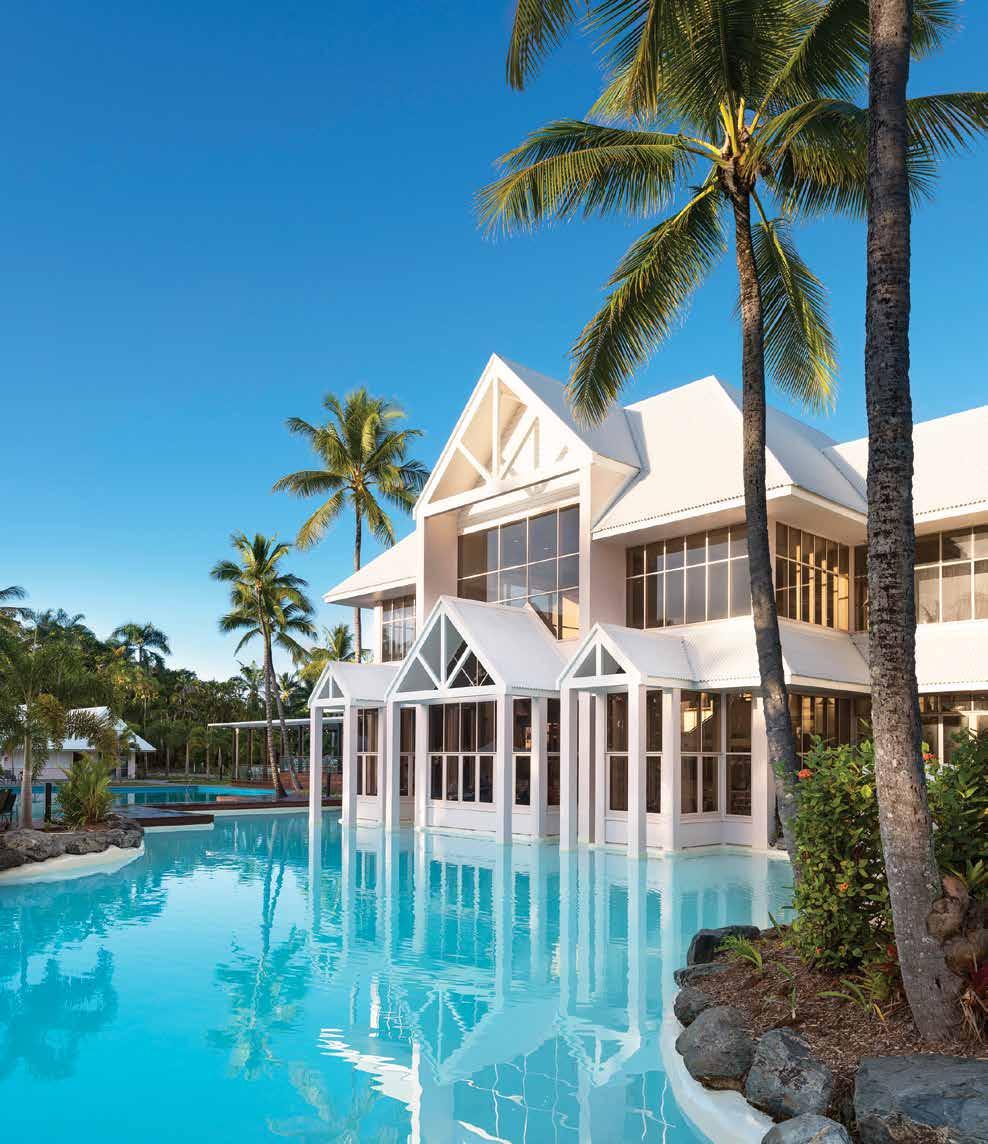
Rediscover an icon sheratongrandmirageportdouglas.com I 07 4099 5888
Singapore Airlines’ new cabins
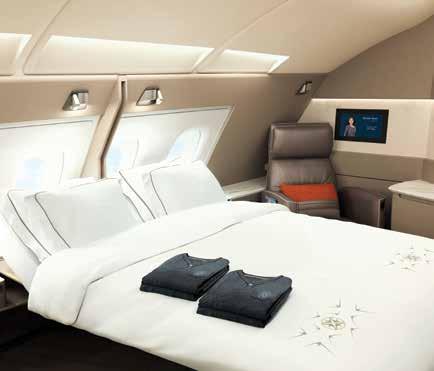
After four years in development and a US$850 million investment, Singapore Airlines has revealed the new cabins for its Airbus A380 fleet. Highlights of the first major interior overhaul of the fleet since 2007 include a new first class cabin featuring half the number of suites (down from 12 to six), each equipped with a swivel chair, wardrobe and fully flat bed, with the option for the beds in the first two suites of each aisle to be joined to create a double. The first class cabin also features its own bathroom with a sit-down vanity counter. The business class offering includes a 63.5-centimetre wide seat with an adjustable divider that reclines into a 198-centimetre fully flat bed. In addition to the six first class suites, the new A380 fleet will be configured with 78 business class seats on the upper deck, and 44 premium economy seats on the main deck. The new cabin products are expected to be fitted from next month. singaporeair.com
Book the Cook on Singapore Airlines
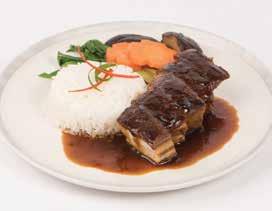

Emirates unveils revamped onboard lounge
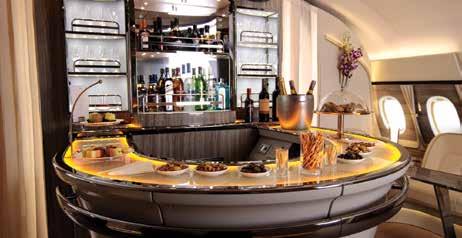
Emirates has launched an overhauled onboard lounge in celebration of the ninth anniversary of its A380 service. The new lounge design is modelled on private yacht cabins and accommodates up to 26 first and business class guests. Trained mixologists will be at work behind the bar, serving a selection of 14 cocktails alongside Moët & Chan-
don, Veuve Clicquot, and fine spirits such as Hennessy XO Cognac and Chivas Regal 18 year old Scotch whisky. A 140-centimetre LCD screen on the back wall broadcasts flight information, live TV or the latest world news updates. WiFi in the lounge will also be free for all Emirates Skywards members. emirates.com
Business class passengers flying from Perth on Singapore Airlines can now pre-select their main meal up to 24 hours before their flight using the Book the Cook service. The 15 dishes on offer will include dukkah encrusted pan seared Tasmanian salmon, roasted chicken stuffed with macadamia, wonton noodles with BBQ pork, and Hainanese chicken rice. The Book the Cook service is already available on Singapore Airlines flights from Sydney and Melbourne for suites, first class, business class and premium economy class customers. singaporeair.com
82 www.luxurytravelmedia.com.au
HIGH FLYER AIRLINE NEWS
Sheridan sheets for Qantas first class

Qantas passengers flying first class will now bed down on a set of luxury sheets by Australian lifestyle brand Sheridan. The new bedding ensemble will also include a memory foam mattress, a soft-touch Tencel duvet cover, a 100 per cent cotton woven throw, and a selection of three pillow styles. Those travelling with infants under two will also receive a pure cotton Sheridan baby blanket. qantas.com
Qatar Airways launches new amenity kits
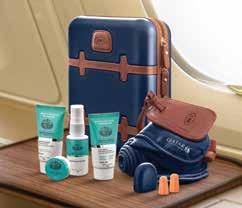
Qatar Airways has introduced limited edition amenity kits for first and business class guests. Those travelling on medium haul flights will receive a Nappa Dori kit featuring destination imagery, while those on long haul flights will receive a miniature version of a BRIC’s Bellagio or Sintesis suitcase with a hard outer shell and leather trim. The BRIC kit will contain products from Italy’s Castello Monte Vibiano Vecchio including lip balm, hydrating facial mist and anti-ageing moisturiser. First class passengers will also receive a night recovery cream. qatarairways.com
British Airways eliminates worry about missed connections
British Airways passengers transferring to connecting flights at London Heathrow no longer have to worry about missing their flight. The newly introduced Premium Transfer Drive will ensure those connecting to short-haul flights in Club Europe, long-haul services in Club World (long haul business class) or First, or anyone who is a Silver or Gold Executive Club member will receive a complimentary ‘airside’ car transfer to their connecting flight if they are at risk of missing it. The British Airways team will track customers with a connecting flight and, where necessary, send a message to the inbound aircraft. The crew will alert the passenger that a car will be waiting for them on arrival. britishairways.com
Household rubbish becomes jet fuel
British Airways has announced plans to design a series of waste plants that convert household waste into renewable jet fuel. This is part of the airline’s commitment to reduce
their net emissions by 50 per cent by 2050, as well as helping to reduce the 15 million tonnes of waste that goes to landfill in the UK each year. britishairways.com
Is the Dreamliner worth the hype?
By Steve Hui, iFLYflat
The arrival of the first Qantas Dreamliner in October begins a new era of travel potential for the airline. Qantas will be using the new fleet for long-haul travel, opening up the skies for new direct routes such as the 17hour (14,498 kilometre) Perth to London non-stop. This is significant for an ‘end-ofline’ carrier such as Qantas, as it allows the airline to redefine its reliance on stopover hubs such as Singapore and Dubai, and also their relationship with their partners Emirates and the Oneworld alliance.
Qantas isn’t the only airline hyped about its Dreamliner fleet. The aircraft are operated by a dozen airlines, including ANA (the launch customer in 2011), Air New Zealand and Air Canada, and even budget airlines Scoot and Jetstar.
The 787 Dreamliner is fitted with impressive new technology and other benefits for both the passenger and the airline’s revenue. Some of the key features include improved cabin pressure, improved airflow and quality, less fuel burn and a turbulence mitigation system. Most notable for passengers is the new set cabin pressure. The Dreamliner cabin pressure is configured to 6,000 feet, creating less tension on the body than other aircraft over long periods of travel. A new air filter system cycles the air quicker and gets more oxygen into the cabin, helping you feel more refreshed during and after the flight.
The aircraft is also incredibly smooth. Turbulence is an unpleasant and unavoidable reality of flying. Boeing has developed a suppression system in the Dreamliner that mitigates turbulence, creating a smoother journey. Combine this with the new carbon-fibre build, and you get less cabin noise as well. iflyflat.com.au
www.luxurytravelmedia.com.au 83 FROM AROUND THE WORLD
Around the world with Four Seasons
Four Seasons Hotels and Resorts has teamed up with the world’s largest private aviation company, NetJets, to offer three customisable luxury private jet itineraries. Passengers can embark on a ski adventure to Jackson Hole

and Vail; an island escape to Lanai, Hawaii; or a European getaway to Florence, Paris, and Milan or Saint-Jean-Cap-Ferrat. The trips include experiences such as a snowmobile wildlife safari in Yellowstone National Park, a


drive around the French Riviera in a vintage car, and a stargazing cruise with an expert in Polynesian mythology. All accommodations are at Four Seasons hotels. fourseasons.com


PRIVATE SKIES NEWS FROM AROUND THE WORLD
BUSINESS CLASS REVIEWS ON THE WORLD'S PREMIUM AIRLINES


ALL NIPPON AIRWAYS | NH879 | BOEING 787-9
BUSINESS CLASS SEAT 5F
Route: Tokyo to Sydney / Flight Time: 9 hours and 20 minutes / Reviewed by: Grace Smith
Cabin
The cabin is outfitted in ANA’s signature royal blue and white, with leather accents on the armrests. The seats are configured in a staggered 1-2-1 format, which enhances privacy, and means that the centre seats are just as desirable as the window seats (minus the view, of course).
Seat
Unlike in other staggered seating configurations, the footrest is perpendicular to the seat (rather than on a slight angle) allowing you to lie straight as well as flat. The footrest area is comfortably large, while there is also plenty of space to stow hand luggage underneath your feet and on the side table. A compact mattress is provided for when you are lying flat, as well as a pillow and a lightweight doona with the lower portion looped around to create a sleeping bag that encases your legs. This design feature is surprisingly effective, ensuring your legs and feet stay covered as you sleep. International power outlets and USB docks are available in the side panel as well as a Do Not Disturb button.
Service
The on-board crew exemplify the unique omotenashi hospitality culture for which Japan is famous, offering discreet but attentive service with genuine warmth. My attendant took the time to introduce herself before take off and checked in on me at regular intervals during the flight.
Food
My flight is late in the evening so dinner is served shortly after I finish my glass of welcome Champagne Lombardi Cuvee Brut Axiome. I have a choice between a Japanese or international meal and I opt for the roasted Oshu Iwaidori chicken with Nambu Ichiro golden pumpkin puree, which is served with avocado salad, salami and marinated prawns. I pair this with the premium wine on offer, which is the Roquette e Cazes 2011 from Portugal. Although I nod off straight after dinner, there is also an extensive snack menu available throughout the flight that includes Ben and Jerry’s ice cream, IPPUDO ramen, Japanese pizza and a French cheese plate.
Entertainment
The entertainment system contains a fairly good selection of Hollywood new releases, however the library of Western TV shows is rather limited. Anime lovers are well catered for and can even read English versions of Japanese comics.
Highs
The privacy afforded by the staggered seating was a definite highlight.
The fine print
Baggage: Up to two pieces, totalling 32kg.
Loyalty program: ANA Mileage Club
WiFi: Available from US$6.95 (about A$9) for 30 minutes or US$21.95 (about A$28) for the full flight.

Pyjamas: No pyjamas are provided but they are available for rent on request.
Lows
I would have liked a few more meal options and was a little disappointed not to receive any dessert.
Amenities kit: The canvas and leather amenity kit is provided by Neal’s Yard, a boutique British skincare brand, and contains a lip balm, facial mist and hand cream as well as the standard toothbrush, earplugs and eye mask. I was very impressed with the eye mask as it provided excellent light blockage and had an adjustable elastic strap, preventing the mask from slipping off as I slept. Our rating
www.luxurytravelmedia.com.au 85
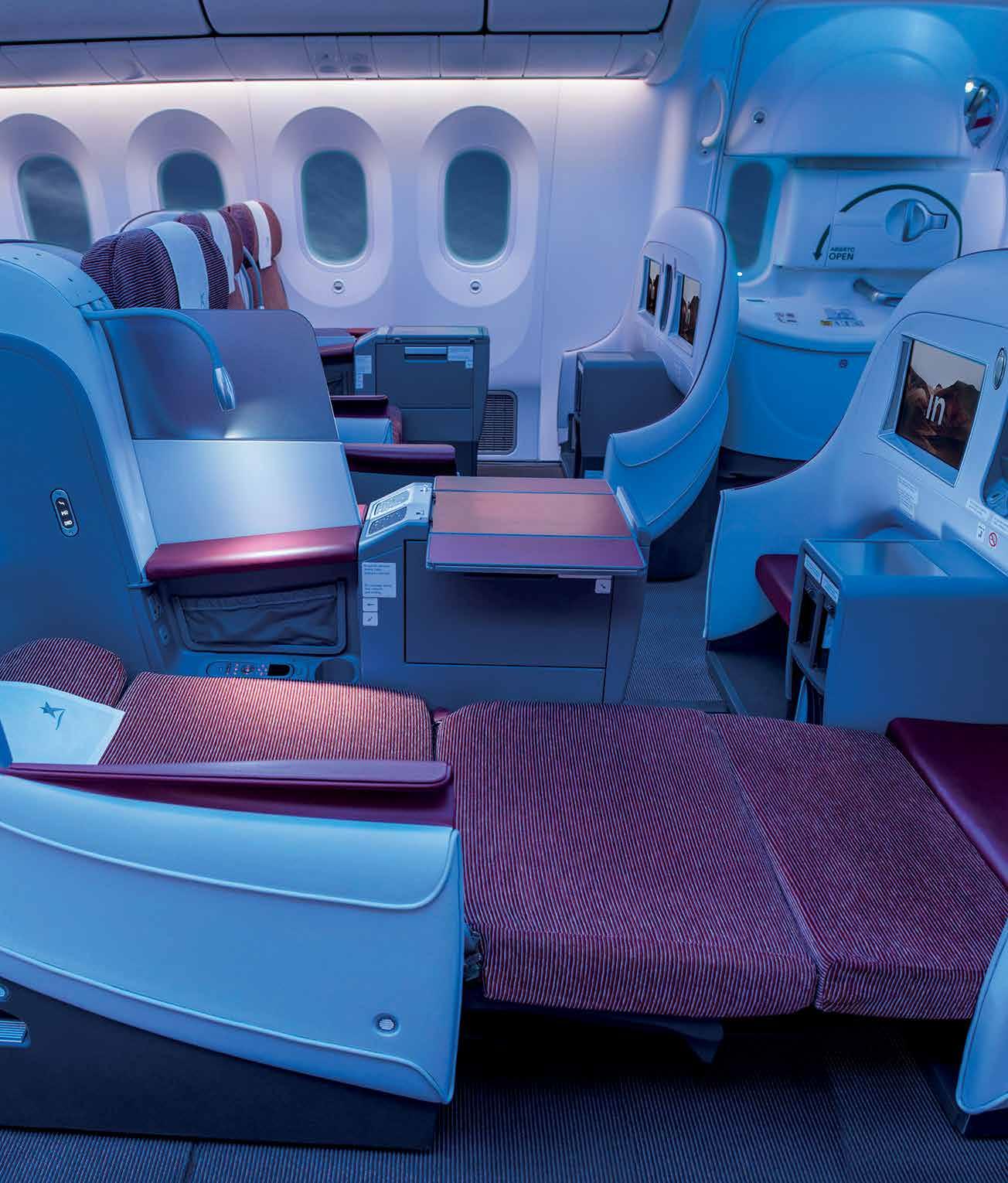
Seat
LATAM | LA804 | BOEING 787-9
BUSINESS CLASS SEAT 1A
Route: Melbourne to Santiago / Flight Time: 13 hours and 15 minutes / Reviewed by: Lucy Jones
Do you ever get over the thrill of being assigned to seat 1A? I certainly hope not. I practically skipped up the aisle to that most coveted of addresses, right in the front left hand corner of the plane (LATAM doesn’t operate a first class). There are 30 seats in the Premium Business cabin, set out in a 2-2-2 configuration. The seats recline to a fully flat bed, 58 centimetres wide and more than 185 centimetres long, and there’s even a built-in massage function that I find very soothing. The layout means you have to pass your seatmate if you’re in the window seat. The gap between the seats is substantial so there’s enough room if the other person is sitting up, though you’ll need to step over their legs if they are lying down.
Cabin
Much has been made of the Dreamliner’s high ceilings and large windows, and it really does feel exceptionally spacious when you step on board. I don’t even bump my head once on the overhead bins; a rarity for me. The cabin looks brand new, decked out in a bright colour scheme of grey, cream and red. The LED lighting runs through a moody spectrum of blues, purples and pinks during the flight.
Service
It’s the inaugural flight for this new route and everyone is in a festive spirit. The crew are sharply (if tightly) dressed and everyone seems to be of above average attractiveness. There’s a pisco sour by my side within minutes and the attentive service continues throughout, even though it’s an overnight flight. Pillows and blankets are offered after the meal and everyone settles in for a decent snooze.
Food
Dinner is served shortly after take-off. My starter of tomato and lemongrass soup is delicious, accompanied by a tasty salad, warm bread and a generous portion of cheese. The main of Ecuadorean prawns is, in a word, bad.
Strangely squishy and grainy, I suspect they have been frozen and thawed, which didn’t do them any favours. The grilled tenderloin would have been a better choice. The menu is redeemed by the chocolate cake with mango passionfruit compote. I intend to have just a bite, but end up demolishing the whole thing. The wine selection is excellent. A 2013 Don David Reserve Malbec from Argentina is my top pick, though I’m happy to switch to the Viña Ventisquero 2014 Grey Carmenere when they run out. Breakfast is served shortly before landing, however I manage to sleep right through it.
Entertainment
The extra room between the seats means my screen seems awfully far away. It’s a perfectly respectable 39-centimetre screen, but I felt it could have done with a few more. The selection of movies is good and there are updates regularly, rather than waiting for new ones each month, as with most airlines. There are also a number of box sets of popular television shows, so you can settle in for a binge watch.
Highs
The flight is the first non-stop service from Melbourne to South America and makes for a very pleasant hop between the continents. LATAM has a huge network throughout South America, so you can jump on a connecting flight and go just about anywhere.

Lows
The 787-9 has dimmable windows, rather than pull down shades. This becomes a problem somewhere over the Southern Ocean –the moon shines in like the beam of a spotlight and there’s nothing I can do to block it out (as I’m not a fan of eye masks). Choose a seat on the right-hand side of the plane for this journey.
Tip
Australian passengers need to pay a ‘reciprocity fee’ of US$117 (about A$152) on arrival
in Chile. When we landed, only one teller was available and the process took more than an hour even though we were close to the front. Those at the back of the line would have been waiting much longer. The charge only applies to Australian and Mexican citizens, so if you have dual nationality now is a good time to pull out that second passport.
Our rating
The fine print
Baggage: Three bags weighing up to 23kg each for Premium Business or Premium Economy passengers.
Loyalty program: LATAM Pass (though you can use any oneworld program).
WiFi: No.
Pyjamas: No.
Amenities kit: A very good Salvatore Ferragamo kit is handed out before departure. It’s stocked with hand and face moisturiser, lip gloss, socks, eye mask and a pen – always handy for arrival forms.

www.luxurytravelmedia.com.au 87
CLASS
THE WORLD'S PREMIUM AIRLINES
BUSINESS
REVIEWS ON

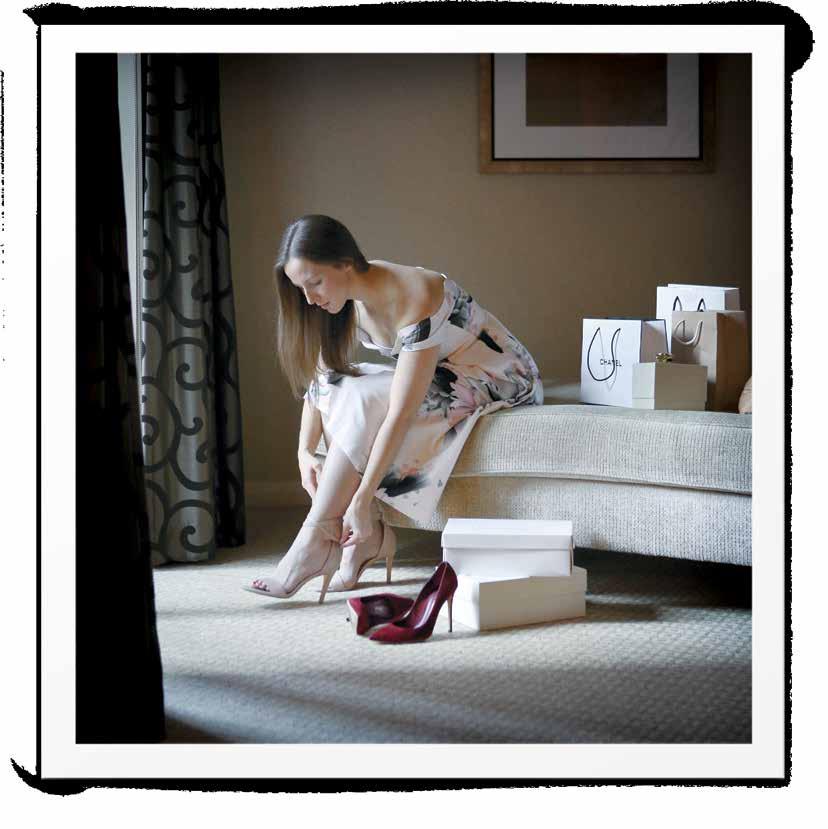





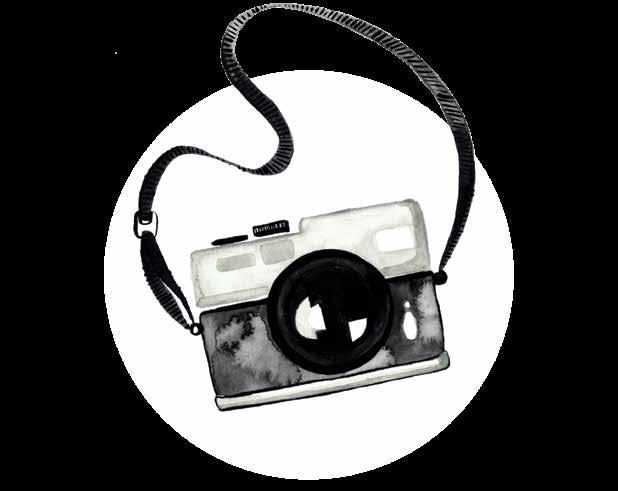
www.luxurytravelmedia.com.au 89 090 Fly fishing | New Zealand 095 Golf | New Zealand 100 Philanthropy | Abercrombie & Kent 104 Tour | Mountain gorillas 107 Conservation | Great Barrier Reef 114 Safari | Madagascar 118 Ski | Japan 122 Main event | Australian Open EXPERIENCE
with me Come fly
Belinda Luksic tries her hand at fly fishing and finds New Zealand’s striking wilderness to be the perfect spot to make her debut.
Images by Belinda Luksic
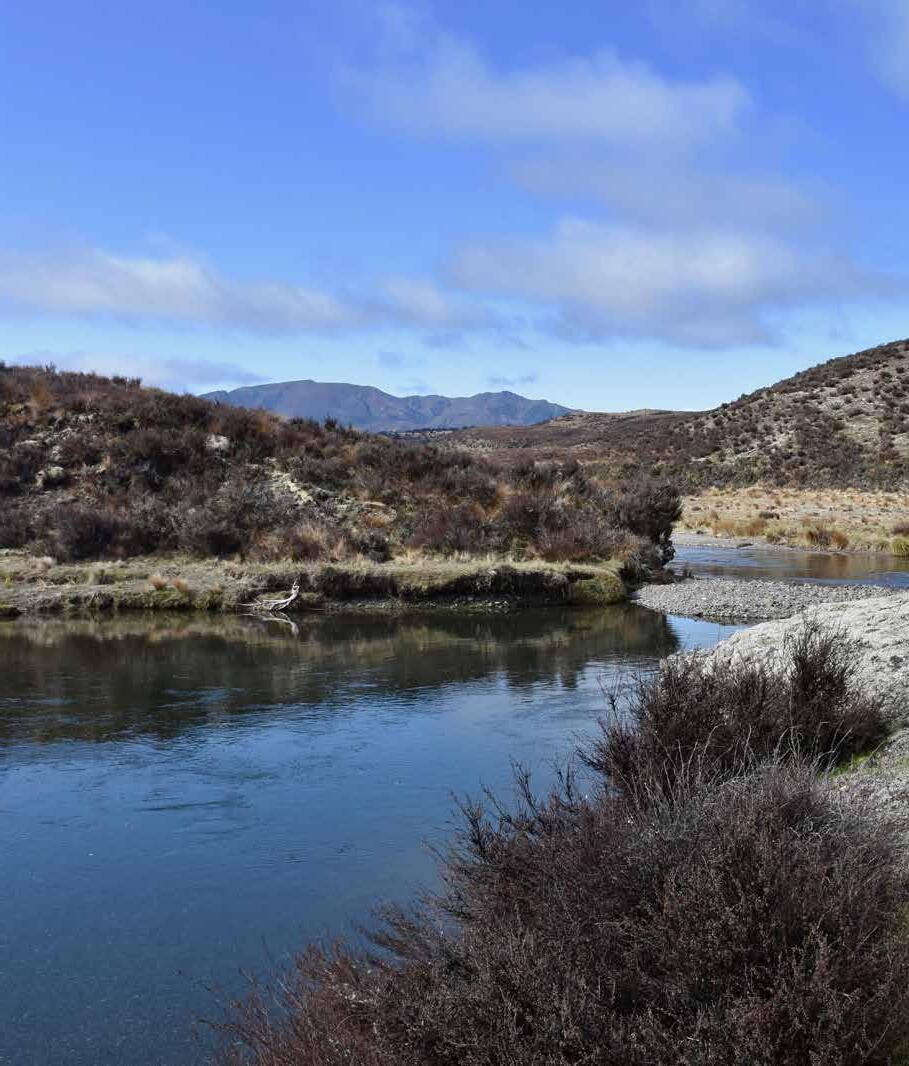
NEW ZEALAND PORONUI LODGE NAPIER AUCKLAND
It’s the roar of water that you notice first at the Safari Camp at Poronui. New Zealand’s Mohaka River bends here, crashing and tumbling over boulders and rocks before continuing downstream. This crook of wilderness, a solitary glamping outpost surrounded by Manuka trees and indigenous virgin beech forest near Lake Taupo, in the central North Island, is home for the night. It’s luxurious, with hot showers, solar lighting and a private chef. At night, the sky is bright with stars and the sound of the river lulls me to sleep.
When the river is low, you can fly-fish here. Instead, we’ll be heli-fishing in what fishing guide Sean Andrews calls ‘the Olympics of fly-fishing’; gin-clear waters in remote backcountry where we get only a couple of chances to hook the trout before they’re spooked. After that, says Sean, “they won’t eat and we’ll have to go upstream”.
From October to June, angling enthusiasts from around the world come to Poronui, a premier sporting lodge, to fish these exclusive backwaters, considered a world-class fly-fishing spot. It’s catch-and-release only, a conservation effort to protect the small numbers.
We’re up and away early the next morning. Our helicopter rises swiftly above a bank of low-lying clouds and veers west towards the Kaimanawa Ranges and private Maori land. This vast wilderness of forested mountains, valleys and plains is criss-crossed with pristine rivers, lakes and streams. Rainbow trout spawn in the waters and wild deer roam free.
It’s also where we’ll be fishing. We arrive in the Maori Owhaoko A and B lands at the start of the beat (the river stretch we’ll be fishing), in a valley thick with golden tussocks and bounded by low-rise hills. Sunshine sparkles on the water and the ground underfoot is springy with moss.


Crossing the river shallows, we clamber up the bank to ‘Flat Rock’, a rocky outcrop overlooking an elbow of deep water that’s crystal clear and teeming with trout. From this vantage point, it’s easy to spot the fish lurking beneath the surface.
Sean fixes a fly to my rod and runs through the howtos. With a flick of the wrist, I cast off. The line whips around and lands lightly on the water near some trout, but drifts by without so much as a bite. I cast twice more without success and then gingerly edge along to a new spot and try again.
What seems like many casts (and a few hooked tussocks) later, success! The fly dips. Sean calls “strike” and I hastily pull up the rod, eventually snaring a respectable
www.luxurytravelmedia.com.au 91
EXPERIENCE ON THE WAY TO FLAT ROCK
FLY FISHING | NEWZEALAND
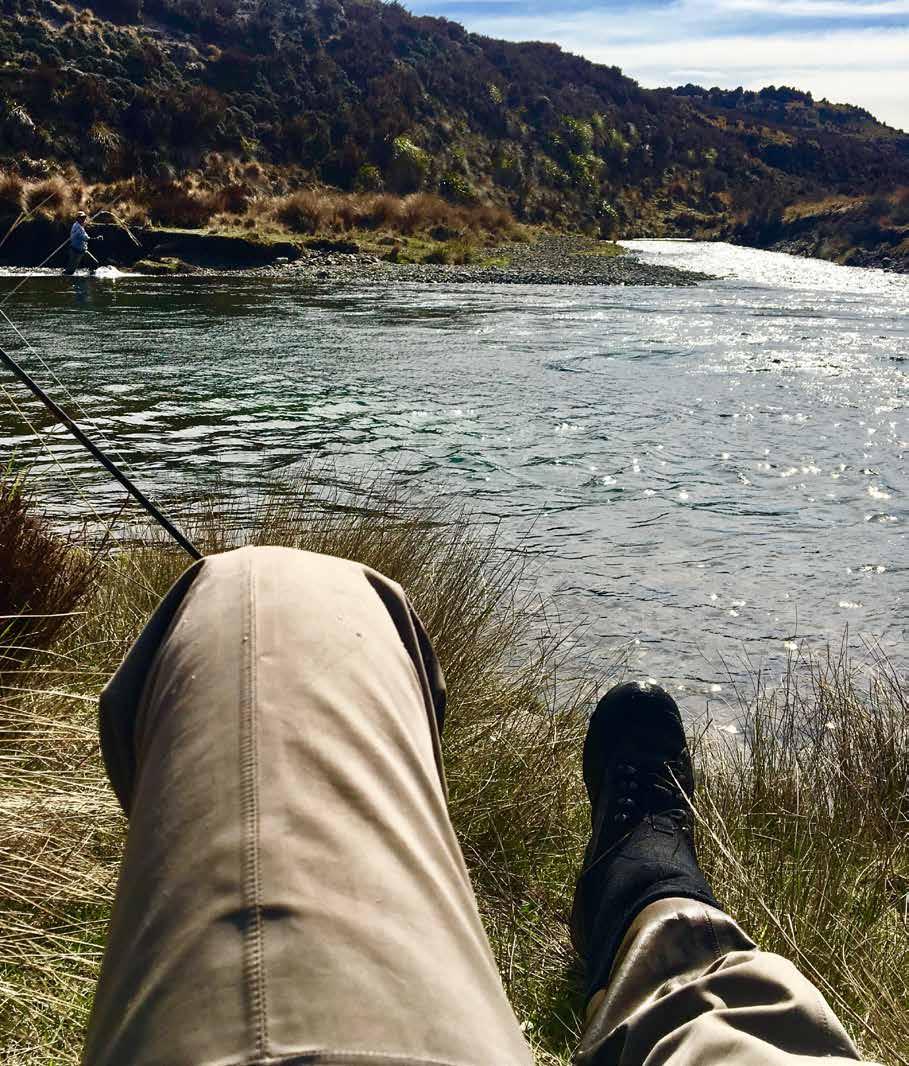
“
“
TAKING A WELL EARNED REST
The fly dips. Sean calls “strike” and I hastily pull up the rod, eventually snaring a respectable 45-centimetre trout.
45-centimetre trout. After a few ‘trophy’ photographs, we release the gleaming catch back into the river and watch it dart away upstream.

Our day continues in much the same way. We wade and stalk, stopping to fish when we spot trout. Even for an amateur like myself, it’s a lot of fun. Along the way, we pass spectacular unsullied scenery. Tussocks and moss give way to pebbly banks and ridges plush with clumps of bright green hanging ferns. The hoof prints of deer mark the riverbank at times and startled geese take to the skies, honking indignantly as they disappear from sight.
It’s late in the afternoon when we hear our helicopter approaching. Exhausted in a good way, we flag it down and head back to Poronui for dinner at the communal dining table in the Main Lodge. There’s no trout available commercially in New Zealand so we ‘make do’ with salmon. There are no complaints.
See more images from this story at luxurytravelmedia.com.au
Stay


Poronui is a luxury wilderness lodge on the doorstep of world-class backcountry adventures. Bounded by the mountainous Tūwharetoa region and Kaimanawa State Forest, it’s a short helicopter ride to remote hiking trails, world-class fly-fishing and hunting. Set on over 16,000 acres of forest and grazing land, the main lodge caters to 14 guests with cabins overlooking the Taharua River. There is an Olympic shooting range with archery and clay pigeon shooting, and an equestrian school for showjumping and dressage. Horse-riding treks of the property are a chance to spot wild sheep, Red and Sika deer, and abundant birdlife. During low season, double rooms at the lodge start from NZ$630 (about A$575) per person per night and include all meals and beverages (except Cellar Reserve List). During peak season (20 December to 14 March), double rooms start from NZ$900 (about A$816) per person twin share. poronui.com
The Safari Camp at Poronui is available from October to April. Prices start from NZ$630 (about A$575) per person per night and include a private chef.
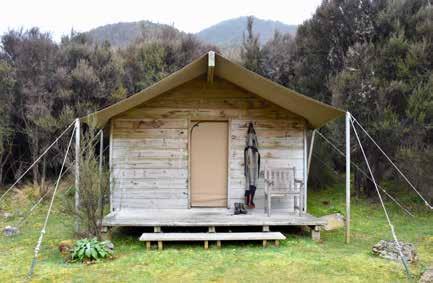
Experience
A guided heli-fishing day trip with Poronui starts at NZ$2,000 (about A$1,815) per person for a maximum of two people.
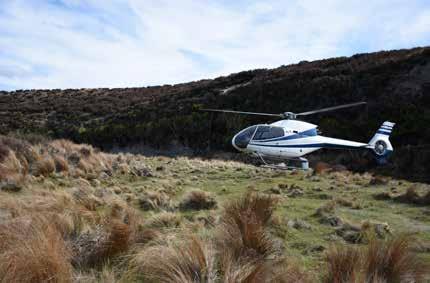
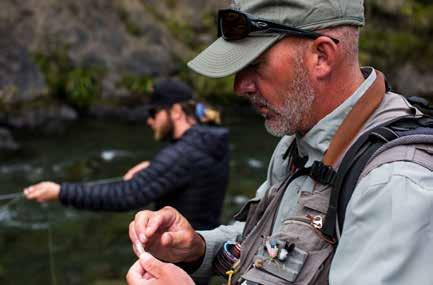
www.luxurytravelmedia.com.au 93
SAFARI CAMP AT PORONUI CHOOSING THE RIGHT FLY
The writer was a guest of Poronui and travelled courtesy of Destination Great Lake Taupo and Tourism New Zealand. destinationgreatlaketaupo.com
THE WRITER AT WORK
DOOR TO DOOR SERVICE
A GOLF VACATION WITH A DIFFERENCE
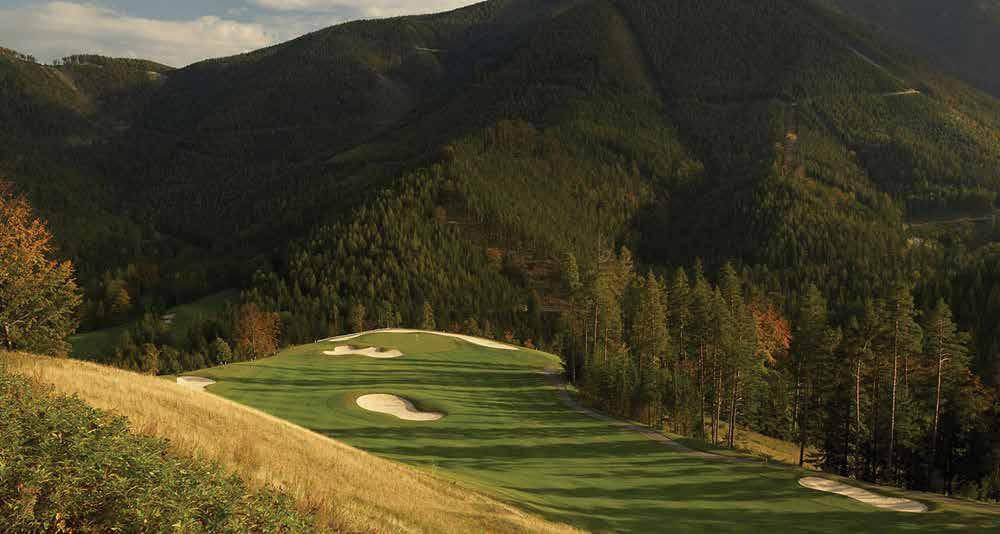
“The Number 1 Golf Travel people in Australia and probably beyond. Stuart & his team don’t leave any stone unturned when creating absolutely memorable Golf travel experiences”
LIMITED AVAILABILITY
A-GRADE PANORAMA SUITE
A$8995
10 - 17TH JULY 2018: YOUR 7 DAY ITINERARY
DAY 1-2: NUREMBERG | GERMANY
Your adventure begins in Nuremberg. Explore the nearby picturesque market town of Roth, or play your first round of golf at Golf Club Am Habsberg, which has been consistently recognised as one of the top courses in Europe - featuring large greens it requires players to contemplate their method of approach: chip, pitch or putt.
DAY 2-4: REGENSBURG - PASSAU | GERMANY
We arrive in 13th-century Regensburg, one of Germany’s best preserved medieval cities which features 1,300 listed buildings of historical interest. We then dock in Passau, where you can visit St Stephen’s Cathedral - a masterpiece of Italian baroque architecture. Awaiting is Hartl Golf Resort’s 80-hectare championship course - a regal golfing pleasure that was awarded a ‘world-class’ rating the year it opened.
A breathtaking 5 star luxury river cruise that combines four of Europe’s finest golf courses PACKAGE 1ST TIME EVER OFFERED FROM AUSTRALIA
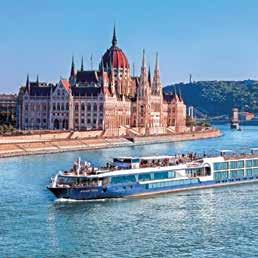
The Golf Touring Company has established a reputation, both domestically and internationally, for being the ‘go to’ people when wanting to arrange a golf vacation with a difference!
Using our 30 years of experience in the travel and golf industries, we have decided to combine our love of golf touring with the fastest growing sector of the travel industry – European river cruising! Whilst we acknowledge that there may be other operators who offer a cruise combined with golf, we are the FIRST TOUR COMPANY IN THE WORLD who have taken this to the next level and actually chartered the entire boat for the duration!
✔ 7 nights accommodation and all meals including alcohol and soft drinks
DAY 5-6: MELK - VIENNA | AUSTRIA
Enjoy a guided visit of Melk’s magnificent 11th-century Benedictine Abbey and 210-foot-high cupola. Then, cruising down the the Blue Danube through the picturesque Wachau Valley, a UNESCO World Heritage Site, we arrive in Vienna. The magnificent 27-hole golf course of Golf Club Adamstal is a true jewel situated amidst the alpine foothills and guarantees a pure golf experience.
DAY 7-8: BUDAPEST - DEPARTURE| HUNGARY
✔ 4 rounds of Championship Golf at Am Habsberg, Hartl Golf Resort, Adamstal and Pannonia GC
✔ Hosted by Andrew Daddo from Fox Sports’ “The Golf Show”

✔ Tour fully escorted by company staff and some of the most renowned golf teaching professionals in Australian golf
✔ Certified local guides offering VIP access during ports-of-call
✔ All tips, port taxes and free WiFi
✔ Souvenir shirt, cap and ball
LIMITED AVAILABILITY –BOOK NOW! ONLY 8 CABINS LEFT!
Call: 02 8484 2059 or Visit: golfrivercruise.com.au
– EUROPEAN RIVER CRUISE –
Our final dock is Budapest. Take a guided sightseeing tour around one of Eastern Europe’s liveliest cities as we travel to Pannonia Golf & Country Club, located in the beautiful Máriavölgy Valley - rated as the number 1 course in Hungary it is a wonderful closing round to our journey down the Danube. SUMMARY
further information, please contact stuart@thegolftouringcompany.com.au
For just
pp
For
✔ 5 star luxury cruise: Avalon Panorama has spacious, contemporary suites with open -air balconies and a sky deck
–
THE GOLF TOURING COMPANY
For a complete detailed day to day tour itinerary as well as course information visit our website: golfrivercruise.com.au
la cape Crème de
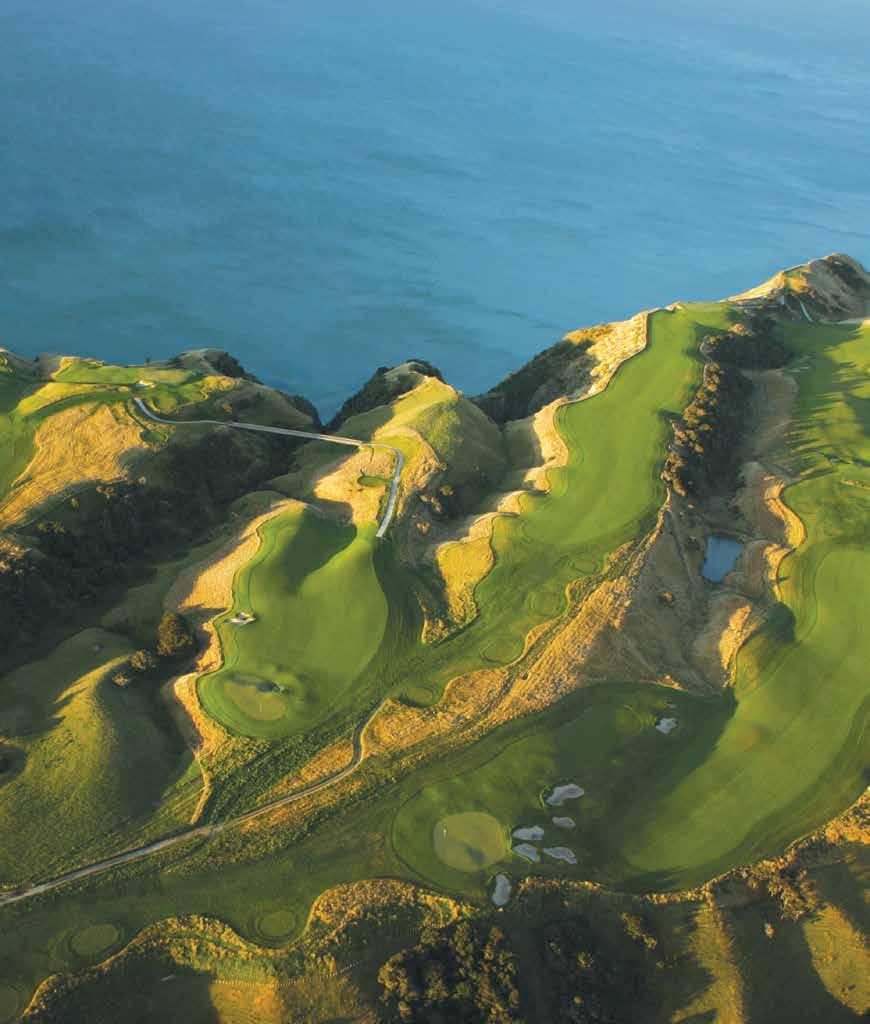
www.luxurytravelmedia.com.au 95
Craig Tansley reaches new golfing heights at the stunning Cape Kidnappers on New Zealand’s North Island.
There’s a moment midway through the back nine holes at Cape Kidnappers where I’m overcome with a doubt so fierce I lose all semblance of rhythm. Every golfer understands this phenomenon because we know our swing is just a reflection of what’s going on in our head.

This meltdown is magnified on tough golf courses and perhaps nowhere is tougher than the world’s 16th-best course, Cape Kidnappers. I’ve reached a hole called Pirate’s Plank. It’s the signature hole, the course’s 15th, and is built along narrow, crumbly fingers of sea cliff, beside a sheer ravine. The second shot here demands a golfer thread a ball between two huge drop-offs, with the left side the most extreme –here the course drops more than 200 metres to the sea below.
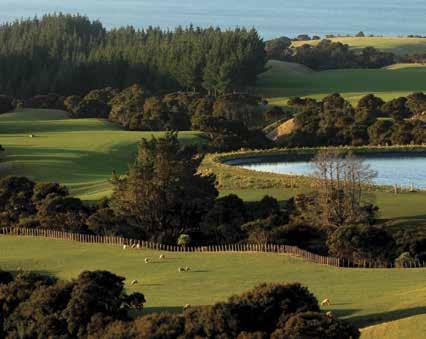
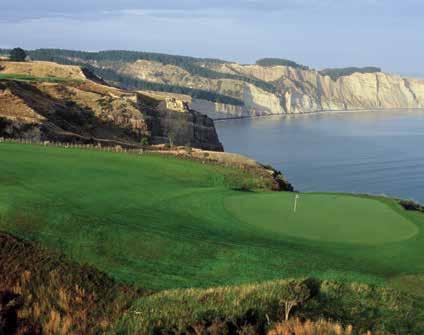
I’ve hit the ball fairly straight to this point, but now I must hit the ball completely straight. And so my hips suddenly feel stiff and my arms barely feel connected to my shoulders at all. My shot careers off at right angles, hooking left, down the ravine, bouncing off the chalky-white cliff walls, landing with the fish far below.
Oh, but what a beautiful place at which to disintegrate. Golfers travel from across the world to do what I’m doing now; to tempt fate against the biggest golfing challenges nature’s topography can muster. And nothing offers more challenges than this Tom Doak-designed layout that plays out along the high cliffs of a sheep and cattle station on New Zealand’s North Island.
This is a links-style course, but in a very non-traditional links setting. The back nine, in particular, takes in so much of the surrounding cliffs of the cape that I wonder if I should be given a harness and climbing gear along with my clubs.
Cape Kidnappers might be the golf world’s most stunning retreat, but it’s not solely the domain of golfers. In fact, many guests stay here without playing the course at all. The Farm at Cape Kidnappers is the 22-room property which sits at the top of a headland of cliffs and gorges. Below, the blue water of Hawkes Bay rolls out to the horizon, and should you time it right, migratory orca and southern right whales pass by close to shore. Hawkes Bay, New Zealand’s second-largest wine region, pans out amongst coastal ranges and a patchwork of pastoral land.
Cape Kidnappers is significant for numerous reasons. For one, it’s home to the largest mainland colony of gannets in the world. There’s over 20,000 gannets nesting by the cliff edges of Cape Kidnappers and they are so undeterred by humans I can stand just a few metres away. Cape Kidnappers is also a sacred site for Maori, and is linked back to the very origins of the Maori in New Zealand. Captain Cook named this cape when local Maori attempted to kidnap a young Tahitian boy from his ship in 1769. The cape once housed a whaling village, but has been a working cattle and sheep farm since the late 1800s. Today guests can come and learn what life is like on a New Zealand farm – a farm, that is, with fine art on its walls, its very own day spa and five-course degustation meals served each night.
The Farm at Cape Kidnappers stretches across almost 6,000 acres. The land is incredibly rugged to traverse – there’s horse rides to take across
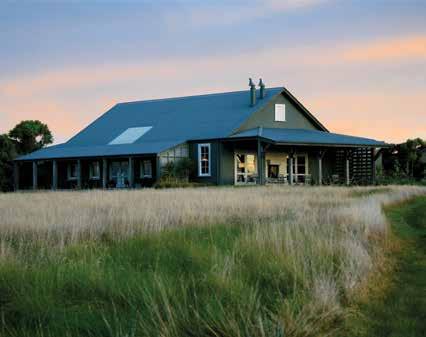
EXPERIENCE
GOLF | NEWZEALAND
THE CLUBHOUSE
PIRATE'S PLANK
VIEW FROM THE BALCONY
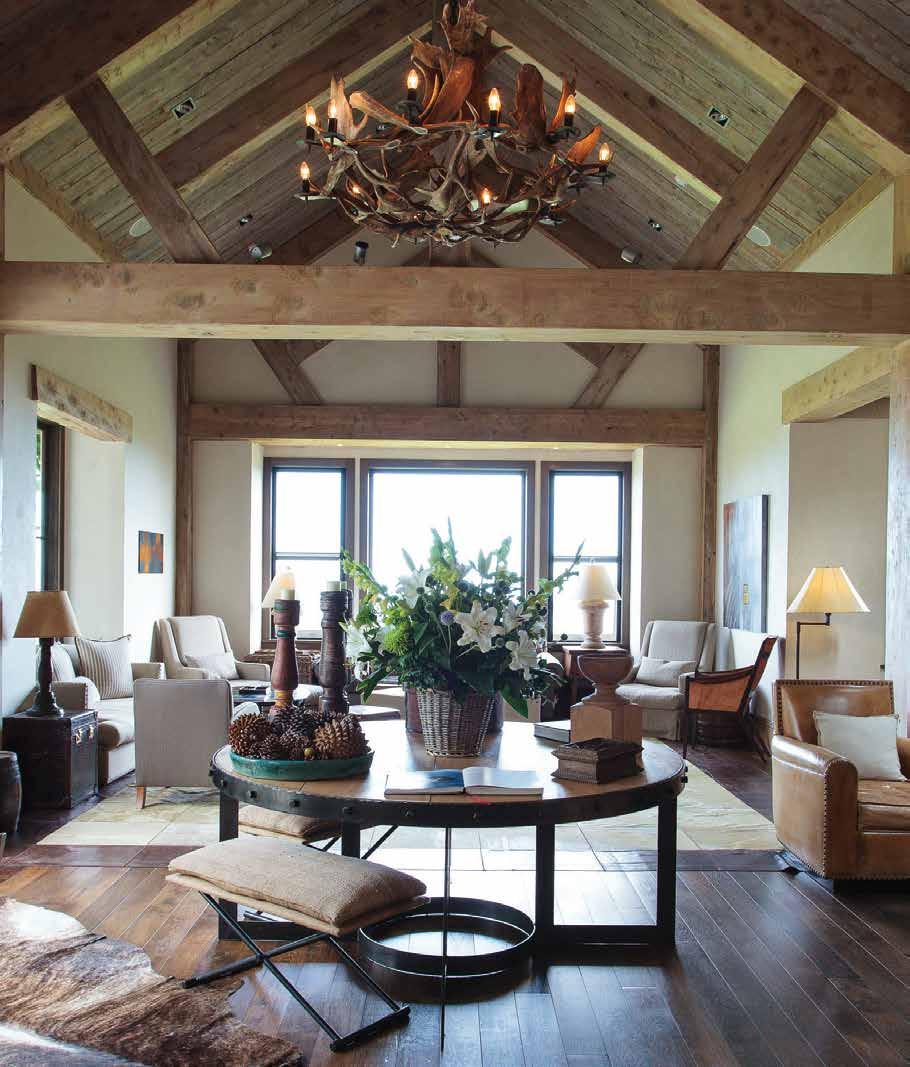
www.luxurytravelmedia.com.au 97 THE MAIN LOUNGE
the property, and long hikes to the water’s edge. One morning I take an all-terrain-vehicle excursion with the sheep farmer next door across the entire property. We angle up steep hills, through green valleys and across creeks, and we don’t see another person for hours. There's a sense of isolation you won’t find in many places. There’s nothing around for miles, just sheep, cliffs and some of New Zealand’s most unique birdlife. The property runs the largest wildlife restoration program in New Zealand, keeping a safe space for the country’s endangered endemic animals, which guests can visit at any time. I spend time with the property’s farmers and learn how they run livestock on a piece of cape terraced like war bunkers and as hollow as honeycomb, where Maori pa (fortresses) dominate the landscape.
The evenings are my favourite time at The Farm. The light begins to fade and there’s no sound on the verandah outside my suite save the occasional bark of working sheep dogs clocking themselves off for the day. I watch the sun set, then wait until the first stars start to twinkle in the sky, before joining other diners for a pre-dinner glass of Hawkes Bay red wine beside one of the restaurant’s open fires.
“The restaurant uses local produce and menus vary daily depending on what’s freshest. I like to watch the chefs in their spotless whites wander outside in the dusk to pick vegetables and herbs straight from the property’s gardens. Though we’re close to Hawkes Bay’s 80 wineries, I prefer the sanctity The Farm offers me. It’s a haven. Eventually, but begrudgingly, I leave, and I am feeling refreshed. Smelling of salt and kelp, the clean air blowing across the property has cleansed me and I am ready for the world outside again.
Read more from this story at luxurytravelmedia.com.au
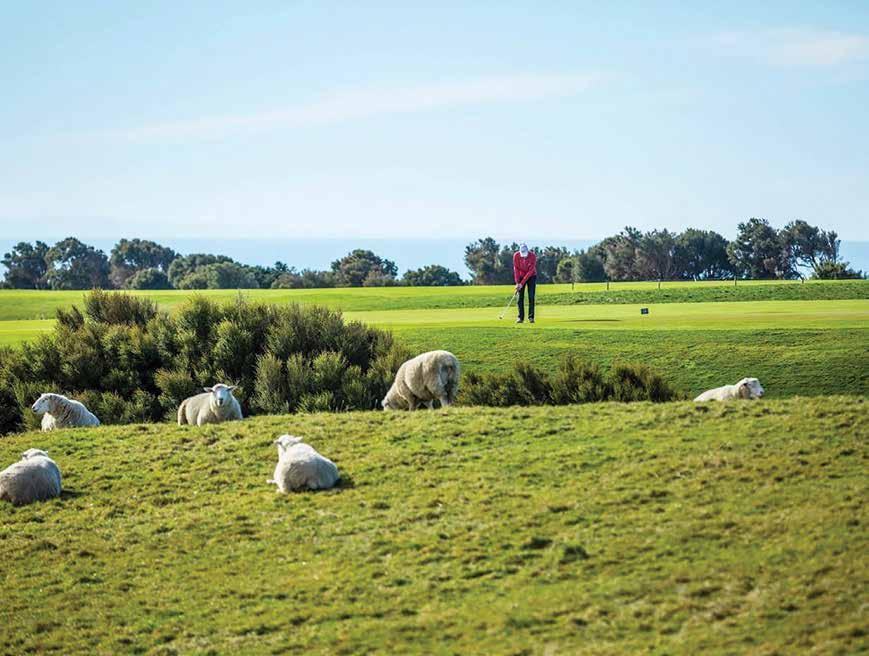
Stay
Suite rates start from NZ$1,997 (about A$1,826) per night and include pre-dinner drinks, dinner and breakfast for two. capekidnappers.com

98 www.luxurytravelmedia.com.au
“There's a sense of isolation you won’t find in many places. There’s nothing around for miles, just sheep, cliffs and some of New Zealand’s most unique birdlife.
TEE OFF WITH THE LOCALS








Feel life´s potential info@kamalaya.com | www.kamalaya.com | Tel: + 66 (0) 77 429 800 Experience a complete wellness journey at Kamalaya Wellness Sanctuary and Holistic Spa, Koh Samui, and restore your health and vitality with one of our inclusive programs
Luxury with heart
A personal resolution was the catalyst for a broader philanthropic approach for the founder of industry powerhouse Abercrombie & Kent. Now the company’s not-for-profit arm is making a meaningful difference around the world.
 By Lucy Jones
By Lucy Jones

SANTIPHOTOSS / SHUTTERSTOCK.COM
In 1971, Geoff Kent went on his last hunt. The founder of luxury tour operator Abercrombie & Kent grew up in Kenya and had been hunting since childhood. But on this day, somewhere close to Tanzania’s Lake Manyara, he had a change of heart and put down his rifle. The company’s slogan became ‘hunt with a camera, not with a gun’.
A decade later, Kent took things a step further and Abercrombie & Kent began to raise funds for wildlife conservation in Kenya’s Maasai Mara. Today, Abercrombie & Kent Philanthropy (AKP) is a registered not-for-profit organisation with more than 30 projects operating worldwide and an annual budget of US$2.5 million. Projects range from elephant outreach with local communities in Botswana to a women’s mushroom farming cooperative in Chiang Mai and art workshops for disadvantaged Inuit youth in Arctic Canada.
Keith Sproule is the executive director of AKP, joining the brand in 2014. Sproule has a long history in tourism and development, having worked as Tourism Business Advisor to the World Wildlife Fund in Namibia and been chairman of the International Ecotourism Society. When Sproule met with Kent he was adamant –if they were going to do this, they were going to do it right. “We wanted to really make a difference in terms of what it means for a travel company or tour operators to give back,” he says. “I told Geoff at the start, it only works if we set a good standard and then try to elevate standards for the whole industry.”
There’s no one-size-fits-all approach. Each of the programs is created in careful consultation with community leaders or local government and AKP has full-time development professionals working around the world. The programs are a long-term investment on the part of Abercrombie & Kent; the company continues to work with the communities over a number of years. “There’s a real commitment to genuinely giving back,” Sproule says. “It’s multi-year, programmatic, systematic – we’re not just airlifting in some soccer balls.”
The impact of the programs is far reaching. Providing school lunches does much more than just fill hungry bellies. It directly contributes to higher attendance levels, better test scores and


102 www.luxurytravelmedia.com.au
A&K PHILANTHROPY EXPERIENCE aconscience luxurywith
gender parity in graduation, elevating the status of the school as a whole. Programs employ widows in the kitchen and use only locally produced ingredients to reduce the reliance on imported foods. Something as simple as lunch can have a huge positive impact on the entire community.

One of AKP’s newest projects is a maternity ward in Nakatindi Village, Zambia, built with a US$250,000 investment and opened in midNovember. The country has one of the highest rates of HIV in the world and the disease is often passed from mother to child. “The best way to get in front of it is to ensure births are taking place in a clean environment with medical professionals,” says Sproule. The local ministry has agreed to staff and supply the clinic, and the community will maintain and promote it. Women in the community who currently distribute antiretroviral drugs to those infected with HIV will encourage other women to attend.
Sproule is very clear that what Abercrombie & Kent do is not ‘voluntourism’, a practice that has begun to attract criticism within the industry. Guests will spend only an hour or two visiting their chosen project, speaking with community leaders and learning about the difference a school or well or maternity ward can really make. “Our goal is to put a framework of understanding in place so that when the guests have that time of genuine contact with the hosts they are given real insight into how the community is working to address their challenges.” Sproule is looking to create what he calls a “refrigerator
moment”. Guests take thousands of photos on their trip, but the one that makes it onto the fridge is from the day they visited a local bike shop or worked with a wildlife researcher.
Many guests are so inspired that they continue to donate to the project long after their tour has ended. AKP guarantees 100 per cent of donations go to the nominated cause and, as a registered non-profit, all donations are tax deductible. AKP commits to communicating with guests about the status of a project and providing a metric of understanding for what they are going to achieve.
Though Sproule is justifiably proud of all AKP’s initiatives, his personal favourite is the Cambodia Clean Water Project, which has been running since 2008. Poor sanitation and waterborne disease are responsible for tens of thousands of deaths in Cambodia each year, with children under five the worst affected. Siem Reap is the second poorest district in the country, despite the fact that it is home to its most famous tourist attraction, Angkor Wat. Most people who live in the region do not benefit from the more than one million tourists who arrive each year. AKP has drilled at least 1,300 wells in Siem Reap, bringing clean water to more than 20,000 people. Each well costs US$400, a small sum when you consider what it offers in return. “The impact at that household level will change a family’s quality of life, health, income opportunities. It will transform their life experience.” akphilanthropy.org

www.luxurytravelmedia.com.au 103
DEEPALAYA SCHOOL, INDIA
CAMBODIA CLEAN WATER PROJECT
TOUR ANTHOLOGY TRACK MOUNTAIN GORILLAS

Gorillas in our midst
Just 880 mountain gorillas remain in the wild. Join a luxury tour to see these rare creatures up close, writes Grace Smith.
The Central African nations of Rwanda and Uganda both have bloody histories that have kept them off the tourist trail for decades. But now, both are forging a new name for themselves as unorthodox travel hotspots. Although the respective capital cities Kigali and Kampala are undoubtedly burgeoning, the strongest appeal is the chance to come face to face with a rare mountain gorilla.
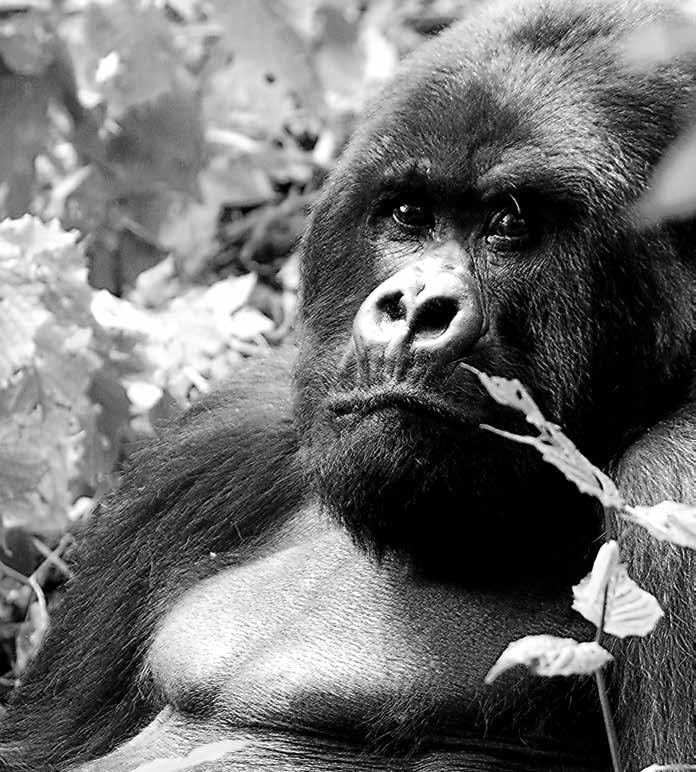
The mountain gorilla is one of the most critically endangered mammals in the world, with a population of just 880 spread across Uganda, Rwanda and the Democratic Republic of Congo. Ever since primatologist Dian Fossey drew attention to their declining numbers in 1967 (at which time there were just 240), eco-tourism has been promoted as the best way to conserve and protect the vulnerable species from extinction. Although Fossey was mysteriously murdered in 1985, her work is still being carried out and conservationbased gorilla safaris have put Rwanda and Uganda on the map for travellers searching for an exclusive off-the-beaten track experience.
Responding to interest in these endangered primates and the increasing stability of the region, luxury tour operators have recently added Rwandan and Ugandan gorilla treks to their safari stable, while hotel and resort brands such as One&Only and Singita have announced luxury properties in the region.
104 www.luxurytravelmedia.com.au
UGANDA RWANDA
VOLCANOES NATIONAL PARK
BISOKE MIKENO
KARISIMBI
BISATE LODGE
QUEEN ELIZABETH NATIONAL PARK
KIBALE NATIONAL PARK
KYAMBURA GORGE
BWINDI IMPENETRABLE FOREST KIGALI
SANCTUARY RETREATS’ GORILLA FOREST CAMP
Where to see mountain gorillas
Rwanda
Volcanoes National Park
Volcanoes National Park contains five of the eight volcanoes in the Virunga Mountains. Once Fossey’s research base, the national park is home to the majority of the mountain gorilla population as well as the rare and endangered golden monkey. The park has 10 groups of habituated gorillas and issues just 80 tourist permits a day.
Where to Stay
Bisate Lodge opened earlier this year, offering six luxury forest villas with prime views of the volcanoes Bisoke, Karisimbi and Mikeno. When they’re not tracking gorillas up the mountain, guests are invited to participate in the property’s conservation efforts and meet and engage with the local community. wildernesssafaris.com
Luxury gorilla tracking tours

Rwanda
Abercrombie & Kent
Luxury safari pioneers Abercrombie & Kent offer a five-day journey into the Volcanoes National Park, beginning and ending in the Rwandan capital of Kigali. As well as spending two days tracking gorillas in the Virunga Mountains, the itinerary takes guests on a city tour of Kigali and a visit to twin lakes Ruhondo and Burera, a short drive from Bisate Lodge, where guests stay for two nights.
Prices for the Gorillas of Rwanda journey start from A$10,675.
abercrombiekent.com.au/journeys/gorillas-of-rwanda
Rwanda and Uganda
Adventure World
Uganda
Bwindi Impenetrable National Park
Dubbed “impenetrable” due to its extensive bamboo and thick ground cover, this national park has four habituated gorilla groups. It is located in Bwindi Impenetrable Forest, named a UNESCO World Heritage Site because of its rich and complex ecology and diverse species.
Where to Stay
Located on a ridge high in the forest, the unique location of Sanctuary Retreats’ Gorilla Forest Camp means it is often visited by local gorilla families. The eighttent camp also provides customised sedan chairs to allow less mobile guests to be carried into the rainforest during gorilla safaris. sanctuaryretreats.com
Uganda andBeyond
To track mountain gorillas in Uganda, andBeyond offer a five-day itinerary starting in Kampala before continuing to Bwindi Impenetrable Forest where guests will spend three nights at Sanctuary Retreats’ Gorilla Forest Camp. The trip includes a journey to Queen Elizabeth National Park, which is home to leopards, tree-climbing lions and nine species of primates, and Kyambura Gorge, one of the best places in Uganda to see chimpanzees.
Prices for the Gorilla Tracking Safari in Uganda journey start from US$3,063 (about A$3,912). andbeyond.com/destinations/africa/uganda
Coming soon

Take in both destinations and a wider range of wildlife with a 10-day Kampala to Kigali itinerary from Adventure World. Guests will spend a full day tracking gorillas in Rwanda’s Volcanoes National Park and visit Uganda’s Queen Elizabeth National Park and Kibale National Park, home to an evergreen rainforest populated by habituated chimpanzees. The trip also includes time in Jinja, Uganda’s adventure capital, a farm stay, and a visit to the genocide museum in Kigali.
Prices for the Culture and Wildlife of Uganda and Rwanda journey start from A$3,499. adventureworld.com.au/rwanda-and-uganda/culture-wildlife-of-uganda-rwanda/

Stay longer
If you’re visiting Rwanda, extend your trip with an extra night in Kigali. Once regarded as a stopover destination with few attractions, the city has seen a recent wave of development with the opening of Radisson Blu and Marriott hotels as well as a number of quality restaurants. A peaceful and safe city, Kigali is highly regarded for its vibrant nightlife and rich cultural attractions.
One&Only Gorilla’s Nest will open in Rwanda in 2018 (see page 022).
www.luxurytravelmedia.com.au 105
Somewhere onlyknowwe
Behold the ebb and flow of the Indian Ocean in luxurious privacy. Savour the sweet, sour and spicy tangs of the tropics in cuisine made to order. Share secrets on strolls along a sun-kissed beach and relish the sensual pleasures of bespoke spa rituals. Saman Villas is your paradise, found.


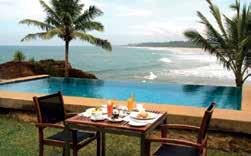
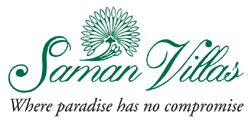

Bentota, Sri Lanka +94 34 7200 334 | resv@samanvilla.com www.samanvilla.com
Behind the seas
A social movement aimed at saving the Great Barrier Reef is a recent addition to the growing list of conservation initiatives coming out of the luxury travel industry.
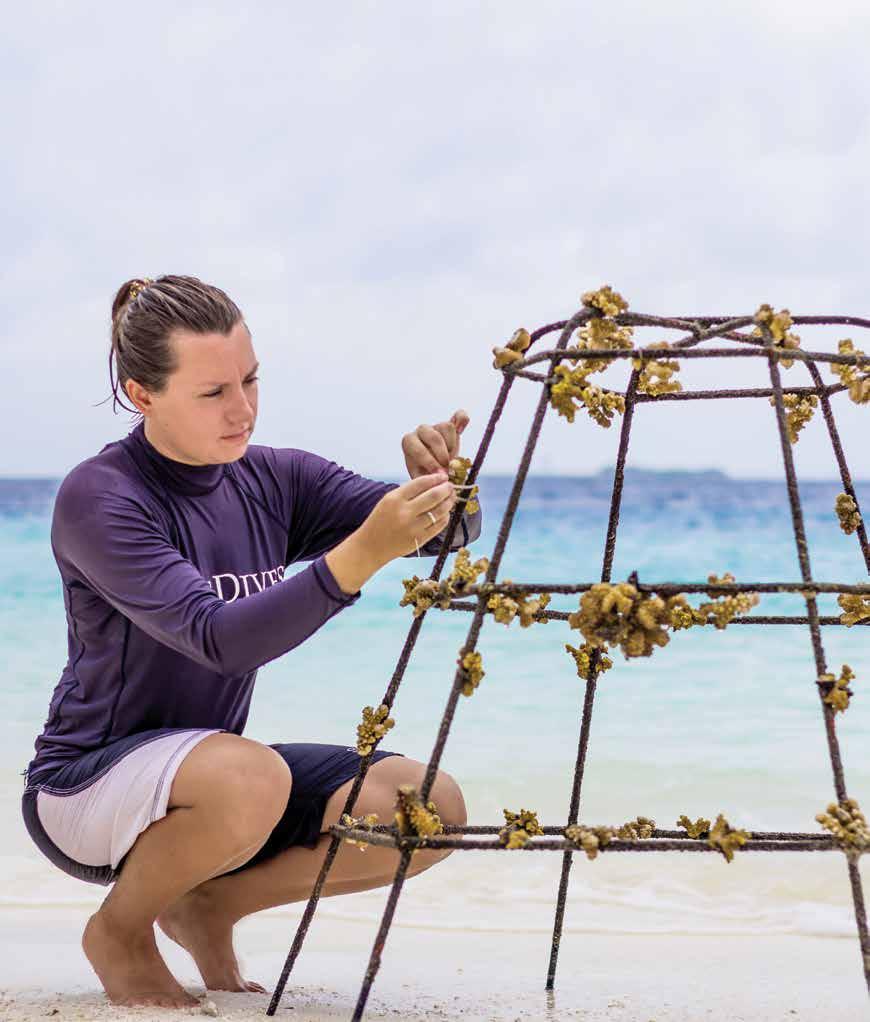 By Deborah Dickson-Smith
CORAL FRAMES AT JUMEIRAH VITTAVELI, MALDIVES
By Deborah Dickson-Smith
CORAL FRAMES AT JUMEIRAH VITTAVELI, MALDIVES
Uluru, the Sydney Opera House, the 12 Apostles, Cable Beach: they’re among Australia’s most iconic landmarks. Yet there’s one site that many believe outshines even these hotspots when it comes to representing Australia on the global tourism stage. And fair enough. The Great Barrier Reef is an undeniable stunner, not to mention a tourism jackpot with more than two million visitors annually, equating to more than A$6 billion.
It’s also dying.
Human influences have resulted in a 50 per cent decline in coral cover between 1985 and 2012. The cumulative effect of climate change, plastic waste, coastal development, fishing and poor quality of land-based run-off is weakening the Reef’s resilience.

Thankfully, the issue isn’t going unnoticed and the tourism industry is banding together in an effort to stall, and even reverse, the damage.
Citizens of the Great Barrier Reef is a new initiative aiming to engage individuals, businesses and communities, and empower them to take part in meaningful projects that deliver genuine results. Spearheaded by CEO Andy Ridley, founder of Earth Hour, the social movement quickly expanded beyond Australian shores, celebrating its global launch in November 2017.
According to Ridley, the initiative will connect people with relevant projects that are already happening or encourage ‘Citizens’ to start their own project, no matter where in the world they are. Ridley says he was inspired by the persistent, but incorrect, rumour that the Reef was dead.
“For me the Great Barrier Reef is the most visual natural icon on the planet,” he says. “It’s sort of a mirror on humanity – on how we all treat the one thing we all share – the planet that we live on.
“What is the greatest threat to the Great Barrier Reef? To me the greatest threat is apathy. People starting to think that the reef was dead, and that seemed to be in some way acceptable, there wasn’t a sense of fight about that. So, I decided to do something about it.”

Regional tourism organisations have been key recruiters in the Citizens campaign, encouraging hotels and tourism operators to become involved, and providing them with a ‘Tourism Toolkit’ to help them educate guests and train staff. The majority of tourism operators in Far North Queensland have signed up as Citizens. Organisers believe going global and, in turn, acting en masse, is the best way to address this immense problem.
Get Involved
To find out more about how to become a Citizen of the Great Barrier Reef, visit citizensgbr.org



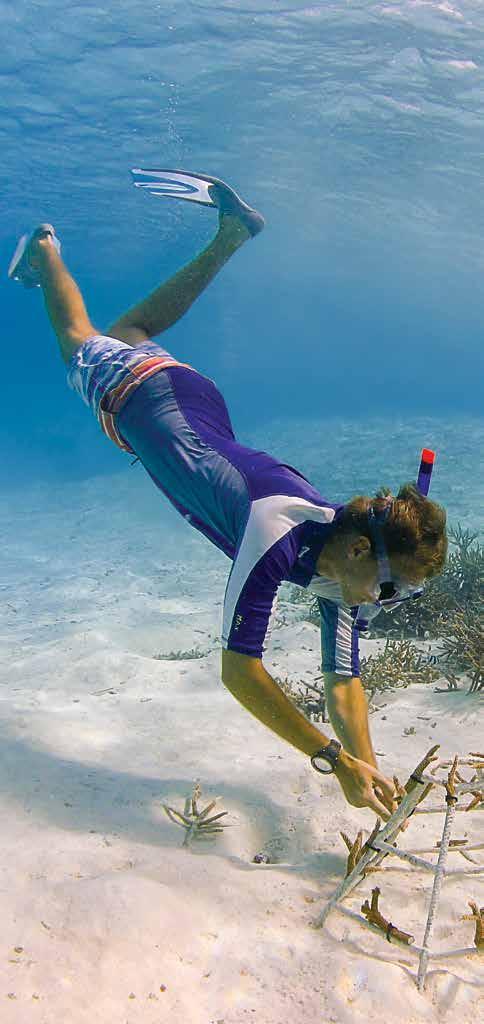 ANANTARA, MALDIVES
ANANTARA, MALDIVES
EXPERIENCE aconscience luxurywith
OCEAN | CONSERVATION
““What is the greatest threat to the Great Barrier Reef? To me the greatest threat is apathy. People starting to think that the reef was dead, and that seemed to be in some way acceptable, there wasn’t a sense of fight about that. So, I decided to do something about it.”


www.luxurytravelmedia.com.au 109
“
Andy Ridley , CEO of Citizens of the Great Barrier Reef
Reefs of the world



Leading luxury brands around the world are working to shrink their environmental footprint through energy efficiency initiatives and improved waste programs. Some however, are doing even more by tackling the impact of climate change on our oceans through education programs, beach clean-ups and local marine conservation projects. And many offer guests an opportunity to get involved
Here are some examples:
Tanjong Jara Resort, Malaysia
With many luxury resorts occupying prime real estate that includes a pristine sandy beach, it’s no coincidence that some have based their conservation efforts around their local turtle nesting sites. Because these nesting sites are close to human habitation, poaching has added a further threat to turtle populations.
Some luxury resorts are doing a fantastic job protecting hatchlings by guarding the nests and educating local communities. The Lang Tengah Turtle Watch Conservation Initiative, supported by YTL Hotels’ Tanjong Jara Resort on the east coast of the Malay Peninsula, is one of those success stories.
Lang Tengah’s Turtle Watch was founded just over one year ago and, so far, the program has saved more than 4,000 turtle hatchlings.
Guests of the resort are invited to attend nest inspections, which are conducted at least once every three days during the peak season (May to October). Those keen to get directly involved can pledge to save a nest through the adoption program. Pledgers receive photographic progress updates and an invitation to return to the resort to witness the hatching of the nests. tanjongjararesort.com
“Lang Tengah’s Turtle Watch was founded just over one year ago and, so far, the program has saved more than 4,000 turtle hatchlings.


Jumeirah Vittaveli, Maldives
Jumeirah Vittaveli’s resident marine biologist educates both children and adults about the importance of coral protection and marine habitats within the framework of the Vittaveli Coral Regeneration Project.

Once a week, kids can take part in a Junior Coral Ranger session, where they learn the importance of conservation in a playful environment and have the opportunity to plant their own coral. Guests can also join the marine biologist for her weekly marine talk or go on snorkelling tours along the house reef where they can observe the progress of their

qualia

The ultra luxe qualia, part of the Hamilton Island group, takes marine conservation very seriously. As well as being a responsible tourism operator, minimising its energy consumption and global footprint as a matter of standard practise, the Hamilton Island group recently teamed up with the Great Barrier Reef Foundation. The partnership enables the Foundation to educate Hamilton’s 200,000 annual guests about marine conservation issues, what the Foundation is doing to address them, and how guests can contribute. qualia.com.au

www.luxurytravelmedia.com.au MIKE BALL DIVE EXPEDITIONS
PIXIE PINNACLE, GREAT BARRIER REEF
“LANG TENGAH TURTLE WATCH
Anantara, Maldives
In the Maldives, the Anantara Group has established a partnership with Coral Reef CPR, an organisation focused on the conservation, protection and restoration (‘CPR’) of coral reefs.

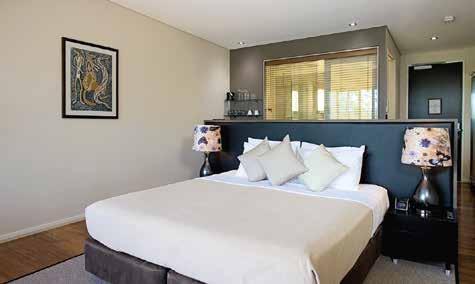
Over the past year Coral Reef CPR has established seven coral nurseries within the lagoons surrounding Anantara Kihavah Villas, and Anantara Dhigu and Veli resorts, with more than 6,000 corals currently being grown.



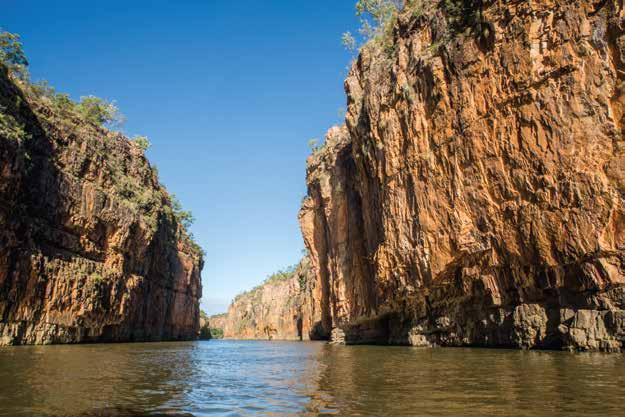
One of their most successful projects is the reconstruction of the reef platform surrounding SEA – the premier underwater restaurant associated with Anantara Kihavah. Since reconstruction, a highly diverse fish community has moved onto the reef, which guests can watch while they eat. A snorkel trail was also established this year, where guests can see more than 60 species of stony corals as well as giant clams, leather coral, anemones and sponges, and more than 80 species of fish. anantara.com/maldives
Four Seasons Koh Samui has also recently launched a similar program. fourseasons.com/kohsamui
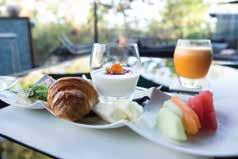


www.luxurytravelmedia.com.au 111
UNDERWATER CORAL FRAMES AT JUMEIRAH VITTAVELI, MALDIVES
Climbing with a conscience
Travellers planning to climb Tanzania’s Mount Kilimanjaro can now ensure the locals assisting them are not exploited. Newly launched booking portal KiliGATE connects travellers with tour companies who comply with the standards set by the Kilimanjaro Porters Assistance Project. The project ensures porters receive a minimum living wage, adequate meals and sanitary sleeping conditions. kiligate.com

Hands-on sustainability at Six Senses
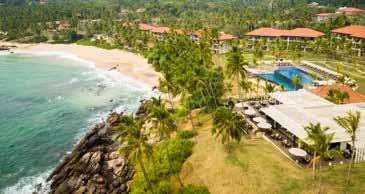
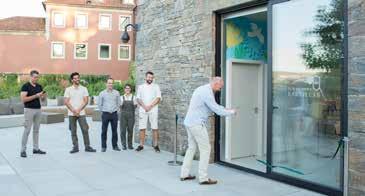

A safe haven for turtles
Anantara Peace Haven Tangalle Resort in Sri Lanka has partnered with the International Union for Conservation of Nature to help protect threatened marine turtles. Five of the world’s seven species of marine turtles visit Sri Lankan shores to lay their eggs and the resort’s beach is a prime nesting ground, meaning the joint initiative could have a substantial impact on turtle populations. As well as protecting turtles, the project will enhance the surrounding coastal habitat for a range of other native species. YTL Hotels’ Tanjong Jara Resort in Malaysia launched a similar initiative last year and has already saved more than 10,644 eggs, with 4,900 turtle hatchlings successfully released into the wild. tangalle.anantara.com
Six Senses Resorts has opened on-site Earth Labs across all 11 of their resorts worldwide, giving guests a chance to learn firsthand about the sustainability efforts of the property they are visiting. Each resort employs different strategies based on their surrounds. Some of the practices include distilling natural insecticides from plants, bottling water on-site and creating plastic-free straws from organic materials. The Labs will also offer DIY classes, teaching guests eco-strategies they can implement at home such as natural toothpaste making. Local community members will also be visiting the Labs to share traditional knowledge and insights. sixsenses.com
112 www.luxurytravelmedia.com.au
ETHICAL TRAVEL NEWS FROM AROUND THE WORLD
NOW BETTER
multi-million
Indulge in our at Meriton Suites Bondi Junction.
dollar, rooftop
Penthouse Collection
Featuring a refresh of the finest of interior furnishings and first class modern facilities, our top floor Penthouse Collection Suites promise the ultimate stay to remember forever.

Showcasing a brand new outdoor entertaining deck in the oversized terrace balconies, these three bedroom suites have been designed with luxury sun lounges and alfresco dining to soak up the famous Bondi weather all day round.
You can experience deluxe services in these large suites with a modernised kitchen, unlimited free Wi-Fi, Foxtel IQ channels displayed on 75” flat screen TVs and a turn down service to ensure the utmost in comfort.
To discover why we’re famous for our larger suites and exceptional value for money, please call our Australian based reservation hotline on 1800 214 822, or visit meritonsuites.com.au
Serve & Protect
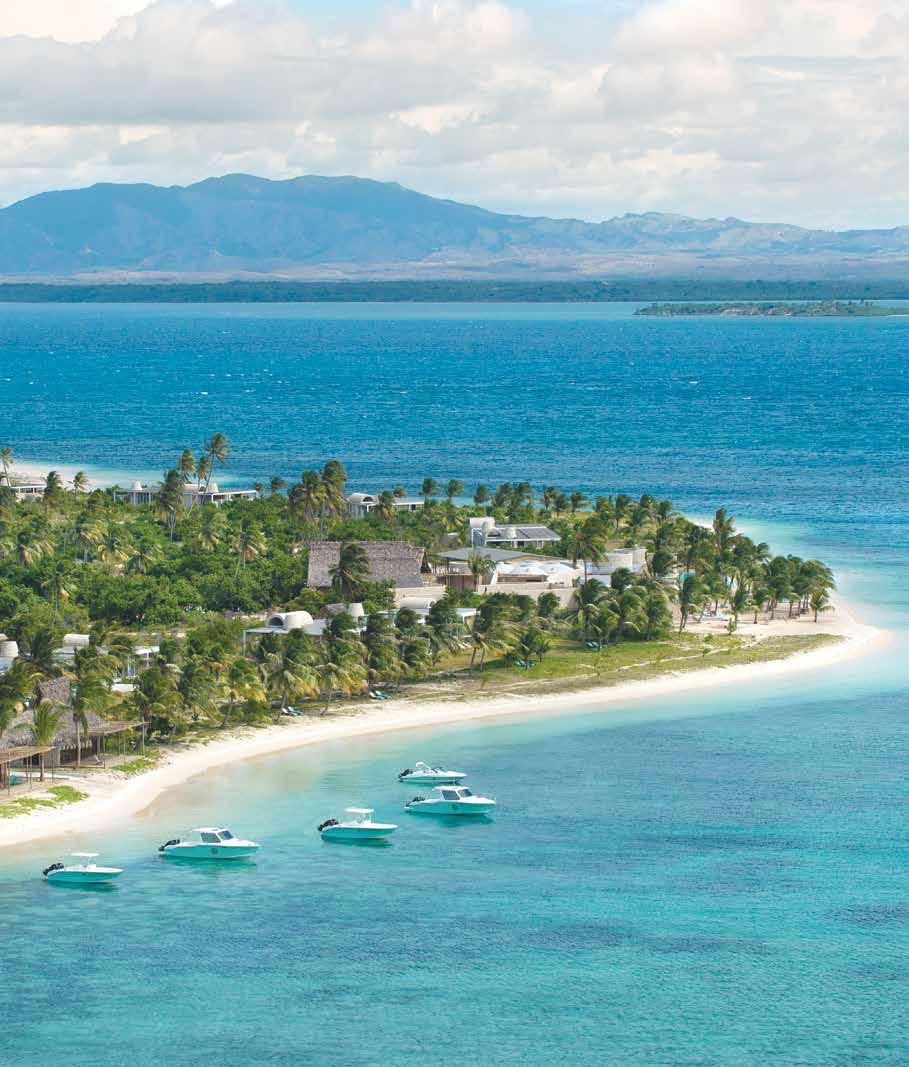
114 www.luxurytravelmedia.com.au
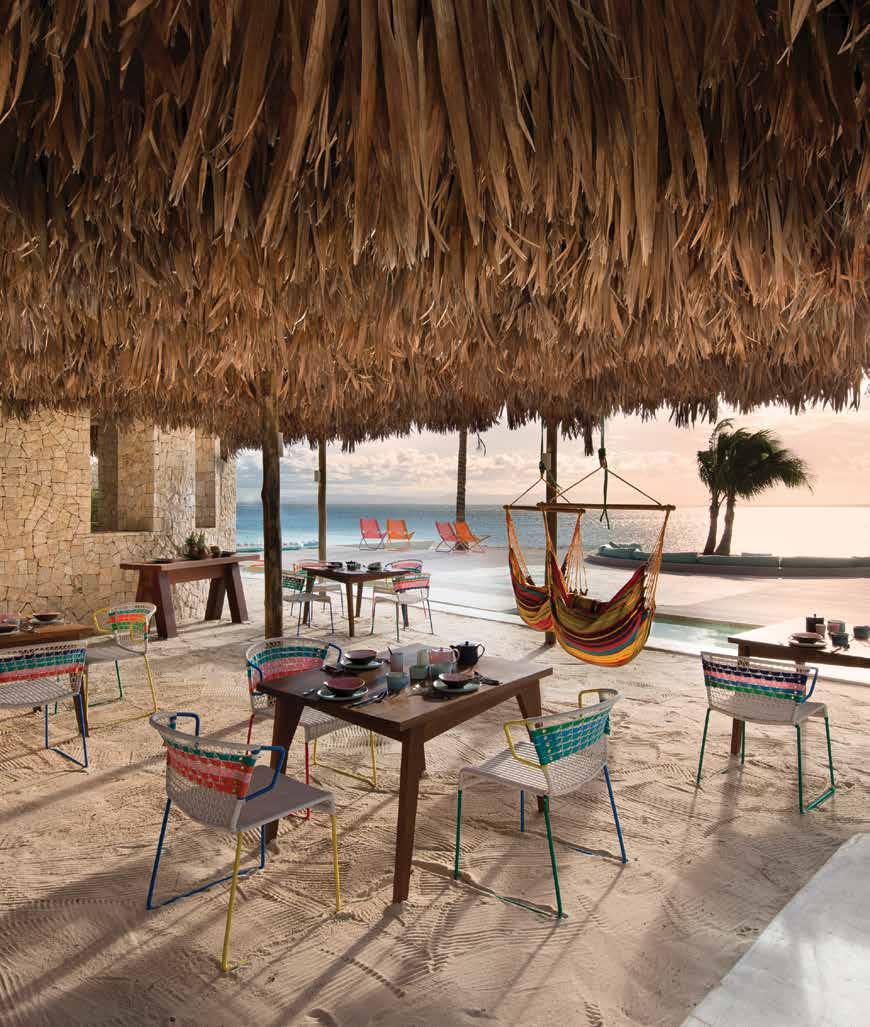
BEACHFRONT DINING
SAFARI | MADAGASCAR
Mary Holland visits Madagascar’s new luxury safari lodge, Miavana, and finds the commitment to luxury matched by a commitment to conservation.
During the hour-long helicopter ride from Nosy Be to the island of Nosy Ankao, off Madagascar’s northeastern coast, the landscape shifts swiftly and seamlessly from palm-fringed beaches and azure waters to mangroves, limestone chasms and neat farmland. Every time I peer down, a new terrain seems to drift below me. As new as it is to me, there is also something familiar about it. At times there are hints of Mauritius’ recognisable white beaches and sapphire water while at other times I’m reminded of South Africa’s mountainous Western Cape, the familiar peaks rising in the distance. Then there are times it is completely unfamiliar: a dense jungle with unreachable pools of water crawling with mangroves – something that, up until now, I’d only seen in Jurassic Park
When I land on Nosy Ankao, it feels as though I’ve seen one hundred slices of Africa all muddled into one. Not surprising, considering Madagascar has long fascinated naturalists with its varied and fanciful landscape and distinctive flora and fauna. As I climb out of the helicopter onto the velvety beach of Nosy Ankao, I’m met with a team of staff clad in white and turquoise linen garb, one man holding a tray of icy drinks and chilled towels. I glance at the pearly stone hotel buildings behind him and the glistening pool that overlooks the beach. Could this be a five-star property in the Seychelles? (Considering the architects behind the hotel built another property in the Seychelles, it certainly could.) “Welcome to Miavana,” says the general manager, with an ease that can only come from someone living on a tropical island. The new gem of the Indian Ocean, Miavana is a 14-villa, five-star paradise strung along a secluded beach on an almost-untouched island. It is the first and only property of its kind in Madagascar in
that it isn’t only committed to five-star luxury, but also to protecting and preserving a small slice of Madagascar – a country which has been ravaged by deforestation, poaching and overfishing.
If the landscape doesn’t convince you Madagascar is a very special place, the country’s uncharacteristic animals certainly will. Eighty five per cent of the wildlife and flora on Nosy Ankao is endemic, and the surrounding sea is swarming with tropical fish (which can be explored by snorkelling or scuba diving – both available on the property). On nearby Cap du Diable Island, a brief helicopter or boat ride away, lemurs can be found scuttling through the trees, their bright, watchful eyes darting from branch to branch. They are quick and nimble, and although easy to spot, impossibly hard to follow. Much like the rest of Madagascar’s wildlife and nature, lemurs are at great risk. “We have permission to reintroduce lemurs onto the Nosy Ankao,” activities manager Wayne Haselau tells me one evening as I enjoy a gin and tonic while watching the deep orange sunset over the iridescent blue ocean – a sunset that will surely ruin all others for the rest of my life. Haselau is unequivocally passionate about ecology and his enthusiasm is palpable. He took the job at Miavana with his sights on helping reintroduce and preserve local wildlife, much of which is bordering on extinction.
The next morning I am scheduled to meet Haselau for a walk in the beach flats. I wake early to the overwhelming sound of the ocean lapping the nearby shore, and curl from my private villa like a Disney princess. Dawn has just broken and the rosy morning light is attempting to break through the dense clouds. When I walk out onto the beach, there is not a single soul, just fishermen casting their nets in the ocean and hundreds of crabs shuffling across the sand. By the time I meet Haselau, the sun is up and
the ocean is glistening in the light. Haselau walks me through the shallow waters, pointing out tiny creatures that would otherwise go unnoticed. His enthusiasm is so contagious that I follow his movements unknowingly, quickly finding myself ankle deep in water, my toes squelching through my socks and sneakers. Even though the tiny fish and worms we see in the flats are inconspicuous, they play a vital role in bringing back other marine wildlife. Haselau points to a small green sprout that is shooting through the water. To me, it looks like a regular plant, but to him it signifies something great. “This must be the island’s first mangrove!” he declares with glee. I look down at the tiny shoot muscling its way through the water; clearly the team’s hard work at restoring the fragile ecosystem is paying off.
Flying out from the island, over the lodge which I’ve called home for a few days, I see the now-familiar forest of mangroves surrounded by dense jungle. I imagine this is what Haselau hopes to see off the coast of Nosy Ankao in years to come. The one small shoot we spotted might be far removed from the dense winding forest I see below me, but everything has to start somewhere. And why not now with Miavana?
See more images from this story at luxurytravelmedia.com.au
Stay

Rates start from US$2,500 (about A$3,196) per person per night. This includes all meals, select bar drinks, laundry, selected activities and use of an electric buggy per villa. Helicopter transfers cost an additional US$700-2,400 (about A$894-3,068) per person for a return flight to the closest two airports. timeandtideafrica.com/miavana

116 www.luxurytravelmedia.com.au
EXPERIENCE
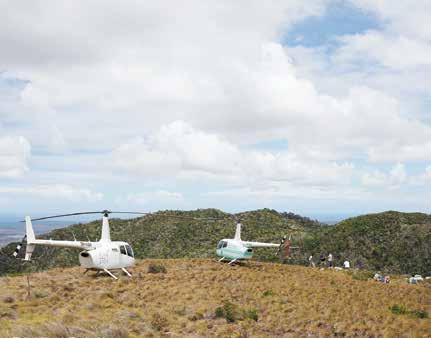
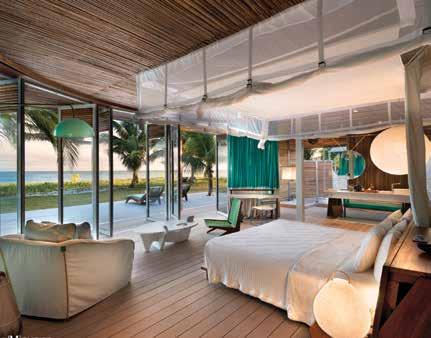
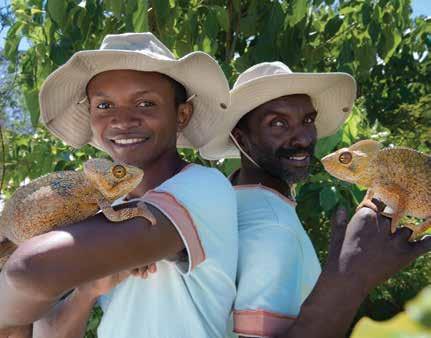
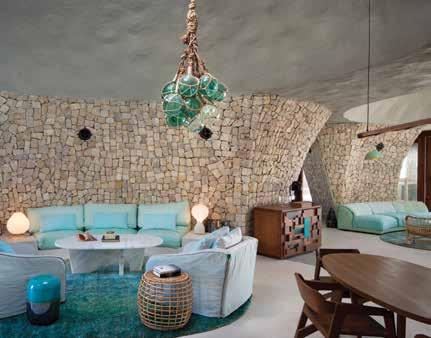
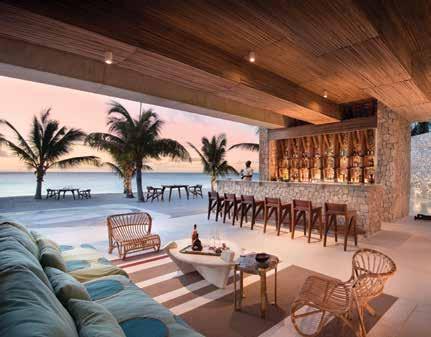
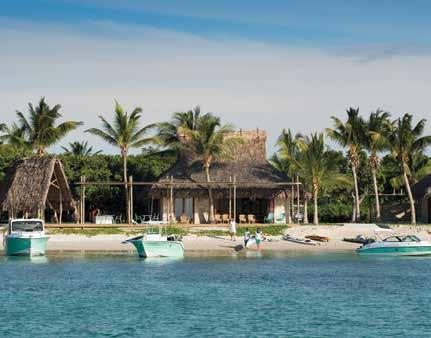
The white stuff

Niseko’s stocks are rising in the hearts and minds of snow-loving travellers. Gary Allen heads to the Hokkaido Island resort to find out why.
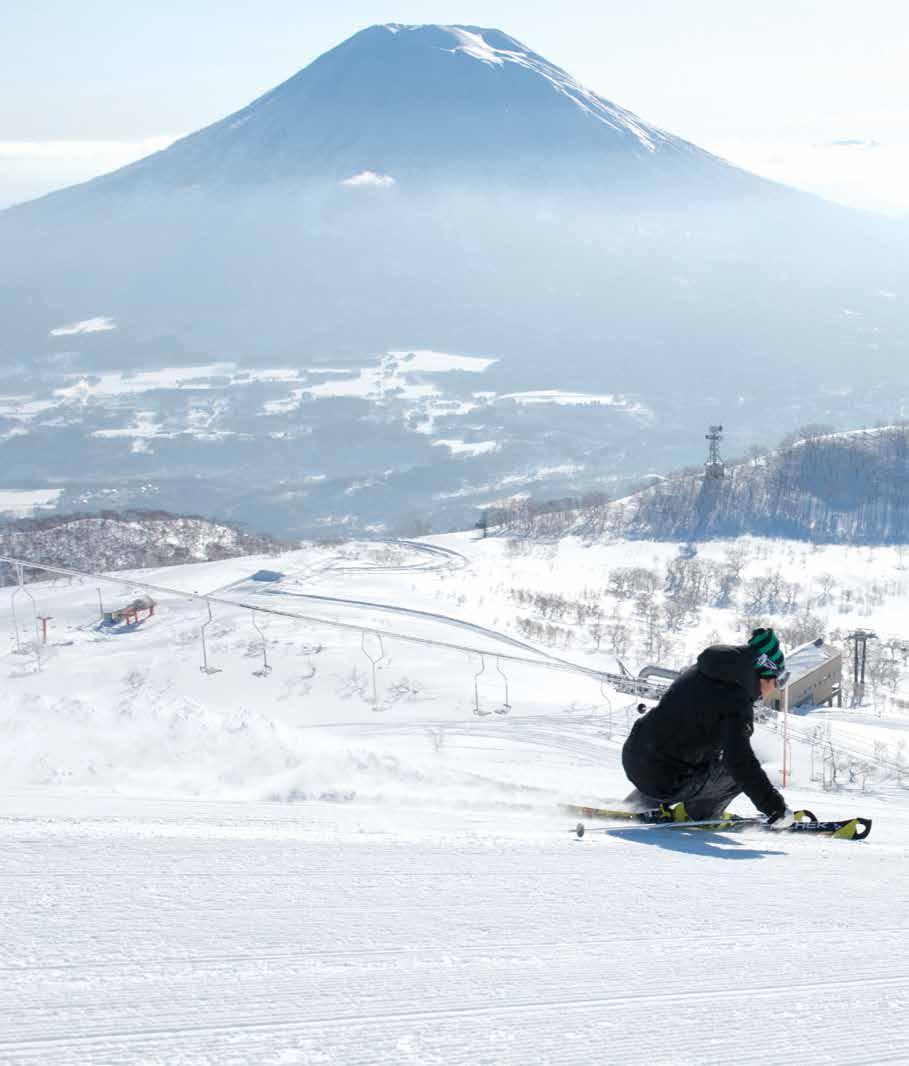
JAPAN
HOKKAIDO
NISEKO
SKI JAPAN EXPERIENCE
K“onnichiwa!” says the young Japanese girl as she greets me with a big smile and asks for my skis. She expertly places them in the storage slots on the side of the gondola and gestures for me to climb in. “Have a nice ski,” she says with a slight bow and a wave as I’m whisked off up the mountain. I’m skiing at the Japanese resort of Niseko, located just over 1,000 kilometres north of Tokyo on the island of Hokkaido.
Niseko is world-famous for its powder, with up to 14 metres of some of the world's driest and lightest snow falling here each year. The prime alpine terrain and perfectly groomed runs consistently offer skiers and snowboarders fresh fluffy powder throughout the colder months, stretching from November through April. On top of all that, Hokkaido is a favourite destination of Japanese foodies for its abundance of seafood, huge variety of fresh produce and
water sourced from pristine natural springs. It even has its own signature ramen dish and is the home of Sapporo Beer. What more could you ask for?
Traditionally, Australian skiers heading to Japan would stay in the village of Hirafu, known for its high-end homes, stylish condominiums and buzzing nightlife. Now, the action has moved south to Niseko, thanks largely to the investment of Malaysian conglomerate YTL. Niseko Village is now a luxurious and uniquely Asian one-stop destination for snow enthusiasts from around the world. And for good reason: Niseko delivers the perfect balance of authentic Japanese culture and architecture alongside luxury accommodation, contemporary dining and high-end stores.
There are three main accommodation options in Niseko: Hilton Niseko Village, The Green Leaf Niseko Village, and the new Kasara Niseko Village Townhouse. All fall under the YTL umbrella. Kasara’s contemporary alpine townhous-
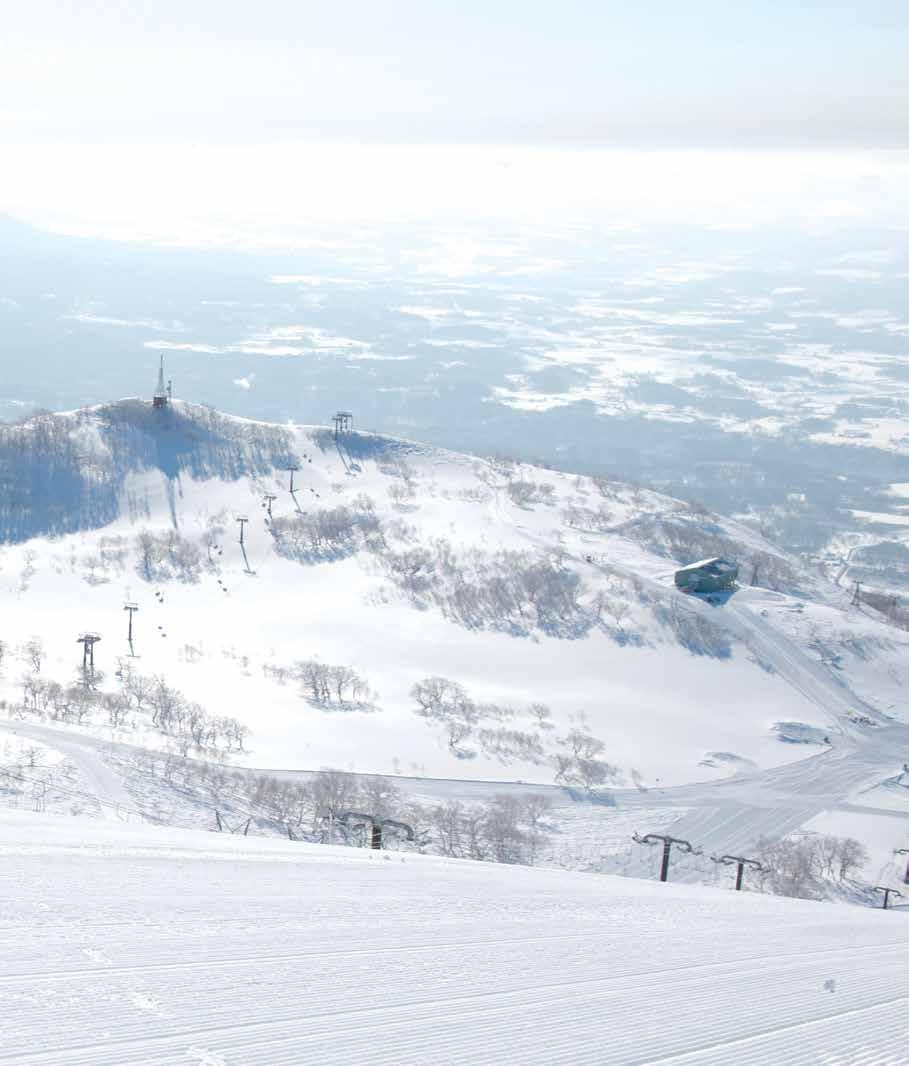
www.luxurytravelmedia.com.au 119
es are perfect for families or groups, with three bedrooms, butler service, and driver and in-residence chef options. Ski rentals are available in the lodge along with lockers for storing your gear. The townhouses sit just 50 meters from Green Leaf and are a true ski-in/ski out experience.
The Niseko Village Snow School has great programs for both adults and kids, with group or private lessons and multi-lingual instructors. Pick up is possible from any of the hotels in the village, making for a quick getaway straight after breakfast. Night skiing is also available for those with an appetite for more hours on the mountain. An extensive area is floodlit until the final lift run at 8.30pm and visibility can sometimes be even better than it is during the day. There are night runs for everyone from beginners to experienced powder hounds.
Gondolas link Kasara and The Green Leaf to the new village area where you’ll find authentic Japanese restaurants, like Crab Shack and Two Sticks, and high-end stores selling locally made goods such as premium leather from Hokkaido and glass works from Otaru. Don’t miss taking the gondola to the Hilton to experience the hotel’s excellent teppanyaki restaurant. The gondolas can also be used after dark to access village bars and restaurants, eliminating the worries of finding a cab or having imbibed too much sake. Just a short walk (or shuffle) to the gondola and you’re on your way with a good dose of crisp air before bed.
Onsens are an integral part of life in Hokkaido and after a day of skiing in the cold, there’s nothing better than a long soak in the steaming
“
Niseko Village is now a luxurious and uniquely Asian onestop destination for snow enthusiasts from around the world.
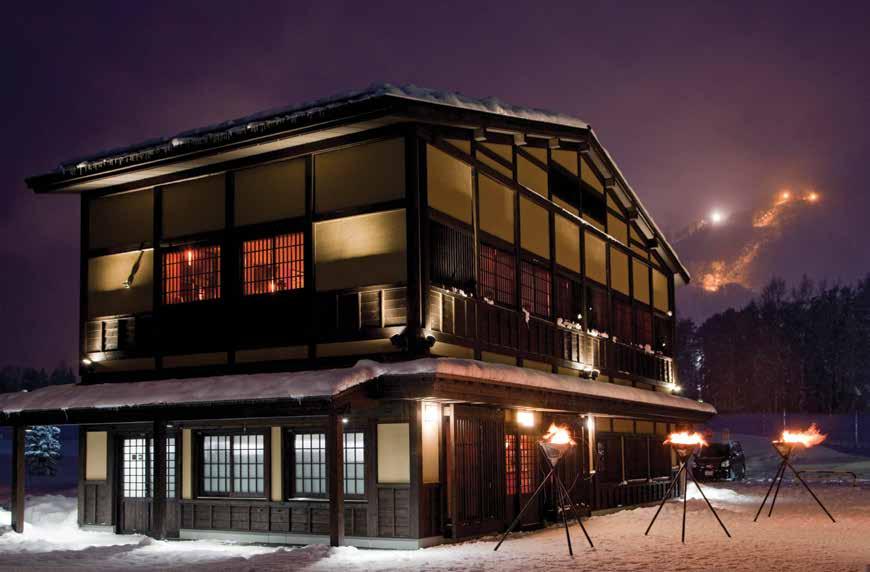
water. The onsen is one of Japan’s most iconic experiences and one you will continue to crave long after your departure. The Green Leaf has one of Niseko’s most picturesque onsens, a natural rock pool surrounded by snow-covered pine trees and filled with spring water naturally heated to 40°C. It’s also open to guests staying in the Kasara townhouses. If you’d prefer to experience an onsen like a local, ask about the Yuki Chichibu, just a short drive from the village.
You don’t have to ski every day and may even welcome the chance for some muscle recuperation. In which case, one activity to add to the list is a snowmobile tour. The whole family can enjoy this exhilarating off-road guided tour, a fun and unique way to see the landscape.
There are extensive plans for the future development of Niseko Village, with a Ritz-Carlton Reserve and other prestigious names proposed. That said, the resort is committed to retaining its cultural identity, with emphasis placed on the inclusion of architecture specific to Japan and, in particular, the mountainous Hokkaido region.
Stay
Townhouses at Kasara Niseko Village are priced from JPY95,760 (about A$1,100) per night. A three-night minimum stay is required from December to April. kasara.com/nisekovillage

120 www.luxurytravelmedia.com.au
NISEKO VILLAGE
“
These chalet-inspired residences are set in the middle of Hirafu Village against a backdrop of silver birch forest. Apartments range from compact studios to vast four-bedroom penthouses with bunk rooms (or staff quarters), full kitchens and a private driver. The concierge can arrange to have the pantry stocked with groceries before you arrive. Special touches include underfloor heating, a boot warmer in the drying room, an on-site beautician, and a small cigar and wine room in the top two apartments.
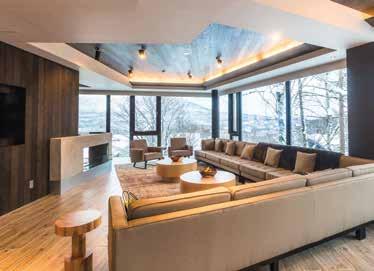
Platinum Pro
Skiers looking for a new challenge can sign up for Platinum Pro, privately guided backcountry tours operated by Niseko Base Snowsports (NBS). The full-day tours can be customised for skiers of all abilities, giving beginners an introduction to off-
A 10-minute walk from An’nupuri base, this sleek five-star apartment block has been named Kamui, which describes a spiritual or divine being in Ainu, the language of Hokkaido’s indigenous people. Designed to reflect the winter landscape, the apartments, which span from a studio to a four-bedroom penthouse, have been outfitted in natural tones with wood panelling and floor-to-ceiling windows with views of Mt Yotei. On site there is a concierge service, dedicated ski storage area for each unit and Michelin-star sushi restaurant, Sushi-Shin.
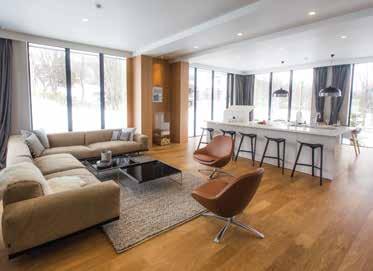
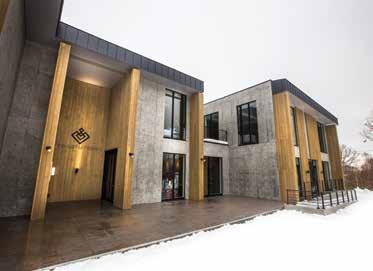
Contact
For more information and room bookings, visit SkiJapan.com
piste skiing or taking experienced skiers to the best terrain the mountain has to offer. Groups are limited to a maximum of five skiers and safety is a priority, with each person given their own avalanche pack including a beacon, probe and shovel.
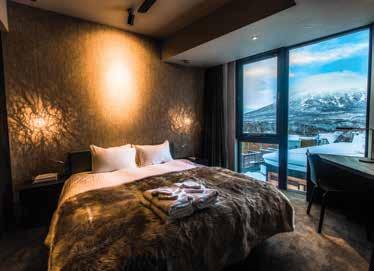 The Kamui Niseko
Haven Niseko
The Kamui Niseko
Haven Niseko
www.luxurytravelmedia.com.au 121 LUXURY TRAVEL SKI NEWS WHAT’S NEW IN NISEKO
Open 2018 Australian

Award-winning sports reporter Linda Pearce has covered more than 50 tennis Grand Slams throughout her career. She lets us in on the VIP offerings at next year’s Australian Open.
Some sports are best served live and tennis is one of them. Television cannot quite capture the force of the shot-making, the subtleties of the spins and angles, the sound of ball on racquet, and the athleticism and commitment of players locked in gladiatorial combat, when so much is at stake. On court, there will be A$55 million in prizemoney to play for in 2018, but much more goes on the line in terms of achievement and prestige.
The closer the vantage point, the better, which is what helps to differentiate the latest Australian Open fan experience at an event that has long ranked as a player and media favourite. “The Happy Slam”, Swiss legend Roger Federer once called it, and, as the five-time winner and defending singles champion, well may he smile.
But what’s not to enjoy? Each January, local and international visitors descend on Melbourne at the height of summer, sharing in the relaxed holiday vibe and celebrating the annual pilgrimage of the biggest names in the game.
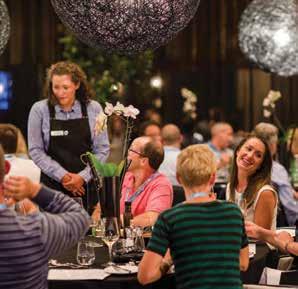


There’s a ticket to suit everyone, ranging from the popular ground passes to the burgeoning VIP packages. And just as the Melbourne Park site itself has been undergoing the most extensive upgrade in its 30-year history, as part of the A$338 million stage-two redevelopment that will transform player facilities, there will be more to offer patrons with five-star tastes.
No longer is there a one-size-fits-most approach; since 2016, the focus has been on a more bespoke guest experience. Hospitality options can be designed for every budget and priority. Fancy sitting on the court, just metres from the players, while enjoying world-class food and beverages? You can.
The courtside view provides remarkable intimacy. Comparable, perhaps, to a ringside seat at a world championship boxing bout, except there are just 12 seats available, all in the southeast corner of the main court, Rod Laver Arena (RLA). Like at a title fight, though, there will be dancing feet, flying sweat and, at times, raw emotion. Try looking away.
Debuting at this year’s Open, the On Court Seating experience is unique in the world of tennis and was enjoyed in January by the likes of models Karlie Kloss and Jessica Gomes, former Australian cricket captain Ricky Ponting, Australian NFL star Brad Wing, and a roll call of local celebrities. Included is access to the Dressing Room, an exclusive backstage space previously used by Rod Laver Arena’s artistic alumni including the Rolling Stones, Pink, Bruce Springsteen and Justin Timberlake.
As far as entertaining goes, guests can play host in a courtside Superbox, serviced
: www.luxurytravelmedia.com.au 122
MAIN EVENT
NEALE COUSLAND / SHUTTERSTOCK.COM
by dedicated staff throughout each session. Or finish the day dining on the Hisense Arena court surface, where guest appearances by former greats are among the added extras.
More private is The Green Room, where a select few fans can witness the pre- and postmatch action, including the players’ first steps along the Walk of Champions, a hallway lined by a photo gallery of the past winners whose deeds they seek to emulate.

Then there’s the exclusive sanctuary known as The Lounge, complete with grazing buffet,
Experience
• Rates for On Court Seating start from A$1,500 per person per match.
• The Rod Arena Superbox is priced from A$8,640 for 18 guests.
• On-court dining at Hisense Arena starts from A$1,300 for the Show Court Finals. Rates start at A$2,700 for the finals weekend.
• The Green Room experience starts from A$490 per person, including a Category 1 Rod Laver Arena ticket and all food and beverages.

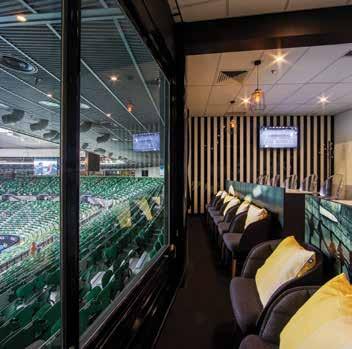
drinks and private access to RLA; the sophisticated Trophy Club, which combines exceptional service with balcony views overlooking Garden Square and private entry to RLA; or Encore, your own room in the heart of Melbourne Park.
Meanwhile, pop-up restaurants by acclaimed Rockpool Dining Group and Nobu are among the 2018 additions to a food and beverage honour board that already boasts some of Melbourne’s finest: Gazi, Huxtaburger, Estelle by Scott Pickett, Hotel Jesus, Tokyo Tina, Jimmy Grants and Maha.
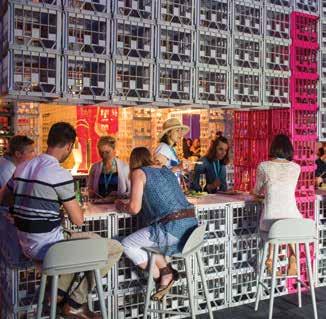
Clearly Melbourne Park plans to celebrate its 30th birthday in style and, in turn, the Happy Slam will make a happy return in 2018.
• Access to The Lounge starts from A$380 per person, including a Category 1 Rod Laver Arena ticket and all food and beverages.
• Access to the Trophy Club starts from A$490 per person, including a Category 1 Rod Laver Arena ticket and all food and beverages.
• Access to Encore starts from A$480 per person, including a Category 1 Rod Laver Arena ticket and all food and beverages. ausopen.com
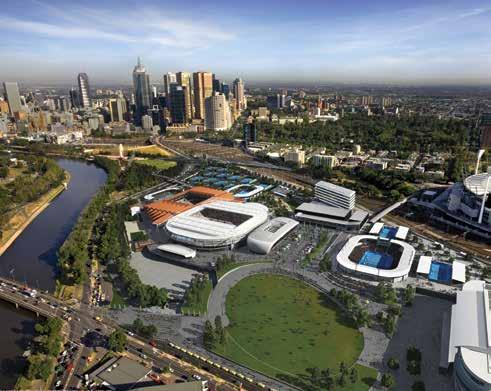

www.luxurytravelmedia.com.au 123
MELBOURNE PARK FUTURE DEVELOPMENT
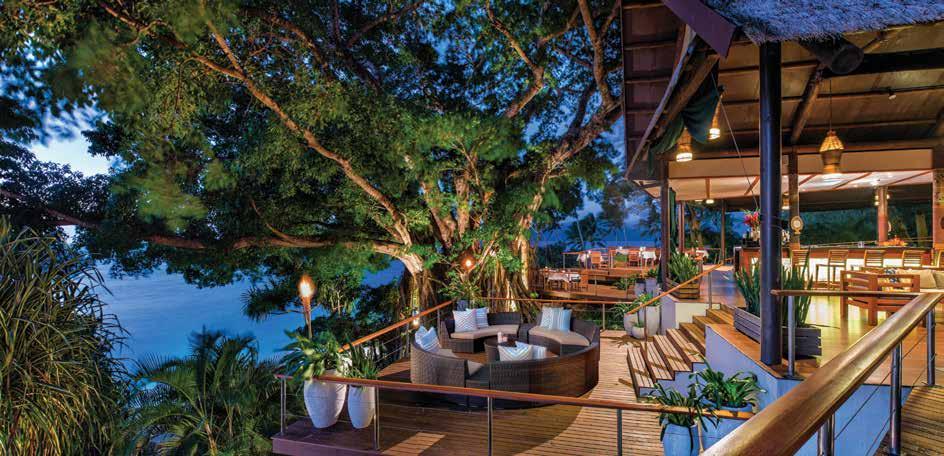

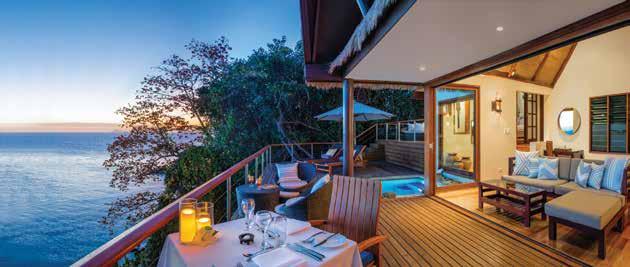

Fijian Barefoot Luxury At Its Finest Private | Exclusive | Adults Only royaldavuifiji.com | res@royaldavuifiji.com

www.luxurytravelmedia.com.au 125 126 Wellness | Ananda in the Himalayas 131 Brain health | Amatara Wellness Resort 134 Q&A | Wellness tips from Kamalaya's founder 136 Health & wellness | News & beauty travel tips 139 Spa review | Emirates One&Only Wolgan Valley RENEW
In good spirits
For calm and clarity, where better to visit than the world’s meditation heartland?
Katie Milton checks in to a Himalayan wellness retreat, and checks out with a new-found sense of serenity.
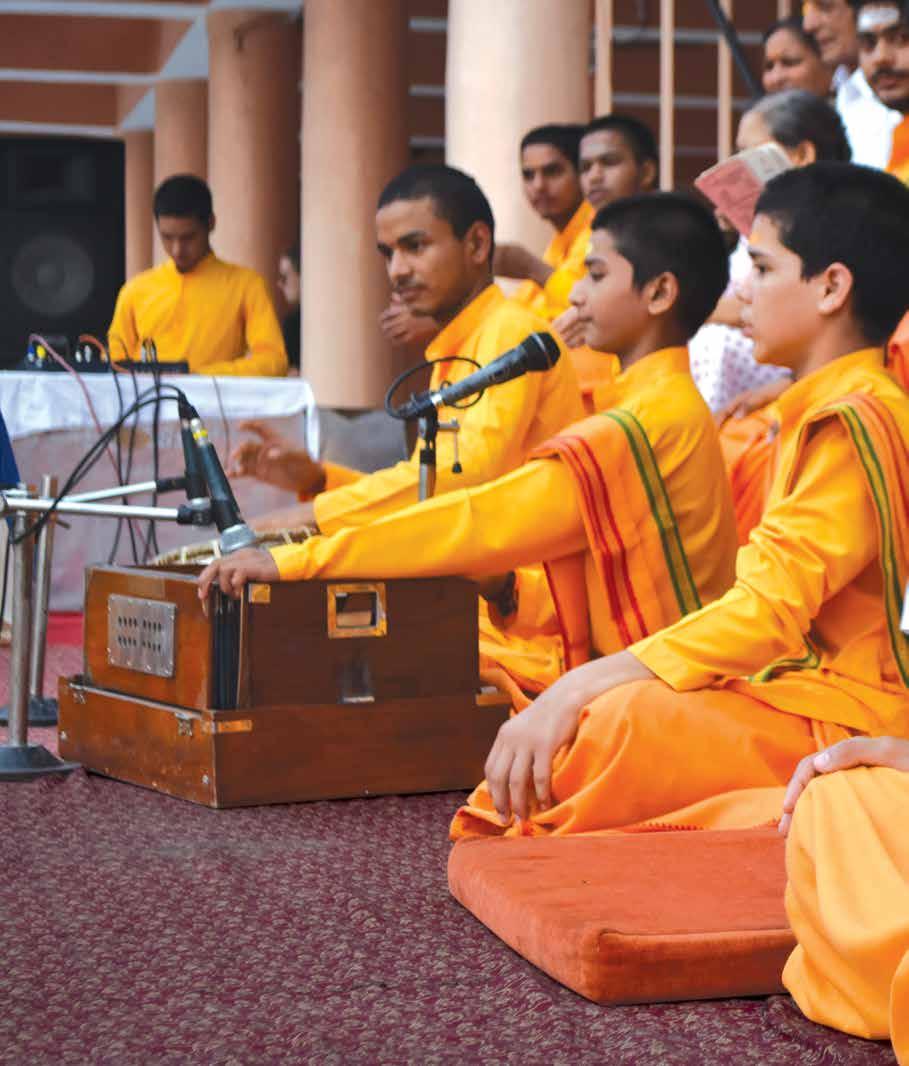
126 www.luxurytravelmedia.com.au
To relay the effects of my time at Ananda in the Himalayas, I have to begin at the end. Sunset is approaching and our driver has chaperoned us down the winding Himalayan hills and into the busy streets of Rishikesh. The great Ganges flows through the centre of the city, a place renowned as a spiritual and religious hub since ancient times, and now more frequently known by Westerners as a site for yoga and ashram retreats. Tonight, motorcycles zip past, beeping loudly, and fresh cow dung spoils the ground as we make our way across the bridge to the Parmarth Niketan ashram to watch the traditional aarti ceremony. When we arrive young boys in orange robes the same colour as the sinking sun are seated around a fire on the banks of the Ganges, performing devotional chants to the beat of the tablah. Women in pavadas (half sarees) with choli tops rise and begin circling their hands and moving their hips to the beat. Soon after, older boys begin to pass aarti lamps through the crowd, recipients circling the flames above each other’s heads before passing it along to their neighbours. The singing quietens, sunset fades and I’m left with a feeling that I can’t put into words.
At the top of a perilously winding road in the Shivalik foothills, a 40-minute drive from Rishikesh, behind a set of grand entrance gates stands a yellowing palace. The monkeys have grown bigger the higher up the mountain we’ve come and a group of wolf monkeys’ masked eyes fix on us as we enter the grounds. Black birds ominously circle the top of the old palace, moss climbs the walls; two rusted canons either side point outward as though ready to fire; and at the top is a clock with rusted hands permanently frozen at five minutes to four.
This 19th century palace, once home to the Maharaja Narendra Shah, acts now as the façade for five-star health and wellness retreat Ananda in the Himalayas.
We are welcomed into The Palace, a restored annex that was added to the original building in 1910 to accommodate the Viceroy and his entourage on visits to the village, and are gifted a red mala (string of beads used in medi-


www.luxurytravelmedia.com.au 127
ANANDA
INDIA RENEW AARTI IN RISHIKESH KRISTEN JEFFERY
tation practice). The remaining rooms, among them the Viceregal Suite, which features a four-poster bed as old as the palace itself, are now used for classes led by visiting spiritual teachers and practitioners. Like its lodgings, the foundations of Ananda’s treatments are ancient, delivering guests a range of health and wellness programs rooted in Ayurvedic philosophy. Ayur (systems of life) veda (knowledge) is an Indian health practice that traces as far back as 5,000 years to the great rishis of India who, through a life punctuated by deep meditation and other spiritual practices, came to produce the Veda of Knowledge, which contains various disciplines for leading a healthy and enlightened existence.
All of Ananda’s programs are tailored to each individual. On arrival, guests are categorised into one of the three doshas (ayurvedic body types); vata, pitta or kapha. Along with each dosha comes a specific disposition, and these qualities will dictate each guest’s diet for the duration of the visit, all undertaken in the hope of balancing the dominant characteristics of each dosha. Pitta dosha, for example, controls digestion, metabolism and energy production, and is associated with fire and anger. So those with a pitta dosha should spend time in cool surroundings and avoid spicy foods such as chillies.
The retreat’s most popular offering is the
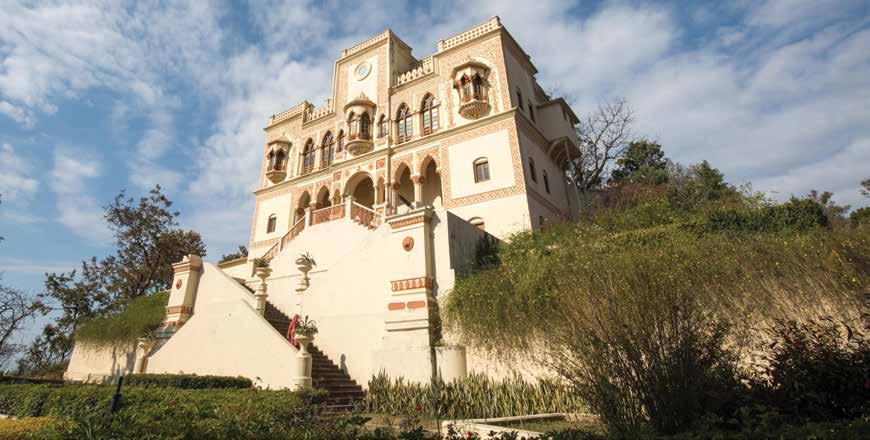
weight management program, running for 14 nights. But for the next few days, relaxation is my priority so I have checked myself in for the Himalayan Bliss Package, a three-night all-inclusive program that comes with freedom of diet, whole-body spa experiences, and an introduction to meditation practice. Once we’re handed the week’s activities schedule, filled with group fitness classes, morning walks, yoga classes, and antar mouna (inner silence) meditation sessions, we climb aboard the buggy and are driven down a steep path edged by perfectly manicured gardens leading to the retreat’s facilities. Peacocks roam the grounds; a six-hole golf course weaves through the trees; and other guests, dressed entirely in white, meander along the paths.
The accommodations are housed in one building, which feels more like a private hospital than a mountaintop retreat. Each room is identical in size and services; the only thing that changes is the view. Our room is in the highest category and has a small balcony that faces directly toward the mountains. We enter the walk-in wardrobe to find a pair of white kurta pyjamas waiting, the same attire we’ve seen on the passing guests. This becomes our uniform for the duration of our stay; a new set ironed and hung in our wardrobe at the start of each day, along with a morning serve of lemongrass and ginger tea.
The multi-level spa sits at the heart of the property. In the centre of the relaxation area is a circular water feature filled with segmented pools of water and different coloured stones. The spa attendant tells me this is a knee pool for self-reflexology. The white and grey stones are taken from the Ganges and used to target pressure points on the soles of the feet to stimulate the entire body, the different sections holding hot and cold water to maintain and balance different doshas.
On the journey to my treatment room we pass a sitar player atop a staircase, his strings reverberating through the hallways, and past glass alcoves towering with bamboo that house small shrines. Each spa treatment begins with aarti, the circling of a copper plate bearing a representative of each of the five elements above my head.
Ananada takes a holistic approach to beauty treatments with an emphasis on long term healing as opposed to quick fixes. Using locally grown ingredients they make all of their own products. The Wild Salt Rose body scrub is made from wild rose grown in the Himalayas, picked and then blended in natural sea salt from India.
I become familiar with more of these organic remedies when I have the Himalayan Honey and Rose Facial. The treatment begins with a honey and rose oil massage, using
128 www.luxurytravelmedia.com.au
THE PALACE FAÇADE
honey harvested from farms on the outskirts of Dehradun. It’s completely pure, apart from being mixed with a few drops of rose oil. Honey (one of the best natural antiseptics, as my therapist tells me) is left on my face for a little more than five minutes so my pores will absorb it. Delicately, the therapist covers my entire face and neck with thin slices of locally grown cucumber silica, which will tighten, tone and firm my pores. This is followed by a sandalwood and rose moisturiser; the sandalwood is crushed with locally grown aloe vera and milk right before the treatment. The
treatment finishes with a spray of mist made from distilled rose oil extract. The perceptible tightness of my pores post-treatment is testament to Ananda’s natural approach.
Where the retreat truly separates itself, however is the strong meditation element incorporated into guest programs. I have never been able to relax my mind in meditation. I am fidgety and find it hard to silence my thoughts. At Ananda, the six yoga teachers, all graduates of the Bihar School of Yoga and then trained by Ananda’s head yoga tutor Sandeep Agarwalla, teach the traditional practices. I find myself
blushing when Sandeep speaks of the way Western varieties of yoga are the antithesis of these, my mind flashing to my perfectly heated studio practice in Sydney, accompanied by a steady electronic soundtrack and yogis in activewear. He tells me yoga should not be seen as a physical fitness; rather it is an original way of connection to the self, a union of the physical, mental and spiritual. The ultimate aim is to go beyond the mind. The hatha flow then, is “a series of postures, breathing and cleansing techniques to prepare the body for higher practices”.
Guests on longer programs can add a range of cleansing practices to their yoga routine, but as mine is a relaxation-based itinerary, I begin with an introduction to meditation. Yoga Nidra is the practice of relaxation; it starts with the taking of a positive resolve, or a goal, and Sandeep tells me to plant this seed in my consciousness. Lying down, I close my eyes and he continues to guide me through body awareness, breath, and simple visualisations until he tells me to repeat the resolve, planting it in my subconscious now that I am disconnected from my external environment. In that state of relaxation, haphazard images flash through my mind, and when he tells me to come back to my body, I hear the sounds of trickling water again and I notice the rise and fall of my chest. And when I open my eyes, it is as if I had been dreaming, those fleeting images slipping away as I try to recall them. But the calm and the stillness remain, and it is this ineffable feeling that I hope I can hold on to when I return home.
See more images from this story at luxurytravelmedia.com.au
Stay

Rates for the Himalayan Bliss package start from US$600 (about A$783) per night plus taxes for a single in Deluxe Valley View room. Standard package inclusions are a Wild Rose Salt Scrub, Swedish massage, Himalayan Honey and Rose facial, Yoga Nidra session, daily breakfast and dinner, and scheduled wellness activities. anandaspa.com
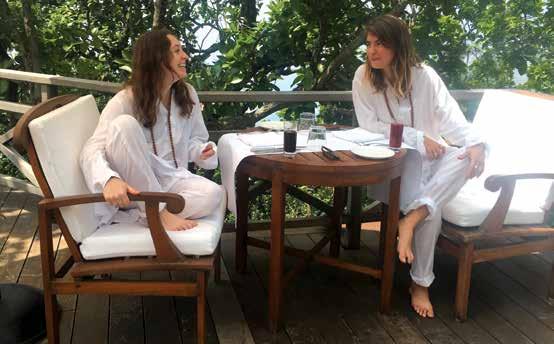
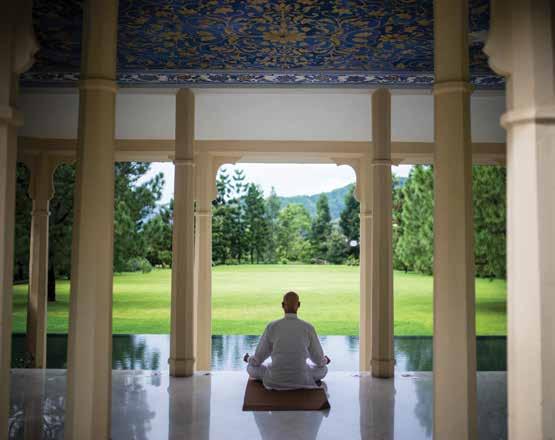
www.luxurytravelmedia.com.au 129
KATIE & KRISTEN AT BREAKFAST ON THE TREE TOP DECK
YOGA IN THE PAVILION
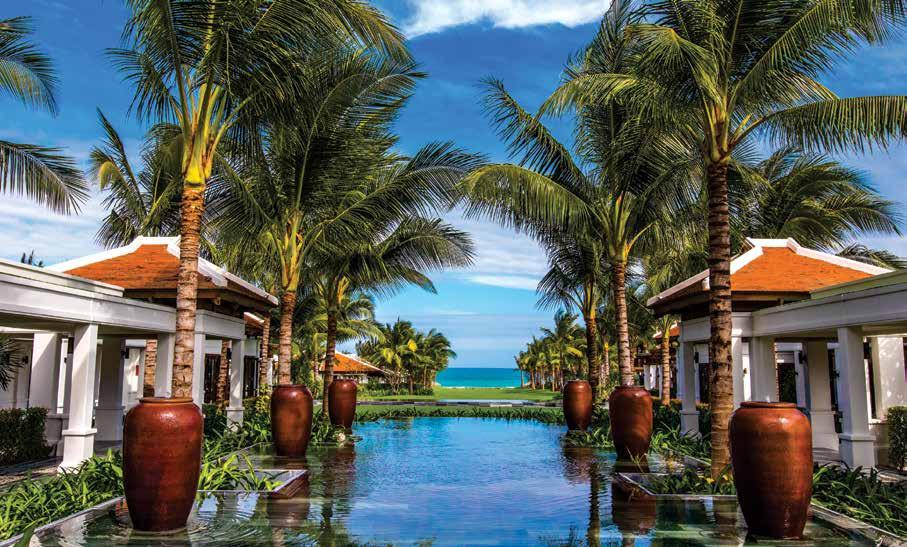
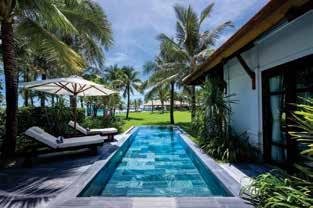
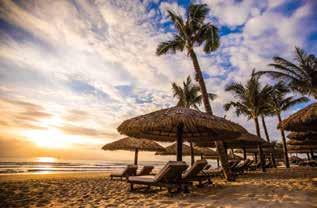

A new luxurious five star beach resort on Long Beach, Northern Peninsula Cam Ranh, Khanh Hoa, Vietnam info@theanam.com | www.theanam.com The Anam Villas are a proud member of
RENEW
AMATARAWELLNESSRESORT THAILAND
Of mind & matter

Well-versed in the importance of regular exercise and good nutrition, wellness writer Kelly Allen heads to Thailand for a closer look at brain health.
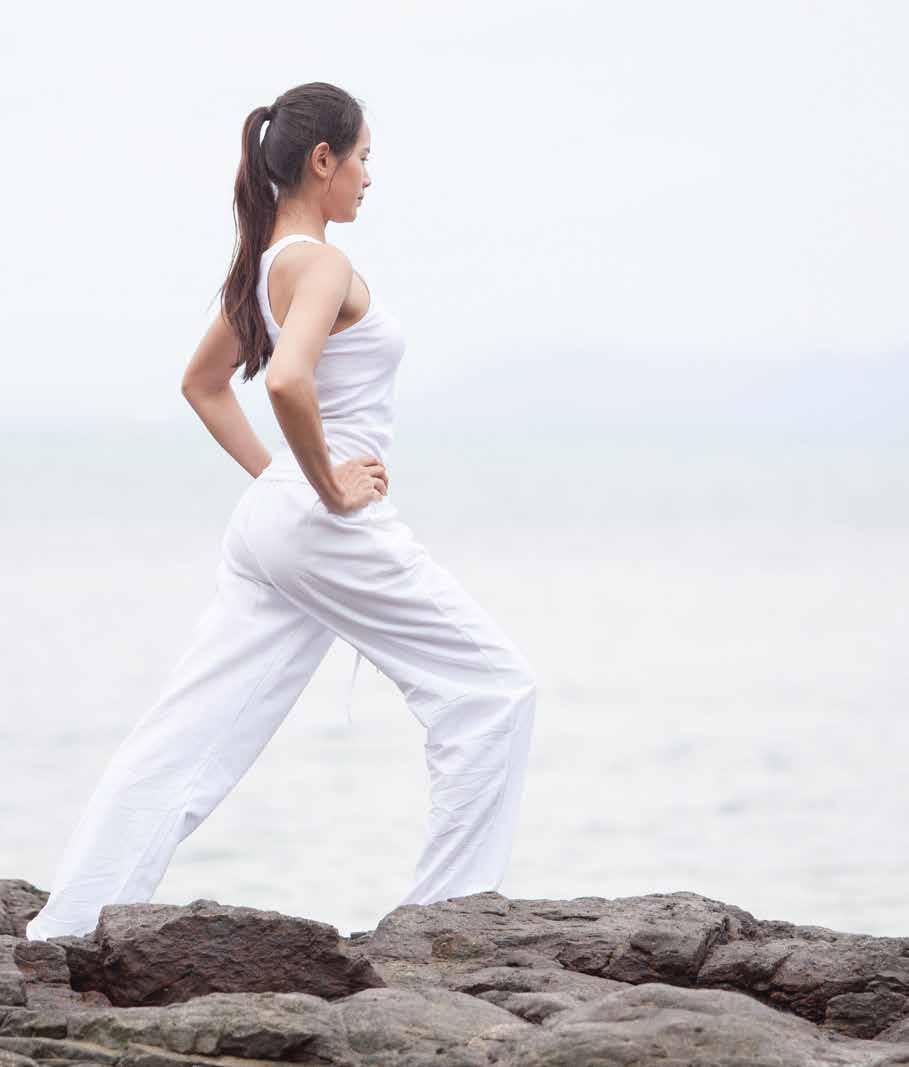
Walking around my local supermarket recently, I realised the freezer section had been moved. While contemplating possible reasons for the layout change, I rounded the corner and discovered it hadn’t moved at all. I was just disoriented. It’s not the first such slip I’ve made. I have forgotten the names of people I’ve known for years and sometimes struggle to find the right word when trying to explain something. Whether it’s age, stress, lack of sleep or all of the above, my brain just doesn’t seem as sharp as it used to be. To top it off, I have a family history of dementia and brain cancer. It was time to do something about it.
As a wellness writer, I know how important physical exercise and good nutrition are for your body. But what about the most important organ: our brain? I realised I didn’t really know much about maintaining brain health or what can threaten optimal brain function. Of course, diseases such as dementia and brain cancer might be pre-determined, but is
there a way to lower risk factors? And what about memory? Are there things I can do now to strengthen my brain for the future? I’m about to find out.
Amatara Wellness Resort in Phuket has joined forces with Bangkok Hospital Phuket’s Brain Health Institute to offer a unique wellness program that combines an in-depth analysis of your brain with everything you need to know to keep it healthy. The assessment is followed by a luxurious stay at the Amatara Wellness Resort, where they practice what they preach with healthy food, mindfulness, physical exercise and education on lifestyle change.
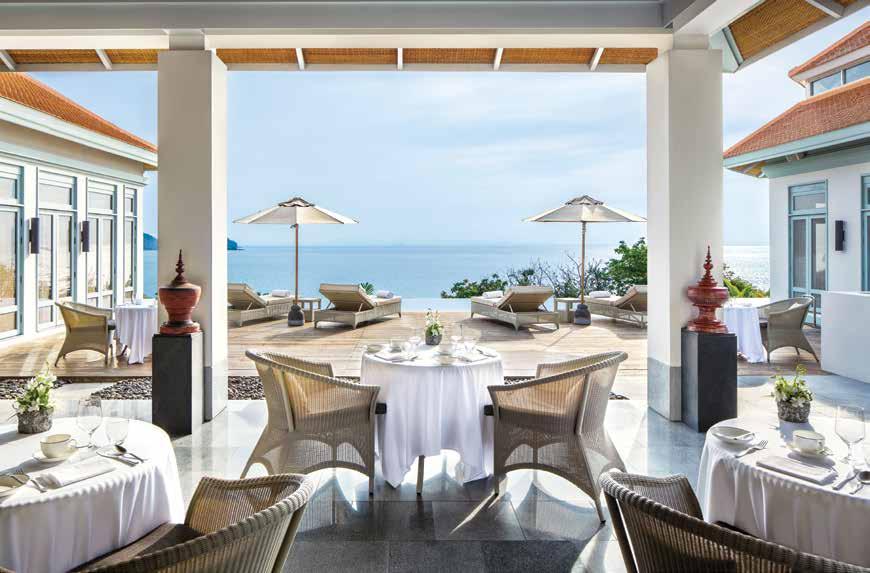
The program starts with a three-day stay at the Brain Institute, housed on the eighth floor of the very flash Bangkok Hospital in Phuket. Located about 40 minutes from the resort, the hospital is impressive: spotless, contemporary and incredibly efficient. My first day is busy with blood and urine tests. Nine vials are taken and everything from vitamins and minerals to hormones, hematol-
ogy, and heavy metals are analysed. I meet with neurologist Dr Kanya Temkiatvises to review my medical and family history, and go over the raft of other tests to be done during my stay. I have an MRI and an MRA to check for abnormalities such as tumours or clogged arteries, and to check the size and volume of the hippocampus (the small component of the brain associated with long-term memory). I’ve never had an MRI and am claustrophobic, but I am only encased up to my shoulders for 45 minutes and, thankfully, don’t experience any anxiety. Then there’s a full retinal eye exam as the retina is considered an extension of the brain. Studies have shown a correlation between degenerative brain disease and abnormal findings in the eye.
The sleep analysis test, while not at all painful, is definitely the most awkward. I have 24 electrodes stuck to my head, face, arms, chest and legs, as well as breathing monitors strapped to my chest, stomach and nostrils. I look ridiculous and wonder how I am going
to get any sleep connected to all the wires. There’s a camera that monitors my every move throughout the night while the electrodes measure the different stages of sleep, how long they last, my heart rate, any heart arrhythmias, my body position, and, most importantly, my breathing and whether I suffer from sleep apnea. I later learn that a good night’s sleep is the single most important thing you can do for your brain, and that many people have sleep apnoea and don’t even know it.
Another important part of the program is the cognitive assessment with a psychologist. For more than an hour I am put through a series of mental games that test memory, logic, spatial awareness, language and mathematical reasoning. I hate crosswords and brain games, and have never even tried Sudoku, so I’d be lying if I said I didn’t find some of the ‘games’ very challenging.
I see a sports medicine expert to learn how to de-stress with yoga, meditation and
132 www.luxurytravelmedia.com.au
THE RETREAT RESTAURANT
breathing techniques, and a dietician who discusses healthy nutrition choices for the brain. Sadly, some of my staples, such as cheese and saturated animal fats, are enemies of the brain.
At the end of my stay, I meet with Dr Kanya again to discuss the results. I sit down as she pulls up my MRI images and I can’t help but blurt out “did you find any tumours?” To my eternal relief, the tests came back normal and I’m floating on cloud nine as I make my way to Amatara Wellness Resort for the second, more indulgent part of my retreat.
The stay here is full of massages, private meditation classes, personal training, amazing healthy meals and the best spa treatment I have ever experienced, the Thai Hammam. I start with a wellness consultation and physical analysis to determine what specific parts of the anatomy I need to work on. I love learning new meditation techniques with the beautiful and talented Luna, and Tum teaches me a great DIY gym program that I can continue at home.
I enjoy every meal at The Retreat, where they make sure I am eating for the good of my brain as well as my stomach. My favorite dish is a beef broth with buckwheat soba noodles, miso, mushrooms, greens and slow-cooked beef cheek. The Thai Hammam treatment is in a class of its own; 105 minutes of scrubbing, hot and cold showers, mud wraps, and Himalayan salt therapy. It’s the best of the best.
So, how do I explain my memory lapses and the imagined redesign at my local supermarket? It can probably be attributed to a combination of a few nights of bad sleep, stress and poor diet. I am grateful there were no signs of dementia or disease, but equally as grateful to now be equipped with the knowledge of lifestyle and dietary changes crucial to longevity. This program is a step above your standard spa retreat. I found it to be the most informative and enlightening week I have ever experienced.
See more images from this story at luxurytravelmedia.com.au
Stay

Rates for the Brain Health Enhancement Program start from THB 376,200 (about A$14,780) per person and are inclusive of two nights at the Brain Health Institute and five nights at Amatara in the Ocean Pool Villa, all meals and transfers. amataraphuket.com
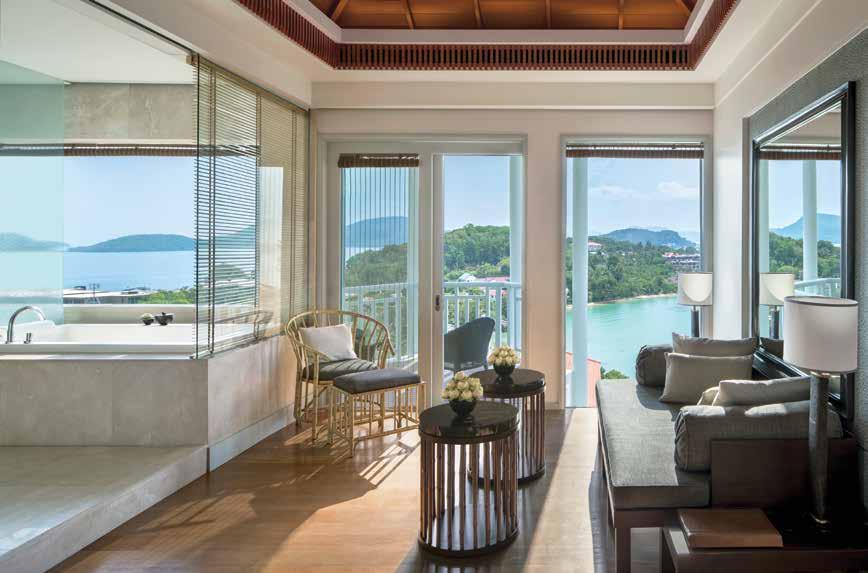

www.luxurytravelmedia.com.au 133
SEA VIEW SUITE
Karina Stewart

134
is lifestyle oriented and focus on how much power we each have to influence our health, vitality and wellbeing in a positive way. Additionally, Eastern healing practices address not only our physical health and vitality but also our emotional and mental health and
How are luxury health and wellness retreats combining Western and Eastern medicine to improve the wellbeing of their
At Kamalaya, just as in traditional Asian healing traditions, the focus is on a holistic healthy lifestyle, prevention, and achieving optimum health physically, emotionally and mentally. We combine treatments and therapies from Asian and Western holistic healing traditions into results-driven wellness programs. For example, our detox programs include Chi Nei Tsang (Taoist abdominal massage) and traditional Thai massage from the East as well as sessions in the far infrared sauna, colon hydrotherapy or lymphatic drainage, which are more Western approaches.
What are some of the most common damaging health habits or patterns you see in your guests?
In the past few years we’ve witnessed more guests from all over the world visiting because they are dealing with stress and stress-related symptoms due to their hectic lifestyles. Most guests see a visit to Kamalaya as a time to ‘clean out their closet’ so to speak; to take a good look at themselves, and review and evaluate what needs to be changed.
What is the easiest change a person can make to their daily routine to improve their general health and wellbeing?
Make a good eight hours of restful sleep a night your number one priority! Getting enough sleep is not only vital for overall wellbeing, but also for prevention, management and treatment of various health imbalances.
Q. What is your best tip for lowering stress levels?
A. The healing power of nature is one of the principles upon which Kamalaya is founded and a core principle in Traditional Chinese Medicine. We consider nature the greatest healer and spending time outdoors is one of many pleasurable ways to reset our mood and sense of wellbeing. Diet also has a huge impact on our nervous system and our emotions.
Q. What are your three top tips for maintaining a healthy lifestyle?
A. Take time to pause. Reduce or eliminate refined sugar as well as artificial sweeteners and high fructose syrups. Prioritise exercise or regular movement.
Q. What kind of changes would guests notice after a stay at Kamalaya?
A. At Kamalaya, the focus is on prevention and optimising health through inspiration and education so that our guests are motivated and equipped to integrate healthier lifestyle habits into their daily routines. Guests do see results during their stay with us; however the additional benefits and increased value come as a result of the take-home tools.
Q. What is new at Kamalaya?
A. Kamalaya recently introduced small, immersive and focused group retreats. The new Life Enhancement Retreats provide a setting for guests to explore particular areas of interest in greater depth and to benefit from the support network of like-minded individuals, with a maximum of 12 participants per retreat.
I’m very excited to be able to personally facilitate an intimate group retreat, Awakening Your Essential Self. Drawing on my 30-plus years’ experience with Asian healing and spiritual traditions, the retreat, available to a maximum of nine guests, is a deeply personal and experiential exploration of your essential self.
Dates in 2018: 24 February- 4 March and 22-30 September.
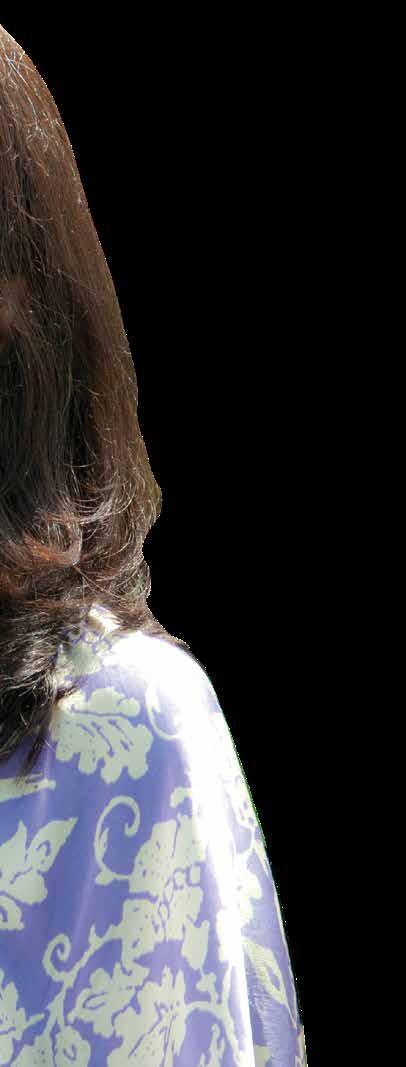
www.luxurytravelmedia.com.au 135
“
“
In the past few years we’ve witnessed more guests from all over the world visiting because they are dealing with stress and stress-related symptoms due to their hectic lifestyles.
Back to basics

A recent experiment conducted on a remote Swedish island has found just 72 hours getting up close and personal with nature could be the perfect antidote to a stressful life.

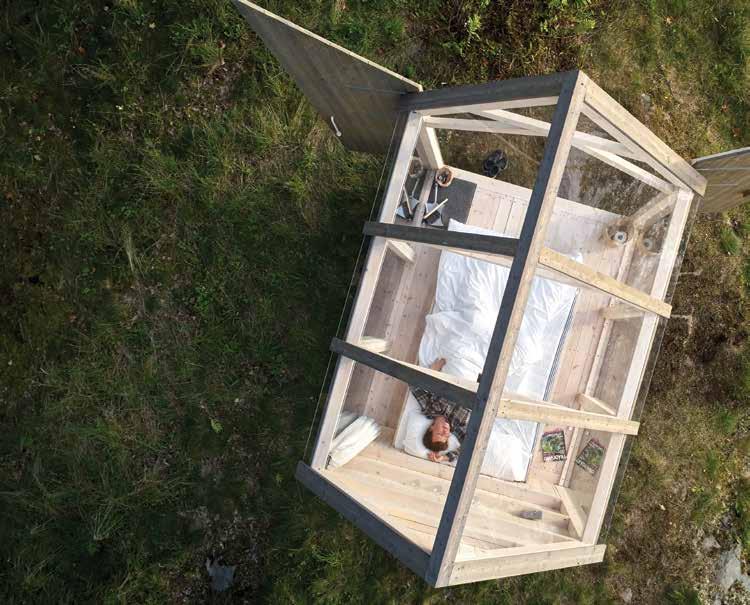
In September 2017, in an initiative led by Visit Sweden and the West Sweden Tourism Board, a team of researchers from the Karolinska Institutet in Stockholm took five people with stressful occupations to a remote island in Dalsland, West Sweden. Over the following 72 hours, the five participants, including a taxi driver, police officer and British broadcaster, lived in solitude in a custom-made glass cabin in the wilderness, spending their days participating in outdoor activities like fishing, swimming and canoeing. At the end of the experiment, all five subjects had shown a “decrease in systolic blood pressure, a drop in heart rate, an almost 70 per cent decrease of stress, and an increase in creativity and wellbeing.”
Set among rolling meadows, hills and woodlands on the privately owned island Henriksholm, each of the five original test cabins are now available to travellers for 72-hour periods. Cabins can accommodate up to two people with the base package inclusive of a welcome fika (coffee break) on arrival, all meals, a map of the island, an essentials kit stocked with a solar battery charger, torch, sleeping bag, eye mask, water bottle, cup and toilet paper, and use of row boats, a fishing rod and a wood burning sauna. Rates start from SEK3995 (about A$623) per person, based on double occupancy. vastsverige.com/en/72hcabin/
HIIT in your hotel room
Westin Hotels & Resorts has launched an in-room workout program starring Australian TV presenter, model and health coach Rachael Finch. Part of their global Let’s Rise health and wellbeing campaign, the Let’s Rise
Workout Series involves six full-body workout videos including two 15-minute HIIT workouts, two eight-minute ab attacks, a short warm up session and a cool down and stretch routine. The routines are specifically designed to be completed in-room, with no need for equipment. The videos will be available to Westin hotel guests in Australia and Fiji from 21 November, 2017. westin.com

136 www.luxurytravelmedia.com.au HEALTH & WELLNESS NEWS FROM AROUND THE WORLD
Master the art of detox
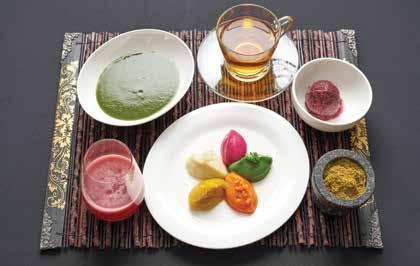
Guests of Thai health and wellness retreat Chiva-Som can now undertake an entirely personalised dietary-focused program aimed at detoxifying the body and resetting metabolic and digestive systems. The Art of Detox package can range from five to 14 nights and will see guests guided by an advisor to determine their ideal diet through a cleansing diet, lymphatic drainage massage and colonic therapy treatments along with breathing and stretching sessions and relaxation massages. Peak season rates for the five-night program start from A$4,716 per person twin share. chivasom.com
A view to wellness in the Swiss Alps
Gstaad's oldest palace hotel, the century-old Le Grand Bellevue, has reopened its spa following an extensive refurbishment. Described as a ‘labyrinth of wellness’, the vast Le Grand Spa now has 17 different hot and cold therapy rooms spread across almost 3,000 square metres, making it one of the largest spas in the country. Facilities include an ice fountain, Turkish steam bath, herbal sauna, detoxifying infrared sauna, hay sauna, Himalayan salt grotto and laconium. A new Alpine Spa Suite, designed for two, features its own Jacuzzi, rasul chamber, scrub table and relaxation area. Outside, guests can try the new Kneipp walk (to boost circulation), yoga area or relaxation pool. Treatments range from mineral-rich mud masks to goat milk and honey baths with fresh mountain botanicals. Products are provided by British organic brand Bamford. Le Grand Spa’s local experts also offer guided hikes through the winding mountain trails of the surrounding Swiss Alps. bellevue-gstaad.ch/spa
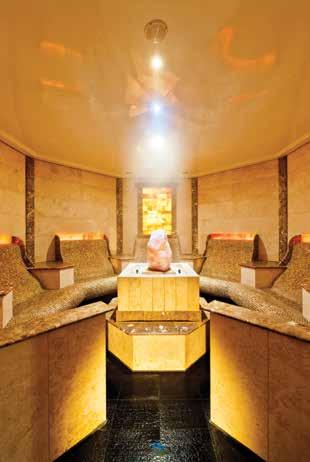
Peak performances
Adventure sports company K-Line has just launched Oman MTN FIT, an intensive high-altitude fitness training camp based at the five-star Alila Jabal Akhdar Resort in Oman. The 12- or eight-day program is limited to only eight guests per expedition and, staged at 2,000 metres above sea level in the Al Hajar mountains, aims to deliver participants optimal physical conditioning by boosting natural EPO (Erythropoietin) production and increasing VO2max (maximum levels of oxygen). The program is led by specialised trainers and includes an experienced mountain guide and hosts, mobilisation sessions, all personal training sessions, organic supplements, and daily monitoring and body composition analysis. Rates for 2018 start from US$3,730 per person for an eight-day program based on twin share. klineadventures.com
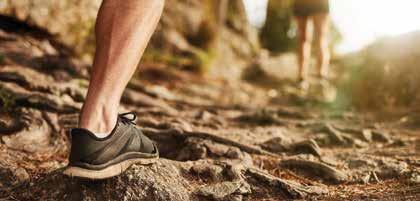
www.luxurytravelmedia.com.au 137
Five questions about…
Fraxel Re:store Dual Laser
at Infinity Skin Clinic, Mosman
By Kelly Jane Gabriel
What is it?
Fraxel is a non-ablative laser procedure, which means it creates heat in the skin without damaging the skin’s surface. The laser comes in two wavelengths: 1,550 nanometres to target deeper wrinkles and acne scarring, and 1,927 nanometres for pigment, tone and texture. I went for the lighter treatment. It is designed to repair sun damage, reduce the appearance of brown age spots and stimulate new collagen.
How long does it take?
I had an initial consultation with Lisa at Infinity Skin Clinic and was sent home with a personalised medical-grade skin program by Synergie Practitioner to follow for three weeks prior to my Fraxel treatment. This promotes the best results by making sure the skin is properly hydrated and helps to ensure a quick recovery. I noticed a very big improvement in my skin after three weeks of using the Synergie products. On the day of the procedure, Lisa took before photos and applied a topical anesthetic cream to my entire face. Goggles were put over my eyes and the laser was then rolled over my face section by section. The whole procedure took around 20-30 minutes.
Does it hurt?
On a scale of one to 10, the pain was around a three or four with a couple of moments up in the five to six range. The forehead was a particularly sensitive area. But overall, it was more discomfort than pain.

How do I look?
For the first 24 hours after the procedure, my face was pink and a bit swollen. It looked like I had moderate sun-
burn, but there was no discomfort and it wasn’t a problem to be out in public. By day two, it had developed into a dark bronze, which looked a bit like an overdone fake tan. My skin was tight and itchy. Things took a turn for the worse on days three and four, and I didn’t leave the house. My skin was flaky, mottled and very dry, though I was given oils and moisturisers to use throughout the day. By day five, 95 per cent of the flaky brown spots were gone and I felt confident enough to venture out to the gym (and didn’t notice any strange looks). At this stage my fresh new skin needed to be completely protected from the sun, so I wore sunblock and a hat. I had a follow-up appointment with Lisa one week after the procedure for a special facial to remove any remaining dead skin and a 20-minute LED Omnilux light treatment to help with the healing process.
Does it work?
Wow. The results are terrific. All the sun spots are gone and my skin tone has completely evened out. I didn’t know how many dark spots were on the side of my face until I saw the before photos, but now they are all gone. I’m so impressed with the results and I plan to keep my face protected from now on to ward off any new spots. Ideally this procedure should be done every 18-24 months if you get a lot of sun exposure.
Try it
A single treatment costs A$1,195 for a full face, not including pretreatment products (these products will vary from person to person). Find out more at infinityskin.com.au
The Nue Co. Energy Food + Prebiotic
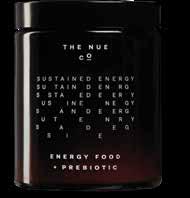
The Nue Co.’s food-based, completely bioavailable powdered supplements are delicious, versatile and effective. Energy Food + Prebiotic makes for the perfect travel companion. The formula contains a combination of organic beetroot, maca, goji berry and prebiotic inulin to regulate and sustain your energy levels through naturally high levels of B vitamins and magnesium. The pink powder has a natural berry flavour, and is a quick and easy addition to coffee, yogurt, almond milk or cereal. US$75 (about A$96). thenueco.com
Shiva Rose Blue Crystal Eye Cream
This light but deeply moisturising eye cream hydrates and soothes thanks to a careful formulation of powerhouse ingredients. Organic blue tansy and blue chamomile work to deflate any puffiness, while hyaluronic acid and evening primrose hydrate and soften fine lines. The gentle formula works for all skin types, and the mild and soothing scent of lavender, sandalwood, and chamomile makes it a pleasure to use. US$95 (about A$120). shivarose.com

138 www.luxurytravelmedia.com.au TRAVEL BEAUTY TIPS & REVIEWS FOR FREQUENT TRAVELLERS
From New York-based beauty expert Victoria Allen.
Nature & nurture


An experience at this exquisite Blue Mountains spa will leave you feeling like the one and only, writes Kelly
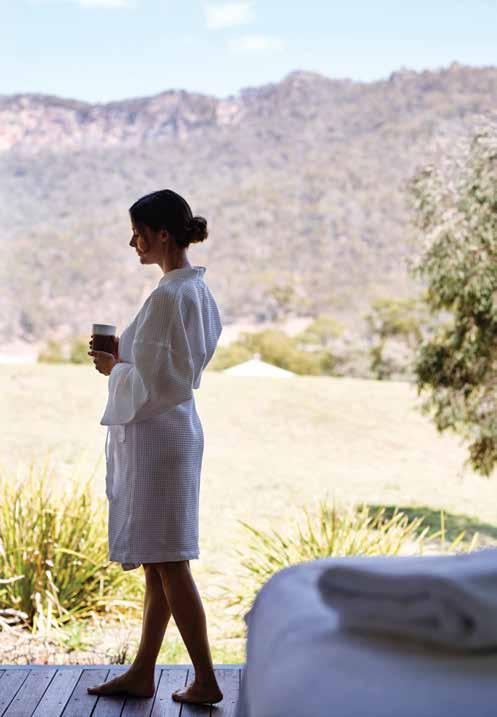 Jane Gabriel
Jane Gabriel
It’s hard to beat the view from the relaxation room at Emirates One&Only Wolgan Valley’s Timeless Spa. The large and inviting space was designed with the Greater Blue Mountains location in mind; a glass wall gifting guests a stunning view over the jagged mountain range that flanks the 7,000-acre conservation reserve. As I sit on the oversized lounge in front of the open fire, herbal tea in hand, I watch a couple of wallabies grazing, joeys peeking out from their pouches, and several rabbits bounding across the field and into a burrow. The winter sun is low and turns the ancient escarpments in front of me a deep orange.
There are six double-size treatment rooms that make up the spa, each with a change area and bathroom – no communal locker rooms here. In the mood for relaxation and detoxification, I am having the signature 60-minute Mountain Aromatherapy Massage using products from all-natural Western Australian brand Sodashi. Nick, my masseur for the day, was also my Meridian Yoga instructor that morning and, based on the caliber of the class, I have high expectations of the impending massage. Nick works his magic and at some points I find myself almost drifting off, intoxicated by the aromas of native Australian botanicals. A distinguishing feature of a Sodashi treatment, this full-body massage includes the face, an aspect I find incredibly relaxing. When I am tense or stressed, my jaw muscles and the area between my eyes tighten, and having that area massaged helps me unwind. After my treatment, I return to the relaxation room and enjoy another cup of tea in front of the fire before heading over to the sauna to let the essential oils soak into my skin.
The spa has recently added wellness weekends to the menu with themes including candle making, yoga, tea tasting and even a special Sodashi weekend with the company’s founder Megan Larsen. Just a three-hour drive from Sydney, Wolgan Valley’s Timeless Spa is hard to beat for a rejuvenating miniretreat or indulgent girls weekend.
Experience
The Wellness in the Mountains package is priced from A$2,025 per night and includes all meals, a wellness consultation on arrival, a 90-minute spa treatment per day, Sodashi gift pack and more. oneandonlyresorts.com
www.luxurytravelmedia.com.au 139 HEALTH & WELLNESS SPA REVIEW EMIRATES ONE&ONLY WOLGAN VALLEY




A stay at Emirates One&Only Wolgan Valley Health and wellness Thailand Best places to stay in Sydney TWITTER@LUXURYTRAVELAUINSTAGRAM@LUXURYTRAVELAUFACEBOOK.COM/LUXURYTRAVELMAGAZINE FOLLOW US ON luxurytravelmedia.com.au Online Exclusives ONLINE NOW

www.luxurytravelmedia.com.au 141 142 One Aldwych and The Ritz | London 146 Family villas | Bali 150 Elements of Byron | Byron Bay 151 Family travel news GATHER
Fit for a princess
London knows luxury and, as Julia Baird discovers, some of the city’s best hotels are serving up junior indulgences, too.
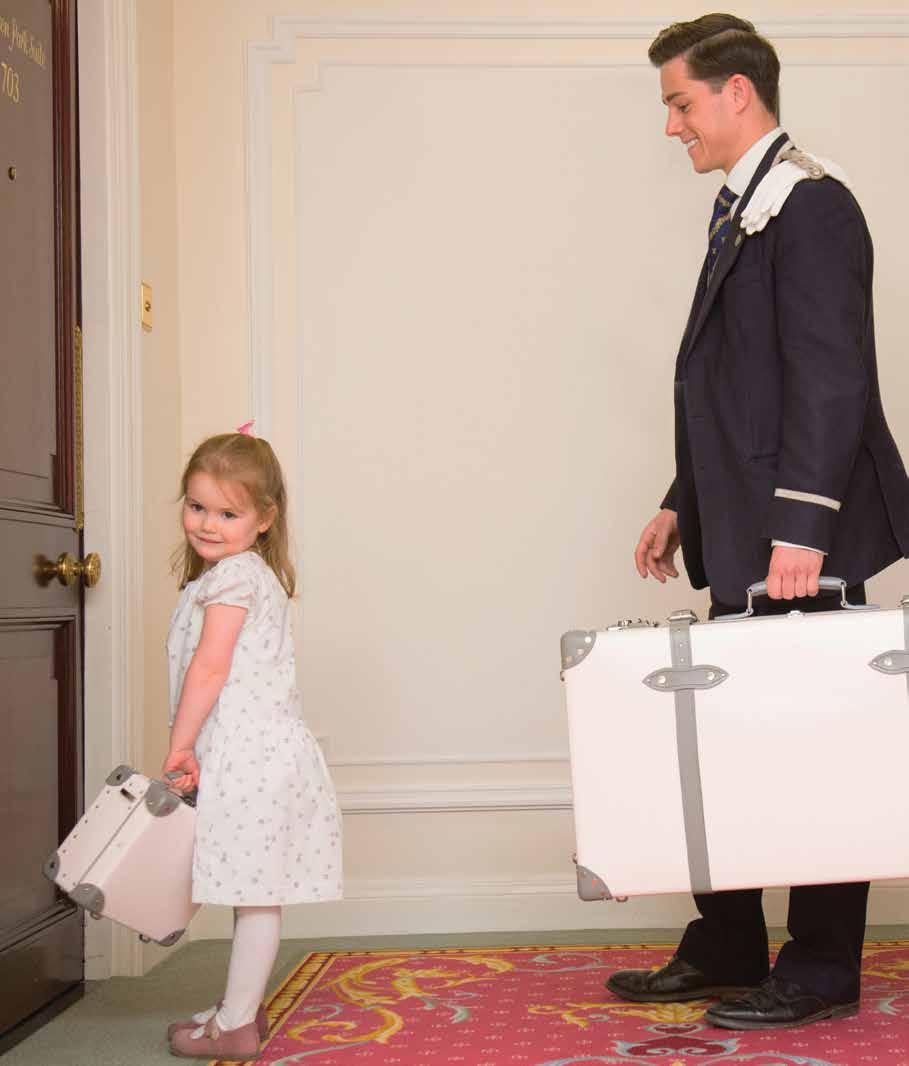
Oh, they fit me!” my daughter exclaimed with delight when she put her feet into hotel slippers that, for once, were her size. Upon discovering the bathrobe fit too, she sauntered about her room at One Aldwych, very pleased with herself.
Because while the delights of London are obvious to the most shortsighted – palaces, paintings, plays – what you tend to forget when booking from afar is how even the most robust traveller starts to hanker for the comfort of their hotel after a few hours exploring museums and cobblestone streets. Especially kids.
One thing that surprised me most when I took my 11 year old daughter, Poppy, to London was how often she told me she wanted to return to our hotel, where she slept long and dawdled over breakfast. Although perhaps I should not have been so surprised given where we were staying. It’s a great mistake to underestimate the pulling power of luxury.

A member of the Leading Hotels of the World, One Alwdych is a sharp, beautifully decorated, glamorous hotel with a great spa service and a pool. Near Covent Garden, it looks down Waterloo Bridge and is next to the Lyceum Theatre, where Lion King was playing, happily for us.
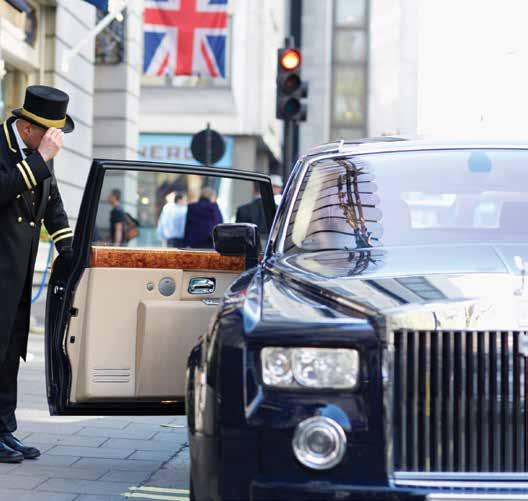

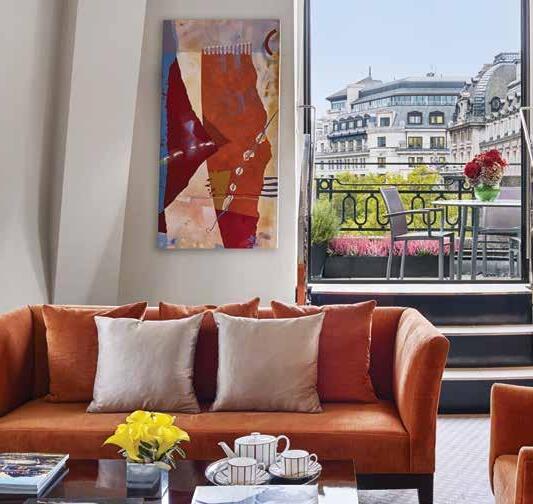
Poppy ordered French toast and bacon for breakfast every day. But what delighted her most was the superb Charlie and the Chocolate Factory Tea, which comprised rhubarb and custard fairy floss, little Eton messes, airy scones, chocolate caramel milk, lemon and white chocolate cake pops and – the piece de resistance – a golden egg with an edible chocolate shell filled with cream. The cherry chocolate cocktail came served in a glass teapot, smoking magically with dried ice. “Fabulous,” was the verdict.
And so, I discovered, this is how you sate the soul of a child who has always aspired to be fancy, and whose first act in London was to walk miles to a store that sells enormous hair bows and spend her hard saved money on 10 of them. Yes, 10.
‘Fancy’ became a permanent state of mind when we arrived at our next hotel, The Ritz. Iconic, historic and eye-achingly beautiful, The

www.luxurytravelmedia.com.au 143
LONDON GATHER
Ritz swept us up in old-world charm the moment one of their handsome porters swept in to help us out of our car. Every room is sumptuous in a soothing-yet-spectacular fashion, which is the true gift of this hotel: it somehow manages to be both majestic and comfortable. Chandeliers, plush pillows, and staff so discreet they won’t tell you which suite Margaret Thatcher died in (and will make you feel a little ashamed for wanting to know).
For foreigners, perhaps the most astonishing thing about The Ritz is not just its beauty, but also its location. It is right around the corner from Buckingham Palace – quite the neighbours – and certainly fit for a princess. The young Queen Victoria would have vastly preferred The Ritz to her childhood home of Kensington Palace, which she complained was infested with beetles and had dirty windows. She would have been pleased her great-greatgranddaughter Queen Elizabeth II celebrated her 80th birthday at the Ritz.
Poppy cooed over the pink embroidered bathrobes and slippers, and was given a VIK (Very Important Kid) pack at check-in that entitled her to free ice cream (she asked for vanilla with whipped cream) as well as a cute teddy
bear she named Charlie.
The service at The Ritz is superb. The concierges have been there for half-centuries and ooze a discreet competence. They doted on my girl, and even the pianist – who used to accompany Frank Sinatra – played some Justin Bieber for her as the polished clientele sat supping on their legendary high tea. He played Elton John for me too – Daniel and Sorry – and told me I Still Call Australia Home should be our national anthem.
When reflecting on the differences between The Ritz and One Aldwych, I was reminded of how a woman once famously compared former UK Prime Ministers Benjamin Disraeli and William Gladstone. The latter left you thinking he was the cleverest man in the world while the former left you thinking you were the cleverest woman in the world. At every gilt-edged corner, The Ritz reminds you some believe it to be the most fabulous hotel in the world. One Aldwych, on the other hand, reminds you that sometimes you can be rather fabulous, too.
See more images from this story at luxurytravelmedia.com.au
POPPY’S BONUS POINTS

THE RITZ
Toiletries for children. Amazing. Complimentary DVD (Beauty and the Beast) Lemonade and shortbread cookies upon arrival.
ONE ALDWYCH
Floating toys for the pool. Absolutely scrumptious afternoon tea. Cake pops and delicious macaroons upon arrival.
The Ritz London

Children up to 15 years old stay free in their parents’ room. Children’s bathroom amenities, bathrobes and slippers, treats at evening turn down and complimentary ice cream in The Palm Court or The Ritz Restaurant are included. Rates for a Junior Suite at The Ritz London start from £740 (about A$1,248) per night. theritzlondon.com
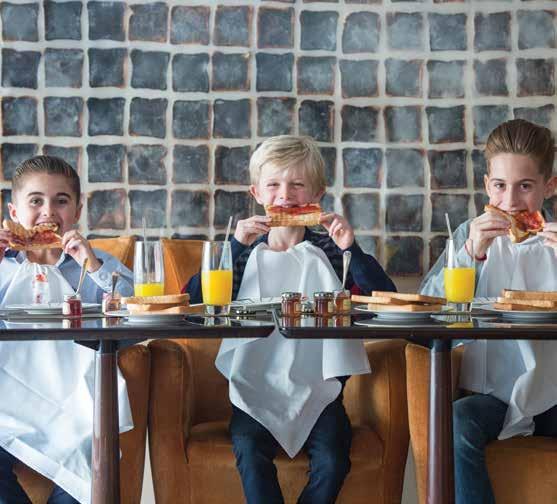
One Aldwych London
Boasts six inter-connecting bedrooms and can provide cots and bed rails, and a babysitting service. Welcome gifts, and children’s bathrobes and slippers are included. Room rates start from £270.00 (about A$462) excluding VAT. Suite rates start from £470 (about A$805) excluding VAT. onealdwych.com
144 www.luxurytravelmedia.com.au
Stay
✔ ✔ ✔ ✔ ✔ ✔
POPPY, AGE 11
Live the Langham Lifestyle with our ‘Summer Loving’ package. Our family-focused package includes luxury accommodation, access to our city view swimming pool and deck, breakfast for two adults and two children in Melba, valet parking, wi-fi, turn down with bottled water daily, take home back pack for kids filled with Langham gifts. Packages from $395 for a Superior Room.
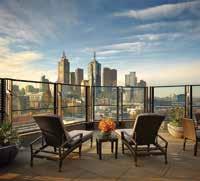

1 Southgate Avenue, Southbank, Victoria
T (613) 8696 8888 langhamhotels.com/melbourne
The Langham, Melbourne
 Terrace Room
Terrace Room
Family values
Personal, intimate and beautiful, the private villa proves the ideal option for a family getaway to Bali, discovers Belinda Jackson.
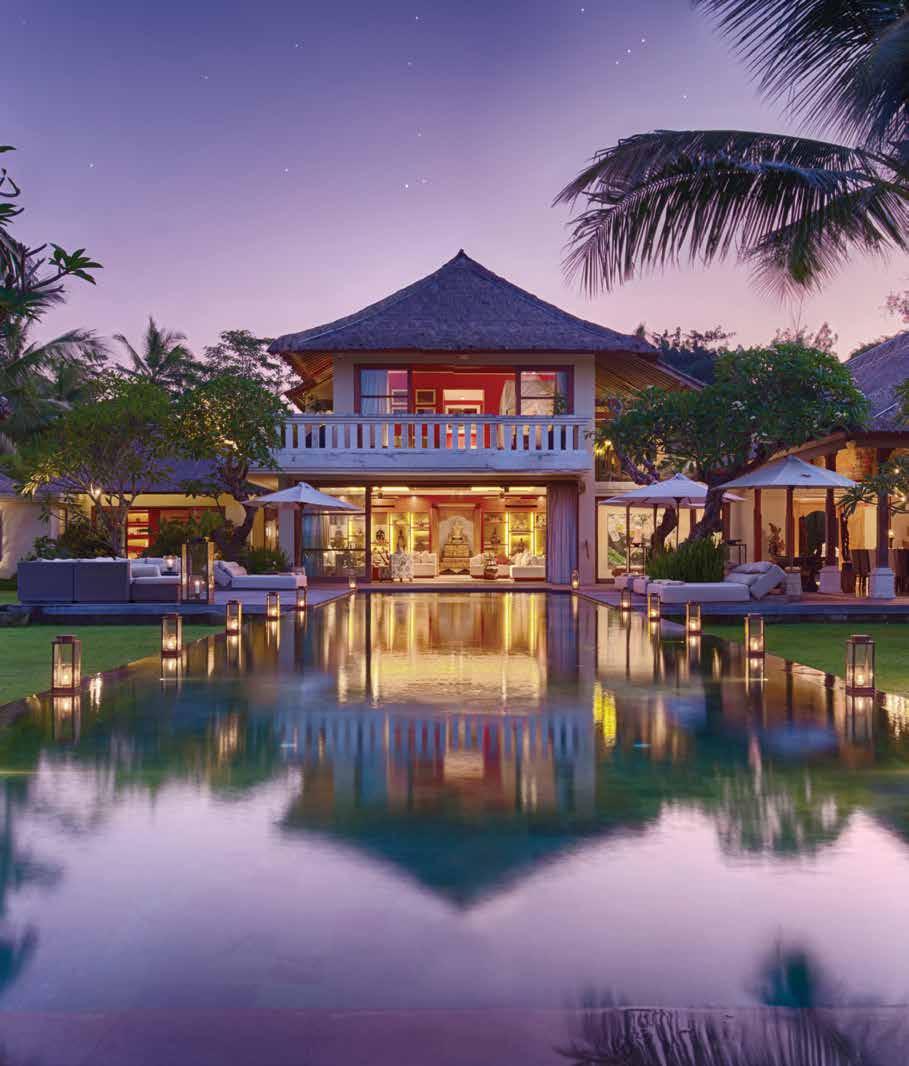
KABA KABA ESTATE
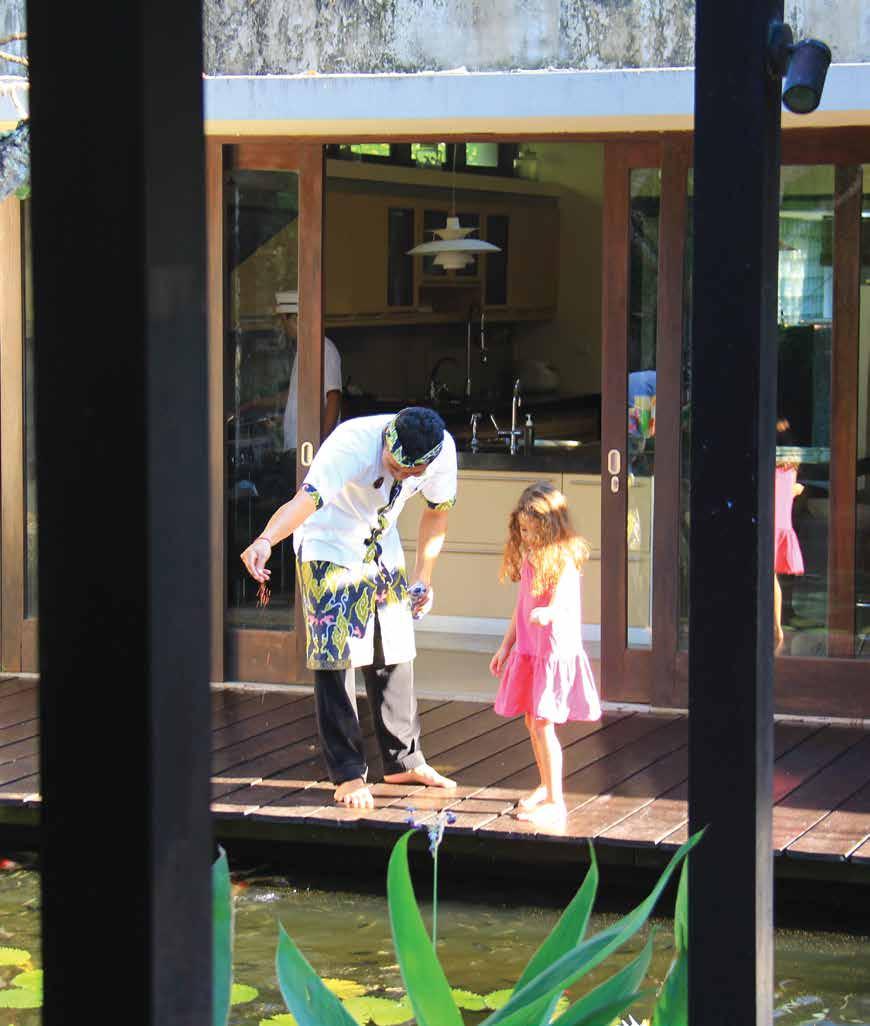
RITUAL MORNING FISH FEED BELINDA JACKSON
It’s just past sunrise when my six year old slips from her bed and pads quietly across cool tiles to meet the kitchen staff. As has become his morning routine, the young waiter drops everything to crouch down beside her to feed the golden koi and gargantuan eels that loll in the warm waterways running between our bales (pavilions).
It’s one of many touching scenes that play out during our family’s stay in Samadhana, a five-bedroom villa in the tiny fishing village of Ketewel, about 20 minutes north of Sanur on Bali’s southeast coast.
Our family group of 10 flew in from Brisbane, Melbourne and London, with the aim of celebrating three birthdays and skipping the Australian winter in as few flights as pos -
sible. And instead of chasing each other down hotel corridors and dressing for breakfast, we opt to rent an entire villa for our group, which crosses three generations, from six to 70 years old.
Renting a villa for small groups of friends or family is a hot travel trend, and Bali has long been a bellwether for villa stays, with Sri Lanka, Thailand and the Maldives now picking up the thread. Villas come fully staffed with housekeepers, a chef and a villa manager, and nannies and spa services are just a phone call away. Styles range from thatched roofs and traditional bales to ornate Dutch colonial antique homes and allwhite, hyper-modern architectural statements beloved by the Jakarta set, who fly in to party on the weekends.

We split our eight-night holiday into two four-night stays: firstly in Ketewel, and then into the beating heart of urbane Seminyak. The five-bedroom Villa Samadhana in Ketewel is a study in tropical modernism by Malaysian architect Cheong Yew Kuan, whose work includes the luxe COMO hotel group’s COMO Shambhala Estate in Ubud and Cocoa Island in the Maldives. There’s a 25-metre infinity pool and the rooms are spread across nearly two acres of immaculate tropical gardens. We talk through the menu with the villa staff each day, dine in the vast open-air bale, and an impromptu pool competition emerges in the equally huge poolside bale, fitted out with linen daybeds and a thatch bar. As our stay includes two significant birthdays, we arrange a seafood barbeque by the pool,
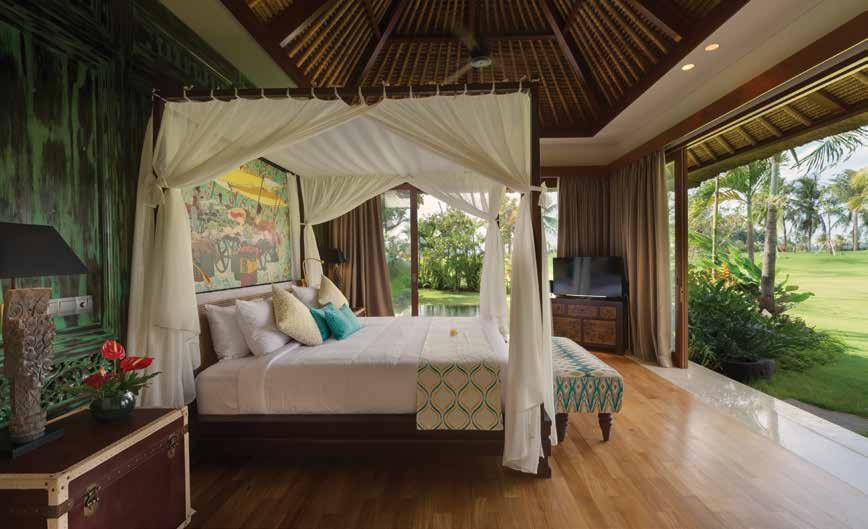
148 www.luxurytravelmedia.com.au
KABA KABA ESTATE|PILISAN DAJA BEDROOM
BALI
GATHER
and are surprised by a visit from four local girls, who perform traditional Balinese dances for us.
With little to distract us, this is the time to wind down from work, catch up over late breakfasts and talk long into the languid evenings, the warmth and peace of the island seeping into our bones. On the third morning, a restful hush falls over the villa as five staff from a nearby spa arrive to massage, manicure and, in my case, perform a deep, dry rub that drops me a dress size.
The tariff includes a car and driver, and we employ a second car to ferry the group through little silversmith villages and winding markets before finishing up with cool coconut mojitos and dinner in Ubud, just 30 minutes’ drive from the villa.
Our second stop employs all that newly regained energy as we hit the hot new restaurants and shop up Seminyak using a handy, on-trend guide written by our villa’s management team. As a counterbalance to Samadhana’s serenity, we hire the two sideby-side villas of Des Indes II to create a five-
bedroom villa down a quiet, private laneway in busy Seminyak. The stylish look is fourposter beds with soft, white curtains and plantation shutters, a carved chess table and antique Indonesian artefacts completing the Dutch colonial style.
Combining two villas means we have two pools and two living areas. With top restaurants and the beach within easy walking distance, we don’t need to arrange transport, while breakfasts of tropical fruits, standard Western fare and Indonesian classics such as nasi goreng are included in the tariff. Cots

Stay

and pool fences are available on request, and we allocate our own rooms, separating the party crew from the light sleepers. There are no rules about not dining in your swimwear we never listen to piped music.
Samadhana and Des Indes quickly become our own private homes, albeit more stylish and luxurious, and the group agrees this is one travel trend worth embracing.
See more images from this story at luxurytravelmedia.com.au
We used long-established villa management company Elite Havens, which has accommodation ranging in price from US$300 (about A$380) a night, plus taxes, for a one-bedroom villa to the eight-bedroom Kaba Kaba in Tabanan for about US$5,000 (about A$6,390) a night in peak periods. Villas range in size up to nine bedrooms, with the option of renting properties side-by-side to increase capacity, ideal for family reunions. Seminyak is the most searched-for option, with the next district north, Canggu, also on the hot list. Away from the crowds, the cliffs on the southerly Bukit peninsula are always popular, and sprawling estates such as Villa Anandita, on Bali’s sleepy neighbouring island Lombok, have the highest occupancy on Elite’s books. elitehavens.com
www.luxurytravelmedia.com.au 149
SAMADHANA|ENTERTAINMENT PAVILION
ELEMENTS OF BYRON | BYRONBAY GATHER

space Lost in

Already a star among Byron Bay’s luxury offerings, Elements of Byron has just completed a multi-million dollar upgrade. Kelly Allen checks in to find a raft of new features aimed firmly at families.
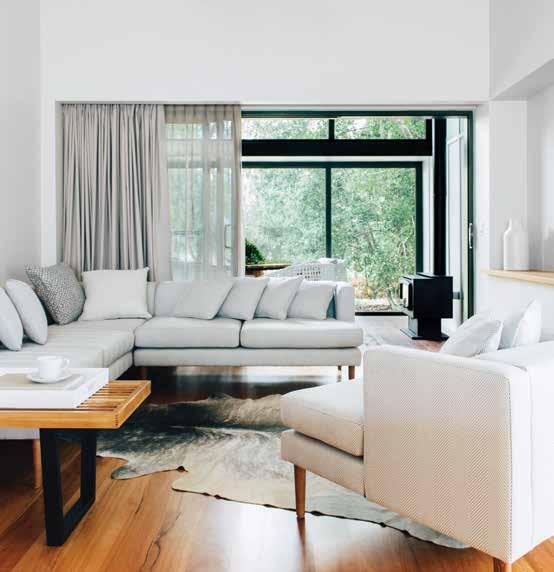
Laid-back luxury is what it’s all about at Elements of Byron, the sprawling beachfront resort set just north of Byron Bay’s town centre. The property opened in early 2016 and has just completed an extensive A$120 million expansion with 99 additional villas, as well as new facilities including a children’s adventure playground and an adults-only pool complete with swim up bar.
Of the new villas, 68 have two bedrooms and are designed with families in mind. I check in to a Superior Two-Bedroom Villa, which offers 98 square meters of comfort and style (the Deluxe Villas are even larger at 111 square metres). Blonde timber flooring glows with the abundance of natural sunlight and the louvre windows let in the fresh sea breeze.
There is a king-size bed in the master bedroom and the choice of a king or two singles in the second bedroom, as well as an optional trundle bed. Both bedrooms have oversized ensuites with rain showers and one has a deep soaking tub. They are stocked with full-size Appelles toiletries, including an especially lovely pot of Himalayan bath salts.
The villas are equipped with a spacious kitchen boasting everything you need for selfcatering (including a dishwasher) and the fullsize washer and dryer are a bonus if you are staying several days.
The lounge has a sectional couch with enough room to seat everyone and looks out onto a large screened-in porch with dining table, couch
and gas heater. Three flat-screen TVs with inhouse movies ensure everyone is happy if you need some down time or encounter a rainy day, and the whole family can join in a game of dominoes or pick-up sticks, also provided.
You’ll find a new iPad in every villa, full of useful information on the resort, including dining and activities. And you can easily charge it at one of the numerous USB outlets spread throughout the rooms.
While the kids are entertained by the new wooden adventure playground, the grown ups can retreat to the adults-only pool, surrounded by enclosed cabanas on a split-deck terrace. There’s a small restaurant serving Mexican street food as well as giant chess and bocce.
Even with an increased focus on families, Elements hasn’t strayed from its roots. I love walking through the rainforest trail each morning on the way to yoga, then practicing on a grassy hill overlooking the beautiful Belongil Beach. Suitably zen, I head to the generous breakfast buffet featuring fresh sourdough
from local favourite The Bread Social and delicious Marvell Street Coffee, roasted in Byron. The incredible lagoon pool, with daybeds hanging over the water, is a highlight, and The Beach Club, with its generous thick-cushioned sun loungers and the fabulous beachside retro caravan serving Aperol cocktails, is the place to farewell the day.
The world’s first solar-powered train is scheduled to open here at the end of the year, running between the resort and Byron itself. The three-kilometre track will wind along the coast and be open to residents and visitors, making for a much more convenient – and scenic – way to get into town.
Rates for the Superior Two-Bedroom Villas start from A$745. elementsofbyron.com
150 www.luxurytravelmedia.com.au
Stay
Cool change at Sofitel Sydney
Wentworth

To celebrate the release of the new Disney short film Olaf’s Frozen Adventure, Sofitel Sydney Wentworth will be hosting a series of Frozen-inspired events throughout the Christmas period. Children are invited to dress up as their favourite Disney character and enjoy a Frosted High Tea in the Soiree Bar. Dilmah Teamaker’s Private Reserve loose leaf tea will be served alongside French delicacies with a character twist, such as Elsa’s frosted macaroons and Anna’s blueberry tartlets. Guests from the Kingdom of Arendelle will even stop by for a visit. The hotel is also offering a Disney Family Fun accommodation package including Disney gifts for the kids, and a Winter Wonderland Luncheon on Christmas day with a Frozen kids’ dessert buffet and appearances by Frozen characters. Aside from the Christmas day luncheon, all packages are valid until 31 January, 2018. sofitelsydney.com.au/en/frozen
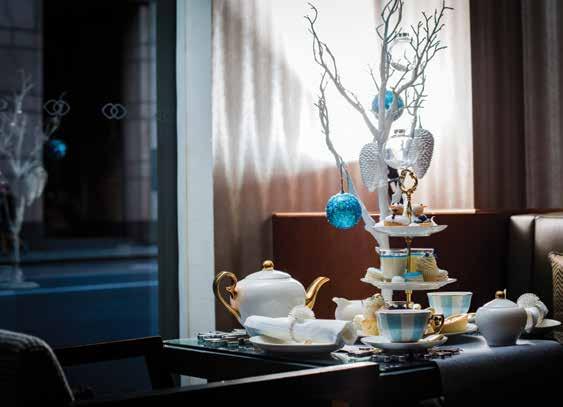
More in the Maldives
Ready for takeoff
Over the next three months Qantas will be introducing a number of new initiatives for members of The Joey Club, the airline’s program for young frequent flyers. The first is the newly released line of unisex pilot and cabin crew outfits, available for purchase through the online Qantas store. Younger flyers can also expect upgraded children’s inflight entertainment, a Joey Club Kids’ Kit on selected international flights and a Qantas Joey Club novelty passport for members aged three to 10 years. qantas.com

Park Hyatt Maldives Hadahaa has recently launched a new luxury villa category designed for families. The two-bedroom Park Pool Villas will be the first opportunity for visiting families to stay under the same roof, with the second bedroom offering twin beds and an ensuite. The main villa features a private plunge pool perfect for kids, while the master bedroom offers an outdoor terrazzo bathtub and rain shower. The hotel has also introduced a new range of family friendly incentives like daily kids’ activities, new kids’ welcome packs and a complimentary babysitting service. maldiveshadahaa.park.hyatt.com
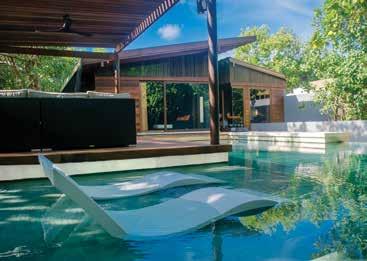
www.luxurytravelmedia.com.au 151 FAMILY TRAVEL NEWS FROM AROUND THE WORLD
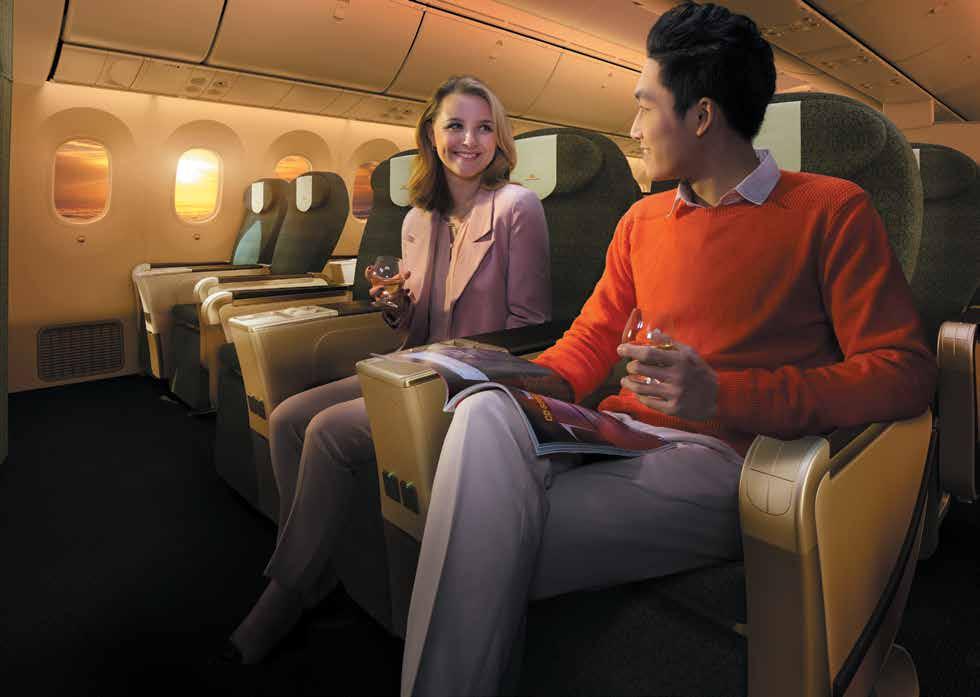
www.vietnamairlines.com PREMIUM ECONOMY CLASS SPECIAL OFFER * * Special offer only for bookings in W class Terms and conditions apply. Please contact Vietnam Airlines at sales.au@vietnamairlines.com for more information Buy 1 get 1 free upgrade for travel companion Buy 2 get 1 free for accompanying child Buy 3 get 1 free with the same itinerary

www.luxurytravelmedia.com.au 153 154 Hotel design trends 158 Likuliku – Tokoriki – Nanuku | Fiji 166 Amanbagh | India 170 Cicada Lodge | Northern Territory 174 The Anam | Vietnam 176 Sofitel Wellington | New Zealand 179 Suite life STAY
Cool by design
There can be little argument that our world has become increasingly ruled by appearances. The majority of us spend our spare moments immersed in a constant whirl of visual media; Instagram feeds act as both tastemakers and sources of inspiration; the rate at which moments/ things/places are snapped, edited and shared is astounding. It’s become such that avid followers will now take their screens to the desks of concierges and request specific rooms, or ask if those eccentric cushions in the cocktail bar are for sale – and, if not, what do they have to do to get them.
“Social media has created a new awareness in our surroundings and the aesthetics of them,” says awardwinning Australian interior designer Blainey North. Design Director of Firmdale Hotels Kit Kemp believes this movement has contributed to a more tailored approach: “The internet has made everyone more discerning… there is a great deal of interest in design and craft, and the standards of design and finish have improved greatly.”
It’s no surprise then that this global zeitgeist has trickled into the luxury travel sector, one that has always been founded on exquisite beauty and personalised service.

“This whole thing of an individual-

154 www.luxurytravelmedia.com.au
Katie Milton speaks to Kit Kemp and Blainey North about the everevolving state of luxury hotel design.
DESIGN HOTEL TRENDS STAY
ised experience – that’s the big trend,” says North. A slew of new-build hotels and existing properties undergoing refurbishments are using custom design features to set them apart from their competitors and generate a more experiential stay for their guests.
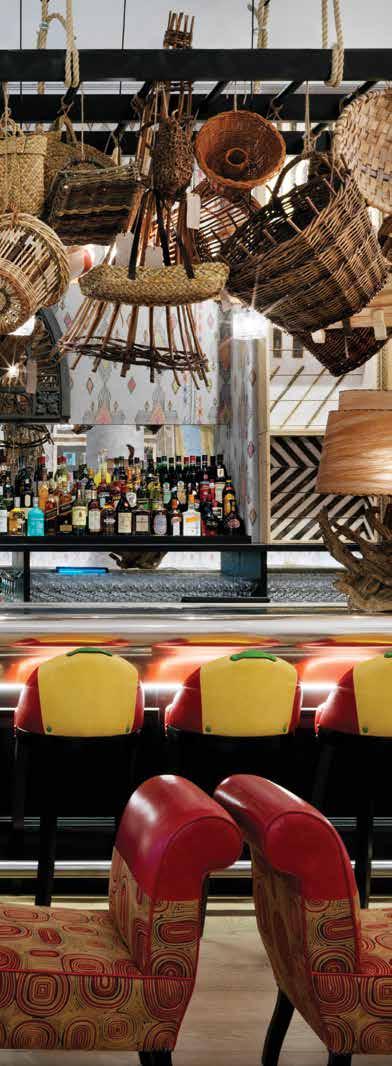
Interior designers such as Kemp and North, and firms such as BatesSmart (Crown Towers, Four Seasons) and Michael Fiebrich Designs (Crown Towers, Wynn Palace), are some of the big names leading the charge. Kemp’s exquisite Firmdale properties are defined by bursts of vibrant colour, statement headboards and handcrafted touches. Her latest project, The Whitby, is a “celebration of art and design”. As Kemp explains, it features everything from “a collection of 52 baskets from all over the British Isles, which hang above The Whitby Bar, to a custom wallpaper mural created with designer and painter of decorative interiors Melissa White that marries motifs inspired by American folk art and mythical creatures.”

adorned with mass produced wall prints and furnishings. Instead original artworks and custom-made furniture are increasingly utilised by interior designers to reiterate design concepts. Blainey says this gives a “rich and layered experience in the space”. Adds Kemp: “Art within hotels adds to the journey… it links the hotel together.”
It’s no surprise then that this global zeitgeist has trickled into the luxury travel sector, one that has always been founded on exquisite beauty and personalised service.

Converting unique and interesting buildings into luxury hotels is a trend on the rise (see page 026), creating opportunities for interior designers and architects to embed another layer of conceptual experience into their projects. No longer are five-star suites
The Langham Sydney has personalised its walls with a private art collection valued at more than $1 million dollars. A seven-metre tall sculpture by Melbourne artist Emily Floyd stands at the entrance to the Jackalope Hotel in the Mornington Peninsula while, internationally, boutique design hotels such as Casa Malca in Mexico, The Slow in Canguu and The Silo in Cape Town (thanks largely to the new Museum of Contemporary Art Africa below it) are customising their interiors with commissioned or privately owned artworks. The line between hotel and exhibition space is becoming increasingly blurred. This trend is not restricted to boutique properties. Even larger international chains are looking to individualise their interiors. “The last decade has been about knowing what you were going to get before you got it – brands had consistency of product. Guests would expect the Park Hyatt in Shanghai to
www.luxurytravelmedia.com.au 155
“ “ THE WHITBY BAR
Blainey North Kit Kemp

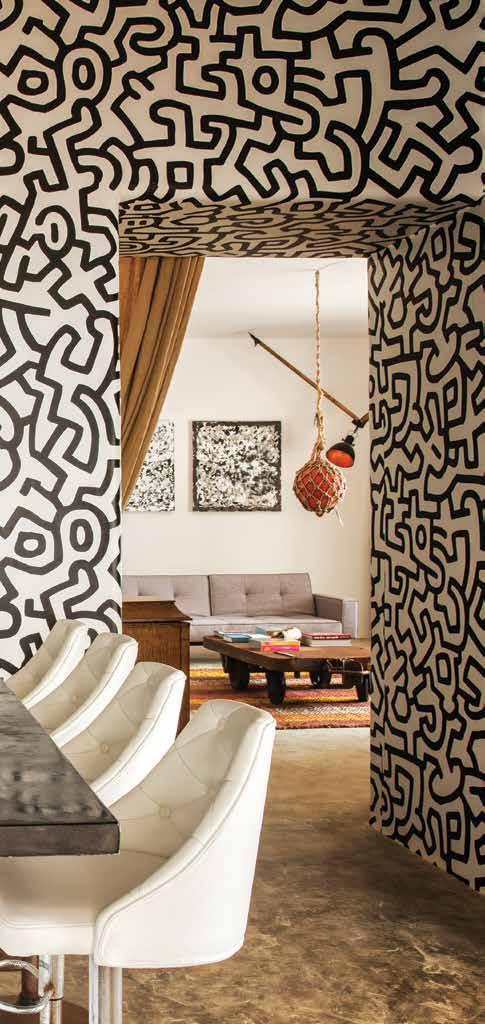
CASA MALCA THE WHITBY
essentially be the same as the Park Hyatt in Tokyo,” says North.
That’s no longer the case. Luxury hotel and resort brands are now seeking to incorporate elements of the surrounding culture in their design to provide guests with an authentic sense of place.
Looking locally, both Crown Towers Perth and the newly open InterContinental Perth have worked closely with Western Australian-based artists to commission new artworks for their guest rooms. Respectively, a 6000-piece ceramic wall sculpture and a large-scale glass installation suspended from the ceiling take pride of place in each of the hotel’s grand lobby spaces. In Hobart, the Federal Group have just opened Macq01, Australia’s first storytelling hotel. The tale, one of the surrounding history, is told in every element of the hotel’s interiors including artefacts, commissioned illustrations on the room doors and bedheads, and locally made furnishings.
As part of its recent refurbishment, InterContinental Singapore littered references to local Peranakan culture throughout, with the Concierge Lounge modelled on the design of a Peranakan living room and fitted out with trinkets representing the surrounding Bugis precinct. Traditional Kampong villages have influenced the design of the new Ritz Carlton in Langkawai; and the incoming Mandarin Oriental property in Beijing will be housed in the 13th-century Qianmen East Hutong Quarter in an architectural style based on Beijing hutongs.
More recently still, IHG launched a new luxury hotel chain, Hotel Indigo, with an overarching local concept. Each of the 75 hotels, spread across four continents, is designed to reflect the surrounding neighbourhood with furnishings and interior decor constructed by local artisans and embedded with references to small histories and culture.
“It creates a sense of arrival, not only by the decor, but by feeling part of the local area,” says Kemp. North adds: “And now, as opposed to being just a holding place, the hotel gives guests a chance to springboard into the local community.”

www.luxurytravelmedia.com.au 157
THE SLOW
TOMMASO RIVA
Salute the sun





Likuliku Lagoon Resort was the first in Fiji to introduce luxury overwater bures and, as Kelly Allen discovered, the Malolo Island favourite is still leading the way
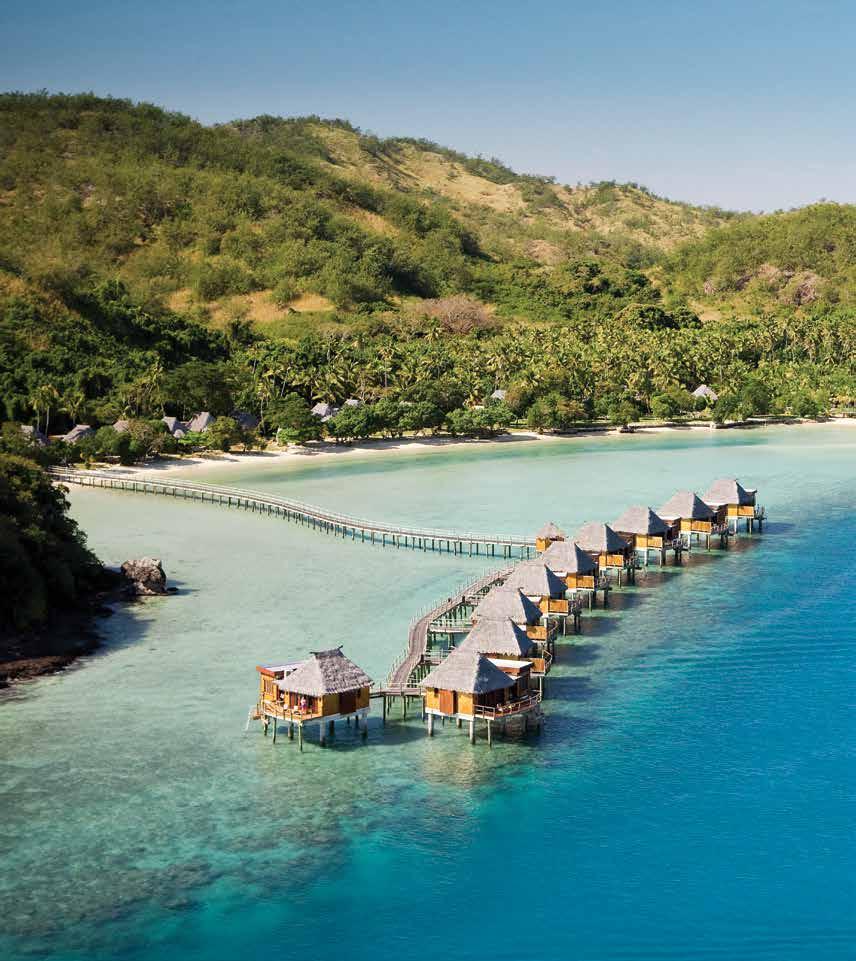







158 www.luxurytravelmedia.com.au
Legend has it the island of Malolo was created by the gods to provide the sun with a place to rest. Likuliku Lagoon Resort is nestled within one of Malolo’s calm lagoons, and as I gaze into the warm glow of the fading sun from my deck chair, a cold Fiji Bitter in hand, I can see why they thought this was the perfect place to end the day.
Popular with honeymooners, this adults-only resort lies within a group of islands known as the Mamanucas, a 10-minute flight with Pacific Island Air seaplanes from Nadi International Airport. Likuliku was the first in Fiji to incorporate overwater bures when it opened 10 years ago, but with all rooms offering ocean views, you can’t go wrong with any accommodation style. The deluxe bures are dotted throughout the lagoon, and all have direct sand access, a private plunge pool, an open cabana with a day bed, large indoor and outdoor showers, and oversized split-level interiors. Those over the water have a built-in glass floor panel for fish gazing, and a ladder that drops right into the lagoon. The view from the freestanding tub is incredible.

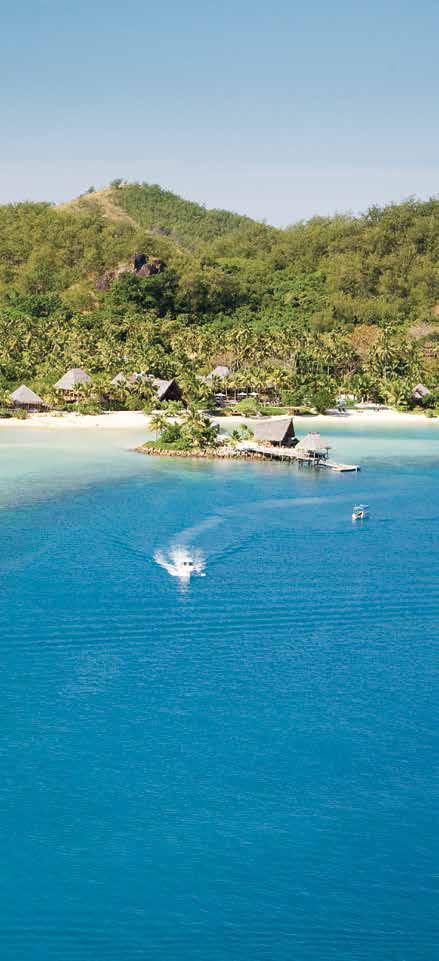












I love staying at a luxury resort that considers its environment and Likuliku is committed to conservation in many ways including turtle conservation, dry forest regeneration, and the Na Tabu (no take) initiative, which forbids fishing or the collection of coral or shells. The newest initiative is to increase habitats and breeding opportunities for the critically endangered Fiji crested iguana. General Manager, Steve Anstey, and Environmental Manager, Sia Rasalato, are passionate about species conservation and see the implementation of wildlife management programs as essential to Fiji’s global appeal. The crested iguana is on the International Union for Conservation of Nature’s Red List of Threatened Species and was actually thought to be extinct until 2010. In September last year, Likuliku welcomed the arrival of its first baby iguanas bred in captivity.

www.luxurytravelmedia.com.au 159
LIKULIKU | FIJI STAY
LIKULIKU FIJI













160 www.luxurytravelmedia.com.au
Because fishing is not permitted, a large number of fish call this lagoon home. Jumping into the sea from the end of the jetty is like diving into an aquarium with dozens of bright blue starfish, small rays, and amazing yellow and black striped tropical fish leisurely cruising about. They seem to be used to the attention as they are not afraid to swim in close for a better look. This underwater adventure started my morning routine, before I meandered to the lavish breakfast buffet for a healthy DIY green juice and fresh coconut, and maybe a not-sohealthy twice-cooked gruyère cheese soufflé.
The food is a highlight, especially after the return of Australian chef Shane Watson, who was with the resort when it opened in 2007. Every meal on the ever-changing menu is expertly executed and perfectly presented. I thoroughly enjoyed the tea-smoked salmon with sweet pork, chilli, lime and green papaya, followed by steamed mama snapper and orange almond cake topped with crème fraîche for dessert. If you wish, dinner can also be served under the stars.
There are plenty of activities from water sports (including great snorkelling on more than 40 nearby dive sites) to beautiful nature hikes such as the trail to Jona’s Lookout, boasting views over the entire resort and beyond. There are two villages on the island that you can visit and if you are there on a Sunday, the Yaro Village church choir performance will give you goosebumps. There are also fishing trips, sunset cruises and world-famous surf breaks to catch.
But it was the island-hopping trip that I loved most. Starting at 7am, before the trade winds blew in, we headed for a tour around several neighbouring islands before stopping for a swim, snorkel and nature walk on the beautiful Monuriki Island (where Cast Away , starring Tom Hanks, was filmed). Back on the boat, we snack on tropical fruits, coffee and pastries before our next stop at Mana Sand Bank. This is the most spectacular miniature sand bar; a pure white speck in the middle of the turquoise expanse. Snorkelling just offshore, we spot a turtle and gently cruise behind it for a while, until more brightly coloured fish catch our attention with vivid arrays of coral and a curious – yet harmless – white-tipped reef shark off in the distance. For me it was the perfect deserted-island experience to top off the perfect island holiday.
See more images from this story at luxurytravelmedia.com.au






Stay







Rates start from FJ$3,200 (about A$2,000) per night for an overwater villa and include all meals, but not alcohol. likulikulagoon.com
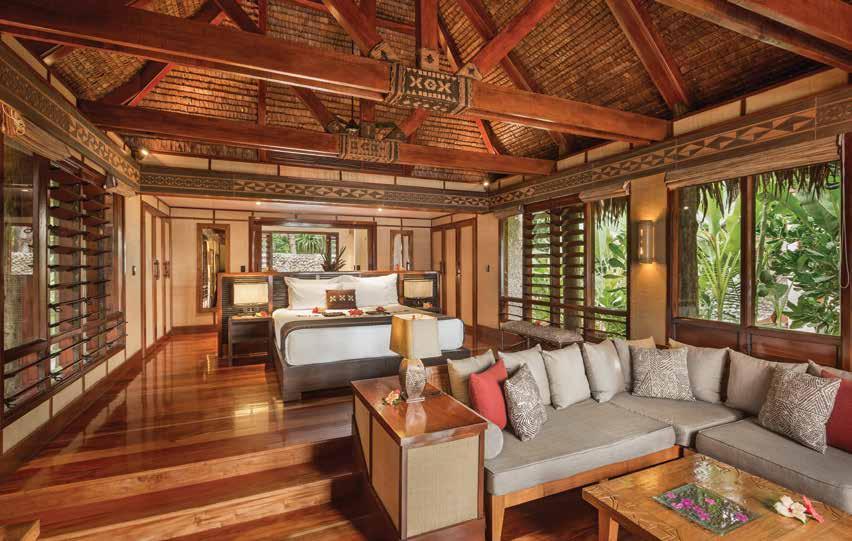
www.luxurytravelmedia.com.au 161
Slice of paradise

Tokoriki Island Resort claims to offer a romantic, relaxing and refined escape. Kelly Allen finds the adults-only resort lives up to its reputation.
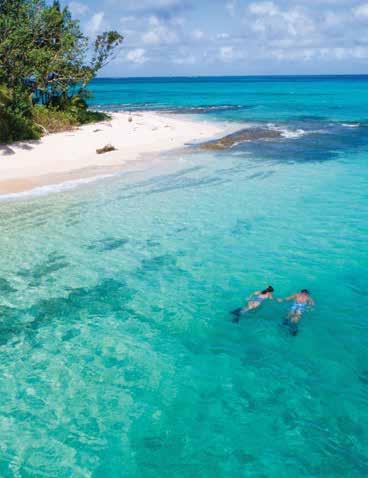
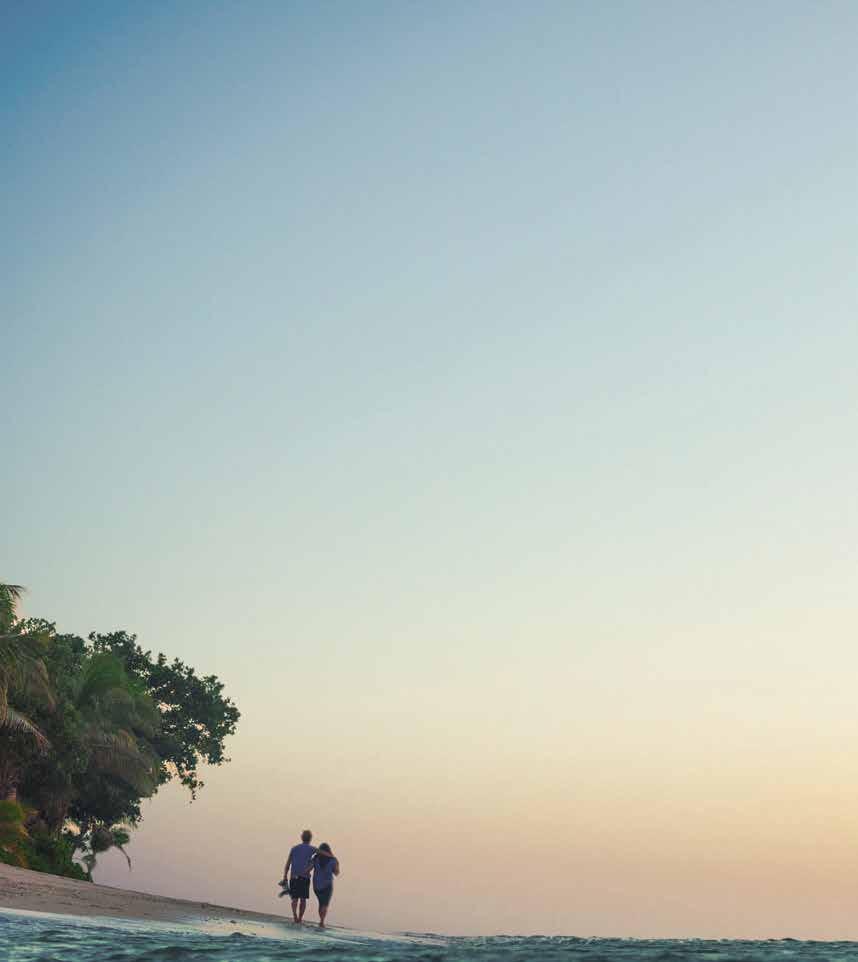
Less than an hour after touching down at Fiji’s Nadi airport I’m in the air again. Cruising at a much lower altitude, the seaplane floats over clusters of tiny islands covered in lush foliage and dwarfed by the mesmerising vastness of the turquoise Pacific Ocean. The 15-minute flight leaves me wishing for more air time, but landing at Tokoriki Island Resort, with the beautiful harmonies of Fijian voices singing in the background, thrusts me happily into the present.
It’s hard to think of a more welcoming country than Fiji. Whether it be at the airport or on the islands, it is a rite of passage to be serenaded with a traditional welcome song, full of spirit and energy, and ending with a triumphant “Bula!”












Tokoriki Island Resort prides itself on being a ‘romantic, relaxing and refined’ escape, and my first impression indicates this is true. There are couples relaxing in sunbeds around the infinity pool, reading books (the old-fashioned kind) and playing cards. Surprisingly, I don’t spot a mobile phone, laptop or tablet anywhere. WiFi is complimentary, but everyone looks to be on Fiji time and is happily unplugged. There is a big timber cocktail bar under a thatched roof in the centre of it all and, as Tokoriki is an adults-only resort, the only sounds I hear are the water lapping against the sand and infectious laughter from Moses, one of the friendly local staff members.
The staff at Tokoriki are a loyal bunch. Moses is a familiar face from my last visit and I learn he has been here for more than 25 years.
162 www.luxurytravelmedia.com.au
TOKORIKI FIJI STAY TOKORIKI
LIKULIKU FIJI
He usually runs the sunset torch-lighting ceremony and he sports a cheeky sense of humour. Chef Ash Singh started his career at Tokoriki 20 years ago. Since then, he has travelled the globe, perfecting his skills in Dubai, New Zealand and Vietnam, and has recently returned to Tokoriki to head up the main restaurant (lured back by a new million-dollar kitchen). He is an outstanding addition to the team. His pho with crispy panko chicken was mouth-watering and his kokoda (Fijian ceviche) delicious.
The other dining option is Oishii Teppanyaki, an open-air restaurant that seats just eight. Oishii is both delicious and entertaining. There is a lot to like about sitting around the intimate teppanyaki table, eating fresh seafood and prime red meat delicately delivered to your plate courtesy of the chef’s fluid knife skills. The company is easy and the vibe carefree.
My sunset pool villa is a mix of contemporary style and traditional Fijian accents, and has both indoor and outdoor showers, a separate living area, an open cabana with a day bed, and an infinity edge pool. Stepping off my pool deck and on to the grass takes me directly to the sand, just metres from the ocean’s edge. Every morning I have a dip and try to encourage the tiny fish closer. The water is a pleasant 26°C and so clear I can see to the bottom.
The spa has a reputation for being one of the best in Fiji. Built on the side of a hill it features gentle waterfalls and outdoor showers. There are unlimited massage packages available, ensuring you’ll head home revitalised and relaxed. I decide to go for the traditional Fijian bamboo massage,
which involves gently rolling out muscle tension with a piece of bamboo. It sounds strange, but is fantastic and unlike any massage I’ve had.










As you would expect, most of the activities revolve around the ocean. Head to the house reef for a snorkel or take a stand-up paddleboard, Hobie Cat, windsurfer or kayak for a cruise around the island (all non-motorised watersports are complimentary). You may want to visit the local village or try your luck at sport fishing. Couples will love the island picnic. You’ll be dropped off on a secluded stretch of sand on a nearby island for beachcombing and snorkelling, accompanied by a sumptuous picnic and a bottle of Moët.
When it’s time to say goodbye, the traditional farewell song Isa Lei, sung by the beautiful staff, will ensure this slice of paradise stays in your daydreams for a long time to come. As the lyrics say, “forget not when you’re far away, over the ocean your island home is calling”.
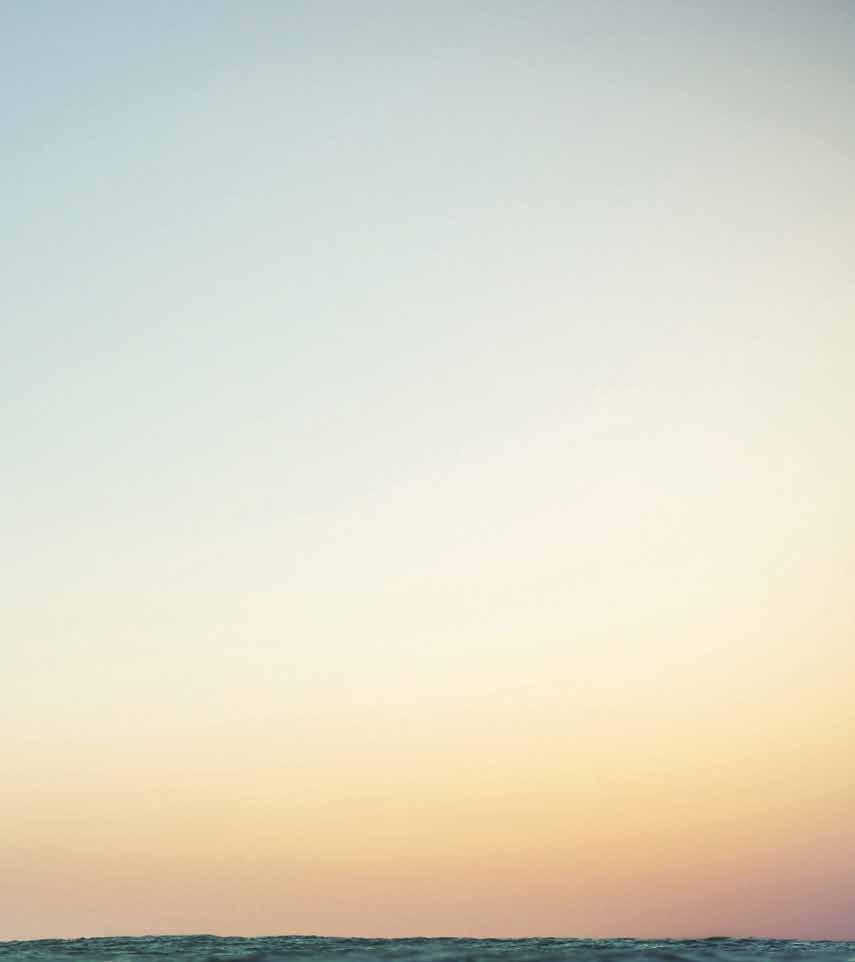


See more images from this story at luxurytravelmedia.com.au
Stay

Rates start from FJ$1,295 (about A$819) per night for a beachfront bure. Meals plans are available for FJ$250 (about A$158) per person per day. tokoriki.com
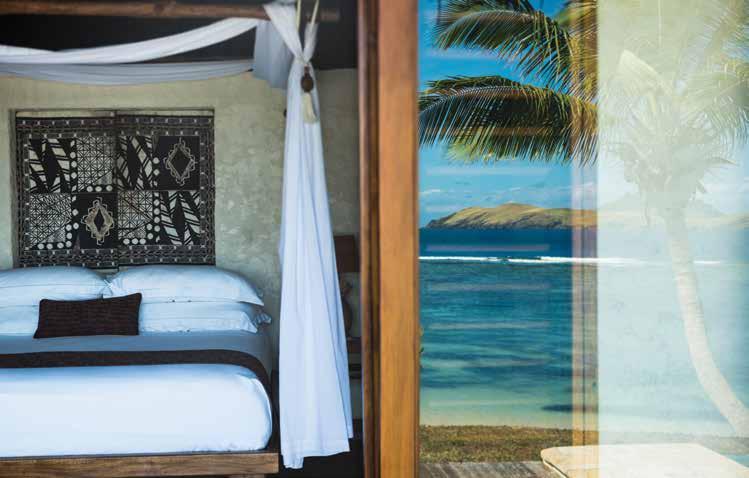
www.luxurytravelmedia.com.au 163
Beachfront bliss

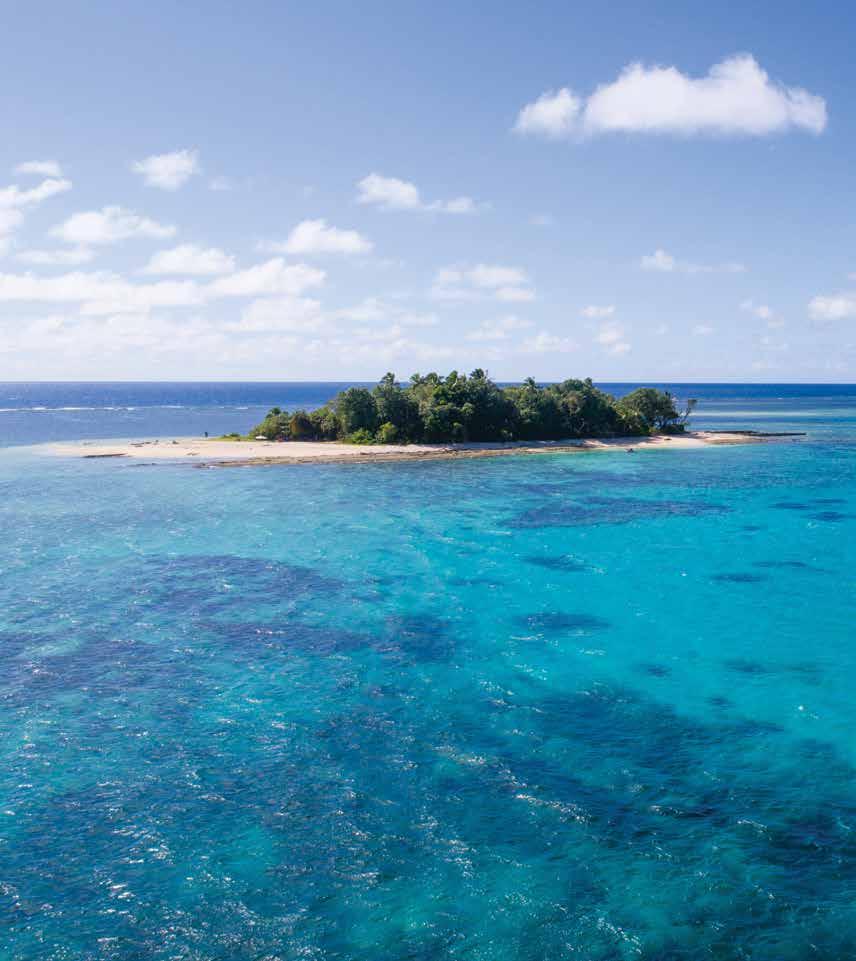












164 www.luxurytravelmedia.com.au NANUKU TOKORIKI LIKULIKU FIJI
NANUKU FIJI STAY
Richard Bunting checks in and clocks out with a luxurious stay at the Nanuku Auberge Resort.
Bula!” is the first word we hear on passing through the gates into the sanctuary that is Nanuku Auberge Resort. Nestled on Rovodrau Bay, at Pacific Harbour on Fiji’s southern coast, the resort boasts three kilometres of private beach frontage, and a dedicated family of staff who will make your stay memorable.
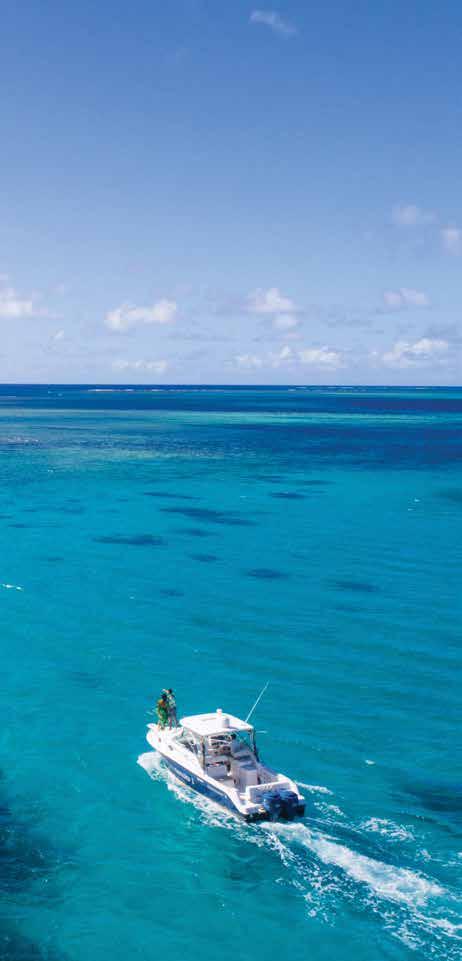







Our driver pulls up outside reception, where we are greeted with more hearty salutations, and big smiles, as we step out of our vehicle. Drums begin to beat for a traditional Fijian welcome, and our arrival is accompanied by this warm, rhythmic entertainment. Already we feel at home. Breathing in the fresh sea air deeply, we sit back in our golf cart for the trip to our One-Bedroom Beachfront Grand Pool Residence, past sprawling lawns and the resort pool, and a vista of the vast ocean.
Residence by name, but house by size, it sprawls for 200 square meters over two floors. We are immediately introduced to our ‘villa mama’, who is on hand for our every need during our stay. Residences also include a Nanuku buddy for all manner of tasks, such as bookings and maintenance. The open-plan ground floor reveals views to Pacific Harbour, with the sun reflecting off the peaks of rippling ocean waves. It’s inviting; it won’t be long until we pay a visit to the beach activities team.
But before we head out, the second storey deserves exploring. The bedroom is big, comfortable and well-appointed. The centrepiece of the open bathroom is a beautiful bath, from where the harbour can again be seen, beyond a large private balcony.

Outside, a full-sized pool and loungers appear to complete the picture, until I spot another room. The surprise is very welcome – an extension of the lounge room serving as our very own movie room. This explains the popcorn machine and corn kernels in the kitchen; a nice touch. The residence we have chosen has ticked all the boxes.
By early afternoon we are on bicycles, which are supplied to all guests, and riding the short few hundred metres to Kanavata Restaurant, located at the Clubhouse. The kitchen uses local produce and the fresh seafood is delicious. We easily finish a sumptuous and filling lunch complemented by matching wines.
The rest of our stay is spent visiting a local village, white water rafting, venturing on gentle walks, and taking a short drive to the capital, Suva, on a shopping expedition.




Nanuku Auberge Resort offers a wide choice of room types, all set in a peaceful and relaxing environment. The exceptional, friendly and personalised attention to every detail had us hooked from the get-go, and reluctant to leave. Could we extend our stay? Alas, not this time. But we could book our return for the very near future.

www.luxurytravelmedia.com.au 165
more images from this story at luxurytravelmedia.com.au
per night for
Bedroom Beachfront Grand Pool Residence. nanuku.aubergeresorts.com
See
Stay Rates start from FJ$3,485 (about A$2,205)
a One-
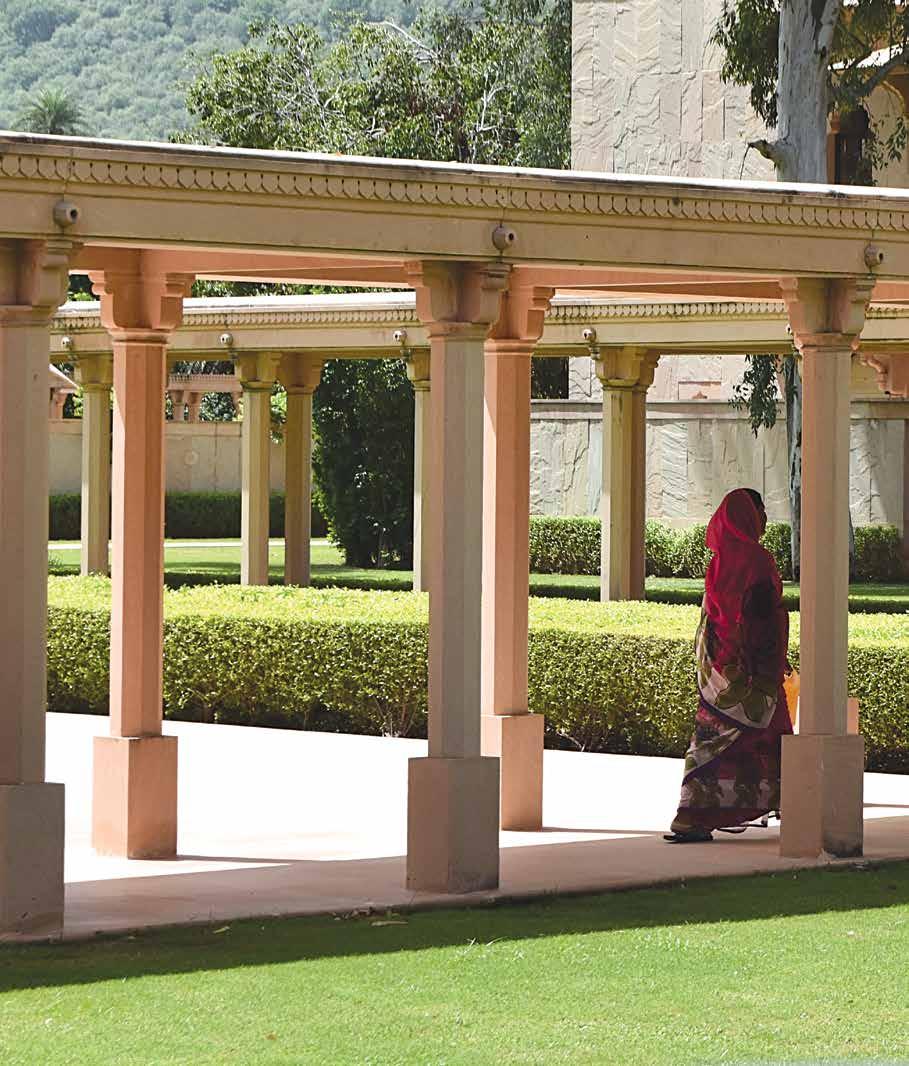
The secret garden
With a grand backdrop and striking Mughal architecture, Amanbagh resort leaves Katie Milton feeling like royalty.
Images by Katie Milton & Kristen Jeffery

We arrive at Amanbagh as dusk sets over the Aravalli Hills, India’s oldest mountain range. The peaks, once higher than the Himalayas but worn down over millions of years, tower in front of us, and the Indian sun envelopes the sky in a red glow. Our driver continues down a skinny dirt road before stopping outside an aged fortress wall. Beyond the gates, in the fading sunlight, the façade of the peach palace takes my breath away.
A 90-minute drive from Jaipur on the border of Sariska National Park, a Bengal tiger sanctuary and popular site for safaris, Amanbagh is enclosed by a 300 year old stone wall on the land that was once a campsite for Maharaja hunting parties. Designed by one of Aman’s favourite ar-

chitects, Ed Tuttle, the resort has just reopened its doors after its annual two-month hiatus during the peak of the dry Indian summer.
After performing a traditional Hindu blessing, our welcoming party leads us down the palace steps. A long pool runs down the centre of the property, illuminated by soft lights and flanked by towering date palms and eucalypt trees. It was this uncommon combination that took the attention of Aman’s then-owner when he was searching for a site to build a new resort. Fittingly, ‘bagh’ means peaceful garden in Hindi.
Amanbagh’s grounds are set deep in the valley. The air is cool and still here – a thankful respite from the muggy blanket of heat that won’t lift until winter comes in November. I can see lights flickering near the edge of the water; the

unmistakable reverb of a sitar the only sound besides the crunching of grass beneath our feet.
A table is set for two beneath the peach pavilion. The path towards it is lit with small lanterns and purple sparkling curtains are strung between neighbouring stone pillars. The ground is embellished with designs made from freshly cut grass, and marigold and rose petals – the artist of these creations is our waiter for the evening.
I order the thali, an Indian tasting menu comprising small bowls of curried baby eggplant (a specialty dish from Kerala in the south), paneer (fresh cheese), spiced potatoes, cashew nut butter, and creamy spiced dahl that has been slow cooked for almost a week.
As we stroll back to our haveli (meaning ‘majestic building’), bellies bursting with gajar ka
168 www.luxurytravelmedia.com.au
MAIN RESORT POOL
STAY AMANBAGH INDIA
halwa (a deliciously sweet pudding made from carrot, milk, ghee and sugar), it begins to dawn on us that we are entirely alone. The resort is unoccupied save for us, the staff and a mischievous group of monkeys scampering along the boundary wall.

Tweeting birds break the silence of the morning, the sunlight glinting off the water of our private pool, which backs onto the lush garden that skirts around the entire property. Our Pool Pavillion Haveli is a palatial building. The domed bathroom is as big as the sleeping quarters, with a bathtub in the centre of the room cut from one giant piece of green Udaipur marble. These custom-made bathtubs appear in each of the resort’s 37 rooms. They were installed first and the haveli walls built around them.
Morning yoga is held in the same pavilion where we dined the night before. In place of the table are two yoga mats and the sitar player has made way for our yoga instructor, who is dressed in a white set of kurta pyjamas. The
resort has recently introduced a range of individual wellness immersions based on ancient Ayurvedic practices, giving guests the option to use their time in the palace as a personalised health retreat.
But our day has no set schedule. At Amanbagh, guests dine when they like, the sense of royalty reinforced each time we are welcomed with a “hello Sahiba” (princess).
After breakfast in the pavilion, the heart of the house, we climb into a safari jeep with executive chef Rakesh Kumar for a tour of the resort’s vegetable garden. It’s a sizeable plot with Indian gooseberries, mango trees, masala, bulbous cauliflowers, chilli, purple basil, and countless other vegetables and spices. Kumar pulls a stick of lemongrass from the ground and shares his secret for a refreshing beverage: smashed mint with green apple, cinnamon, star anise, fresh water and lemongrass. We discover it is just as delicious as he promises when he surprises us with two chilled glasses as we arrive back at the palace.


As dusk begins to set on our first day we climb aboard the safari jeep with our guide for a sunset tour of the surrounding villages. We pass endless fields of millet; a man crouched on the roadside smoking tobacco from an old pipe; and a procession of trucks filled with locals blasting Hindi music. As we slow down, children start chasing us, climbing onto the back of the jeep, their young faces smiling at us as we peek over and give them high fives. As they jump off the back, waving farewell, our jeep continues along the dirt road, winding its way back to our enchanted peach palace.
See more images from this story at luxurytravelmedia.com.au
Rates start from US$850 (about A$1,078) per night for a Courtyard Haveli Suite. aman.com/resorts/amanbagh

www.luxurytravelmedia.com.au 169
Stay
EXECUTIVE CHEF RAKESH KUMAR
KRISTEN & KATIE ON THE COW DUST TOUR
LOCALS CHASING THE SAFARI JEEP
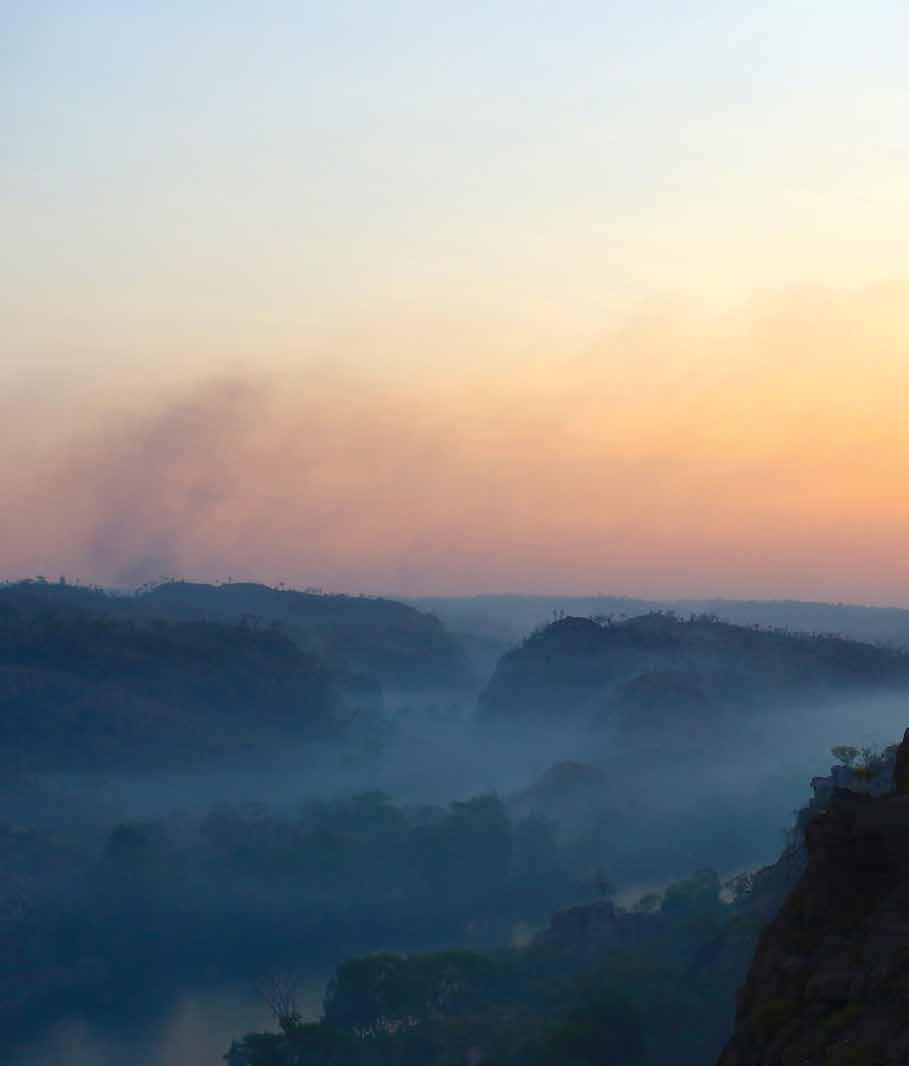
170 www.luxurytravelmedia.com.au JENNIFER PINKERTON
The Katherine calling
Jennifer Pinkerton uncovers a new breed of luxury deep in the wilds of the Northern Territory.
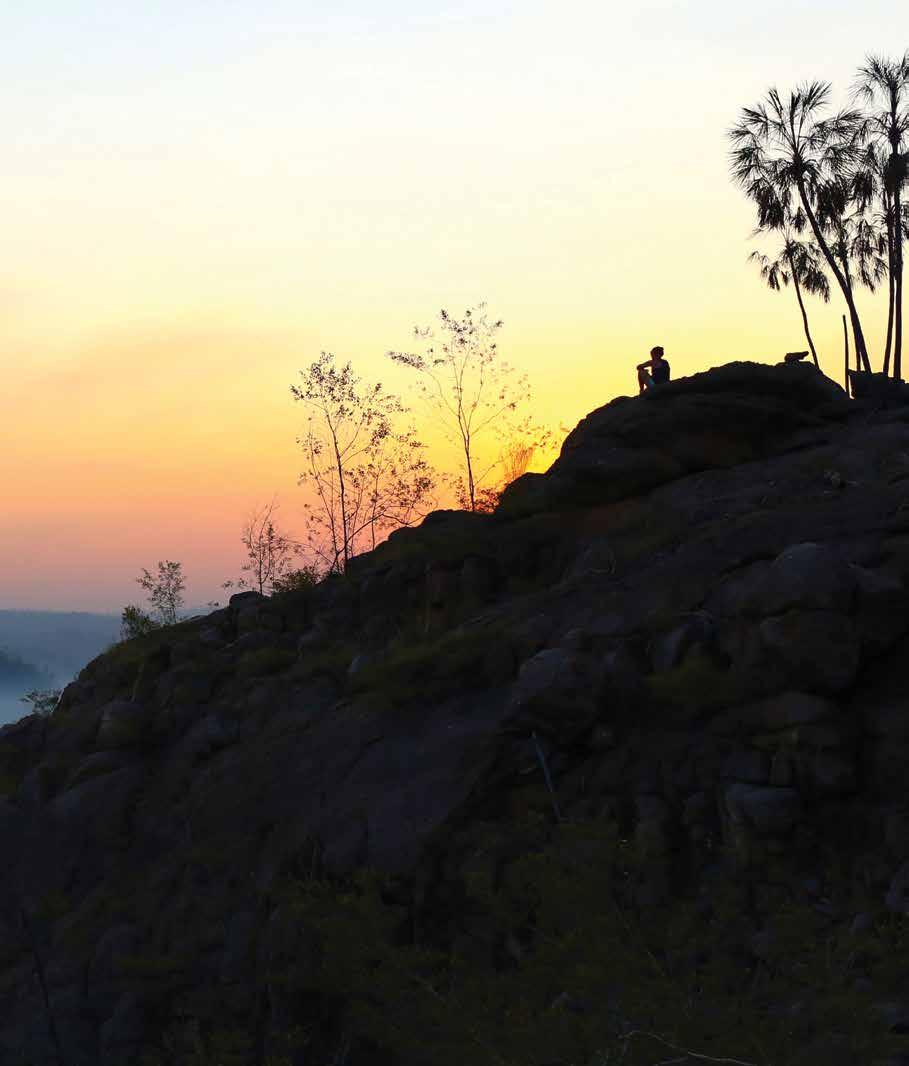
As we glide along Gorge Road, 20 minutes outside the township of Katherine, the sky darkens from pale blue to indigo and a huge moon appears before us. It’s blood orange and, to be honest, a little eerie. A blanket of bats floats past and the surrounding landscape starts to rise up. Scrubby bush, littered with ochre boulders and termite mounds, morphs into lofty escarpments. We’ve reached the Nitmiluk National Park entrance and, a few minutes later, we’re at Cicada Lodge, our home for the next two nights.
Despite the spooky backdrop, there’s nothing spooky about Cicada –or the park for that matter. Owned by the Jawoyn Association Aboriginal Corporation, the area’s traditional owners who received joint park management rights in 1989, Cicada is a luxury eco-lodge set among a native garden that teems with wattle, bottlebrush and banksias. Just beyond sit the towering walls of Nitmiluk Gorge, and beneath these, the Katherine River.

NORTHERN
STAY
TERRITORY CICADALODGE
www.luxurytravelmedia.com.au 171
We meet our host, Steven, in the entrance-cum-dining room before he leads us to one of 18 discrete units. Cicada can host 36 guests at any time, and our suite feels a bit like a one-bedroom house. A small, walled balcony kisses the bush. A king-sized leather bedhead divides the room, seamlessly creating a separate space for working (no thanks!) or preparing java from a coffee pod machine. The glass-walled bathroom features an enormous rain shower and stone-finished amenities, while lamps cloaked with butterfly print fabric adorn the room – a nod to the lodge’s natural surrounds.
With time against us, all we can manage this evening is a quick dip in the pool, which borders the bush, sits just outside the restaurant and, at night, glows a neon shade of blue. Leaving the unit’s cocoon, I step out in my best 1950s swimming costume and brave the balmy air. I am attempting backstroke when Steven appears bearing welcome drinks and canapés: a bounty that includes flutes of champagne, olives, bruschetta and barramundi ceviche. My cool-down is secured and shortly afterwards I drift to sleep while night birds trill beyond the room, communing with the oversized moon in the distance.
Night turns to day and we wake early, hike the first gorge and marvel at the low clouds covering the river. Back at the lodge, a delicate breakfast awaits. Bircher muesli in tumbler glasses, a croissant and savoury platter, plus a colourful bouquet of tropical fruit. Later we spruce up for a morning cruise along Nitmiluk’s first and second gorges.
Strolling the path towards the jetty, what I first assume to be large dark berries hanging from trees, reveal themselves to instead be colonies of red flying foxes, a protected species in the Northern Territory. Our cruise guide, Casey, explains this is the largest population of bats seen in the park in 25 years.
Our boat slowly slips away from the jetty. On either side of the water,
lush foliage sits in vertical rows and more creatures make their presence known. On the riverbanks, two wallabies hop by; sulphur-crested cockatoos soar in the sky; and archerfish zig-zag through the waters below.
After an afternoon spent canoeing, exploring the gorge at a slower pace, we re-board the boat for a dinner cruise. As the sun sinks, hundreds of bats leave their tree branches and travel beyond us, up the gorge.
We explore the second gorge on foot and receive commentary on Nitmiluk’s history, culture and ecology before sitting down for our three-course candle-lit dinner. Tables are formed by pairing couples and lone rangers, and we find it refreshing, after having the day to ourselves, to tune in to others’ travel tales.
Enfolded between the immense walls of the gorge, sculpted into cube-like patterns by passing time and water, the evening blends into night. As our champagne drains away, the last trail of bats silently drifts above and another huge moon ascends, it dawns on us, as it does on our new friends, that this – peace and immense, abundant nature – are among the greatest luxuries of all.
See more images from this story at luxurytravelmedia.com.au
Stay

Rates start from A$495 per room (based on twin share) and are inclusive of welcome drink on arrival, canapes and drinks on the pool deck at sunset, daily gourmet breakfast and complimentary WiFi. cicadalodge.com.au
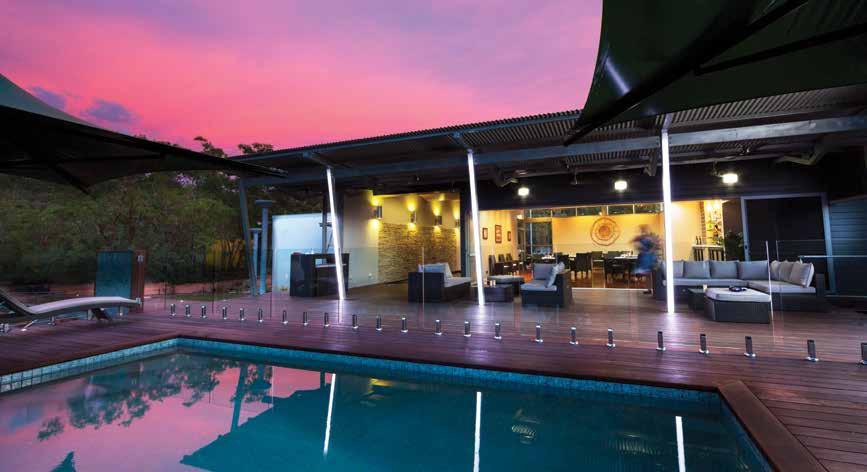
172 www.luxurytravelmedia.com.au
LOUNGING POOLSIDE
EXCLUSIVE BAREFOOT LUXURY ULTIMATE PRIVACY AND RELAXATION
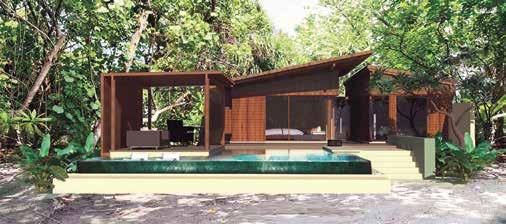

UNPARALLELED SNORKELING AND DIVING DISTINCT DINING EXPERIENCES
A pure barefoot paradise – upgraded. In addition to our luxurious villa options, our new Deluxe Park Pool Villas at 265 sqm and 2-Bedroom Park Pool Villas at 300 sqm include a 55 sqm pool and an outdoor bale. Enjoy the extra space, rest and relax with your extended family, enhancing your truly unique Maldivian stay experience.
Located at the heart of one of the largest and deepest natural atolls in the world, Hadahaa is untouched and authentic, providing you a private and secluded island resort experience.
To learn more, visit maldiveshadahaa.park.hyatt.com
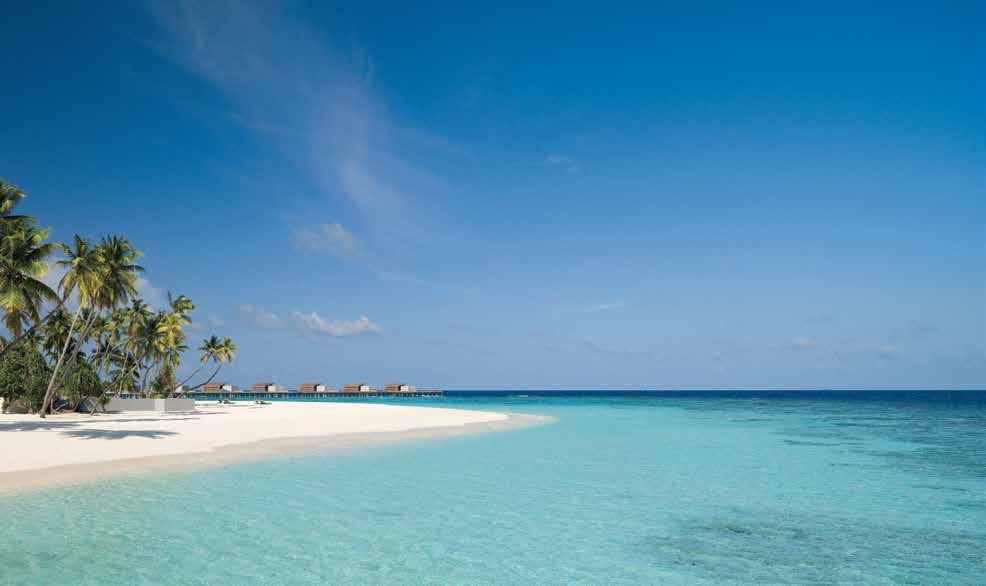
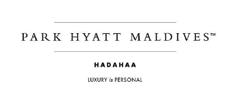
The Park Hyatt™ trademark and related marks are trademarks of Hyatt International Corporation. © 2017 Hyatt International Cor por ation. All rights reserved.
Southern charm
Boasting 300 days of sunshine each year, Cam Ranh is set to become Vietnam's next beachside favourite. Luxury resort The Anam just sweetens the deal.
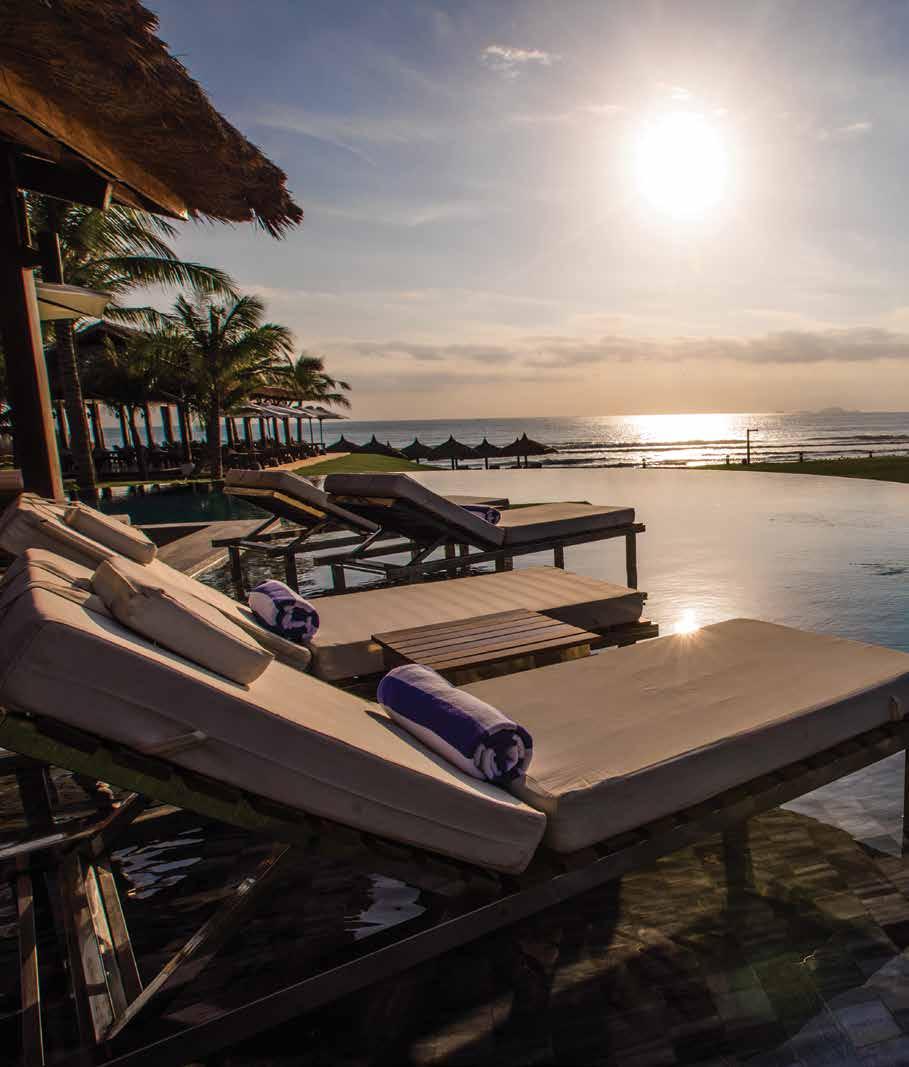 By Rachel Lees
By Rachel Lees
174 www.luxurytravelmedia.com.au
THE ANAM VIETNAM STAY


Ayoung woman wearing a figure-skimming, ecru áo dài (traditional Vietnamese dress) waits inside the doors of the arrivals hall at Nha Trang Cam Ranh International Airport. The small placard she holds bears the paper fan-inspired logo that identifies The Anam. Though I have yet to step off the tarmac, as we make eye contact her face relaxes into a smile and she bows.
Once I step inside the terminal, the next few minutes are a haze of refreshing peppermintscented hand towels and bottled water before I’m ushered into a chauffeured car. Though we did both, I barely recall collecting luggage or passing through airport security – such was the swift and elegant navigation by my host.
Within 20 minutes, we turn into the driveway of one of the most discerning new addresses on Vietnam’s Cam Ranh peninsula. Opened in September 2016, The Anam is an opulent nod to a bygone era. Mosaic tile and stone pathways lead to decorative pools, lined with big-bellied water vases. The imperialstyle roofs of the villas – of which there are 117, plus 96 rooms and suites – peek out behind palm trees like coy ladies trying to shade their faces with paper fans.

But it’s the coastal location that is perhaps most captivating. Song Lo, a dramatic headland, rises to the north and west. Set on 30 idyllic acres, the resort and its vast green lawn act as a sprawling welcome mat to Bãi Dài (Long Beach). Beyond the 300-metre long stretch of sand, the warm South China Sea glimmers invitingly.
The property’s 3,000 palm trees sway with the ocean breeze, which catches the scent of frangipani, infusing the air with a salty floral perfume. Cam Ranh receives around 300 sunny days per year and average temperatures of 26°C. However, in a cruel twist of fate, today is one of those 65 days of inclement weather. As I abandon the idea of taking a dip, I realise that between the international flights and changing time zones I’ve skipped lunch.
Keen to freshen up, I retreat to my airy 50-square metre villa to order room service. With Vietnamese hand rolls, and a green mango and tiger prawn salad on the way, I
open the doors to the bathroom and say a silent thank you for rainy afternoons. Floorto-ceiling windows surround a deep soaking tub, which looks onto a small private garden of tropical plants. Post-soak, I succumb to the king-size bed, wrapped in 300 thread count Irish cotton sheets.
The next morning, sunrise casts a golden glow over the resort and resident yogi Umesh, who leads a small group through a complimentary yoga session on the lawn. Keen to make the most of the clear skies, I catch the free 9am shuttle bus into the town of Nha Trang – a 30-minute trip – to join a Vespa tour organised by the front desk. Lam, the affable guide from Nha Trang Vespa Tour, introduces me to Vietnamese coffee; an 87 year old artist who crafts animals and cutlery out of coconuts; and the mysteries of seventh century Cham temple Po Nagar.
After five and a half hours spent riding pillion in Nha Trang’s free-flowing traffic, there’s only one place for me: Sri Mara Spa. Prior to Vietnam’s expansion southward from the Red River Delta in the 15th century, Cam Ranh was part of the Kingdom of Champa. In honour of the area’s history, The Anam’s spa is named after the first Cham king. Treatments, however, are Balinese, with a focus on traditional Asian healing techniques.
Later that night, beneath a dozen white paper lanterns, I listen as a pianist tinkles away on a baby grand at Indochine Grill, the resort’s fine dining restaurant. In between mouthfuls of expertly grilled lamb and bold Australian shiraz, I marvel at how quickly I’ve slipped into relaxation mode. And yet, my time at The Anam seems too brief. I haven’t watched a film at the resort’s 3D cinema, or been snorkelling or kayaking off the beach. There’s a new Greg Norman-designed golf course down the road, too. And then there’s that sunrise over the South China Sea, you could watch that for days.
Rates for the Garden View Villa start from US$190++ (about A$247) per night, including breakfast. theanam.com
www.luxurytravelmedia.com.au 175
Stay
The large, cobalt blue water feature on the side of the hotel sets the tone for what awaits inside this stylish, botanic-themed luxury hotel.
Sofitel Wellington became the New Zealand capital’s first new luxury hotel in more than a decade when it opened its doors in July 2016. But the celebrations stalled when a fire tore through the on-site restaurant, Jardin Grill, in December, forcing the five-star hotel to close for repairs.
It reopened to the public in October 2017, and the floral and French-themed finery so warmly received last year has been brought back to the fore.

Walking past the large, marble lions at the entrance – a signature Sofitel touch around the world – I step into the foyer of the Sofitel Wellington, and am immediately impressed.
Friendly staff check me in while I’m tempted to have a wander around the lobby and take in all the elements of this NZ$51million development (a price tag that ignores the undisclosed rebuild costs). A rounded bowl vase filled with numerous flower cuts sits on a large, black marble table while a leafshaped copper light illuminates the scene from above. Oversized teal and olive velvet sofa chairs sit amidst framed botanical paintings, lacquered wood gum coffee tables, sheer metallic curtains, silk cushions and copper pendant lights.
The hotel’s designers, New Zealand firm SPACE Studios, in collaboration with AccorHotels director of interior design for Asia Pacific, Stephane Lombard, have opted for a botanical theme in reference to the hotel’s location at the gateway to the magnificent Wellington Botanic Gardens and as an homage to Sofitel’s French roots and the world-famous Parisian Luxembourg Gardens.
I’m shown to my accommodation on the 12th floor, a luxury king room. It is the top room category of the hotel’s 127 rooms, but for something even more luxurious, the hotel has two suites to choose from. The Prestige Suite, which has interconnecting rooms, or the Opera Suite, the hotel’s premier option and the choice of visiting dignitaries. The suite is also known as Le Miellerie (French for
Back in bloom
Wellington’s newest five-star hotel is back in business following a forced hiatus. Katrina Holden checked in to experience Sofitel Wellington’s French connection.
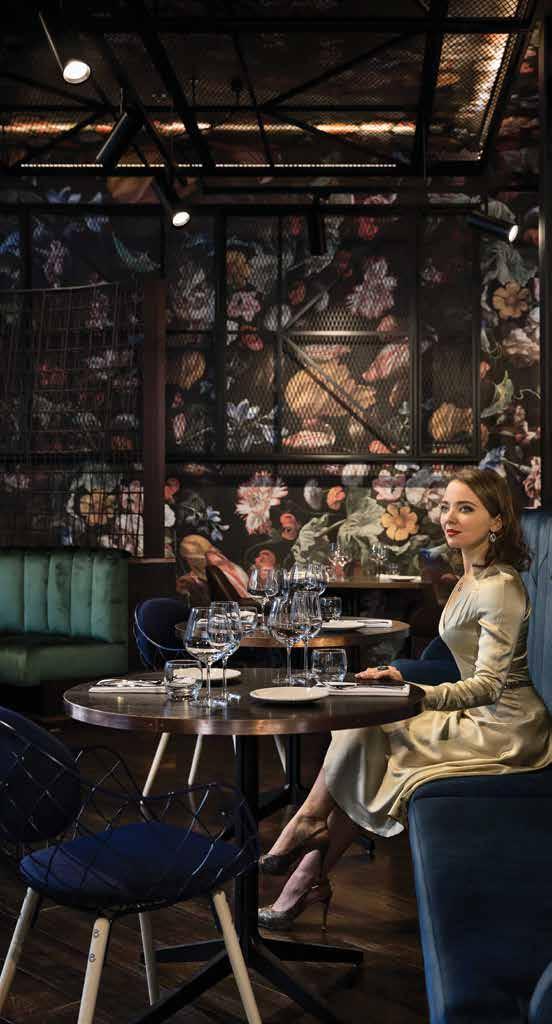
176 www.luxurytravelmedia.com.au
SOFITEL | WELLINGTON STAY
BOTANICAL INFLUENCE AT JARDIN GRILL
The Honey House), as it overlooks the ‘Beehive’, the rotunda-shaped executive wing of the Parliament Buildings.
My room is spacious and refined with sophisticated French glamour coming through in the combination of black, mocha and metallic hues. The king-sized MyBed sits against a striking, silver crushed-velvet headboard flanked by large golden lamps, and a fiveoption pillow menu offering various levels of firmness. Hovering above the desk is a series of framed botanist prints and butterflies. Glossy black veneer wardrobe doors with leather handles open to reveal his-and-hers soft white robes piped with a chocolate-coloured trim.
The bathroom has French-style gloss black rectangular wall tiles and delicately displayed Lanvin “Orange Ambre” amenities. There’s no bath, but ample room and a decent-sized shower with strong water pressure. My favourite design touch in the bathroom is the etched script on the frosted glass door, on one side quoted in French and translated on the other side in English as “Let my kisses be the words of love that I don’t say”. Puzzlingly, there’s just one towel rack for those large, plush white bath towels, but thankfully a couple of bathroom hooks too.
The revived Jardin Grill features a bold floral fresco on one large wall and across the ceiling; a sculptural artistic wine wall; and a large open copper kitchen. The botanical theme continues into breakfast where the cereals and muesli are displayed in botanic-style jars and diners scoop their chosen food with floral trowels. The Green Room bar in the lobby is buzzing with activity and butterflies of the social kind as I savour a cocktail on the green velvet Chesterfield sofa chairs in front of the warmth of the Real Flame gas fireplace framed by marble. It’s a peaceful place to relax after having strolled the nearby scenic Botanic Gardens to fully appreciate the design connection of this floral city retreat.
Stay

Rates at Sofitel Wellington start from NZ$269 (about A$243) per night.

sofitel.com/wellington

www.luxurytravelmedia.com.au 177
THE LOBBY
GUESTROOM
When it comes to beachfront luxury,
Infact, we’ve been voted the number one hotel in Palm Cove and one of the top five hotels in Australia by Tripadvisor.


But that’s not surprising, because Alamanda at Palm Cove is one of the only places in Far North Queensland to offer direct beach access, as well as luxurious beachside suites, the critically acclaimed Nu Nu restaurant and our multi-award winning day spa. And if that’s not enough, we also cater for families with extra-large apartments, a family pool zone and games room.
So no need to search TripAdvisor to find the perfect Palm Cove luxury accommodation, come straight to us.
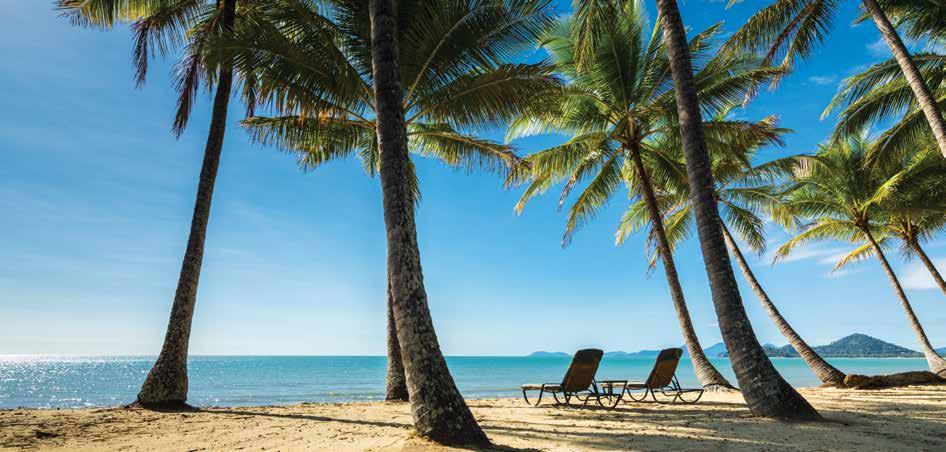
Book at palmcove@alamandapalmcove.com.au or call 07 4055 3000
www.lancemore.com.au/alamanda

we’re way out in front.
Manhattan Royalty
One of Manhattan’s original 19th century skyscrapers, the historic building at 5 Beekman Street, was transformed into luxury hotel The Beekman at the end of 2016. More than a year after the hotel’s official opening, the highly anticipated penthouse suites have finally been unveiled, housed in the building’s dramatic twin turrets.
Accessible only through a private entryway on the 10th floor, the Turret Penthouse Suites have retained their original 12-metre pitched
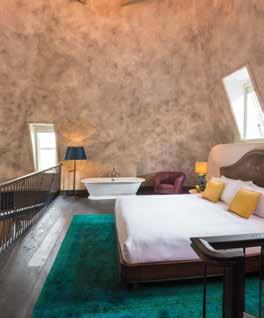
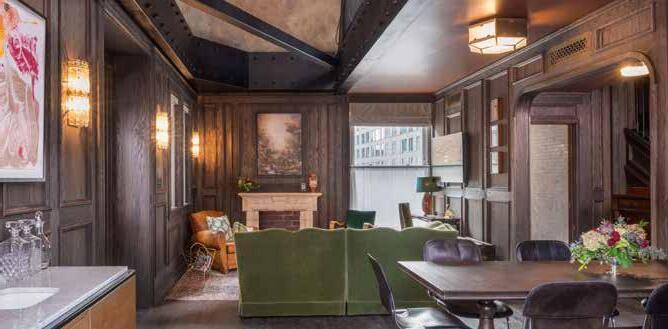
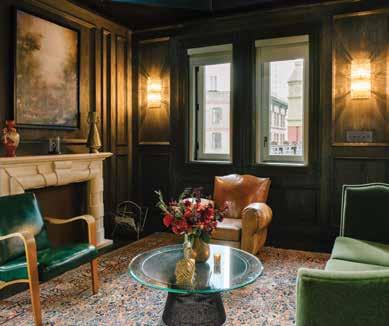
SUITE life
ceilings, with the living and sleeping quarters separated over two floors to take advantage of the vertical space of the imposing towers. Occupying the expansive first floor is a lounge and dining area warmed by an antique stone fireplace, as well as a wet bar, powder room and marble bathroom. Outfitted with leather antiques, crystal fixtures and dark wood panelling, the vintage interiors are balanced by vibrant contemporary paintings and edgy industrial touches.
On the mezzanine level overlooking the entertaining space, guests will find a king bed
made up with sateen Sferra linens and a freestanding tub presided over by a grand 19th century-style chandelier. If the 111-square metre suite isn’t spacious enough, guests can head outside to the rooftop, where they can survey the city skyline from their 74-square metre private terrace.
Rates for the Turret Penthouse Suites start at US$6,500 (about A$8,493) per night and are inclusive of a dedicated concierge team, breakfast, premium honour bar, luxury airport transfers and access to a Lexus vehicle.
thebeekman.com
 GRACE SMITH
GRACE SMITH
www.luxurytravelmedia.com.au 179
FIVE-STAR LUXURY HOTEL SUITES AROUND THE WORLD
DWARIKA’S HOTEL, KATHMANDU HERITAGE JUNIOR SUITE
Size: 55-65 square metres / Price: From US$400 (about A$510) per night in peak season / Reviewed by: Katie Milton

Hotel
Dwarika’s is the vision of founder Dwarika Das Shrestha. It was his way of helping to protect and conserve the Nepalese arts and rich Newari cultural heritage he saw being destroyed as concrete structures began to take the place of traditional wood and brick Nepali houses in the 1950s. Home to the biggest private wood collection in Nepal, the hotel took more than 30 years to complete and has been awarded the UNESCO Asia-Pacific Heritage Award for Culture Heritage Conservation. It was constructed by traditionally trained Nepali craftsmen in the ancient Newari style and incorporates hand-carved window frames, pillars and other artifacts rescued by Shrestha throughout his life. The oldest is a magnificent wooden door with exquisitely carved depictions of Krishna that dates back to the 13th century.
Suite
A brass hand with fingers connected in Gyan Mudra (the meditative thumb to forefinger pose) marks the entrance to my Heritage Junior Suite. I fumble with the weighted key and unlock the metal padlock that bars the entrance, before pulling back the brass handle with a loud scrape. There are no electronic keycards in this five-star hotel. Handcrafted Nepali terracotta tiles line the floor; the four-poster bed and daybed are upholstered with vibrant hand woven and locally produced organic linen; the entire room is furnished with clay lamps and ornate antique artifacts; and a floor-to-ceiling glass window floods the room with daylight and looks out into the verdant courtyard below.
Locale
Not 10 minutes’ drive from the airport in the Battisputali neighbourhood in Kathmandu, the hotel is set on the same street as bustling undercover markets and is a short walk southwest of Pashupatinath, the sacred Hindu temple.
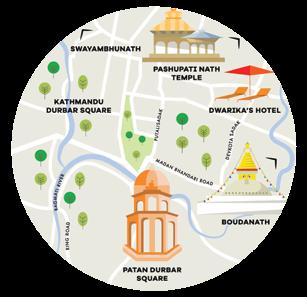


Look and feel
Within the brick walls of the hotel, travellers will find respite from the frenetic energy of
Kathmandu. Inside the grounds, nature per vades. Vines wrap around the tree trunks, sparrows perch in the hanging plants, grass grows vertically on the traditional tiled roofs, and aged terracotta pots, green with moss, line every wall and sprout coloured flow ers. Pioneering the concept of sustainable heritage conservation, the 87-room hotel feels more old than new. Each building is filled with intricate carvings and artefacts so the entire experience feels as though you are immersed in a living museum.
Eat in
Each morning I take breakfast beneath a white umbrella among the trees in the courtyard. The buffet is housed inside Toran, one of the hotel’s three on-site restaurants, and offers fresh fruits, cereals, local cheeses, sikarni (yoghurt pudding with cardamon) served in petite clay pots, and a choice of Nepali and Western hot dishes. For a traditional Nepali fine dining experience, Krishnarpan offers a minimum six-course menu, with dishes to be eaten with your hands (as is Nepali tradition) at low-seated tables. Mako’s is the Japanese restaurant, fitted out with a bamboo ceiling and traditional shoji walls, while Fusion Bar is a poolside venue decorated with an eclectic mix of vintage liquor signs, carved wood furnishings and pin-striped chairs. Dwarika’s has its own organic farm near the sister resort in Dhulikhel from which the majority of the restaurant’s ingredients are sourced.
Treat yourself
The health concept of the Pancha Kosha Himalayan Spa is one drawn from The Wisdom of the Vedas, meaning the treatments target the five elements of self. All spa products are made in-house using natural Himalayan herbs, and treatments draw on elements of Ayurveda and
Buddhist medicine. This focus on ancient practice is reinforced with the use of wooden steam boxes and deep copper tubs in the treatment rooms. There is a collection of artisan stores around the courtyard selling handicrafts, antiques, locally made jewellery and pashmina products, as well as a library and a pool designed to repli cate 12th-century royal baths. A new gym is under construction.
Special touches
At Dwarika’s, it’s about the little things: the smiling concierges who greeted me and stopped for a chat each time I entered the lobby; the wait ers at breakfast who had my preferred table set for me each morning with a black coffee already cooling; and the doorman who hailed me a taxi, set the rate with the driver and told him where to take me before I stepped inside.
180 www.luxurytravelmedia.com.au
Free WiFi Turndown service 24-hour reception In-room dining
Upgrade
The 250-square metre Royal Suite is spread across three floors with an outdoor terrace and has been inspired by the private residences of Malla Dynasty kings.

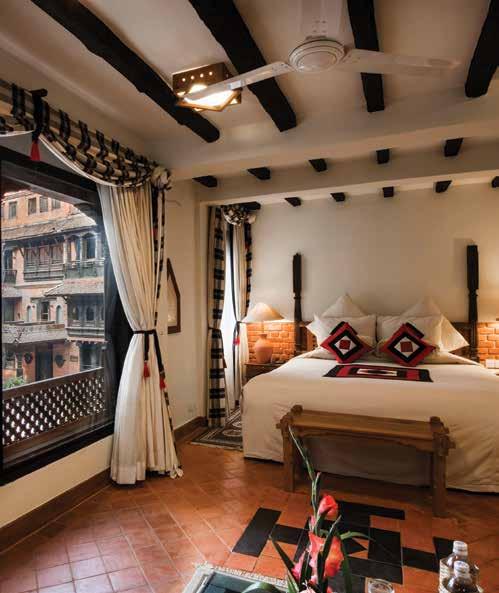
Every Friday, the hotel hosts a poolside traditional Nepali barbeque with live cooking stations and music in the Fusion Bar.


Hotel
WALDORF ASTORIA AMSTERDAM
Price: Suites from €785 (about A$1,191) per night in peak season / Reviewed by: Gary Allen

The Waldorf Astoria Amsterdam is spread across six historic double-fronted townhouses dating back to the 17th and 18th centuries. Inside, there are 93 rooms and suites designed to preserve the original architecture and decked out in a restful palette of muted blue, grey and cream. It’s sleek Dutch style with period flourishes, such as the elaborately carved and painted ceilings or the museumquality 18th century Rococo decor of the Maurer private dining room. The hotel is also home to one of the largest private gardens in the city, where technicolour tulips nod gently in spring. Look out for the grand marble and stucco staircase, designed by Daniel Marot, architect to Louis XIV.
Locale
You won’t find a better address in Amsterdam. The hotel sits on the UNESCO-listed Gentlemen’s Canal (officially called the Herengracht), the first of the three major canals in the city and the home of its most important residents for the past 400 years. Everything is within walking distance, which is ideal as Amsterdam is a city best explored on foot (or, as the locals do, by bike). Dam Square is less than 200 metres away and the area is bursting with cafes, restaurants, bars, museums and shops.
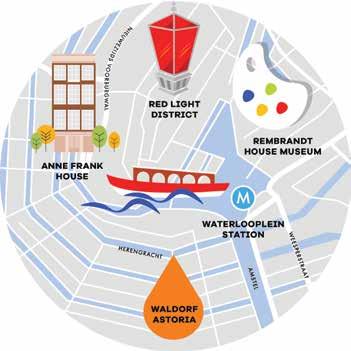
Eat in
Discover the best of innovative Dutch fine dining at Librije’s Zusje (meaning ‘little sister’). Executive chef Sidney Schutte heads the kitchen and the restaurant was awarded two Michelin stars within just seven months of opening. It is the only new restaurant in the Netherlands to have gone from zero to two stars in its first outing, a sign that the
city is becoming one of Europe’s true culinary powerhouses. Schutte creates delicate, gallery-worthy plates of milk cow rib eye beside mounds of barbecued celeriac or tiny dessert tacos filled with sweetcorn, popcorn, jalapeno and lime. Goldfinch Brasserie (named for the famed Carel Fabritius painting) is the more casual dining option, though still serves up some seriously stylish dishes drawing on the Netherlands’ links with Asia.
After hours
The hotel’s cocktail bar, The Vault, is one of the best in the city – a rarity for a hotel bar. It’s a dimly lit speakeasy housed in the original vault of the MeesPierson bank and the monetary theme is a feature throughout, with sturdy vault doors and safety deposit boxes behind the bar. Instead of a menu, you’ll be handed a wallet filled with custom banknotes, each listing a different cocktail. Some of the cocktails are practically edible art, served in a popcorn box or topped with fairy floss in an ice-cream cone.
Treat yourself

The Guerlain Spa Amsterdam, hidden at the back of the hotel’s ground floor, is small but perfectly formed. There are just three treatment rooms set beside the garden, as well as a steam room, sauna and tranquil swimming pool lit up in tones of green and aqua. The signature treatments promise to both relax and revitalise, with options to slim, polish and harmonise travel-weary bodies.
Upgrade
resident of the house in the 18th century. The suite is bright and spacious with views over the canal through oversize windows, two original fireplaces, a separate dining room and two bathrooms.
182 www.luxurytravelmedia.com.au
FIVE-STAR LUXURY HOTEL SUITES AROUND THE WORLD
Free WiFi Turndown service 24-hour reception In-room dining
The 123-square metre Brentano Suite takes its name from Josephus Augustine Brentano, a merchant and
The hotel is so well designed, and the Golden Age façade so well preserved, you wouldn’t even know it was there. These six grand dames have been brought back to life, while still maintaining their historic charm.


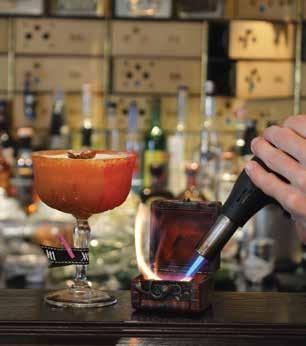
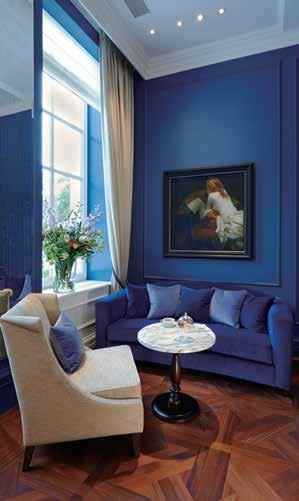

183
FIVE-STAR LUXURY HOTEL SUITES AROUND THE WORLD
DE L’EUROPE AMSTERDAM
JUNIOR SUITE RIVER VIEW
Size: 40-50 square metres / Price: from €894 (about A$1,355) per night / Reviewed by: Gary Allen


Hotel

It was De L’Europe’s old-world glamour that Alfred Hitchcock fell in love with when he chose the hotel as the backdrop to his preWorld War II film Foreign Correspondent (1940). Built in 1896, the red brick, Renaissance-style building stands on the banks of the Amstel river, walking distance from the historic 19th-century Museum Quarter, which houses Dutch cultural institutions including the Rijksmuseum, Stedelijk Museum and the Van Gogh Museum. Amsterdam’s rich art history is one of the big inspirations for this hotel; large-scale replicas of artworks by Dutch Masters such as Jan Steen and Johannes Vermeer decorate the 111 guest rooms and suites. De L’Europe is a 25-year member of Leading Hotels of the World.
Suite
One of five suite types, this Junior Suite is styled in bright Dutch yellow, designed to match the large-scale replica of Vermeer’s The Milkmaid dominating the wall. Sizeable windows allow plenty of sunshine to stream through, adding to the impressive views of the river, lined with trees and 17th- and 18th-century merchant’s houses. While not overly spacious, there is enough room for a sitting area and Art Deco-style dressing table in the corner. The marble bathroom has heated floors, a bathtub and is stocked with Blaise Mautin amenities.

Locale
Situated in Amsterdam’s historic centre by Muntplein, one of the city’s main squares, the hotel is within easy walking or cycling distance of main attractions including the Van Gogh Museum, Hermitage Amsterdam, Anne Frank House and The Royal Concertgebouw (concert hall). Amsterdam’s Central Station and shopping district PC Hooftstraat are less than 20 minutes’ walk away.
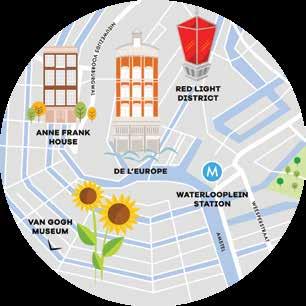
Look and feel
Renovated and reopened in 2011, the hotel
combines old-world grandeur with avantgarde touches. While three-tiered glass chandeliers hang in the entrance and guests are greeted by a doorman in tails, the rooms and suites are decorated with bold lines, contemporary furnishings and striking colours such as red, yellow, and teal. The new Dutch Masters wing, designed by Dutch architect Cees Dam, houses 23 loft-like suites, each with a different replica painting from the nearby Rijksmuseum.
Eat in Michelin two-star eatery Bord’Eau is one of the city’s iconic fine dining restaurants, famous for its French fare and 850-label wine list. For something more casual, openkitchen Hoofdstad Brasserie serves an all-day selection of grill dishes, seafood, cocktails and beers – and the 180-seat al fresco Hèt Terras, located on the banks of the Amstel, opens in summer. Freddy’s Bar, named after its famous patron Alfred Heineken, is known city-wide for its Bloody Marys, while the neighbouring lounge and gentleman’s club, Freddy’s Fumoir, is an ideal place to recline with a cigar and a cognac.
Treat yourself
The in-house spa, Le Spa by Skins Institute, features four treatment rooms, an infrared sauna, a traditional Finnish sauna, and a Turkish steam bath. The 75-minute African Botanics Marula Oil facial is one of the spa’s signature treatments, involving a double cleansing, an enzyme peel and a facial massage. A beauty salon offers hair and makeup services, while a small gym and blue mosaiclined pool overlook the river.
Special touches
The concierge service was amazing and staff were happy to book museum tickets for me. Bikes are availabe free of charge and are a great way to navigate the city's cobbled streets.
Upgrade
Inspired by one of Van Gogh’ s most famous works, the Provocateur Suite has a starry night sky of twinkling lights over the large circular bed.
184 www.luxurytravelmedia.com.au
Free WiFi Turndown service

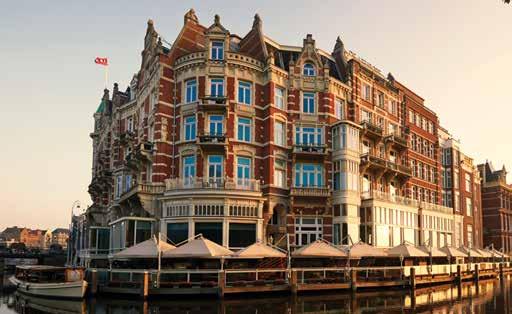


www.luxurytravelmedia.com.au 185
Superb reproductions of works from Dutch Old Masters hang in the rooms and public areas, selected with the help of experts from the Rijksmuseum.
FIVE-STAR LUXURY HOTEL SUITES AROUND THE WORLD
HOSHINOYA TOKYO

SAKURA DOUBLE
Size: 41-47 square metres / Price: From ¥720 (about A$818) per night / Reviewed by: Grace Smith



Hotel
Despite being housed in a multi-storey building in the city’s economic centre, Hoshinoya Tokyo is a world away from a standard innercity hotel. Designed in the style of a traditional Japanese guesthouse, known as a ryokan, the moment you pass through the roughly hewn wooden doors the frenetic energy of the city evaporates. Shoes are removed and stored in a series of beautifully displayed wicker baskets and once you reach your room and change into your kimono, the trappings of the modern world are shed. Guests are encouraged to treat their entire floor as a selfcontained ryokan, taking tea in the ochanoma (lounge area) wearing the traditional pyjamas provided, comfortable in the knowledge that visitors from outside the hotel and even from other floors cannot enter.
Locale
The sleek black Hoshinoya tower blends seamlessly with the upscale buildings in Tokyo’s business district. Just steps from Otemachi Station and a five-minute walk from the Imperial Palace, the hotel is within easy reach of all the city’s attractions, while the surrounding area is surprisingly serene and quiet – a relief after a long day in some of the city’s crowded districts.
Look and feel
Taking design cues from the traditional ryokan, floors are tatami (rice straw) throughout the building (even in the elevator), the doors inside the room are made of shoji paper, closets are bamboo, and the bed sits low to the ground, although it is equipped with a comfortable Western-style mattress rather than the customary futon. Lights are dimmed, gentle instrumental music plays softly and the
subtle but earthy smell of the tatami floats in the air and mingles with a faint scent of incense. Interspersed with these traditional elements are tastefully executed modern touches such as the black slate deep-soak bath and the TV cleverly hidden behind a mirror, which appears at the touch of a button.
Eat in
The basement-level restaurant helmed by chef Noriyuki Hamada serves French-style dishes made with local Japanese ingredients, a fusion that is becoming increasingly popular in the country’s top eateries. Guests are served in their own private dining room, eating off tableware crafted by local artisans. For those who prefer to be ensconced in bed, breakfast can be pre-ordered and served to your room. Both Japanese and Western breakfast options are available, with the latter including fresh pastries, omelettes, salad and a number of small sides.
Treat yourself
Hoshinoya is one of just a few hotels in Tokyo with an authentic onsen (hot spring bath), pumping highly alkaline geothermal water from beneath the hotel up to its 14thfloor spa. The shared bathing area includes an indoor area as well as an open-air space, where the building’s textured black walls extend upwards in a column that gives way to a perfect rectangle of sky. Tip your head back and watch the clouds drift by while the cool breeze prevents you from overheating in the mineral-rich 40°C water. After your bath, head to the spa rooms where health and beauty treatments are designed to enhance
the hot springs’ natural healing properties.
Special touches
Special touches are ubiquitous at Hoshinoya with memorable moments created at the most unexpected times. One evening I find myself being discretely ushered into a side room where I learn my kimono is too short and incorrectly tied. Standing in front of a floor-length mirror, my attendant produces a new kimono, seemingly out of thin air, and expertly ties it with a perfect bow. As I descend in the elevator one morning I share my plans for the day with the attendant in the lift. When I exit the building just seconds later, a different staff member gives me precise directions to my destination without me having to say a word.
Upgrade
The Kiku room spans 83 square metres and includes a walk in wardrobe, large dining table and lounge. The double bathroom features a large window that can be opened to evoke the feeling of bathing outdoors.
186 www.luxurytravelmedia.com.au
Free WiFi Pillow menu Turndown service 24-hour reception
In-room dining
Adding to the attentive service, Hoshinoya provides cultural entertainment in the form of traditional theatre and musical performances in the secondfloor lounge, accompanied by a selection of sake and snacks. There is also a range of interactive classes where guests can learn how to move gracefully in a kimono or perform morning stretches to prepare for the day.
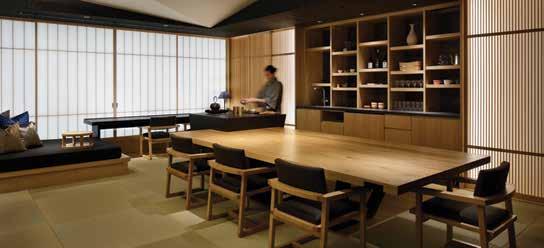
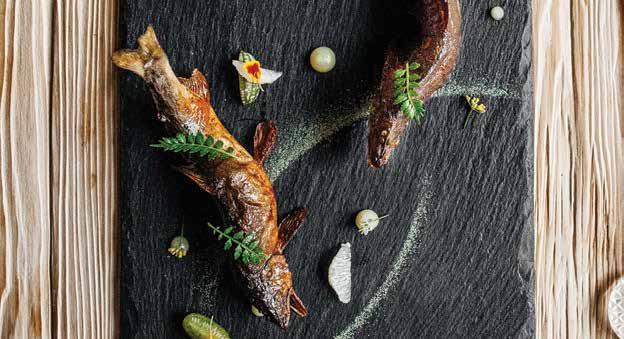

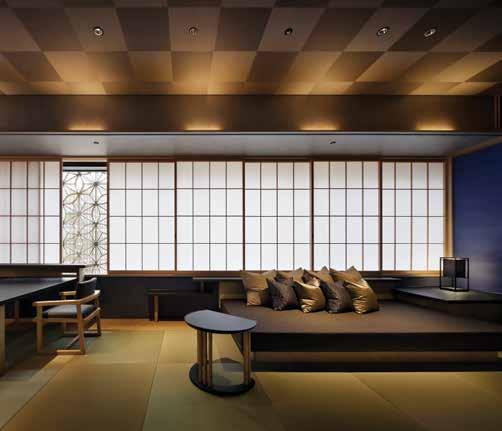
187
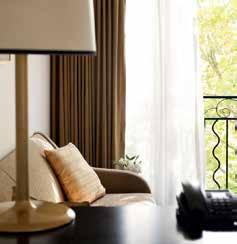
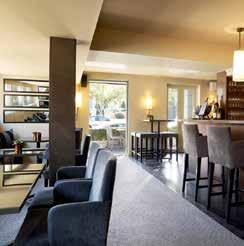
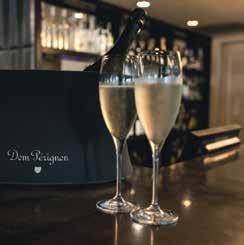
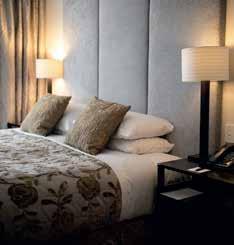

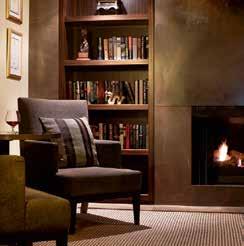
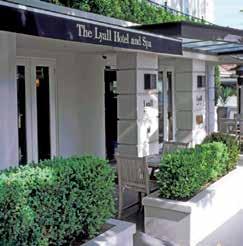
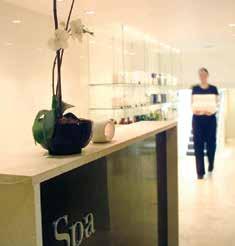

Lyall Hotell and Spa 16 Murphy Street, South Yarra, Melbourne Victoria 3141 Australia Ph: +61 3 9868 8222 www.thelyall.com An Urban sanctuary of luxury and design Lyall Hotell and Spa 16 Murphy Street, South Yarra, Melbourne Victoria 3141 Australia Ph: +61 3 9868 8222 www.thelyall.com An Urban sanctuary of luxury and design

www.luxurytravelmedia.com.au 189 191 Chef's guide | Bilbao 194 Culinary travels | Barossa Valley 198 Epicurean news SAVOUR
ONE WOMAN DIES EVERY 10 HOURS FROM OVARIAN CANCER
THERE IS NO EARLY DETECTION TEST
IT COULD BE YOUR MOTHER, WIFE, SISTER, FRIEND OR EVEN YOUR DAUGHTER

RESEARCH IS THE ONLY ANSWER
THERE IS NO EARLY DETECTION TEST
HELP US DEVELOP ONE. DONATE NOW
VISIT OCRF.COM.AU OR CALL 1300 OVARIAN

CHEF'SGUIDE BILBAO SAVOUR

Michelin-starred chef Josean Alija shares his favourite Bilbao food haunts, where pintxos reign supreme.
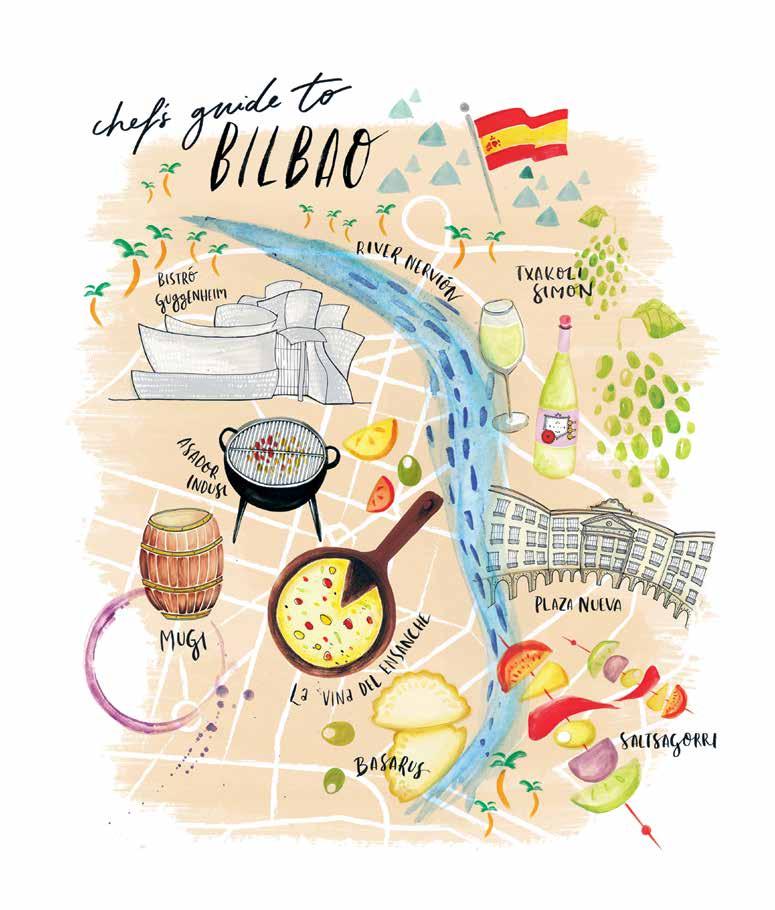
www.luxurytravelmedia.com.au 191
ILLUSTRATIONS IN THIS STORY BY TAYLOR CONACHER
San Sebastian has long been considered the foodie capital of Spain – or indeed, the world – but the gritty port city of Bilbao, just 100 kilometres west, is coming for the title. In 2018 Bilbao will become the focus of the culinary world as it hosts The World’s 50 Best Restaurants awards.
Michelin-starred chef Josean Alija from Nerua, the haute-cuisine restaurant inside Bilbao’s famed Guggenheim Museum, takes us on a food tour through the city.
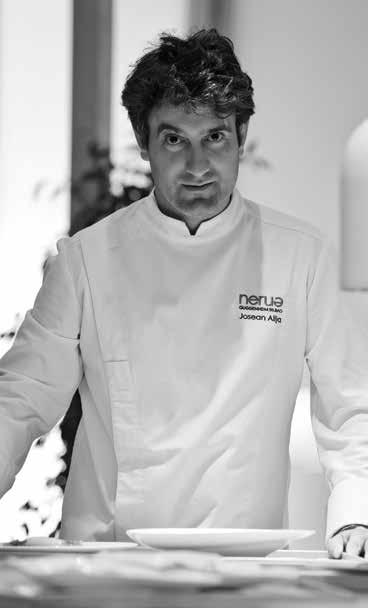
La Viña del Ensanche

A historic restaurant in the centre of the city where people in a hurry can enjoy a good breakfast. First thing in the morning, go for the omelette with slices of bread, tomato and ham.
10 Diputacion Street; +34 944 15 56 15; lavinadelensanche.com
Mugi
If you want a traditional Basque breakfast with txistorra (sausage) and morcilla (blood sausage), you have to go to Mugi tavern. Of course, you do not order coffee – you ask for wine! It’s for the brave early risers. They are the ones that give energy to the city.
Licenciado Poza, 55; +34 944 41 30 16; barmugi.com

Asador Indusi
One of the city’s most popular restaurants, Asador Indusi makes classic and traditional cuisine, taking good care with the ingredients, especially the meats. It is in the heart of the city and is a very busy place, though it still has a relaxed atmosphere. There is also a good wine cellar.

Calle Maestro García Rivero, 7; +34 944 27 08 00; asadorindusi.com
Saltsagorri
The culture of the pintxo (a small snack eaten standing up at the bar) is becoming more and more widespread, but the special places are those that understand the cuisine's history. Saltsagorri is a little place where they offer traditional pintxos in an intimate atmosphere where you're guaranteed a great time.
Mesedeetako Kalea
Gure Toki
I recommend Gure Toki because of its commitment to the hot and elaborate pintxos such as kebat, fried crab and goose eggs; the jamon Joselito (considered the best ham in the world); the good atmosphere; and the warm service. Gure Toki was the winner of Bilbao’s prestigious Bar Pintxos Competition in 2016. A selection of interesting products makes this a longer stop than
192 www.luxurytravelmedia.com.au
BAITA BILBAO
A small place with excellent pintxos and wines has become a luxury experience because of the soul; because of remaining faithful to the tradition and the principles of quality.

usual on the txikiteo (the Basque practice of going from bar to bar for a small glass of wine and pintxos).
Plaza Nueva, 12; +34 944 15 80 37; guretoki.com
Taberna Plaza Nueva
Named after the square in which it sits, Taberna Plaza Nueva deliver pintxos with a cultural flavor, each a small tribute to the motivations of the chef. The attention to detail is exquisite. Plaza Nueva is one of those places in which grandparents, children and grandchildren meet to eat and drink. It is also capable of transforming during festivals such as Carnival, Holy Week or Aste Nagusia. It is one of the most emblematic bars of the Plaza Nueva, one of the most significant places in Bilbao.
Plaza Nueva, 9; +34 944 15 06 94
Taberna Basaras
It’s funny how luxuries change. A small place with excellent pintxos and wines has become a luxury experience because of the soul; because of remaining faithful to the tradition and the principles of quality. Basaras is a cute place where you will have the sensation that time has stopped while you are savouring all these things. The tavern specialises in classic home cooking – omelette, empanadilla, salted and fried anchovies. Ideal to visit with friends.
Pilota Kalea, 2; +34 617 06 24 64; facebook.com/TabaernaBasaras
Kimtxu
Kimtxu is not a typical Asian restaurant, nor is it a typical Basque restaurant. Its dishes have touches from here and there: Basque, Thai, Chinese, Japanese, Korean. Asian flavors and


aromas combine with the excellence of premium local meats, vegetables and fish. I recommend it because they offer a rich and unusual fusion cuisine.

Henao Kalea, 17; +34 946 527 892; kimtxu.com
Baita Bilbao
Bilbao’s proximity to the sea and orchards combined with skilled chefs makes for fresh, pleasant cuisine filled with special little touches. Baita never ceases to surprise you with its finesse and elegance, using seasonal produce to create simple, unpretentious cuisine.
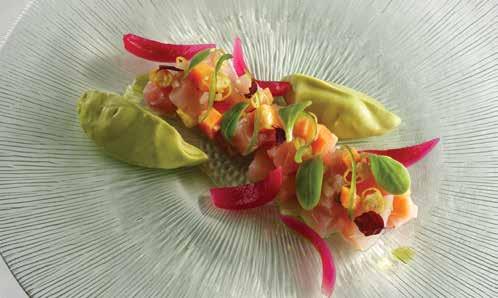
Alameda Mazarredo, 20; +34 944 24 22 67; baitabilbao.com
Bistró Guggenheim Bilbao
The menu here honours the region’s culinary culture, cleverly adapting traditional cuisine to an avant-garde context without losing flavours or textures. It’s a quality restaurant in a unique space with an informal atmosphere. A perfect place to go with friends or family.
Avenida Abandoibarra, 2; +34 944 23 93 33; bistroguggenheimbilbao.com
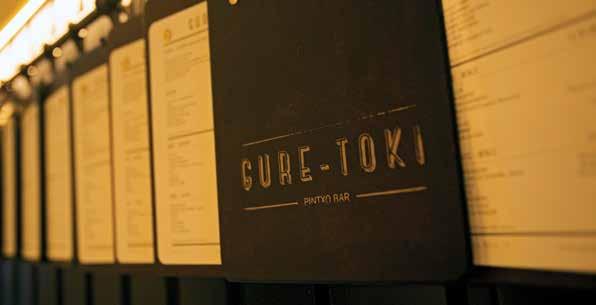
www.luxurytravelmedia.com.au 193
“ “
GURE TOKI
BISTRO GUGGENHEIM BILBAO
Among the vines
Long renowned for shiraz, South Australia’s celebrated Barossa Valley now has plenty more flavoursome tricks up its sleeve, writes Belinda Craigie
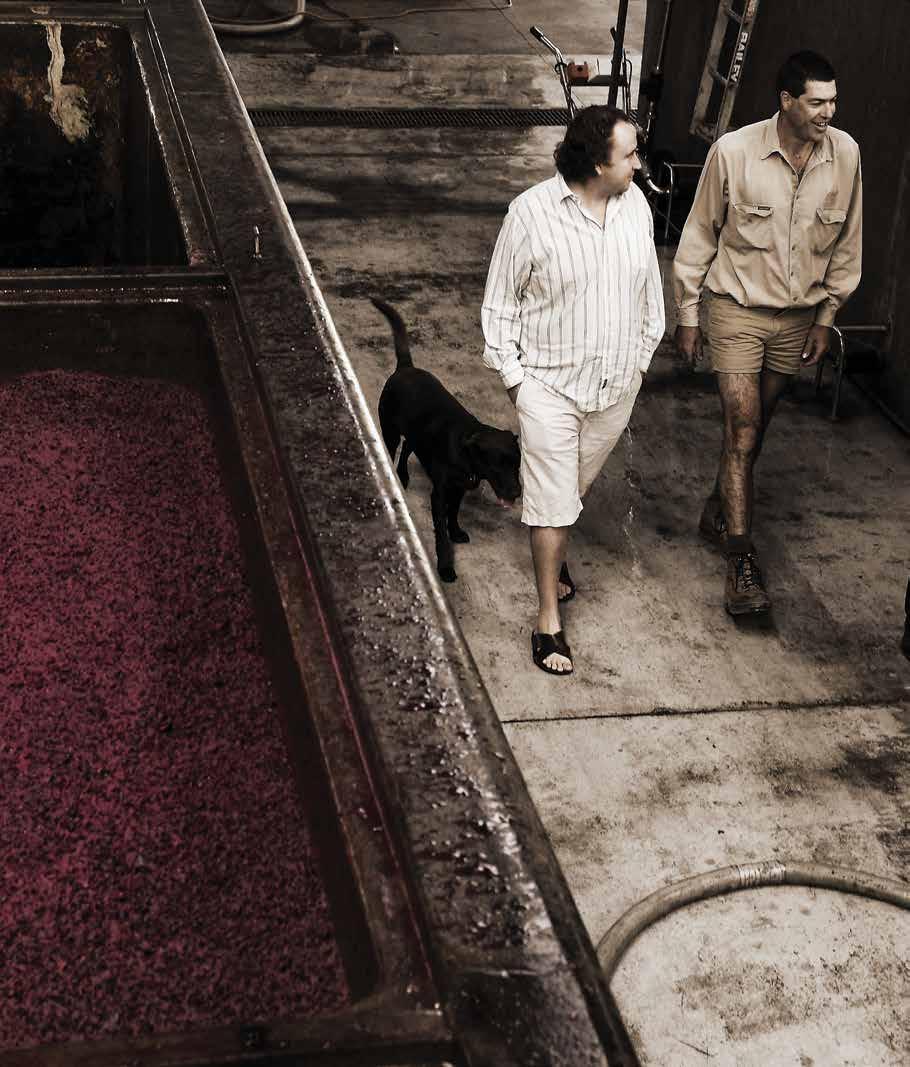
194 www.luxurytravelmedia.com.au ELDERTON WINES
SAVOUR

CULINARY TRAVELS BAROSSAVALLEY
It’s apparent on arrival in South Australia’s Barossa Valley that I am indeed in one of the oldest wine-producing regions in Australia. Greeting me are quaint country towns accented with Lutheran architecture, and roaming wineries with adjoining homesteads. These picturesque throwbacks to the Barossa’s German and English settlement in the 1840s, along with the strong sense of community that locals continue to foster, help give this region its charming reputation.
Most tourists come to the Barossa to visit its wineries, many of which have become internationally acclaimed for shiraz. With four of Australia’s 12 oldest wine companies or continuously operating brands based in the Barossa (Penfolds, Orlando, Yalumba and Seppeltsfield), the region signifies an important chapter in Australia’s winemaking history. Today, the Barossa has more than 550 grapegrowing families contributing to the region’s impressive wine production.
While shiraz has brought the Barossa its international acclaim and solidified its reputation as a premier wineproducing region, other wines are starting to make their mark. Vines up to 80 years old and previously deemed unfashionable are now used to make on-trend varietals like grenache and mataro, all of which make for a pleasant cellar-door experience.
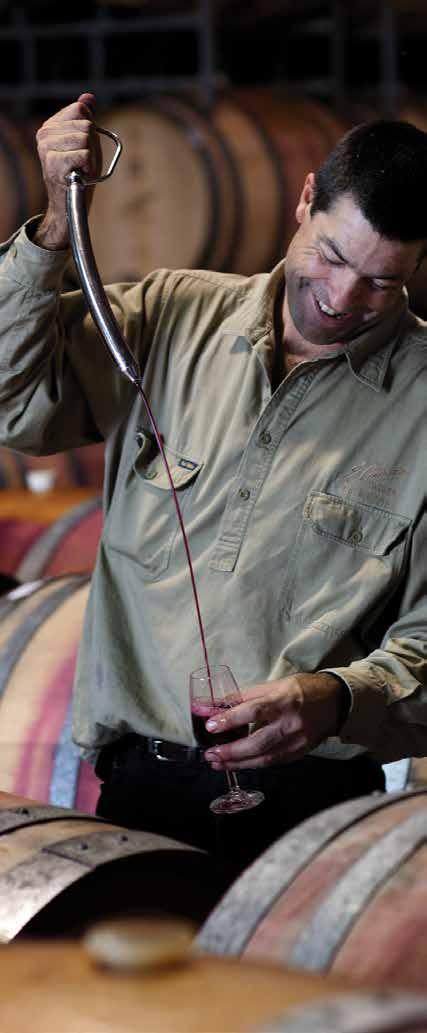
Visitors to the Barossa tend to visit its more famed wine-making monikers, but smaller family-run institutions are making an impact on the Barossa wine scene, too. One such label is Elderton Wines, which opened a new cellar door in October, transforming its historic family homestead into a renewed winery experience. Located in Nuriootpa (or Nuri, as it’s affectionately termed by locals), the property was built in 1918 adjacent to shiraz vines that date back to 1894. In 1979, Neil and Lorraine Ashmead purchased the homestead and began the process of restoring the vines that had been neglected by the previous owners. Elderton became a winery in its own right in 1982, with legendary winemaker Peter Lehmann helping to make the first vintage. Elderton Wines’ 1992 cabernet sauvignon won the prestigious Jimmy Watson Trophy in 1993.
Elderton Wines is very much a family affair, with brothers Cameron and Allister Ashmead acting as codirectors, and Cameron’s wife, Jules, taking on a winemaker role alongside Richard Langford. The family’s passion for wine is evident, extending to the personalised number plates – SHIRAZ and CABSAV – that belong to Allister and Cameron.
The Ashmead family’s mark on Elderton is translated in the cellar-door experience. The space retains a sense

WINEMAKER RICHARD LANGFORD | ELDERTON WINES
Five Barossa foodie experiences to try

Cooking class and lunch at The Eatery, Maggie Beer’s Farm Shop
The Eatery is a new gastronomy experience that has just opened at famed Aussie food personality Maggie Beer’s Farm Shop. Enjoy lunch cooked by chef Tim Bourke, whose previous tenure was with the luxurious Southern Ocean Lodge on Kangaroo Island. Maggie’s daughter Elli heads the new eatery, which also hosts cooking classes. maggiebeer.com.au
Make gin at Durand Distillery Craft Spirits
Another addition to Maggie Beer’s Farm Shop is The Gin School at Durand Distillery, where visitors can make their own gin with signature labels. Priced at A$280 per person including a two-course lunch at The Eatery. Bookings required. duranddistillery.com
Make your own knife at Seppeltsfield
Available through Appellation at The Louise, keen foodies can try handcrafting their own knife with Gardener Knives at JamFactory, Seppeltsfield. The one-day course is A$600 and includes morning tea and a light lunch, as well as a masterclass at Appellation on handling, sharpening, cleaning and using your new knife. thelouise.com.au/explore/make-your-own-knife
Cheese tasting at Barossa Valley Cheese Co.
A visit to this cheesery includes plenty of free cheese tastings, as well as optional tasting experiences via the Cheesecellar. Try the Barossa’s Finest Collaboration (A$49) which pairs four cheeses with local beer, cider, gin and, naturally, wine. barossacheese.com.au
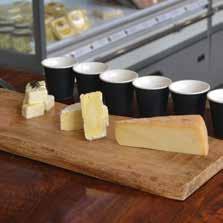
Lunch at fermentAsian restaurant
A very special dining experience, the cuisine at fermentAsian is northern Vietnamese with a modern twist. Many of the herbs and produce used in the dishes curated by head chef Tuoi Do are grown in the restaurant’s herb garden, and the stunning 92-page wine list showcases the best of the Barossa and beyond. fermentasian.com.au
of the property’s colourful history, while still feeling modern and refreshed. Brown leather furnishings, Persian rugs, and a centrepiece fireplace combine to evoke a rustic feel that complements the homestead’s country setting. Framed pictures and news clippings show the homestead from its inception in 1918, through its varied stages of ownership and associated bouts of success.
Luxury touches include five private tasting rooms, a helipad, swimming pool, tennis court and lawns for croquet and petanque. For discerning wine lovers, Making Great Wines (A$300 per person) promises the ultimate winery experience. Participants are hosted by an Ashmead family member who provides access to barrel tastings and a tasting of the Elite Single Vineyard Range in an exclusive cellar, while a back vintage wine is also opened for participants to sample in a private tasting lounge.
When it comes time to retire, the most luxurious accommodation in the Barossa is The Louise, a Relais & Châteaux property that is home to South Australia’s destination dining institution, Appellation. The restaurant is

headed by executive chef Ryan Edwards, who uses seasonal and locally sourced ingredients in his creative dishes. The Louise’s 15 well-appointed suites are spacious with spa bathtubs, indoor and outdoor rain showers, and private patios affording views of the vine-accented hills. A highlight during my stay is a delightful freshly baked croissant brought to my room for breakfast, with a memo outlining the day’s forecast and suggested activities for travellers without any plans. A simple yet thoughtful touch.
Following a contemplative soak in my suite’s bathtub, I depart the Barossa with a renewed affection for Australia’s world-class regional food and wine options (and a very satiated appetite), and an appreciation for the strong sense of community Barossans uphold, which makes this destination all the more enjoyable to experience.
eldertonwines.com.au; thelouise.com.au
See more images from this story at luxurytravelmedia.com.au
196 www.luxurytravelmedia.com.au
experience the world by bike
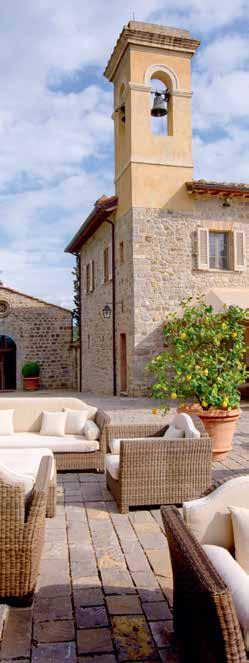

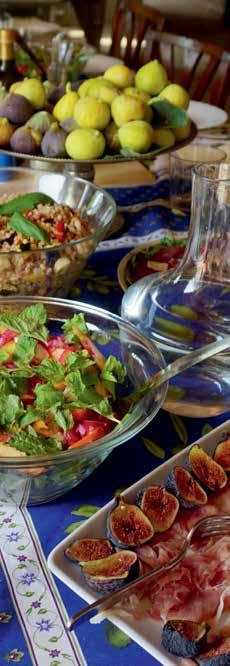

news

Go on a 'gin-venture' through North Wales
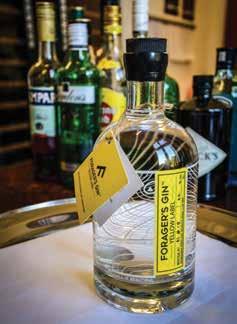
Europe’s first underwater restaurant to open in Norway


The sleepy Norwegian village of Båly will soon be home to a European first – an underwater restaurant, half-sunken five metres into the sea. Aptly named Under, which translates to wonder in Norwegian, the restaurant will offer diners front-row seats to the cold-climate marine life of the coast. Guests will enter on the shore level, surrounded by the breaking waves of the tide pool, before descending into the semi-submerged champagne bar, marking the transition from land to ocean. Diners will reach the seabed for their meal, soaking up
panoramic views of the surrounding marine life while eating locally sourced seafood such as cod, lobster, mussels and truffle kelp, prepared by Danish chef Nicolai Ellitsgaard Pedersen. The concrete exterior has been specially designed to attract mussels. This will create a water-purifying artificial reef that will contribute to the marine ecosystem and attract diverse marine life, ensuring there is plenty to see from the restaurant’s floor-toceiling windows. The restaurant is due to open in early 2019.
Travellers visiting North Wales’ scenic Snowdonia region can now experience its gin production first hand, on a deluxe ‘gin-venture’ led by distillery Forager’s Gin and expedition specialists RAW Adventures. The journey commences at restored mansion Palé Hall, where guests will be greeted with gin cocktails and an eight-course tasting menu showcasing local produce, before spending the night in one of the hotel’s master suites. The next day begins with an expedition to Mount Snowdon to learn how to forage for native botanicals, with guests collecting juniper berries, gorse and heather flowers for use in gin production, before heading to the distillery for a lesson in distillation and a high-end gin tasting. To complete the experience, guests will return to their hotel room where their own bottle of Forager’s Gin will await them. Prices start from £1,642 (about A$2,812) for two people, inclusive of two nights in a master suite at Palé Hall, daily breakfast and dinner, and all gin experiences. palehall.co.uk
198 www.luxurytravelmedia.com.au
THE LATEST FROM THE WORLD EPICUREAN
OF FINE FOOD AND DRINKS
Food, art and wine at the Mornington Peninsula’s new Pt. Leo Estate
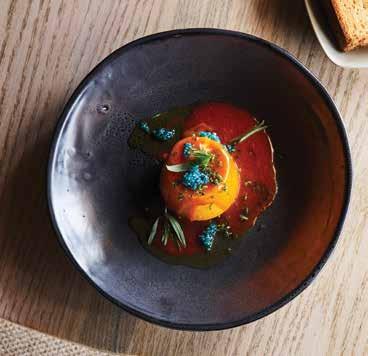
A new cultural and culinary hub has opened on the southern tip of the Mornington Peninsula. The 330-acre Pt. Leo Estate, which opened in October, is home to a 110-seat restaurant, a vineyard and cellar door, and an expansive sculpture park showcasing Australia’s largest privately owned collection of local and international works. The sculptural theme continues indoors where the entryway to the cellar door and restaurant building is designed to evoke the image of wine
pouring from a bottle. Inside, guests can sample the estate’s cool-climate wines including pinot noir, chardonnay, shiraz and pinot gris, before heading to the restaurant to dine from chef Phil Wood’s menu which features dishes such as a Dutch carrot soufflé, brown butter and wild scampi roe, and wood-roasted flathead with macadamia and seaweed. Entrance to the sculpture park costs A$10, but is complimentary for those dining at the estate. ptleoestate.com.au
Nine-seat London sushi restaurant earns third

Michelin star
Dining with the locals
Luxury tour company Insight Vacations is helping travellers sample authentic local cuisine with a series of new dining experiences launching in 2018. Guests on selected trips will visit the homes of locals where they will be served a home-cooked meal showcasing the fresh produce and culinary traditions of the region. insightvacations.com/au
The newly released 2018 Michelin Guide has seen unique London eatery The Araki earn its third Michelin star. Seating just nine people at a time, the Japanese restaurant serves a £300 (about A$512) set menu consisting exclusively of painstakingly crafted sushi. Chef Mitsuhiro Araki previously earned three stars at his Tokyo restaurant Edomae before relocating to London and opening The Araki in 2014. The nod propels the Mayfair venue into the ranks of the UK’s best restaurants such as The Fat Duck and Restaurant Gordon Ramsay, which have also been awarded three stars. the-araki.com
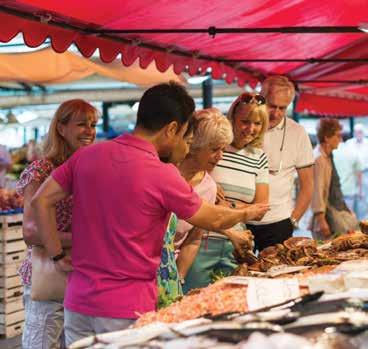
www.luxurytravelmedia.com.au 199
EUROPE HOTEL BARGE CRUISES


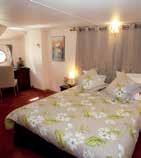
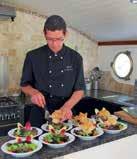
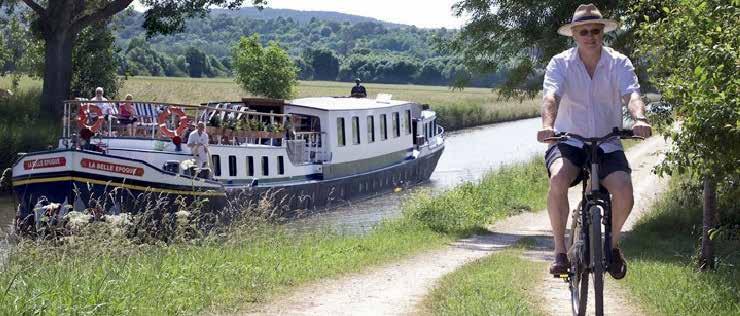






1800 331 582 WWW.OUTDOORTRAVEL.COM.AU
Tel:
Canal du Midi Loire Burgundy Venice Holland Thames Scottish Highlands One week canal or small river cruises. Quality cabins with own bathroom. Onboard chef with regional cuisine & wines. Daily coach excursions to vineyards, chateau, galleries, gardens. Bicycles available onboard.
DISCOVER FRANCE ITALY BELGIUM SCOTLAND IRELAND ENGLAND


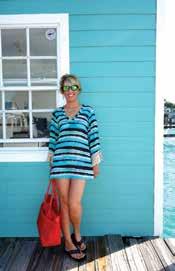

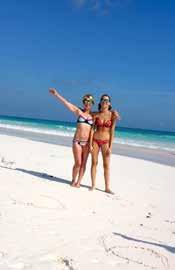

TRAVEL | ARTS | LITERATURE | PHOTOGRAPHY | FOOD | MUSIC Go to https://TheSizeitDownAndTravelitUpExperiment.com Looking for some tips from a USA-based luxury traveler? My First Mother Daughter Trip My Life as a Bahamian Pirate 5 Nights, 4 Plays, 9 Meals in NYC at Christmastime North Shore Wedding, Land of Rainbows, Waves and Hula Dances
The Langham Concierge Q&A

Peter McBrearty , Chief Concierge at The Langham, Melbourne, and President of the prestigious Les Clefs D’Or Australia, gave Siobhan Plowman a behind-the-scenes look at the world of a luxury concierge.
Q. How long have you been at The Langham?
A. I’ve been at The Langham, in both its incarnations (the hotel was previously the Sheraton Towers), for 18 years. It’s a bit of a shock to me as well as most people!
Q. Can you tell us a little about Les Clefs D’Or?
A. The name literally means The Golden Keys, which is what you’ll see on the collars of all the international member concierges around the world. It’s a global network of concierges, transcending hotel brands and national boundaries, which started in France and is based on the old idea of the keeper of the keys in medieval castles. It allows us to facilitate the needs of the guests better than if we were just operating as a single person. For example, I know one of my associates here in Melbourne had a guest wanting to go to NOMA over in Denmark. And he rang up Anders, the then-President of the Clefs D’Or in Denmark, and was able to get him a seat at the restaurant, which was technically fully booked.
Q. So it’s all about connections?
A. It’s funny with concierges – they’re one of the most stable people within a hotel environment, which is often quite fluid as people are promoted and move around. The longer you’re in one position the better you get to know people. We [concierges] often communicate with each other. I’ll often ask a guest where they are staying, say, in Sydney or in London, and then we let [that hotel] know the guest is coming and they’ll have some information ready. The guest feels that they’re being handed on and looked after right through their trip, instead of just having a short interaction and then leaving.
Q. What is the most memorable request you’ve received?
A. We had a call from New York from the road manager of a musician that stayed here and he wanted to arrange a flying fox skeleton in a glass case to give to a friend for their birthday. That one was interesting. It’s kind of like hospitality Russian roulette; when someone walks up, you don’t know what they’re going to ask you for.
Q. What makes The Langham, Melbourne different to other hotels?
A. We’ve still got some staff members that were here when the hotel opened its doors, which is unusual for the industry. I met some regular guests at a restaurant function that said they could stay wherever they want, but they come here because they see the same staff, people that can walk over and say “Hey, how are you?”. Laurie, our doorman, has been here for years and years, and he has a better memory than I do. He’ll remember someone that hasn’t come in for three years. And we do have 24-hour room service, which is increasingly rare if you want a club sandwich or decent burger. This is a big thing when you’ve had the [AFL] Grand Final or when the tennis is on!
Q. Any advice for travellers heading to Melbourne?
A. Definitely pack a jacket and layers. And wear something black. If you can do that and find a small bar, you’re an official ‘Melbournite’. And use your concierge! When you’re travelling, reach out in advance, send them an email and let them know what you’re interested in. We’re happy to hear from future guests and it gives us a reason to turn up. You’ll already know us by the time you get to the hotel.
202 www.luxurytravelmedia.com.au LUXURY TRAVEL INTERVIEW THE LANGHAM | MELBOURNE

For additional information please contact (02) 9363-1088 l info@avstev.com.au
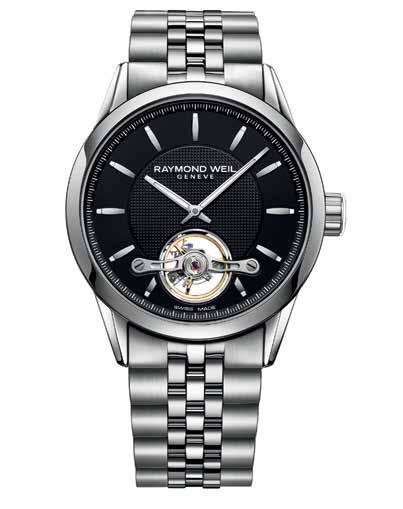
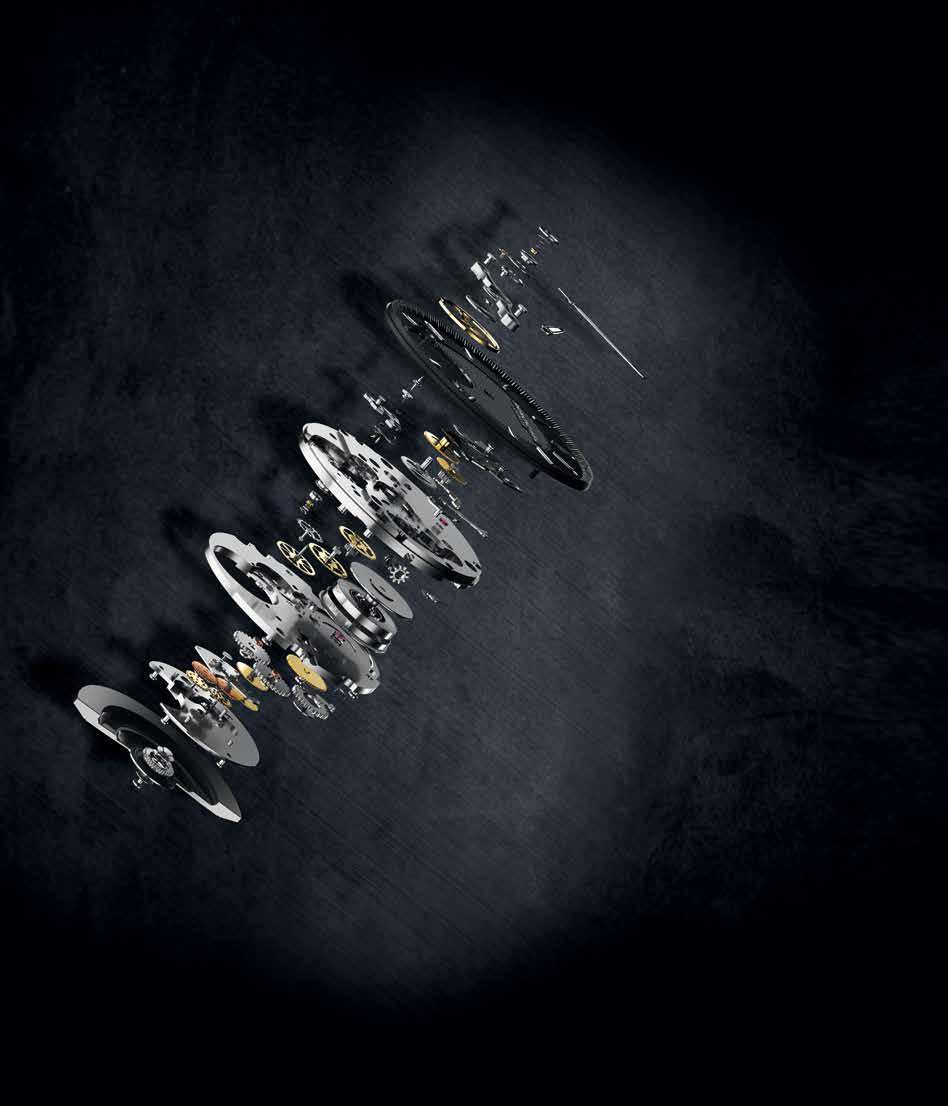




































 Mark Cunich #LTmoments winner
Mark Cunich #LTmoments winner


























 MANDARIN ORIENTAL QIANMEN
MANDARIN ORIENTAL QIANMEN















 AMSTERDAM, NETHERLANDS
AMSTERDAM, NETHERLANDS






 Beth Smith , director of sales and marketing
Beth Smith , director of sales and marketing




















 PORTSMOUTH, ENGLAND
PORTSMOUTH, ENGLAND






























































































 Tiago Pais
Tiago Pais


























































 By Lucy Jones
By Lucy Jones













 By Deborah Dickson-Smith
CORAL FRAMES AT JUMEIRAH VITTAVELI, MALDIVES
By Deborah Dickson-Smith
CORAL FRAMES AT JUMEIRAH VITTAVELI, MALDIVES




 ANANTARA, MALDIVES
ANANTARA, MALDIVES







































 The Kamui Niseko
Haven Niseko
The Kamui Niseko
Haven Niseko









































 Jane Gabriel
Jane Gabriel






































































 By Rachel Lees
By Rachel Lees









 GRACE SMITH
GRACE SMITH


























































































